Photograph provided by Madero, Michoacán residents.
“In Michoacán right now I think the most sensitive, serious environmental issue is the indiscriminate change of land use for avocado crops … [which] puts at increasing risk our biodiversity, the provision of water, and the forests in this state.” – Michoacán’s Secretary of Environment Alejandro Méndez.1“Avocado: Business, Ecocide and Crime: Part 1,” (Aguacate: negocio, ecocidio y crimen: Parte 1), UGTV Territory Reporting, Sept. 7, 2022, video clip, YouTube, https://www.youtube.com/watch?v=PaaaJXAx6NQ (accessed September 12, 2023).
“Notwithstanding our constant refusal to sell some fractions or the totality of the land of our property… more than 59 hectares have already been invaded and deforested.” – Letter from Jalisco family to U.S. Trade Representative and U.S. Ambassador to Mexico.2Letter from Jalisco family to Ken Salazar, U.S. Ambassador to Mexico and Katherine Tai, U.S. Trade Representative, September 13, 2021 (translated by U.S. government), obtained via FOIA request from USTR.
“If you point the finger or talk, they’ll kill you.” – Indigenous community leader from Michoacán.3CRI interview with Indigenous community leader, Michoacán, 2023 (name and exact date and location withheld).
“Avocados From Mexico make everything better. Talk about holy guacamole!” – Avocados From Mexico.4“Avocados from Mexico Make Everything Better in an Epic Way in New Big Game Ad,” PR Newswire (news provided by Avocados From Mexico), February 8, 2023, https://www.prnewswire.com/news-releases/avocados-from-mexico-make-everything-better-in-an-epic-way-in-new-big-game-ad-301742217.html (accessed September 18, 2023).
The next time you eat guacamole there is a serious risk it will contain avocado that was grown on illegally deforested land, using stolen water, in a region of Mexico where Indigenous people and other residents face violence and intimidation for defending the environment.
The world’s leading producer and exporter of avocados, Mexico supplies four out of five avocados eaten in the United States in exports worth US$3 billion per year. Mexican avocados are also increasingly reaching other international markets, with more than US$2 billion exported to Europe, Canada, and Asia over the past five years. U.S. avocado consumption has tripled since 2000, partly driven by the industry’s vigorous marketing campaigns, including claims of Mexican avocados’ “sustainability.” A 2023 Super Bowl ad showed Eve holding the fruit in the Garden of Eden, with the slogan that avocados “make everything better.”
Yet growing international demand has fueled the widespread clearing of forests in Michoacán and Jalisco, the two states that produce all Mexican avocados exported to the United States. Avocado producers use enormous amounts of water, and many illegally extract it from streams, rivers, springs, and underground aquifers to irrigate their orchards. The deforestation and water capture have taken a serious toll on local populations—contributing to water shortages and increasing the risks of lethal landslides and flooding.
Mexican authorities are failing to contain the destruction. Major importers and supermarkets are selling avocados produced on deforested lands. The U.S. government has the means to help but has turned a blind eye—despite U.S. climate-change commitments to end global deforestation, as well as long-standing commitments to promote human rights, including those of Indigenous Peoples.
These findings are based on extensive field research by Climate Rights International across 18 municipalities in Michoacán and Jalisco, interviews with nearly 200 people, and a review of previously unpublished U.S. and Mexican government records, including maps of the more than 50,000 avocado orchards certified to export to the United States.
Virtually all the deforestation for avocados in Michoacán and Jalisco over the past two decades has violated Mexican federal criminal law, which prohibits “land-use change” of forested areas to agricultural production without government authorization. The additional crime of intentionally setting forest fires frequently facilitates the deforestation. The conversion of natural forests to avocado-tree plantations releases climate-warming greenhouse gases, reduces carbon storage, and undercuts biodiversity and the replenishment of aquifers.
Throughout the communities Climate Rights International visited, we encountered widespread concern, indignation, and outrage that local forests were being destroyed and water supplies depleted and stolen. Yet these sentiments were usually matched—and sometimes outweighed—by another: fear. Climate Rights International documented repeated threats and attacks against residents who have opposed avocado-driven environmental degradation. It was common knowledge among local residents that the brutal organized crime groups that dominate the region have multiple links to parts of the industry. People were afraid that by taking action to defend the environment they would put themselves in danger—and many have chosen not to for this reason.
Indigenous Purépecha communities have collectively mobilized to protect forests, but they too have been thwarted by violence and intimidation. The assaults on Indigenous communities infringe on their human right, as Indigenous Peoples, to participate in decision-making in matters that affect their lands and resources. As the minutes of one community assembly put it, deforestation for avocado production is “destroying the ecological equilibrium of communal lands.”5Minutes of Extraordinary General Assembly in the Indigenous Population of Ocumicho, Charapan Municipality, Michoacán, (Acta de asamblea general extraordinaria de la población indígena de Ocumicho municipio de Charapan, Michoacán), June 14, 2020.
Environmental officials in both Michoacán and Jalisco recognize that avocado production is a central cause of deforestation and environmental destruction in their states. Yet, Mexican authorities often fail to enforce environmental laws in avocado-growing regions. One reason is that officials fear being targets of threats and violence if they try to rein in illegal deforestation and water theft. Another reason is corruption, especially in state criminal investigations and prosecutions in Michoacán, according to state and federal officials and residents.
Given the challenges around local enforcement, precluding deforestation-linked avocados from reaching multibillion dollar markets—especially in the United States—is key to containing the problem. That was the consensus view among Mexican officials and community leaders, who told Climate Rights International that blocking access to these markets would significantly reduce the incentive to destroy forests—or to attack residents defending them.
In 2021, top Mexican environmental officials proposed such a policy to the U.S. Department of Agriculture (USDA) plant inspection service’s regional director in Mexico. This would have entailed adding a no-illegal-deforestation requirement to the existing agreement between the two governments, under which each avocado orchard that exports to the United States must be certified by U.S. and Mexican authorities as meeting criteria that currently relate exclusively to pest control. But U.S. officials did not act on the proposal.6Transparency law response by Mexico’s National Forest Commission (CONAFOR) to request number 330009623000174, April 27, 2023. Instead, as this report shows, the United States routinely certifies illegally deforested orchards to export to U.S. consumers.
Compounding the problem, the U.S. government approved the state of Jalisco to start exporting avocados to the United States in 2022, without adopting measures to address the risk that, as an internal U.S. government report alerted at the time, the approval was “likely to increase deforestation” in Jalisco, as “market pressures” had done in Michoacán.7Email from U.S. Trade Representative (USTR) personnel to Kelly Milton, Assistant USTR for Environment and Natural Resources, April 4, 2022, containing “USMCA Environment Monthly Newsletter,” provided by USTR in response to FOIA request on March 30, 2023.
Companies in the United States, Mexico, and elsewhere bear significant responsibility for the deforestation. Climate Rights International found that, despite making strong sustainability claims, many major companies are taking little or no action to prevent contamination of their supply chains by deforestation-linked producers in Mexico. Previously unpublished Mexican government records indicate that in 2022 orchards containing illegally deforested land supplied avocados to the U.S.-based companies Calavo Growers, Fresh Del Monte Produce, Mission Produce, and West Pak Avocado. The companies have, in turn, supplied Mexico-sourced avocados to major supermarket chains, including Walmart, Whole Foods, Kroger, Albertsons, Costco, Target, and Trader Joe’s.
The inaction by corporations and government officials is inexcusable. U.S. and Mexican authorities have maps of all the export-certified orchards, and any corporation committed to rooting out deforestation from their supply chains could obtain them—just as Climate Rights International did. Comparing these maps with satellite imagery, authorities could identify recently deforested orchards and block them from export-certification, and companies could identify and block them from their supply chains. Doing so wouldn’t wreck Mexico’s avocado industry: while the recent deforestation is widespread and severely impacts many people and the environment, most existing orchards would not be affected by such policies, as they are on lands that have long been dedicated to farming. The policies would, however, dramatically reduce the incentive to cut down more trees to meet the growing demand for avocados.
The deforestation and human rights harms in Mexico are symptomatic of a much broader problem that is central to the climate crisis: the lack of international and national regulations and policies to end deforestation for agricultural commodities such as beef, soy, palm oil, and avocados. Urgently enacting and implementing such regulations and policies is essential to averting climate catastrophe, and to protecting the rights of populations where the commodities are produced.
The following two Google Earth satellite images show forests illegally cleared in Michoacán to plant avocado orchards, many of which have been certified to export to the United States.

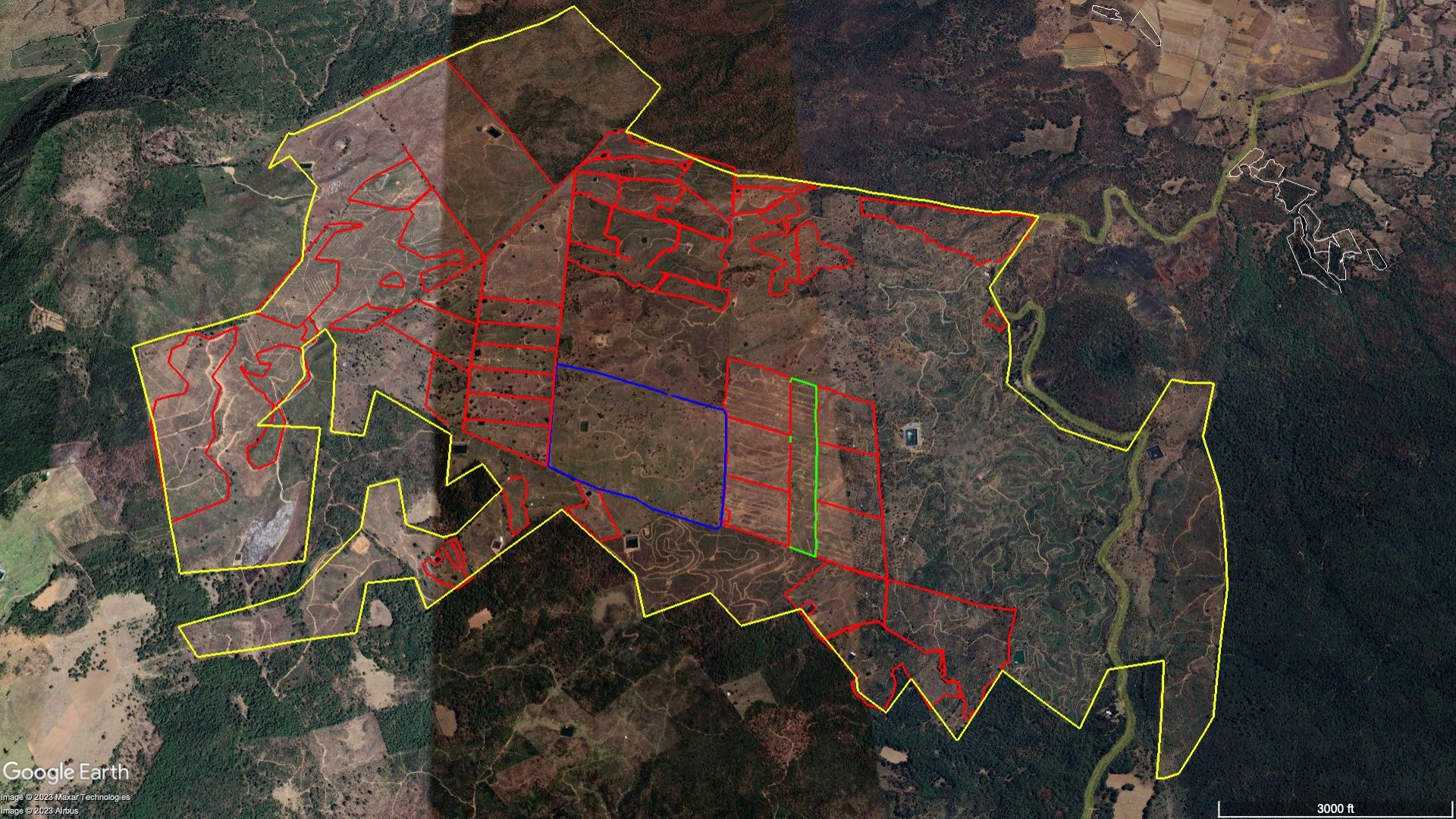
The “before” image, from 2015, shows an area outside of Zacapu, Michoacán. The area outlined in yellow is 2,705 acres. The “after” image is from the same area, and mostly from 2023. It reveals deforestation throughout the yellow-outlined 2,705-acre area since 2015. The red, blue, and green outlines are government maps of avocado orchards certified to export to the United States as of January 2023. Government shipping records indicate that in 2022 the orchard containing deforested land outlined in blue provided 27,510 kilograms of avocados to Mission Produce, while the orchard with deforested land outlined in green provided 25,455 kilograms to West Pak.8Records of “harvest logs” (“bitacoras de cosecha”) provided in transparency law response from National Service of Health, Food Safety and Quality (SENASICA) to request number 330028323000180, June 27, 2023. Orchard HUE08161070708 supplied Mission Produce and orchard HUE08161070572 supplied West Pak.
The total amount of avocado-driven deforestation in Michoacán and Jalisco over the past decade very likely exceeds 40,000 acres (16,000 hectares)—and could be more than 70,000 acres—according to Climate Rights International’s review of government estimates, a study by environmental geographers produced for this report, and of satellite imagery. For context, one acre is nearly the size of an NFL football field, and almost three-quarters the area of a FIFA soccer field.
Over the past decade, Mexican officials have made estimates of annual avocado-driven deforestation in Michoacán that have ranged from 2,900 acres per year to as high as 24,700 acres per year. Michoacán’s Secretary of Environment, Alejandro Méndez, has said that the state’s “most serious environmental issue is the indiscriminate change of land use for avocado crops.”9“Avocado: Business, Ecocide and Crime: Part 1,” (Aguacate: negocio, ecocidio y crimen: Parte 1), UGTV Territory Reporting, Sept. 7, 2022, video clip, YouTube, https://www.youtube.com/watch?v=PaaaJXAx6NQ (accessed September 12, 2023). Eighty-five percent of the area of avocado production in the state is certified for U.S.-export, according to government statistics.
Environmental geographers from the University of Texas at Austin estimate that more than 25,000 acres of Michoacán avocado orchards certified to export to the United States in 2023 are located on land that was covered by forest in 2014.10They produced the estimate for this report by comparing previously unpublished official maps—obtained by CRI—of avocado orchards certified to export to the United States as of February 2023, with Mexican federal government maps of all agricultural lands in Michoacán for the period of 2014-2015, and academic land-use maps identifying forest lands in Michoacán as of 2014. (The study used the 2014 cut-off date because it is the most recent year for which an academic land-use map of Michoacán identifying forestlands is available.) It follows from their conclusion that these estimated 25,000 acres have either been illegally deforested since 2014 or been certified while still containing some forest that could be cleared in the future to produce additional avocados for export. Climate Rights International’s review of the satellite imagery suggests that most of the acres have in fact been illegally cleared.
In addition to the 25,000 acres within export-certified orchards found by the University of Texas at Austin geographers, Climate Rights International identified thousands more acres of forest cleared in Michoacán that are apparently destined for avocado production, much of which is very likely to be certified for export to the United States. There is typically a lag between the creation of an orchard and its certification, as producers don’t seek to certify until their newly planted avocado trees start producing, which takes at least two years.
Prior to 2014, decades of avocado expansion in Michoacán had already caused at least 54,000 acres of deforestation, according to a government study, and possibly as many as 121,000 acres, according to an academic study. The government study highlighted, in 2012, that avocado production in Michoacán had resulted in “drastic[] land-use change and deterioration of the environment.”11Mexico’s National Institute for Forestry, Agriculture and Livestock Research (INIFAP), “Impact of Land-Use Change From Forest to Avocado,” (“Impacto del cambio de uso de suelo forestal a huertos de aguacate”), August 2012, https://www.researchgate.net/publication/265125083_Impacto_del_cambio_de_uso_del_suelo_forestal_a_huertos_de_aguacate_IMPACT_OF_FOREST_LAND_USE_CHANGE_TO_AVOCADO_ORCHARDS, p. 5 (accessed July 11, 2023).
In Jalisco, avocado production is similarly “one of the main direct causes of deforestation,” according to Jalisco’s Secretary of Environment and Territorial Development (SEMADET).12Carmen Gómez Lozano, Director of Biological Corridors and Watersheds, SEMADET, contribution to panel discussion “Environmental Impact of the Production and Trade of Avocados Between Mexico (Jalisco) and Europe,” online event hosted by the Embassy of the Netherlands in Mexico, May 9, 2023, attended by CRI personnel. A study by the agency found that avocado orchards caused at least 12,744 acres of deforestation in Jalisco between 2017 and the first quarter of 2022. The analysis found that the deforestation for avocado production in the state during that period could actually be as high as 47,251 acres, when taking into account likely but unverified avocado orchards, according to a former official with direct knowledge of the analysis.
Overall, Climate Rights International identified U.S.-export certified avocado orchards containing land deforested since 2014 in 41 of the 46 Michoacán municipalities, and 8 of the 10 Jalisco municipalities, approved to export to U.S. consumers as of 2023. (The seven municipalities where we did not find such orchards contain just 0.2% percent of the area of avocado plantings in both states reported by the government.)
Tens—if not hundreds—of thousands of acres of forest in the two states remain at risk of deforestation for avocado exports, according to academic studies.13See, e.g., Audrey Denvir, “Avocado expansion and the threat of forest loss in Michoacán, Mexico under climate change scenarios,” Applied Geography, Volume 151, 2023, https://doi.org/10.1016/j.apgeog.2022.102856 (accessed August 21, 2023).
Our analysis of government records indicates that, over the past two decades, all of the deforestation for avocados in Michoacán, and virtually all of it in Jalisco, has been illegal—in violation of Mexican criminal and administrative laws. Mexican law requires a federal permit to convert forests to agricultural uses. No such permits have been issued in Michoacán for at least two decades; none were issued in Jalisco between 2011 and 2022; and just nine were issued in the state for avocado plantations between 2000 and 2010, according to records obtained by Climate Rights International through Mexico’s transparency law.14Transparency law responses from Mexico’s Secretary of Environment and Natural Resources (SEMARNAT) to requests numbers 330026723000053 (Michoacán) and 330026723000054 (Jalisco), February 7, 2023. Senior officials also confirmed the absence of authorizations in Michoacán.15Climate Rights International (CRI) interview with Rosendo Caro, General Director of Michoacán’s State Forest Commission, Morelia, Michoacán, December 15, 2022; CRI interview with state prosecutor’s office official, Morelia, Michoacán, December 15, 2022; CRI interview with Alejandro Méndez, Michoacán’s Secretary of Environment, Morelia, Michoacán, December 16, 2022; CRI interview with senior federal environmental official, Morelia, Michoacán, December 16, 2022; CRI interview with senior federal environmental official, Morelia, Michoacán, December 16, 2022. See also Pedro Zamora Briseño, “Michoacán: the Environmental Disaster of the ‘Green Gold,’” (“Michoacán: El desastre ambiental del ‘oro verde,’”); Proceso, Oct. 18, 2021, https://www.proceso.com.mx/reportajes/2021/10/18/michoacan-el-desastre-ambiental-del-oro-verde-274116.html (accessed July 12, 2023).
The deforestation often involves intentionally setting the forest on fire, which is also a crime under Mexican law. Climate Rights International identified 185 forest fires in Michoacán over the past decade that directly overlapped with or are right next to a U.S.-export certified orchard, for which the Mexican government’s determination of the cause of the fire strongly implies they were ignited to clear forest and vegetation for avocado production. “When there’s a fire, it’s for avocado. All of them are started intentionally,” said a resident of an avocado-growing region in Jalisco.
Water theft by avocado growers to irrigate their orchards often compounds the illegal deforestation. Many growers in Michoacán and Jalisco extract water from streams, rivers, springs, and wells without required licenses issued by Mexico’s federal concession system.
Interviews with residents and officials, Climate Rights International site visits, and academic studies suggest the problem is widespread. For example, Michoacán’s former top water official, and municipal officials from an avocado-producing hub in Jalisco, each estimated that at least half of the wells in their jurisdictions were unlicensed.16Arturo Molina, “Water Wells Threaten Aquifers in Michoacán: Half of Them are Illegal,” (“Pozos de agua amenazan mantos acuíferos en Michoacán: la midad de ellos son ilegales”), La Voz de Michoacán, Feb. 22, 2020, https://www.lavozdemichoacan.com.mx/michoacan/medio-ambiente/pozos-de-agua-amenazan-mantos-acuiferos-en-michoacan-la-mitad-de-ellos-son-ilegales/ (accessed July 12, 2023); CRI interviews with Zapotlán el Grande officials, Ciudad Guzman, Jalisco, March 17, 2023 (names withheld). The theft thwarts the concession system Mexico has in place to protect watershed (surface water) and aquifer (underground water) supplies, and thus residents’ human right to water.
The illegal deforestation and enormous, frequently illegal, capture and use of water by many avocado producers have caused or contributed to water shortages and the risk of lethal flooding and landslides for local residents across Michoacán and Jalisco.
The clearing of trees for avocado production jeopardizes water availability, as forests play a vital role in helping rainwater enter the ground and recharge the aquifers that supply communities through natural springs and wells. Moreover, to grow just one average, medium-size avocado requires an amount of water equivalent to what a person would use taking a nearly 20-minute shower.17A recent study of avocado production in Uruapan, Michoacán found an average water footprint of 744.3 liters per kilogram of avocados. Alberto Gómez-Tagle et al, “Blue and Green Water Footprint of Agro-Industrial Avocado Production in Central Mexico,” Sustainability 2022, https://doi.org/10.3390/su14159664 (accessed September 11, 2023). The median size of a Hass avocado for export is about 205-265 grams, according to APEAM. APEAM X feed, https://twitter.com/apeamac/status/1123959475990351872 (accessed September 12, 2023). This means there are about 4.25 median-sized avocados per kilogram, and the water footprint would be 175.1 liters per avocado. The U.S. Environmental Protection Agency (EPA) reports that the standard showerhead uses 9.46 liters per minute, meaning that 175.1 liters would be a 18.5 minute shower. EPA, “Showerheads,” https://www.epa.gov/watersense/showerheads#:~:text=Did%20you%20know%20that%20standard,no%20more%20than%202.0%20gpm (accessed September 12, 2023). So producing avocados at the scale that makes Mexico the leading U.S. and global supplier drains—often via water theft—an enormous amount of water from ecosystems. In the words of a federal environmental official, avocado consumption is “at the cost” of “drying up watersheds.”18 CRI group interview with SEMARNAT officials, Mexico City, March 21, 2023. Or, as one community leader put it, “They are exporting our water in the form of fruit.”19CRI group interview with community leaders and residents, Jalisco, 2023 (names and exact dates and locations withheld).
These avocado-driven pressures on water supplies are occurring in a context of water scarcity in the region. Virtually all of the avocado-producing areas of Michoacán, and most of the areas in Jalisco, overlap with watersheds or aquifers that the government has determined to have a “deficit” of water available—meaning that additional water extraction licenses cannot be sustained. Household access to water in these regions is also limited, in some areas ranging from several hours of piped water every other day to months without the service in dry seasons.
Climate Rights International found evidence that in multiple communities, avocado production has significantly undermined residents’ access to water. In some cases, it has impacted their human right to adequate water for personal and domestic use, including by limiting their ability to bathe or wash clothes. For example, in El Atascoso, Jalisco, residents said that a well dug to irrigate a nearby orchard on recently deforested land has dramatically reduced the amount of water in the springs the community relies on for household use, causing some residents to leave their homes and move elsewhere.
One resident of El Atascoso who lives alone after his family members left said that he now only has enough water to bathe once every week or two. He estimates taking just a little over 40 liters of water per day from what is left of the areas’ springs, to drink and use for bathing, washing clothes, flushing the toilet, cleaning dishes, and maintaining a farm animal. He said he cannot afford to buy water.
Deforestation linked to avocado production has also put local populations at risk of catastrophic floods and landslides, according to scientists and government authorities. For example, authorities investigating the causes of a 2019 flash flood in San Gabriel, Jalisco—which killed five people—identified deforestation and forest fires as central causes of the disaster. Climate Rights International found significant evidence linking avocado expansion to the forest fires and the deforestation in the area that preceded the flood.
Conserving forests from avocado expansion will help shield local populations from the foreseeable harms of climate change. The Intergovernmental Panel on Climate Change (IPCC), the world’s leading scientific authority on the subject, projects that global warming will increase drought and aridity in the region where Michoacán and Jalisco are located.20IPCC Working Group I, “Climate Change 2021: The Physical Science Basis,” 2021, https://www.ipcc.ch/report/sixth-assessment-report-working-group-i/, p. 126 (showing for “North Central America” high confidence in increase of mean temperature, extreme heat; heavy precipitation and pluvial flood; aridity; fire weather; and medium confidence of increased agricultural drought at global warming of 2.0-2.4 degrees Celsius). The IPCC also projects that when it does rain, there will be more heavy precipitation, which increases the risk of severe flooding, and can trigger deadly landslides.
The illegal deforestation and large-scale water capture connected to avocado production are increasing the risks these climate-related harms pose to local populations. Depleted aquifers make populations less resilient to drought. And deforestation amplifies the risk of catastrophic floods and landslides.
Furthermore, the deforestation is contributing to the global climate crisis. Forests absorb climate-warming carbon dioxide from the atmosphere and store it as carbon; when trees are cut down or burned, they release the greenhouse gas back into the air. That is why more than 140 governments worldwide—including the United States and Mexico—have made climate commitments to work to end deforestation globally by 2030.21“Glasgow Leaders’ Declaration on Forests and Land Use,” November 2, 2021, https://webarchive.nationalarchives.gov.uk/ukgwa/20230418175226/https://ukcop26.org/glasgow-leaders-declaration-on-forests-and-land-use/ (accessed July 11, 2023).
The conversion of forests to avocado crops reduces the capture and storage of carbon in Mexico. One scientific study recently concluded that the “need to minimize deforestation for avocado expansion is clear, as aboveground carbon storage in Michoacán’s pine-oak forests is more than double that of avocado orchards.”22Audrey Denvir, “Avocados Become a Global Commodity: Consequences for Landscapes and People,” (Ph.D. diss., University of Texas at Austin, August 2023) p. 92. The study compared carbon storage between orchards and native forests at the edge of avocado-producing areas in Michoacán, which are at high risk of conversion to orchards. The findings were similar to a previous academic study concluding that pine-oak forests had 1.7 times higher aboveground carbon content than avocado orchards. Ibid., pp. 71, 91 (citing Ordoñez et al., “Carbon content in vegetation, litter, and soil under 10 different land-use and land-cover classes in the Central Highlands of Michoacán, Mexico,” Forest Ecology and Management (2008), https://doi.org/10.1016/j.foreco.2007.12.024). A 2012 study by Mexico’s National Institute for Forestry, Agriculture and Livestock Research (INIFAP) on the impacts of converting forests to avocado orchards, asserted, based on global academic studies, that forests capture “four to seven times more carbon than the most vigorous fruit orchards.” INIFAP, “Impact of Land-Use Change From Forest to Avocado,” p. 38. The study notes that capture rates depend on many factors, including the age of the trees, and that fruit trees are annually harvested and pruned, so that “part of the captured carbon in the end returns to the atmosphere.” Ibid., p. 37.
For more than a decade, drug cartels and other organized crime groups have maintained a powerful presence in Michoacán and Jalisco, often imposing their control through extreme acts of violence targeting anyone who gets in their way. These groups have sought to profit from avocado expansion in the two states. As documented in this report, they have links to many avocado businesses, ranging from their involvement in deforestation for orchards to owning avocado businesses and extorting those owned by others. In this context, the mere presence of armed men in avocado expansion areas can intimidate residents. These links contribute to a widespread, well-founded belief that it is dangerous to defend the environment and people’s rights from the harmful impacts of avocado businesses.
Greatly intensifying this climate of fear are the repeated threats and attacks against those who have dared to oppose deforestation and water impacts linked to avocado production. Climate Rights International documented more than 30 threats or other acts of intimidation, four abductions, and six shootings—five of which were fatal—that were associated with avocado expansion in Michoacán and Jalisco. For example, in Michoacán, Alfredo Cisneros Madrigal, an Indigenous community leader, was shot dead in February 2023, after reporting to the authorities illegal logging in an area where community members said armed people had been trying to convert forest to avocado orchards. In Jalisco, following the deadly 2019 San Gabriel flood, a state environmental official who documented the deforestation that was a central cause of the disaster began receiving phone calls threatening to kidnap them.
This fear has impeded and deterred efforts by residents and even officials to protect forests and water. For example, in Madero, Michoacán, where one activist was kidnapped in 2021 and another threatened at gunpoint in 2022, fellow environmental defenders said they limited their efforts to denounce and confront deforestation and water theft because they feared violent reprisals. In Jalisco, an experienced journalist working in an avocado-producing region told Climate Rights International that it is prohibitively dangerous to investigate and publish stories about deforestation for avocados there.
Authorities in Michoacán and Jalisco also said that the presence of organized crime and fear of violence significantly impede their ability to contain illegal deforestation and water theft. They described multiple occasions in which the presence of armed men—presumed members of organized crime—forced them to abort field operations. Officials said some avocado expansion areas are simply too dangerous for them to go to without being escorted by security forces.
Much of the avocado-growing region of Michoacán has substantial Indigenous Purépecha populations, and some of the production areas of Jalisco have Indigenous Nahua populations. According to one academic article, in 11 avocado-growing municipalities of Michoacán that constitute the “Meseta Purépecha” region, 60 percent of the population identified as Indigenous Purépecha, when excluding the region’s main urban center of Uruapan.23Alfonso De la Vega-Rivera and Leticia Merino-Pérez, “Socio-Environmental Impacts of the Avocado Boom in the Meseta Purépecha, Michoacán, Mexico,” Sustainability (2021), https://doi.org/10.3390/su13137247 (accessed July 13, 2023). Many communities have Indigenous governing authorities—called community councils—and traditional communal lands.
Residents of some of these communities have organized to prevent deforestation for avocado production. In Cherán, Michoacán, following years of illegal logging and violence, community members rose up in 2011 to expel municipal authorities, who they accused of corruption. They set up an autonomous government, prohibited the planting of avocado on communal lands, and established their own police force—which was subsequently authorized by the state government—to patrol and protect the forests.24CRI interviews with residents, Cherán, Michoacán, March 2, 2023. Cherán has had enormous success in protecting its forests from the expanding avocado frontier. (Satellite images in Appendix A show this success.)
Nevertheless, the efforts of several other Indigenous communities to shield forests from avocado expansion have been severely undermined by killings, kidnappings, and threats against leaders and members. For example, since the community of Ocumicho, Michoacán issued a resolution in 2018 prohibiting outsiders from planting avocado within their community, two community leaders were shot, one fatally, and another kidnapped, and a community patrolman who had participated in efforts to stop deforestation was killed in December 2022.
In this context, Ocumicho’s Indigenous authorities have struggled to enforce a community rule against selling or renting communal lands. Climate Rights International identified Facebook posts from 2023 advertising plots for avocado production within Ocumicho’s communal land. Trees had been cleared in each of the plots. One of them borders an orchard that also is located in an area community leaders identified as communal territory, contains deforested land, and according to government records, supplied more than 15,000 kilograms of avocados to West Pak and Mission Produce in 2022.25 Records of “harvest logs” (“bitacoras de cosecha”) provided in transparency law response from SENASICA to request number 330028323000180, June 27, 2023. The orchard number is HUE08160210404.
The U.S. and Mexican governments have a range of obligations and commitments to stop deforestation, uphold human rights, and enforce environmental laws, including:
When it comes to the avocado trade, the Mexican and U.S. governments are not meeting these obligations and commitments.
The unauthorized deforestation for avocado orchards is a federal crime enforceable in Michoacán and Jalisco. It is also a state crime in Michoacán, but not in Jalisco. The crimes are called illegal “land-use change” and are punishable by between six months and nine years of prison. As noted above, all of the deforestation for avocados in Michoacán over the past two decades, and virtually all of it Jalisco, appears to have been in violation of these laws.
Officials recognize that the perpetrators are rarely held accountable for the crimes. Michoacán’s environment secretary said the “lack of order and control has come at the cost of the forest and puts at increasing risk our biodiversity, the provision of water, and the forests in this state.”27 “Avocado: Business, Ecocide and Crime: Part 1,” UGTV Territory Reporting, Sept. 7, 2022, video clip, YouTube. In the words of the head of Michoacán’s forest commission, the violators “laugh at our impotence.”28CRI interview Rosendo Caro, General Director of Michoacán State Forest Commission, Morelia, Michoacán, December 15, 2022.
While fear of reprisals plays a major deterrent role for some officials, another important reason for this impunity is corruption, particularly in the unit of Michoacán’s State Prosecutor’s Office dedicated to investigating deforestation for avocados, according to multiple state and federal officials who spoke with Climate Rights International, as well as residents.
Illegal land-use change is also a violation of federal administrative laws protecting the environment, potentially punishable with non-prison sanctions ranging from fines and closures of orchards to the forfeiture of products, and orders to restore the affected areas. While the federal environment enforcement agency has imposed some sanctions, they have not effectively deterred or reversed the land-use changes. Climate Rights International identified several orchards that were certified for U.S. export as of January 2023 despite having been sanctioned by the federal government between 2015 and 2022 for illegal land-use change.
The federal water agency that is charged with investigating and administratively sanctioning water theft rarely does so in Michoacán and Jalisco.
The following two Google Earth images show that avocado growers have been able to establish orchards on illegally deforested land in close proximity to Michoacán’s Specialized Prosecutor’s Office in Combatting Crimes Against the Environment and Fauna, which is charged with pursuing cases of deforestation for avocado production.29Most of the land-use change depicted in the images may have predated the establishment of the unit in 2019; however, at least part of the nearby illegal deforestation for avocado would still be obvious—and easily verifiable on Google Earth—to anyone working at the unit. CRI confirmed in a field visit—and through Google Earth imagery—that at least one of the orchards is in direct, unimpeded sight from the office.


The “before” image is a Google Earth image from February 2015. The “after” image is from May 2023. The yellow star denotes the location of the office; the purple shows deforestation sites for orchards identified by Climate Rights International; and the blue shows areas that have already been certified for U.S. export.
To its credit, the office of Michoacán’s environment secretary has promoted some potentially valuable measures to curb avocado-driven deforestation. In 2023, the agency invested in a satellite analysis tool that emits automated deforestation alerts to authorities, and has worked with experts to propose a voluntary environmental certification system for avocado growers. Yet these efforts are insufficient. For the satellite tool to make a meaningful difference, enforcement authorities would have to effectively act on the alerts—but there’s little reason to expect they will, given their poor track record in addressing flagrant illegalities. If approved, the certification system would be voluntary rather than a requirement for selling avocados to domestic or international markets, so businesses could still make money by clearing forests for orchards.
Mexico exports nearly half of its avocado production, with about 80 percent going to the United States. Between January 2019 and April 2023, Mexico exported to the United States 4.7 million metric tons of avocados, worth US$11 billion, including avocados worth US$3 billion in 2022, according to Mexican customs data compiled by the company Treid. During that period, Mexico also exported billions of dollars of avocados to Europe, Asia, and other North American countries, including US$932 million to Canada, US$708 million to Japan, US$245 million to Spain, US$172 million to the Netherlands, US$144 million to France, US$55 million to China, and US$54 million to the United Kingdom.30Mexican customs data, processed by Treid.co.
None of these countries have policies in place to prevent avocados grown on illegally deforested land from entering their markets. The United States’ lack of such a policy is particularly germane to the environmental destruction in Mexico, given its dominance of international demand. The United States’ inaction represents a failure of the Biden administration to follow through on its commitments to work to end global deforestation and promote trade policies “that do not drive deforestation,”31“Glasgow Leaders’ Declaration on Forests and Land Use,” November 2, 2021. as well as to make “climate considerations” an “essential element of United States foreign policy.”32The White House, “Executive Order on Tackling the Climate Crisis at Home and Abroad,” January 27, 2021, https://www.whitehouse.gov/briefing-room/presidential-actions/2021/01/27/executive-order-on-tackling-the-climate-crisis-at-home-and-abroad/ (accessed September 12, 2023).
For a Mexican orchard to produce avocados for export to the United States, and a packinghouse to process them, each must be certified by both Mexican authorities and the USDA’s Animal & Plant Health Inspection Service (APHIS). The certification criteria and process, set forth in an Operational Work Plan (OWP) signed by the two countries, seeks to prevent the spread of potential avocado pests.33SENASICA, “Operational Work Plan (OWP): Systems Approach for the Importation of Fresh Hass Avocado from Mexico into the United States,” (“Plan de Trabajo Operativo (PTO): Enfoque de Sistemas para la Importación de Aguacate Fresco Hass de México a Estados Unidos”), December 6, 2021, https://www.gob.mx/senasica/documentos/aguacate-hass?state=published (accessed July 11, 2023). The OWP does not contain any deforestation, environmental, or human rights requirements for exporting avocados.
Climate Rights International obtained documents through Mexico’s transparency law indicating that U.S. officials failed to act upon a 2021 proposal, by senior Mexican officials, to add a provision to the OWP bilateral agreement that would preclude the certification for export of orchards located on illegally deforested land. Rather than adopting this environmental protection in the OWP, U.S. authorities made a different change to the export agreement later that year: they approved Jalisco as the second state, after Michoacán, allowed to export avocados to the United States.
Records obtained through the Freedom of Information Act (FOIA) show that the U.S. government made the Jalisco approval without adopting measures to address the risk that, as a U.S. government report alerted at the time, it was “likely to increase deforestation” in Jalisco, as “market pressures” had done in Michoacán. U.S. authorities also ignored a 2021 letter from a Jalisco family to the United States Trade Representative (USTR) and the Ambassador to Mexico, reporting that their land had just been invaded and deforested for avocados, and warning that U.S. consumers would soon receive “large quantities of avocados from orchards whose origin and operation have criminal roots.”34Letter from Jalisco family to Ken Salazar, U.S. Ambassador to Mexico and Katherine Tai, U.S. Trade Representative, September 13, 2021 (translated by U.S. government), obtained via FOIA request from USTR. The USTR is charged with monitoring and enforcing the USMCA provision requiring that parties to the trade deal effectively enforce their environmental laws.
The FOIA records, and other credible evidence, also strongly suggest that the Jalisco approval was in exchange for U.S. potato growers gaining access to Mexican markets. This apparent quid pro quo underscores that the United States has significant discretion in its policy towards Mexican avocado exports. It also makes the U.S. approach to avocados an even more glaring example of agribusiness interests taking precedent over the environment—a global phenomenon deepening the climate crisis.
Businesses have a responsibility to respect human rights and the environment, as articulated in the UN’s Guiding Principles on Business and Human Rights and the Organization for Economic Cooperation and Development (OECD)’s Guidelines for Multinational Enterprises on Responsible Business Conduct. For companies that sell avocados—ranging from packinghouses, exporters, and importers to supermarkets—these responsibilities include conducting due diligence to identify, prevent, and mitigate human rights and environmental harms in their supply chains.
Yet, Climate Rights International found strong reasons to conclude that key companies in avocado supply chains from Mexico to the rest of the world are not fulfilling their responsibility to conduct adequate due diligence to address the deforestation and other related risks.
Using government orchard maps and shipment records, we identified 75 orchards containing land that was deforested—apparently illegally—and that supplied in 2022, along with other producers, at least one of the following five major companies that exported and imported avocados from Mexico to the United States: Aztecavo,35News reports and public records suggest that Aztecavo has in recent years maintained strong corporate links to—and possibly been partially owned by—Westfalia Fruit, a multinational fruit company that claims to have “the largest avocado-growing footprint in the world.” This information is set forth in Appendix K. Westfalia officials did not respond to CRI emails about the nature of the relationship between Westfalia and Aztecavo. Calavo,36The records list “Calavo de Mexico, S.A. de C.V.” Calavo Growers, Inc.’s annual Form 10-K filing with the SEC, filed in December 2022, refers to “Calavo de Mexico S.A. de C.V” as a “wholly owned subsidiary.” Calavo Growers, Inc., Form 10-K, https://ir.calavo.com/static-files/9c13da31-3239-4843-8d91-6cff65c6bbf7 (accessed September 11, 2023). Fresh Del Monte Produce,37The records refer to “Del Monte Grupo Comercial, S.A. de. C.V.” Fresh Del Monte Produce, Inc.’s Chief Sustainability Officer confirmed to CRI that Del Monte Grupo Comercial S.A. de C.V. is a subsidiary of Fresh Del Monte Produce, Inc. Email from Hans Sauter, Fresh Del Monte Produce, Inc. Chief Sustainability Officer, to CRI personnel, September 5, 2023. A 2019 filing with the SEC also states that “Del Monte Grupo Comercial, S.A. de. C.V.” is a “subsidiary” of Fresh Del Monte Produce, Inc. Second Amended and Restated Credit Agreement, https://www.sec.gov/Archives/edgar/data/1047340/000119312519263746/d813314dex101.htm (accessed September 11, 2023). Mission Produce,38The records list “Mission de Mexico, S.A. de C.V.” Mission Produce, Inc.’s annual Form 10-K filing with the U.S. Securities and Exchange Commission (SEC), filed December 22, 2022, lists “Mission de Mexico, S.A. de C.V.” as a “subsidiary.” Mission Produce, Inc., Form 10-K, Exhibit 21.1, https://www.sec.gov/Archives/edgar/data/1802974/000180297422000050/exhibit211subsidiariesofre.htm (accessed September 11, 2023). and West Pak Avocado.39The records refer to “Grupo West Pak de Mexico, S. de R.L. de C.V.” Available information strongly indicates that Grupo West Pak is a subsidiary of West Pak, even though West Pak executives did not respond to CRI emails seeking to confirm the subsidiary status. For this information, see Appendix K. Each of these companies was supplied by at least 14 such orchards; and all are U.S.-based except Aztecavo, which is a Mexican company. The 75 examples shown in this report are illustrative and not a complete accounting of the orchards containing deforested land that, according to government records, supplied the five companies in 2022; and U.S.-export certified orchards containing illegally deforested land supplied many other packinghouses in 2022 in addition to the five companies.
The four U.S. companies are vertically integrated, meaning they or their subsidiaries own packinghouses in Mexico, export abroad, and control imports within the receiving country, before distributing to retailers. According to Mexican customs data compiled by the company Treid, the companies exported the following values of avocados from Mexico to the United States between January 2019 and April 2023: US$884.6 million (Aztecavo); US$505.2 million (Calavo); US$803.4 million (Fresh Del Monte); US$1.392 billion (Mission Produce); and US$278.5 million (West Pak).
These companies—which according to government records strongly appear to have sourced a portion of their avocados in 2022 from orchards containing illegal deforestation—have in turn supplied major supermarkets, according to Climate Rights International store visits, company websites, and disclosures to the U.S. Securities and Exchange Commission (SEC). For example, in 2023, Climate Rights International found Calavo-labeled avocados, produced in Mexico, being sold at Whole Foods, Trader Joe’s, Walmart, and stores owned by Albertsons and Kroger; and an SEC filing by Calavo reports that sales to Kroger, Trader Joe’s, and Walmart accounted for roughly 15 percent, 11 percent, and 10 percent of total net sales in 2022.40Calavo Growers, Inc., Form 10-K, https://ir.calavo.com/static-files/9c13da31-3239-4843-8d91-6cff65c6bbf7 (accessed September 11, 2023) Aztecavo’s website reports that its “end customers” include Whole Foods, Trader Joe’s, Walmart, Costco, Albertsons, Kroger, and Sprouts, among others.41Aztecavo website, “End Customers,” https://www.aztecavo.com.mx/our-final-customers (accessed September 18, 2023). In 2023, CRI also found Mission Produce-labeled avocados at Costco, and West Pak-labeled avocados at Kroger, Costco, and Target.
Beginning in April 2023, Climate Rights International sent letters to Mission Produce, Calavo, Fresh Del Monte, West Pak, and Aztecavo—and five other significant U.S.- or Netherlands-based importers—requesting detailed information about their due diligence policies and practices to address deforestation and other harms in avocado supply chains from Mexico. We also sent letters requesting such information to 11 major supermarkets with stores in the United States, Europe, and across the world: Ahold Delhaize, Albertsons, ALDI US, Amazon.com (and Whole Foods), Costco, Kroger, Lidl, Sprouts, Trader Joe’s, Target, and Walmart.
Of the 21 companies, seven responded, and only two—Walmart and Lidl—provided more than limited, boilerplate information. Just one—Lidl—provided information suggesting that it has adequate due diligence to prevent their avocado supply from Mexico from being contaminated with deforestation and other harms. Lidl stated that it requires independent certification for avocados sourced from Mexico, and referred to requirements that supply chains be deforestation free as of 2014, and that producers comply with water laws.
Most of these companies publicize—including on websites and investor reports—codes of conduct for their general global operations. These codes of conduct generally state that suppliers must comply with certain environmental and human rights requirements—including not violating environmental laws of their countries of operation—and refer to the possibility of audits. But Climate Rights International was unable to find clear publicly available information from these companies about what measures, if any, they have actually taken to audit and ensure compliance with those codes in avocado supply chains from Mexico.
The Association of Avocado Exporting Producers and Packers of Mexico (APEAM), a Michoacán-based industry group that is funded by and represents all producers and packers who export to the United States, does not conduct due diligence to address deforestation or water theft. APEAM told Climate Rights International that it does not have any polices or practices in place to:
The widespread illegal deforestation among U.S.-export certified orchards and apparent contamination of supply chains of key companies such as Calavo and Mission Produce in 2022—combined with the apparent lack of due diligence by importers, exporters, and supermarkets, and admitted lack of due diligence by APEAM—create a high likelihood that a portion of avocados from Mexico sold at supermarkets were grown on illegally deforested land.
The avocado industry has made numerous false and misleading sustainability claims, while simultaneously failing to conduct due diligence that would give consumers any confidence that the avocados they buy are free of environmental or human rights harms. For example:
Mexico, the United States, the European Union, and other countries that produce, export, and/or import avocados should adopt laws and regulations to preclude access to the marketplace for avocados produced as the result of serious violations of environmental or human rights standards.
These laws and regulations should require that companies conduct transparent due diligence to ensure they are not sourcing avocados from orchards containing recently deforested land. Companies should be required to identify, prevent, and mitigate other environmental harms and human rights violations in their supply chains.
Companies should be required to provide or cooperate in effective remediation for affected persons and communities if they have caused or contributed to deforestation or human rights violations. The remediation should include funding for impacted communities’ efforts to conserve forests and restore damaged ecosystems, and compensation for human rights violations.
Companies should be required to establish mechanisms to receive, investigate, and address complaints of abuses such as violence or intimidation against local residents or unlicensed water capture.
Companies in global avocado supply chains should voluntarily adopt the full range of due diligence and remediation policies outlined above, even in the absence of laws and regulations requiring them.
The cut-off year for what constitutes “recently” deforested land that would trigger exclusions from purchases and trade should be established in consultation with relevant stakeholders, including civil society and impacted communities. A possible cut-off date would be 2014, the year Mexico, the United States, and many other countries signed the New York Declaration on Forests, in which they committed to ending natural forest loss. The 2014 cut-off has been considered by Michoacán authorities for a possible voluntary certification scheme. Another possibility related to North American markets would be 2020, when the United States-Mexico-Canada Agreement’s provisions requiring parties to effectively enforce environmental laws entered into force. For the European Union, the cut-off date could also be 2020, in accordance with the EU Deforestation Regulation, which applies to deforestation that has occurred after December 31, 2020. (The regulation does not currently cover avocados, but they should be added at the earliest possible date.)
Regulators and companies should rely on orchard maps and satellite imagery where available to verify the absence of recent deforestation.
A full set of recommendations can be found at the end of this report. Specific key recommendations include:
The Government of Mexico Should:
The Government of the United States Should:
Avocado Packers, Exporters, Importers, and APEAM Should:
Supermarkets Should:
Between December 2022 and June 2023, Climate Rights International conducted seven research trips to the states of Michoacán and Jalisco, including visits to the state capitals of Morelia and Guadalajara, as well as 13 other municipalities in Michoacán, and three more in Jalisco. Climate Rights International conducted interviews with nearly 200 people in these locations and in Mexico City, and by telephone or videocalls, including with 110 residents and activists; 48 Mexican officials at the federal, state, and local levels; 16 academics with expertise in forestry, hydrology, and environmental geography, among other areas; 12 avocado producers or industry representatives; three officials from the U.S. Department of Agriculture’s Animal & Plant Inspection Service; and seven international NGO workers. No compensation or other incentives were offered to interviewees.
We submitted more than 85 information requests to government agencies under Mexico’s Federal Law of Transparency and Access to Public Government Information (“transparency law”) and received substantive responses to most of those requests. We also submitted Freedom of Information Act (FOIA) requests to six U.S. government agencies and received substantive responses from three. Climate Rights International also reviewed numerous scholarly, media, and government reports.
There are references throughout the report to government maps of avocado orchards in Michoacán and Jalisco certified by U.S. and Mexican authorities to export to the United States. These previously unpublished polygon maps of orchards were provided to Climate Rights International on January 23, 2023, by Mexico’s National Service of Health, Food Safety and Quality (SENASICA), in response to transparency law request 330028323000032. Climate Rights International analyzed the maps (provided in KMZ and KML format) on Google Earth Pro, which allows the viewer to review sequences of satellite images of the same pieces of land over time, and thus detect deforestation within the polygon maps of orchards. For the vast majority of polygons of orchards in Michoacán, an official orchard registration number was provided, beginning with HUE0816.
The report also has many examples of export-certified orchards containing deforested land that, according to government shipping records, supplied major packinghouses, importers, and exporters in 2022. These previously unpublished records are called “Harvest Registration forms” (Bitácora de Cosecha, BICO), and they were provided by SENASICA in June 2023 in response to transparency law request number 330028323000180. BICO records accompany each shipment of avocados from an orchard to a packinghouse that is ultimately destined for U.S. export. Climate Rights International obtained the BICO records for Michoacán orchards. The BICO record lists the official registration number of the orchard of origin (beginning with HUE0816 for Michoacán orchards) and the packinghouse destination. By comparing the registration numbers associated with the polygon maps of export-certified orchards with the registration numbers in BICO records of shipments, Climate Rights International identified instances of orchards with illegally deforested land that supplied major companies in 2022.
The Google Earth images in the report are from the providers Airbus, Maxar Technologies, CNES, and Landsat/Copernicus.
Throughout the report, identifying details are withheld for many interviewees and individuals, including withholding names and specific dates and locations of interviews, either because requested or when CRI believed publishing the information could put them at risk. We use the pronoun “they” in several parts of the report to refer to an individual without revealing their gender.
In 2016, a man with a plot of land in Zacapu received a call from a friend alerting him that there were people cutting down his trees and that they were going to take over his land for avocado production.48CRI interview with Javier (pseudonym), Michoacán, 2023 (name, location, exact date withheld). The man, called Javier here as a pseudonym, immediately went to his land (he does not live there) and saw men clearing trees with chainsaws and heavy machinery.
Javier, who spoke with Climate Rights International on the condition of anonymity, recounted subsequently learning that the land had been sold by third parties, without his knowledge, to individuals he believes are linked to organized crime. Neighboring plots of land had also been taken over and deforested for avocado production. One neighbor told Climate Rights International that, around 2017, when he tried to accompany judicial police to inspect the deforested lands, they ran into men with rifles who told them they could not enter.49CRI interview with resident, Michoacán, 2023 (name, location, exact date withheld).
The hills of Zacapu, where Javier’s land is located, have been the site of repeated forest fires. On April 6, 2017, following one such fire, the then-secretary of environment of Michoacán reportedly announced:
The avocado growers who started this fire should not get too excited, we’re not going to let this go with impunity, we’re going to do everything so that this natural disaster does not remain in impunity.50“The Ambition of a Few Won’t be Allowed to Finish Off the Forests,” (“No se premitirá que ambiciones de unos cuantos acaben con bosques”), Quadratín, April 6, 2017, https://www.quadratin.com.mx/sucesos/se-permitira-ambiciones-unos-cuantos-acaben-bosques/ (accessed July 11, 2023).
News articles, apparently based on an official press release, reported that the fire burned for three days, and that firefighters were initially prevented from reaching the fire. They were only able to put it out when public security forces intervened to enable them to gain access to it.51Ibid.; “Environmental Security Working Group: Zacapu Is Not Alone, The Ambition of a Few Won’t be Allowed to Finish Off the Forests,” (“Mesa de Seguridad Ambiental: Zacapu no está solo, no se va a permitir que ambciones de unas personas acaben con los bosques”), Mexico Ambiental, April 8, 2017, https://www.mexicoambiental.com/mesa-seguridad-ambiental-zacapu-esta-se-va-a-permitir-ambiciones-unas-personas-acaben-los-bosques/ (accessed July 11, 2023).
A local radio journalist who reported on fires in Zacapu, as well as on deforestation and coercion to sell land for avocado, was threatened.52CRI interview with journalist, Michoacán, 2023 (name, location, exact date withheld). At first, she received threatening calls at her radio station, telling her to stop “screwing around” with these issues. When she continued, she received another. The voice on the line called her a “bitch,” and said she would put out the fires “with your ass.” Two days later, she received the same message in a written note placed on her car. After that threat, the head of the radio station told her not to report on such issues because it put everyone who worked there at risk.
In September 2019, Adolfo Perez Diaz, the co-president of an association of property owners in the area where Javier’s land is located, was shot dead in Zacapu.53CRI interviews with residents, Michoacán, 2023 (names, locations, exact dates withheld). United Mexican States, Death Certificate, Adolfo Perez Diaz, September 18, 2019. Paciano Anguiano, who also had a leadership role in the association of property owners, was killed in the same attack.54CRI interviews with residents, Michoacán, 2023 (names, locations, exact dates withheld); United Mexican States, Death Certificate, Paciano Anguiano Garcia, September 19, 2019. One community member told Climate Rights International that, prior to being killed, Perez had told him he was threatened in relation to the takeover of land for avocados.55CRI interviews with residents, Michoacán, 2023 (names, locations, exact dates withheld).
Around the same year as the killings, Javier filed a complaint with the prosecutor’s office stating that, after visiting his land and seeing it being fenced off, he received a phone call telling him he would be killed if he returned again.56Complaint filed with Michoacán State Prosecutor’s Office, 2019 (exact date and case number withheld). The complaint states that 15 men had been clearing his land with the intention to plant avocado. In 2020, he filed another complaint stating that he had again tried to visit his land and been threatened by men there.57Complaint filed with Michoacán State Prosecutor’s Office, 2020 (exact date and case number withheld).
In June 2021, Javier and his neighbors delivered a letter addressed to the then governor-elect of Michoacán, listing the names of 20 people and communities whose property had been “taken over” and “logged” by people who “threaten that if you want to fight for your land you have to come up against armed people, in what are now avocado orchards.”58Letter addressed to then-Michoacán Governor-Elect Alfredo Ramírez Bedolla, June 18, 2021. Javier said the letter was delivered. The letter requests investigations, help recovering lands, and to “freeze the accounts of the armed ones and their allies in crime,” who “threaten that our lives are worth very little compared to what they’ve taken from us.”
Javier said that in 2022, when he visited his land to take photographs, a truck rushed at him, leading him to run and hide in a nearby avocado orchard.
Others also described acts of armed intimidation and a climate of fear surrounding the deforestation for avocados in Zacapu. A member of the Indigenous forest guard of Cherán, Michoacán said that, when patrolling the outer limits of Cherán that borders Zacapu, he has seen workers in Zacapu avocado orchards armed with rifles.59 CRI interview with member of Indigenous forest guard, Cherán, Michoacán, March 2, 2023. One local environmental activist in Zacapu told Climate Rights International that they would be afraid to denounce deforestation for avocado production because of the presence of armed men in the areas of the land-use change. Another said they had been warned by an official not to cause trouble for the people deforesting the hills of Zacapu because these people were linked to organized crime and could “disappear you.”60CRI interview with resident, Michoacán, 2023 (name, location, and exact date withheld).
Meanwhile, the government has not fulfilled the promise by the environment secretary, in 2017, to ensure accountability for the “avocado growers who started” the April 2017 fire. Avocado orchards were subsequently installed in the same location as the fire he denounced, according to satellite imagery and heat points detected by Mexico’s Fire Alert System.61See Appendix B. These orchards are in an area where large tracts of deforested land have been certified for export to the United States. While they themselves have not yet been certified, there is nothing to prevent them from obtaining certification, like the vast majority of Michoacán orchards.
The following Google Earth satellite images show large-scale deforestation in Zacapu for avocado orchards, including many that have already been certified to export to U.S. consumers.
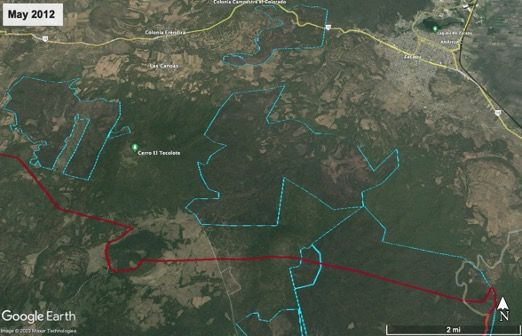
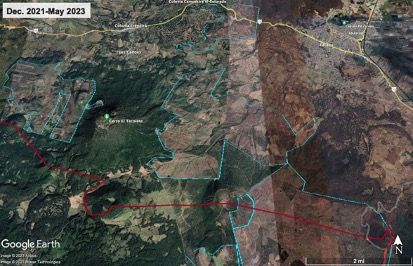
These two Google Earth satellite images are from 2012 (“before”) and a composite of 2021-2023 (“after”). Everything above the red line is an area of Zacapu municipality. The light blue line delineates focal points of deforestation identified by Climate Rights International, though the entirety of the area within the light-blue outlines—here and in images below—is not necessarily deforested.
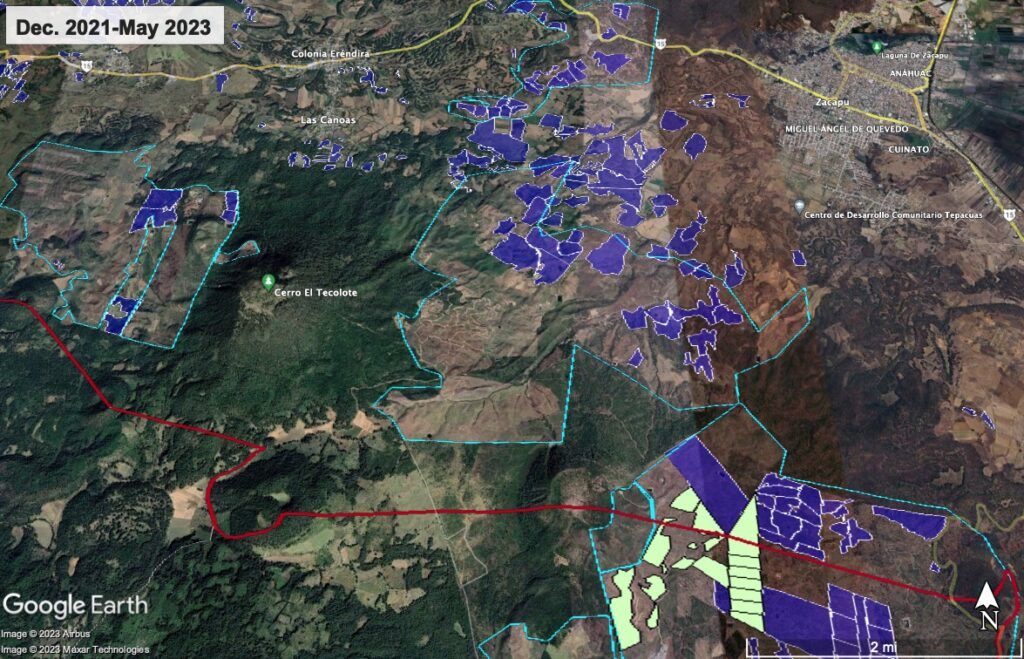
This is the same image as the 2021-2023 composite directly above, but with dark blue and green polygons showing U.S.-export approved orchards as of January 2023,62Polygons of export orchards provided in transparency law response from SENASICA to request number 330028323000032, January 23, 2023. many of which are in deforested areas.
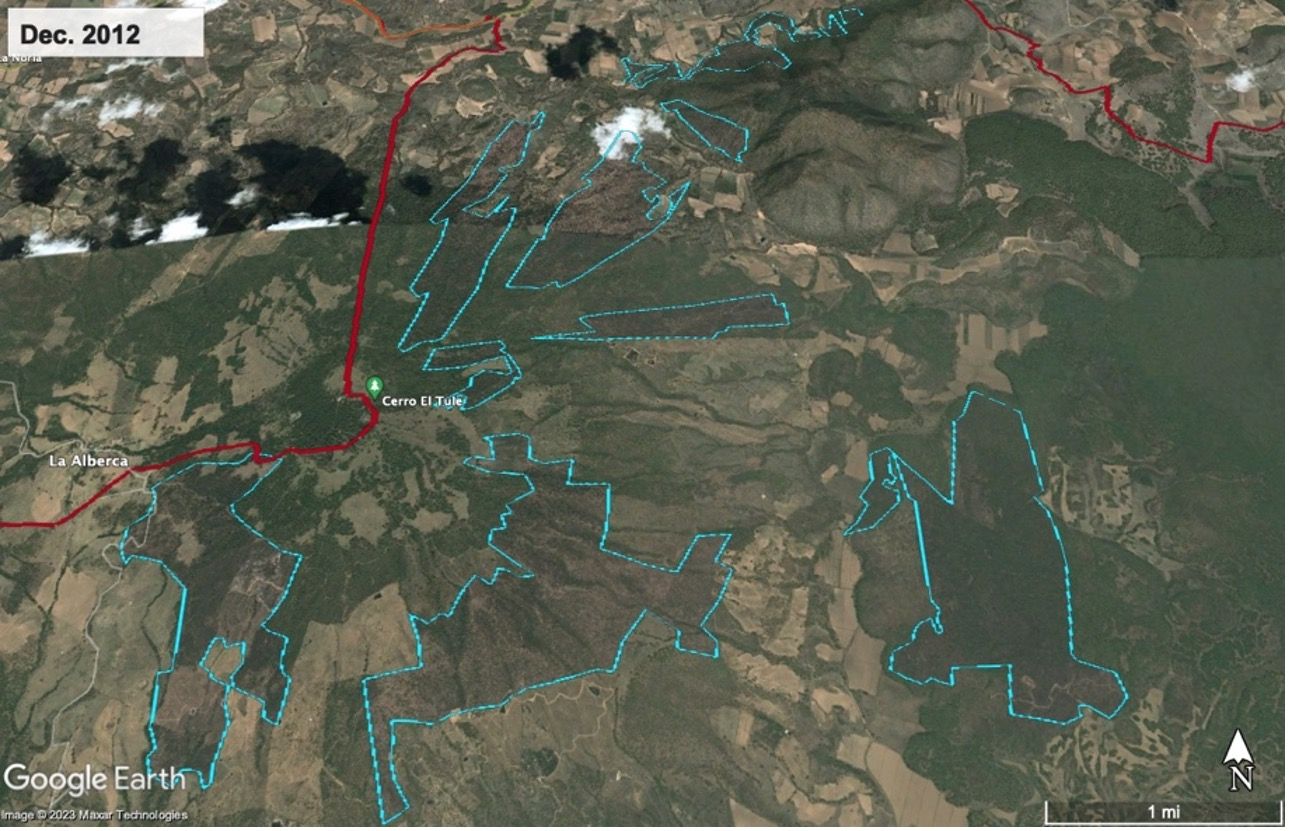
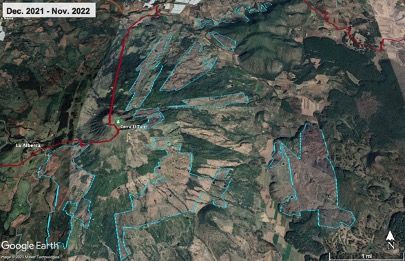
These two Google Earth satellite images show a different area of Zacapu from 2012 (“before”) and a composite of 2021-2022 (“after”). Everything to the right and below the red line is Zacapu.
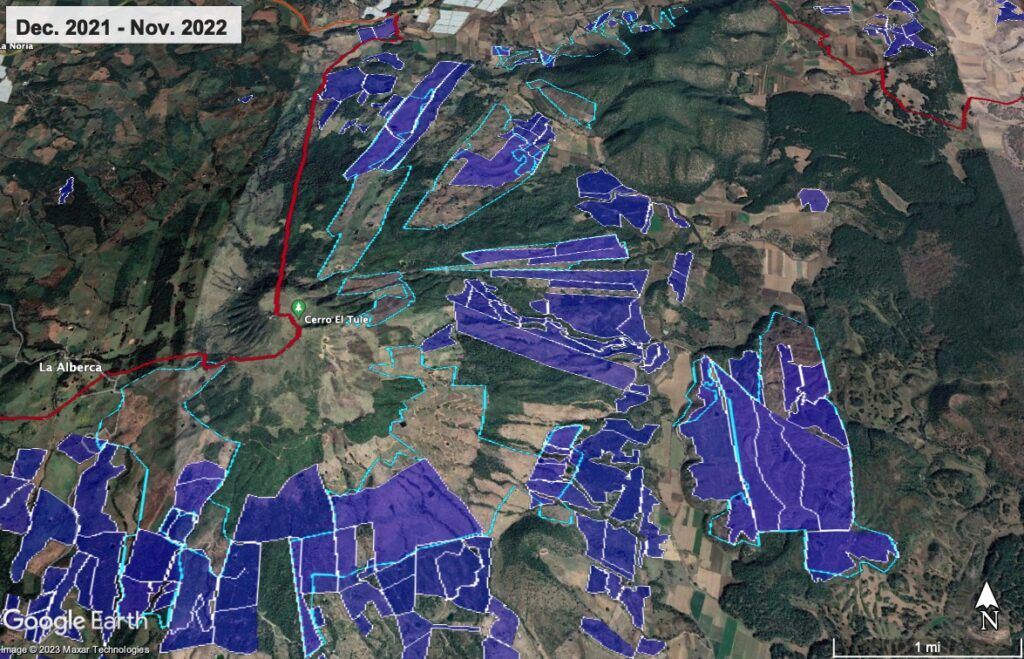
This is the same image as the one directly above, but with dark blue polygons showing U.S.-export approved orchards as of January 2023.
Townspeople of Patuán told Climate Rights International that they cried as they watched the forested Cobrero Hill that towers over their village go up in flames.63CRI interviews with residents and officials, Patuán, Michoacán, January 25, 2023 (names withheld). Over the previous five years, they had observed, powerlessly, as armed men in trucks drove through town, day and night, with the wood they had illegally logged from the hill. They had been warned by a leader of an organized crime group not to interfere with the plundering of wood from the hill, where avocado orchards had been expanding. But the scale of the fire that started on April 30, 2022, devouring Cobrero Hill, sparked the community to organize.64Ibid.
With state and federal firefighters occupied fighting fires in neighboring Uruapan—including one officially classified by the Forest Commission of Michoacán (COFOM) as intentionally started for land-use change—65Transparency law response from COFOM to request number 160336023000002, February 7, 2023. (Data for fires 22-16-0456 and 22-16-0457.) Patuán residents took matters into their own hands: they climbed up the hill to start combatting the fire themselves. The residents, and firefighters who later arrived, observed that when they suppressed the fire in one location, it moved to another part of the hill, leading residents and officials to conclude that the fire was being intentionally.66CRI interviews with residents and officials, Patuán, Michoacán, January 25, 2023; CRI telephone interview with forest-sector official in Michoacán, February 10, 2023 (name withheld).
A resident told Climate Rights International:
It hurt our souls because we love this hill. We grew up here and it meant a lot to us. They set it completely on fire to the point that we couldn’t do anything…. The goal was land-use change, to plant avocados.67CRI interview with resident, Patuán, Michoacán (name and date withheld).
All told, the fires burned 284 acres of trees and 1,946 acres of shrubs and vegetation, according to government figures.68Transparency law response from COFOM to request number 160336023000002. (Data for fire 22-16-0459). Michoacán’s Secretary of Environment stated: “It’s presumed that the hill was burned by people who wanted to change the land use, remove the forest to put—more than anything else—avocado orchards, which is what there is in that area.”69“The Town That Said Enough! Resisting Illegal Land-Use Change,” (“El pueblo que dijo basta! Resistir al cambio ilegal de uso de suelo”), Sept. 10, 2022, video clip, Facebook, https://www.facebook.com/SistemaMichoacano/videos/654609972756042/?extid=NS-UNK-UNK-UNK-IOS_GK0T-GK1C (accessed July 11, 2023). Another environmental official told Climate Rights International: “Obviously they start the fire looking [to plant] avocado. That was the origin of the fire.”70CRI telephone interview with environmental official, February 10, 2023 (name withheld).
After the fire, residents set up a 24-hour checkpoint at the entrance to town, to review entering trucks for avocado plants and tools related to avocado production.71 CRI interviews with residents and officials, Patuán, Michoacán, January 25, 2023 (names withheld). Children marched in the streets opposing deforestation, chanting “not one more pine!”72“In Defense of the Cobrero,” (“En defensa del Cobrero”), May 16, 2022, video clip, Facebook, https://m.facebook.com/story.php?story_fbid=684514915991155&id=100007548521364&sfnsn=scwspwa&mibextid=RUbZ1f (accessed July 11, 2023).
The community checkpoint lasted three months. Two weeks after it ended, trucks started entering the area with avocado plants. Residents and officials told Climate Rights International that avocado has subsequently been planted in parts of the area of the fire.73CRI interviews with residents and officials, Patuán, Michoacán, January 25, 2023 (names withheld).
Local authorities said that the fire, right before the start of the rainy season, increased the risk of flooding and landslides for Patuán.
The following Google Earth image shows that the area of the fire is at the southwest frontier of a major avocado-export production zone.74See Appendix C, for images showing the clearing of trees on Cobrero Hill and growth of avocado orchards there since 2015, including after the 2022 fire.

Google Earth image from December 2021; green polygon is area of fire according to government data,75Polygon of fire downloaded from CONAFOR and National Council for Science and Technology (CONACYT), “Forest Fire Danger Prediction System of Mexico,” http://forestales.ujed.mx/incendios2/ (accessed September 12, 2023). The data shows historical “conglomerations” of “forest heat points” detected by satellite. blue polygons are U.S.-export approved orchards.76Polygons of export orchards provided in transparency law response from SENASICA to request number 330028323000032, January 23, 2023. Patuán is below the red triangle.
In addition to Patuán, the hills near the village of San Andrés Coru is another area in the municipality of Ziracuaretiro where there has been significant deforestation and expansion of avocado orchards in recent years. Climate Rights International received credible first-hand testimony that, like in the Patuán area, armed men have participated in the illegal deforestation there, and organized crime has been involved.77CRI interview with resident, 2023 (name, location and exact date withheld).
The following satellite images show extensive deforestation for avocado orchards near San Andrés Coru. Notably, San Andrés Coru is located just outside of Uruapan, Michoacán’s second biggest city, where APEAM is headquartered and many major international fruit companies have packinghouses. The yellow line running right through the middle of the deforestation around San Andrés Coru is Federal Highway 14, which goes from Uruapan to Michoacán’s capital of Morelia.
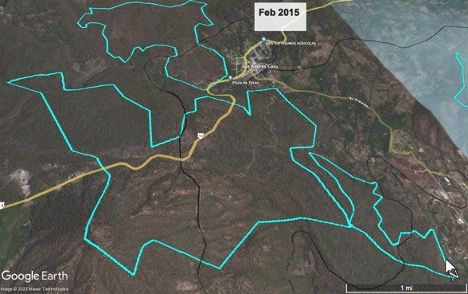

The “before” image is a Google Earth image from February 2015. Light blue outlines are general areas of deforestation after February 2015 identified by CRI, though the entirety of the area within the light-blue outlines has not necessarily been deforested. The three areas contain 3,596 acres.
The “after” image is a Google Earth satellite image of same area, with a composite of images from April 2023 and in top left corner November 2022—the most recent available dates for areas shown.
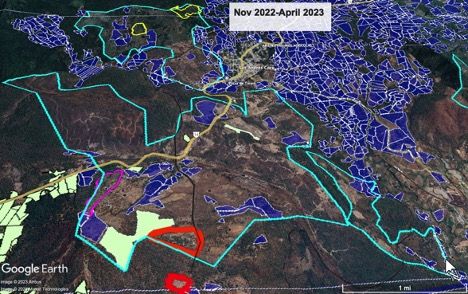
Google Earth satellite image from November 2022 and April 2023. Blue and green polygons are U.S.-export approved orchards. Government shipment records indicate that in 2022:

Zoom in on preceding Google Earth satellite image, showing example of the grid of avocado plantings outside of blue and green polygons, and pink-outlined orchard. These—and other areas within the light blue outline, and outside the export-polygons—are at risk of being approved for export to the United States.
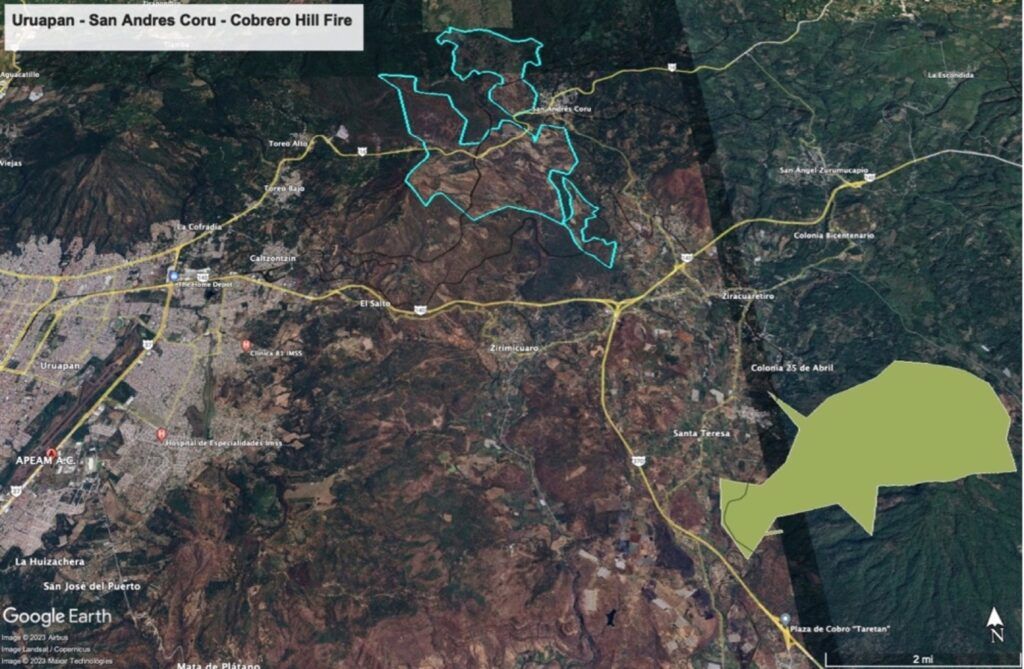
Google Earth satellite image, with the latest available images, composite from April 2023 (left side) and December 2021 (right side). The image shows the proximity between the city of Uruapan—the second biggest city in Michoacán, where APEAM is headquartered and many major fruit companies have packinghouses—and the light blue-outlined deforested area for avocados around San Andrés Coru, and the green polygon showing the area of the fire on Cobrero Hill.
San Gabriel is a municipality in southern Jalisco where the expansion of avocado production has caused deforestation and forest fires, depleted water supplies, and—evidence strongly suggests—contributed to a deadly flash flood in 2019.
The region is dominated by the Jalisco Cartel New Generation (CJNG). In 2015, in a town that is just a 2.5 hour drive from San Gabriel, the CJNG shot down a military helicopter with rocket-propelled grenades.81José de Córdoba, “Mexican Army Helicopter Was Shot Down With Rocket-Propelled Grenades,” The Wall Street Journal, May 4, 2015, https://www.wsj.com/articles/mexican-army-helicopter-was-shot-down-with-rocket-propelled-grenades-1430783784 (accessed July 11, 2023). In December 2022, the CJNG kidnapped and killed an army colonel in a community just north of San Gabriel.82Pablo Ferri, “Colonel José Isidro Grimaldo Killed in Jalisco, the Second Attack Against a Military Commander in Last Month,” (“Asesinado en Jalisco el coronel José Isidro Grimaldo, el Segundo atentado contra un mando military en el ultimo mes”), https://elpais.com/mexico/2022-12-15/asesinado-en-jalisco-el-coronel-jose-isidro-grimaldo-el-segundo-atentado-contra-un-mando-militar-en-el-ultimo-mes.html (accessed July 11, 2023).
One resident described the situation in San Gabriel as that of “narco peace” (paz narca)—a lack of violent conflict due to the hegemonic control of the cartel.83CRI interview with resident, San Gabriel, Jalisco, 2023 (name and exact date withheld). Others described armed CJNG members openly passing by and greeting local and state police.84CRI interviews with residents, Jalisco, 2023 (names and exact dates and locations withheld).
The municipal seat of San Gabriel sits in a valley. The mountains above it, in the same sub-watershed, have undergone significant deforestation for avocado orchards over at least the past 15 years. In May 2019, forest fires in those mountains spread across at least 12,350 acres, according to authorities.85National Center for Disaster Prevention (CENAPRED), “Socioeconomic Impact of the Principal Disasters that Occurred in Mexico,” (“Impacto Socioeconómico de los principals desastres ocurridos en México”), June 2021, https://www.cenapred.unam.mx/es/Publicaciones/archivos/457-IMPACTO_SOCIOECONOMICO_2019.PDF, p. 41 (accessed July 11, 2023); complaint filed by Jalisco Secretary of Environment and Territorial Development and other authorities with the PROFEPA, February 28, 2022, p. 3, obtained through transparency law in response by Jalisco Government’s Coordination of Territorial Management to request number 142042123004861, April 18, 2023. One person who was an official at the time of the fires told Climate Rights International that individuals flying over the fires in a helicopter could see people intentionally igniting them, and that the fires were presumably for avocado.86CRI interview with person who was an official at the time of the May 2019 fires, 2023 (name, location, and exact date withheld).
On June 2, 2019, following intense rain, the Salsipuedes River, which passes through the town of San Gabriel, overflowed, flooding the streets with a powerful torrent of water, rocks, mud, and burnt tree trunks that swept up cars and damaged homes, businesses, schools, and infrastructure. Five people were killed.87Complaint filed by Jalisco Secretary of Environment and Territorial Development and other authorities with the PROFEPA, February 28, 2022, pp. 2-4; Gloria Reza, “Jalisco: Devastating Land-Use Change,” (“Jalisco: Devastador cambio de uso de suelo”), Proceso, https://depredadores.proceso.mx/jalisco.html (accessed July 11, 2023).
As discussed in detail in chapter 3, authorities investigating the reasons for the flash flood identified the May 2019 forest fires and deforestation as central causes, and Climate Rights International found evidence linking avocado expansion to those fires and the deforestation in the area that preceded the disaster.
Following the June 2019 flood in San Gabriel, efforts to address the deforestation were met with threats. For example, a person who was an official from Jalisco’s SEMADET at the time of the disaster said that they started receiving telephone threats after contributing to an internal report about the flood, which had their name on it.88CRI interview with victim of threat, Jalisco, 2023 (name and exact date and location withheld). The callers told them not to “stick their nose where it did not belong,” and threatened to kidnap them. Meanwhile, some local environmental defenders began to meet less frequently and be less outspoken due to fear of violent reprisals.
In July 2019, and apparently in response to public outcry, state officials announced the filing of a complaint with Mexico’s Federal Attorney for Environmental Protection (PROFEPA) that identified 3,885 acres of land-use change across San Gabriel and 12 other Jalisco municipalities for agricultural activities, including avocado production.89State Government of Jalisco, “Government of Jalisco Denounces Illegal Land Use Change to Federal Authority,” (“Denuncia gobierno de Jalisco ante autoridad federal, cambio de uso de suelo ilegal”); July 30, 2019, https://www.jalisco.gob.mx/es/prensa/noticias/92182 (accessed July 11, 2023). But as of the end of 2022, PROFEPA had not taken any actions to investigate those responsible for the deforestation in San Gabriel identified in the complaint.90CRI interview with official, Jalisco, 2023 (name, exact location, and date withheld).
According to one San Gabriel resident, “the dynamic hasn’t changed at all” since the complaint to PROFEPA. “There’s absolutely no protection of the environment. The federal and state governments don’t care at all.”91CRI interview with San Gabriel resident, San Gabriel, Jalisco, 2023 (name and date withheld).
In 2022, state officials filed another complaint with PROFEPA over the illegal clearing of some 200 acres of forest directly above the town of San Gabriel.92State Government of Jalisco, “Government of Jalisco Presents Complaints to PROFEPA and [Prosecutor’s Office] for Deforestation in San Gabriel,” (“Presenta gobierno de Jalisco denuncias ante Profepa y FGR por deforestación en San Gabriel”), April 3, 2022, https://www.jalisco.gob.mx/es/prensa/noticias/140489 (accessed July 11, 2023). At a press conference, top officials said they did not know what would be planted there, or who was responsible, but that “history was repeating,” with the risk of disaster for the population below being “multiplied.”93State Government of Jalisco, “Government of Jalisco Presents Complaint to PROFEPA for Deforestation in San Gabriel,” (“Gobierno de Jalisco presenta denuncia ante la Profepa por deforestación San Gabriel”), audio file, https://soundcloud.com/gobiernojalisco/040322-gobierno-de-jalisco-presenta-denuncia-ante-la-profepa-por-deforestacion-san-gabriel?utm_source=clipboard&utm_medium=text&utm_campaign=social_sharing (accessed July 11, 2023).
The avocado expansion has affected residents’ access to water, as discussed in a section of chapter 3 on water impacts.
The following Google Earth images are examples of deforestation for avocado orchards in San Gabriel, some of which have already been authorized to export avocados to the United States. The light blue outlines are government maps of the boundaries of U.S.-export approved orchards. (Chapter 3 has more images of land-use change and forest fires for avocado production in San Gabriel.)
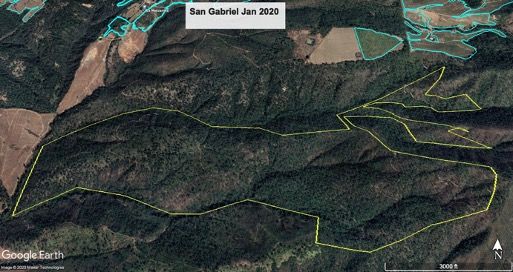

The two Google Earth images above show deforestation between 2020 and 2022 for avocado orchards in the area outlined by Climate Rights International in yellow. In contrast to the orchards above outlined in light blue, the areas outlined in yellow have not yet been certified for U.S. export. The yellow outlines an area of 690 acres.
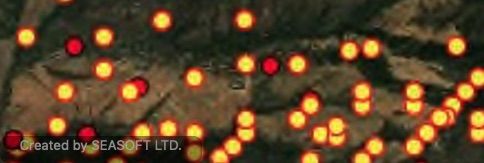
This image shows the deforested zone outlined in yellow above overlapping with heat points detected by a government Fire Alert System in May 2019. Thus, it appears that in this part of the area of the May 2019 forest fires that contributed to the June 2019 lethal flood, forest was subsequently cleared for avocado production.


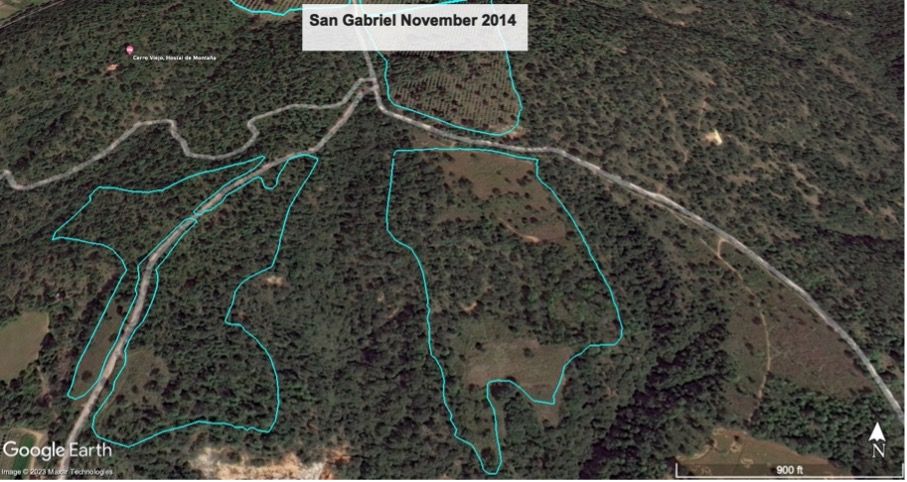
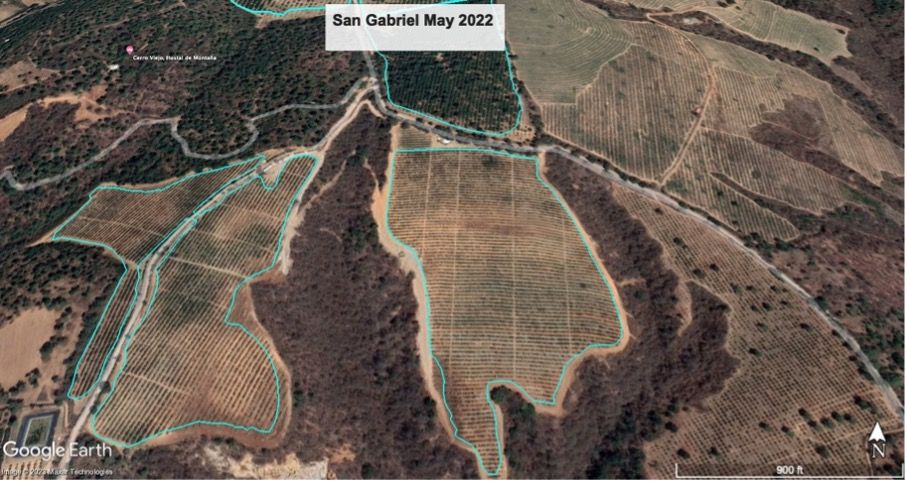
Google Earth images showing deforestation for avocado orchards in two areas of San Gabriel. In the top two images, on the border between San Gabriel and Zapotlán el Grande, the deforested orchards in the top left corner have been approved for U.S. export, as indicated by the light blue outlines. The yellow pin marks the GPS for an underground water concession registered on March 30, 2020, to “Agro Gonzalez S.P.R. de R.L.,” a major Jalisco packinghouse now known as Agro Gonzámex, which is discussed elsewhere in this report.94National Water Commission (CONAGUA) Title Number 818490, available at Public Registry of Water Rights (REPDA) database, https://app.conagua.gob.mx/consultarepda.aspx (accessed July 11, 2023).
International demand for Mexican avocados is driving deforestation, which releases climate-warming carbon dioxide into the atmosphere and reduces carbon sinks. This chapter provides background on Mexico’s role as the world’s leading producer and exporter of avocados,95OECD and FAO, “OCED-FAO Agricultural Outlook 2021-2030,” 2021, https://doi.org/10.1787/19428846-en, p. 235 (accessed July 11, 2023). the structure of the global supply chains, the certification system for exporting to the United States, and projections of continued avocado expansion in Mexico. Without urgent measures, the ongoing expansion will cause further deforestation and attendant harms, including carbon dioxide emissions. As an official from Mexico’s federal environment agency told Climate Rights International, avocado exports “are a big source of foreign exchange, but at the cost of the environment, which is already very degraded.”96CRI group interview with SEMARNAT officials, Mexico City, March 21, 2023.
Mexico has in recent years exported the majority of its avocado production,97Mexican customs data, processed by Treid.co, shows 6 million metric tons of global avocado exports between January 2019 and April 2023 (an average of 1.38 million per year), and Mexico’s SIAP agency reports an annual average production of 2.4 million tons between 2019 and 2022. Mexico’s Agricultural and Fisheries Information Service (SIAP), “Statistical Yearbook of Agricultural Production,” (“Anuario Estadístico de la Producción Agrícola”), https://nube.siap.gob.mx/cierreagricola/ (accessed August 1, 2023). See also FAO, “International Trade Major Tropical Fruits: Preliminary Results 2021,” https://www.fao.org/3/cb9412en/cb9412en.pdf, p. 10 (accessed August 1, 2023) (reporting Mexican government forecasts that avocado production would grow to 2.5 million tons in 2021, 1.5 million of which would be exported). with about 80 percent of the exports going to the United States.98Mexican customs data, processed by Treid.co for January 2019 to April 2023 shows that 80 percent of value of total exports (US$11.24 out of US$13.97 billion) and 78.7 percent of tonnage of exports (4.7 out of 6 million metric tons), were exported to the United States. Roughly four out of five avocados consumed in the United States are from Mexico.99USDA’s Economic Research Service, “Imports play dominant role as U.S. demand for avocados climbs,” May 2, 2022, https://www.ers.usda.gov/data-products/chart-gallery/gallery/chart-detail/?chartId=103810 (accessed July 11, 2023); Avocados From Mexico website, https://avocadosfrommexico.com/about/ (accessed July 11, 2023). Mexico exported 4.7 million metric tons of avocados, worth US$11 billion, to the United States between January 2019 and April 2023, including avocados worth US$3 billion in 2022.100Mexican customs data processed by Treid.co.
Up until mid-2022, all avocado exports from Mexico to the United States came from the state of Michoacán. Under U.S. law, a Mexican state can only export avocados to the United States if it is approved by U.S. agricultural authorities as meeting plant pest-control criteria.101U.S. Code of Federal Regulations 7, Agriculture, Part 319, Foreign Quarantine Notices, Subpart 56 – Fruit and Vegetables; see also USDA Animal and Plant Health Inspection Services (APHIS), “Avocado (Fruit) from Mexico into Continental U.S. Ports, Hawaii, and Puerto Rico,” February 15, 2023, https://acir.aphis.usda.gov/s/acir-document-detail?rowId=a0j3d000000GQz4AAG&Document_Type=Commodity percent20Import percent20Requirements (accessed July 11, 2023).
Between 1997—the year Mexico started exporting avocados to the United States—and 2021, Michoacán was the only approved state. In December 2021, Jalisco—the state with the second largest avocado production—received U.S. approval and started exporting to the United States in July 2022.102State of Jalisco Government, “U.S. Government Authorizes the Entry of Jalisco Avocado,” (“Gobierno de Estados Unidos autoriza el ingreso de aguacate de Jalisco”), July 11, 2022, https://www.jalisco.gob.mx/es/prensa/noticias/146401 (accessed July 11, 2023). (Up to that point, Jalisco had exported to other countries across the globe but not to the United States.)
More than 80 percent of the existing acreage of Mexican avocado crops are planted in Michoacán and Jalisco, according to data from the Mexican Agricultural and Fisheries Information Service (SIAP) as of July 2023.103SIAP, “Advance of Plantings and Harvests,” https://nube.siap.gob.mx/avance_agricola/ (accessed August 21, 2023). The SIAP reports 444,387 acres (179,914 hectares) of avocado planted in Michoacán as of that month, for both international and domestic consumption.104Ibid. The area of planted avocado in Michoacán has more than doubled from 188,866 acres in 1997—the year the state started exporting to the United States.105SIAP, “Statistical Yearbook of Agricultural Production,” (“Anuario Estadístico de la Producción Agrícola”), https://nube.siap.gob.mx/cierreagricola/ (accessed August 21, 2023). SIAP reports 264,430 acres planted in 2010 and 333,304 acres in 2015. Ibid.
Official estimates of the total land planted with avocados in Jalisco range from 73,082 acres (federal SIAP figure as of July 2023),106SIAP, “Advance of Plantings and Harvests.” to between 99,017 and 139,564 acres (Jalisco’s Secretary of Environment and Territorial Development (SEMADET) figures as of May 2022).107SEMADET, “Avocado Orchards in the South and Southeast Zone of the State,” (“Huertas de aguacate en la zona sur y sureste del estado”), May 3, 2023. The Association of Exporting Avocado Producers of Jalisco (APEAJAL) estimates 91,390 acres (37,000 hectares) of avocado production in Jalisco. CRI interview with Armando Garcia, Managing Director of APEAJAL, Zapotlán el Grande, Jalisco, March 17, 2023.
The avocado supply chains from Mexico to the United States are comprised of five main actors: growers, packers, exporters, importers, and retailers.108Kimin Cho et al., “Where does your guacamole come from? Detecting deforestation associated with the export of avocados from Mexico to the United States,” Journal of Environmental Management 278 (2021) 111482 pp. 5-6. The packers, exporters, and importers are often vertically integrated—meaning that these different components of the supply chain are owned by a single company.109Ibid. For example, Calavo owns packinghouses in Mexico, has exporting operations to bring the avocados from packinghouses to the U.S. border, and also controls imports from within the United States, before distributing to retailers such as Walmart, Kroger, and Trader Joe’s. While some of the companies that engage in packing, exporting, and importing also directly own some orchards in Mexico, they mostly buy their avocados from thousands of independent growers.
Mexican avocados are also exported to Europe, Canada, and Japan, among other destinations. According to Mexican customs data compiled by Treid, between January 2019 and April 2023, the second biggest destination for Mexican avocado exports was Canada (US$932 million) and the third was Japan (US$708 million), followed by Spain (US$245 million), the Netherlands (US$172 million), and France (US$144 million). The following chart shows the top 10 destinations for the period.110Aside from the United States, the only other countries with bilateral programs containing special pest-control requirements to export Mexican avocados are Chile, China, and South Korea. Exporting to Canada, Japan, the United Kingdom, and European Union, for example, only requires that orchards be commercially registered with Mexican agricultural pest-control authorities. Transparency law response from SENASICA to request number 330028323000002, January 23, 2023. Such orchards are located in the states of Michoacán, Jalisco, Nayarit, and State of Mexico, among others. Transparency law response from SENASICA to request number 330028323000033, February 21, 2023. In May 2023, APEAJAL reported that 7 percent of Jalisco exports went to the United States, 31 percent to Europe (with Spain and the Netherlands as the largest destinations), 31 percent to Canada, and 26 percent to Japan. Contribution by Armando García, Managing Director of APEAJAL to panel discussion “Environmental Impact of the Production and Trade of Avocados Between Mexico (Jalisco) and Europe,” online event hosted by the Embassy of the Netherlands in Mexico, May 9, 2023, attended by CRI personnel.
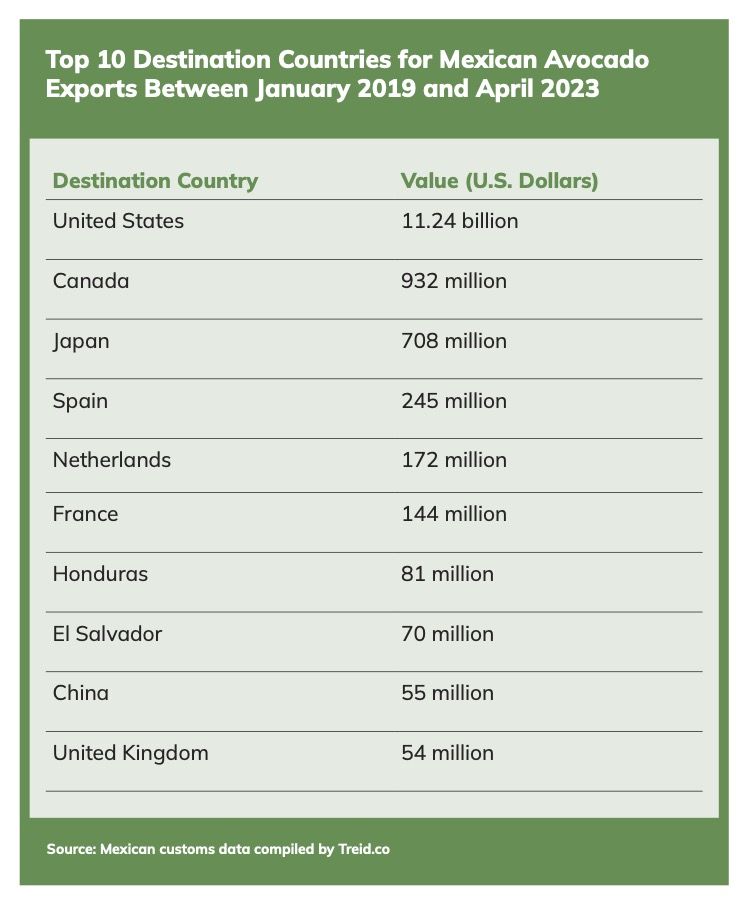
Mexico’s pest-control system requires that, for a commercial orchard to produce avocados for domestic markets or export, it must first register with the Secretary of Agriculture and Rural Development (SADER), in a process that requires providing the agency the orchard’s GPS coordinates.111SENASICA, “Operating Manual For the Modification to NOM-066-FITO-1995, For the Campaign Against Regulated Avocado Pests,” (“Manual operativo de la modificación de la NOM-066-FITO-1995, para la campaña contra plagas reglamentadas del aguacate”), 2021, https://www.gob.mx/cms/uploads/attachment/file/632729/Manual_Operativo_Aguacate_compressed.pdf (accessed September 30, 2023); CRI interview with SADER officials, Mexico City, March 23, 2023. SADER then assigns the orchard a unique registration number.
The U.S. government closely regulates the avocado supply chains from Mexico to the United States through detailed certification and tracing procedures, but these are focused exclusively on pest control. For an orchard to produce avocados for export to the United States, and a packinghouse to process them, each must be approved by both Mexican authorities and the U.S. Department of Agriculture’s Animal & Plant Inspection Service (USDA-APHIS).112SENASICA, “Operational Work Plan (OWP): Systems Approach for the Importation of Fresh Hass Avocado from Mexico into the United States,” (“Plan de Trabajo Operativo (PTO): Enfoque de Sistemas para le Importación de Aguacate Fresco Hass de México a Estados Unidos”), December 6, 2021, https://www.gob.mx/senasica/documentos/aguacate-hass?state=published (accessed July 11, 2023). The certification process is governed by the Operational Work Plan (OWP) agreed upon by United States and Mexico, which sets forth requirements and procedures to prevent the spread of potential pests.
The OWP’s baseline requirement for an orchard to export to the United States is that it must be located within the Mexican states and municipalities that the OWP approves for export.113Ibid. As of March 2023, Mexico and the United States had approved 46 municipalities in Michoacán, and 10 in Jalisco.114USDA presentation, “Municipalities Approved,” provided to CRI March 29, 2023. The Michoacán municipalities are: Acuitzio, Angangueo, Apatzingán, Ario, Charapan, Charo, Churumuco, Cotija, Erongarícuaro, Gabriel Zamora, Hidalgo, Huiramba, Irimbo, Jiménez, La Huacana, Los Reyes, Madero, Morelia, Morelos, Nahuatzen, Nuevo Parangaricutiro, Nuevo Urecho, Ocampo, Parácuaro, Pátzcuaro, Peribán, Purépero, Quiroga, Salvador Escalante, Tacámbaro, Tancítaro, Tangamandapio, Tangancicuaro, Taretan, Tingambato, Tingüindín, Tlazazalca, Tocumbo, Turicato, Tuxpan, Tzintzuntzan, Tzitzio, Uruapan, Zacapu, Ziracuaretiro and Zitacuaro. The Jalisco municipalities are: Arandas, Chiquilistlan, Concepción de Buenos Aires, Gomez Farias, San Gabriel, Sayula, Tapalpa, Tepatitlán de Morelos, Zapotiltic y Zapotlán el Grande. An orchard in one of these municipalities can be certified for export once U.S. and Mexican authorities verify that it complies with the pest-control requirements in the OWP.115SENASICA, “Operational Work Plan.” APHIS personnel visit orchards to inspect for compliance twice a year for the first five years after an orchard is certified, and if found to be pest-free for five years, once a year after that.116Ibid. APHIS employs as many as 100 inspectors in a year to inspect avocado orchards in Mexico.117CRI interview with Nicholas Gutierrez, USDA-APHIS Regional Manager for Mexico, Mexico City, March 29, 2023. APHIS reported that in 2022, it “oversaw” the “safe import of 2.04 billion pounds of avocados from Mexico, representing 90 percent of avocados imported into the United States.”118USDA-APHIS, “Keeping U.S. Agriculture Healthy for America and the World: 2022 Impact Report,” July 2023, https://www.aphis.usda.gov/publications/aphis_general/2022-impact-report.pdf p. 5 (accessed July 12, 2023).
The OWP requires both APHIS and the Mexican authorities to maintain maps with GPS coordinates of avocado orchards approved for export to the United States. As of March 2023, the United States and Mexico had certified for export more than 50,000 orchards in Michoacán, containing 377,910 acres (153,000 hectares), and 32,110 acres in Jalisco.119 CRI interview with Nicholas Gutierrez, USDA-APHIS Regional Manager for Mexico, Mexico City, March 29, 2023.
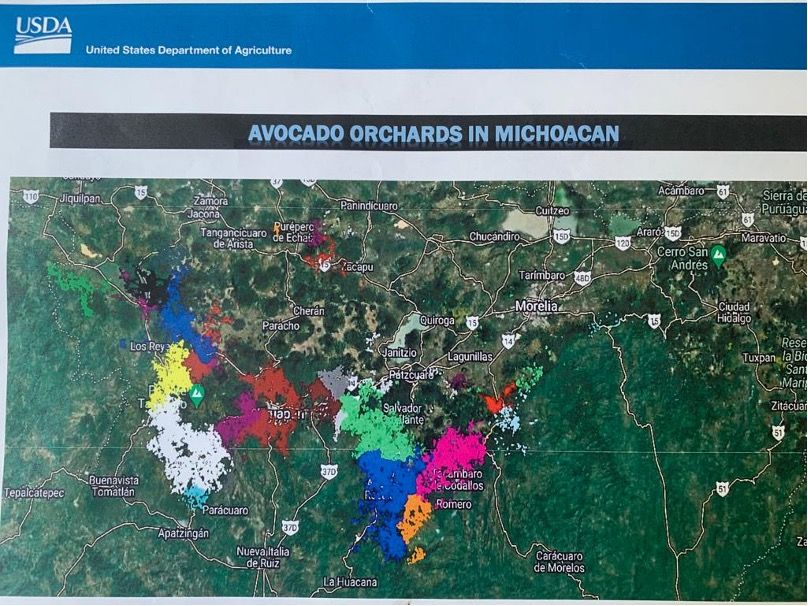
USDA’s map of avocado orchards in Michoacán approved for export. Certified orchards denoted by the multicolored layers on the map.120Slide from USDA presentation provided to CRI March 29, 2023.
To be certified for exporting avocados, packinghouses must also comply with pest-control requirements and other specifications related to food safety and quality.
The OWP provides that, in carrying out the export program, the U.S. and Mexican authorities shall work with a single “Cooperator,” which represents all the producers and packers who export to the United States, provides funds to the authorities for the program’s implementation, and helps ensure compliance.121SENASICA, “Operational Work Plan.” To export to the United States, growers and packinghouses must “participate” in the export program “through” the Cooperator, which “represent[s]” them.122Ibid.
Pursuant to an agreement with APHIS, the Association of Avocado Exporting Producers and Packers of Mexico(APEAM) is the Cooperator under the OWP. APEAM’s website states that it represents 34,857 growers and 84 packers,123Many growers own more than one orchard. responsible for the export of 915,750 tons of avocados to the United States in the 2021-2022 season.124APEAM website, https://www.apeamac.com/que-es-apeam/?lang=es (accessed July 11, 2023). The managing director of the Association of Exporting Avocado Producers of Jalisco (APEAJAL) told Climate Rights International that packinghouses pay an initial fee of US$250,000 to APEAM to register, plus a fee per kilogram of avocados processed.125CRI interview with Armando Garcia, Managing Director of APEAJAL, Zapotlán el Grande, Jalisco, March 17, 2023. The USDA reported in 2021 that producers pay APEAM five U.S. cents per pound of exported avocados “to cover USDA inspection fees.” USDA Foreign Agricultural Service, “Avocado Annual,” Oct. 5, 2021, https://apps.fas.usda.gov/newgainapi/api/Report/DownloadReportByFileName?fileName=Avocado percent20Annual_Mexico percent20City_Mexico_12-01-2021.pdf (accessed July 12, 2023).
Mexican avocado production and exports are projected to continue to grow in the coming decades. In 2021, the Organization for Economic Co-operation and Development (OECD) and UN Food and Agriculture Organization (FAO) reported that Mexico’s avocado output is expected to grow by 5.2 percent annually over the decade.126OECD and FAO, “OCED-FAO Agricultural Outlook 2021-2030,” p. 235. Similarly, Mexico’s national agricultural plan for 2017-2030 estimated 67.3 percent growth in the annual volume of avocado production between 2016 and 2030.127Secretary of Agriculture, Cattle Ranching, Rural Development, Fishing and Food (SAGARPA), “National Agricultural Planning 2017-2030,” (“Planeación Agrícola Nacional 2017-2030”), https://www.gob.mx/cms/uploads/attachment/file/255627/Planeaci_n_Agr_cola_Nacional_2017-2030-_parte_uno.pdf, p. 38.
The OECD and FAO reported that Mexico is expected to increase its share of global avocado exports to 63 percent by 2030, with the United States and the European Union remaining the main importers of avocados grown anywhere, with 40 percent and 31 percent of global imports, respectively. The Mexican states State of Mexico and Nayarit are likely the next two states to be certified for export to the United States, according to an APHIS official. In both states, avocado is produced in regions with significant forestlands, and Climate Rights International identified examples of deforestation for government-registered avocado orchards.
The total amount of avocado-driven deforestation in Michoacán and Jalisco over the past decade is very likely more than 40,000 acres (16,000 hectares), and could exceed 70,000 acres, according to Climate Rights International’s review of government estimates, a study by environmental geographers produced for this report, and of satellite imagery. For context, one acre is nearly the size of an NFL football field, and almost three-quarters the area of a FIFA soccer field.
All of the deforestation for avocado production that has occurred in the past twenty years in Michoacán—and virtually all of it in Jalisco—appears to have been illegal. The use of fires to clear the forests is an additional crime. In the words of leading academics studying the environmental impacts of avocado in Michoacán, this “unplanned and indiscriminate… land-use change has generated the irremediable degradation of forests, soils, and water.”128Luis D. Olivares-Martinez, Alberto Gomez-Tagle, and Diego R. Pérez-Salicrup, “Regional Drivers Behind the Burning of Remanent Forests in Michoacán Avocado Belt, Central Mexico,” Fire, 2023, https://doi.org/10.3390/fire6030081 (accessed July 12, 2023).
As Mexico’s avocado production continues to expand, so too will the deforestation, unless steps are taken to preclude avocados grown on deforested land from being exported.
Avocado production has been expanding in Michoacán since at least the 1980s.129SIAP, “Statistical Yearbook of Agricultural Production.” The early expansion mostly entailed installing orchards on land already dedicated to agriculture. But around 2000, with the supply of available agricultural land diminishing, the state experienced increased rates of deforestation as forests were cleared to make way for new orchards.130Mexico’s National Institute for Forestry, Agriculture and Livestock Research (INIFAP), “Impact of Land-Use Change From Forest to Avocado,” (“Impacto del cambio de uso de suelo forestal a huertos de aguacate”), August 2012, https://www.researchgate.net/publication/265125083_Impacto_del_cambio_de_uso_del_suelo_forestal_a_huertos_de_aguacate_IMPACT_OF_FOREST_LAND_USE_CHANGE_TO_AVOCADO_ORCHARDS, p. 19 (accessed July 11, 2023). By 2012, decades of avocado expansion in Michoacán had already caused at least 54,340 acres (22,000 hectares) of deforestation, according to a government study, and possibly as many as 121,000 acres, according to an academic study.131A 2012 report by the Mexican government estimated that avocado expansion between 1980 and 2012 came at the cost of at least 1,704 acres (690 hectares) of deforestation a year in Michoacán (which would make for a total of 54,537 acres). INIFAP, “Impact of Land-Use Change From Forest to Avocado,” p. 5. The report cited studies with estimates of annual deforestation for avocado as high as 7,502 acres. Ibid. p. 66. A separate 2012 academic report estimated likely at least 111,150, and as many as 122,104, acres of deforestation for avocado in Michoacán between 1974 and 2011—an annual rate of about 4,500 acres. Luis Miguel Morales Manilla and Gabriela Cuevas García, “Evaluation of the Ecological Impact of The Avocado Crop at a Regional and Land Plot Level in the State of Michoacán,” (“Evaluación del impacto ecoloógico del cultivo de aguacate a nivel regional y de parcela en el estado de Michoacán”), Executive Summary Part II, June 2012, https://lae.ciga.unam.mx/aguacate2/INFORME percent20EJECUTIVO percent20ETAPA percent202_Componente percent201_Proyecto percent20Aguacate percent20CIGA percent20- percent20UNAM.pdf, p. 7 (accessed July 11, 2023).
Over the past decade, officials have made estimates of annual avocado-driven deforestation in Michoacán that have ranged from 2,900 acres per year to as high as 24,700 acres per year.132The most recent analysis of overall deforestation in Michoacán by Mexico’s National Forest Commission (CONAFOR) estimated that the conversion of forests to agricultural lands (not including cattle ranching) accounted for 10,420 acres (4,219 hectares) of deforestation per year between 2001 and 2018. CONAFOR, “Gross Deforestation in Mexico For the 2001 to 2018 Period,” (“Deforestación bruta en México durante el periodo de 2001 al 2018”), https://tableros_snmf.cnf.gob.mx/deforestacion_estatal (accessed July 12, 2023). In 2016, the Michoacán delegate of the Federal Attorney for Environmental Protection (PROFEPA) told the press that between 14.8 and 19.7 thousand acres (6 and 8 thousand hectares) were lost annually due to avocado production. Mark Stevenson, “Mexico: Deforestation For Avocados, Greater than Calculated,” (“México: Deforestación por aguacates, mayor a la calculada”), Associated Press, Oct. 31, 2016, https://apnews.com/article/id-ea0c342d603f4d089768a41a1c02dfc8 (accessed July 12, 2023). In 2020, Michoacán’s then- Secretary of Environment reportedly stated that between 2.9 and 3.7 thousand acres (1,200 and 1,500 hectares) of forest are lost annually in Michoacán due to avocado production. Ernesto Martínez Elorriaga, “Illegal Avocado Crops Sweep Away 1,500 Hectares of Forest Each Year,” (“Arrasa cultivo ilegal de aguacate con mil 500 hectáreas de bosques cada año”); La Jornada, Feb. 18, 2020, https://www.jornada.com.mx/2020/02/18/estados/023n2est (accessed July 12, 2023). In a December 2022 interview with CRI, Michoacán’s Secretary of Environment estimated that annual deforestation for avocado in the state could be between 9.8 and 24.7 thousand acres (4 and 10 thousand hectares). While authorities have not conducted a precise scientific assessment of the scale of recent avocado-driven deforestation in the state, there is a consensus among officials that it is a major problem. Michoacán’s Secretary of Environment, for example, has said that the state’s “most serious environmental issue is the indiscriminate change of land use for avocado crops.”133“Avocado: Business, Ecocide and Crime: Part 1,” Territory Reporting UGTV, Sept. 7, 2022, video clip, YouTube. One state official who has been investigating illegal deforestation in Michoacán for five years told Climate Rights International that avocado production is the “biggest” cause of forest destruction in the state.134CRI interview with official, Morelia, Michoacán, January 17, 2023 (name withheld).
Most of the avocado-driven deforestation in Michoacán is likely linked to supply chains to the United States, as 85 percent of the area of production in the state is certified for U.S.-export, according to government statistics.135SIAP, “Advance of Plantings and Harvests” (reporting 179,914 hectares of avocado planted in the state as of May 2023); CRI interview with Nicholas Gutierrez, USDA-APHIS Regional Manager for Mexico, Mexico City, March 29, 2023 (stating that 153,000 hectares were certified in Michoacán).
Environmental geographers from UT at Austin estimate that more than 25,000 acres of Michoacán avocado orchards certified to export to the United States in 2023 are located on land that was forest as of 2014.136Audrey Denvir, Eugenio Arima, Katie Horn, University of Texas at Austin, Department of Geography and the Environment, “Analysis of Deforestation for Export-Oriented Avocado Production in Michoacán, Mexico,” See Appendix E, for the study’s methodology. They reached this conclusion by comparing previously unpublished official maps—obtained by Climate Rights International—of avocado orchards certified to export to the United States as of January 2023, with Mexican federal government maps of all agricultural lands in Michoacán for the period of 2014-2015,137SIAP, “Agriculture Frontier Series II” (“Frontera agrícola serie II,”) provided in emails from SIAP geospatial analyst to CRI personnel on February 17 and 20, 2023. and academic land-use maps identifying forest lands in Michoacán as of 2014.138Mas, J. F., Lemoine-Rodríguez, R., González-López, R., López-Sánchez, J., Piña-Garduño, A., & Herrera-Flores, E. (2017). Land use/land cover change detection combining automatic processing and visual interpretation. European Journal of Remote Sensing, 50(1), 626-635.
It follows from the environmental geographers’ conclusion that the estimated 25,000 export-certified acres were either illegally deforested or contain forestland—despite being labeled avocado orchards—that would need to be cleared to produce avocados. Based on Climate Rights International’s review of satellite images of hundreds of these certified properties, it appears that the majority of these acres have indeed been illegally cleared.
Climate Rights International identified U.S.-export certified orchards containing land illegally deforested since 2014 in 41 of the 46 Michoacán municipalities approved to export to the United States. (The five municipalities where we did not find such orchards contain just 645 of the 444,387 acres of avocado plantings in Michoacán reported by the government, including three where no production is reported.)

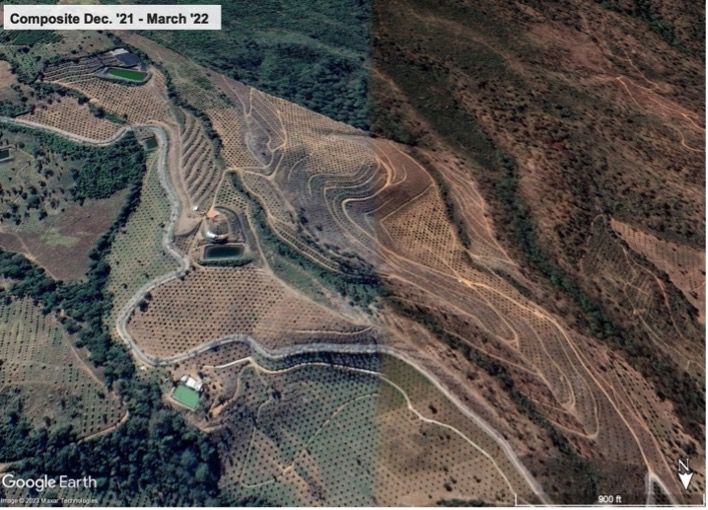
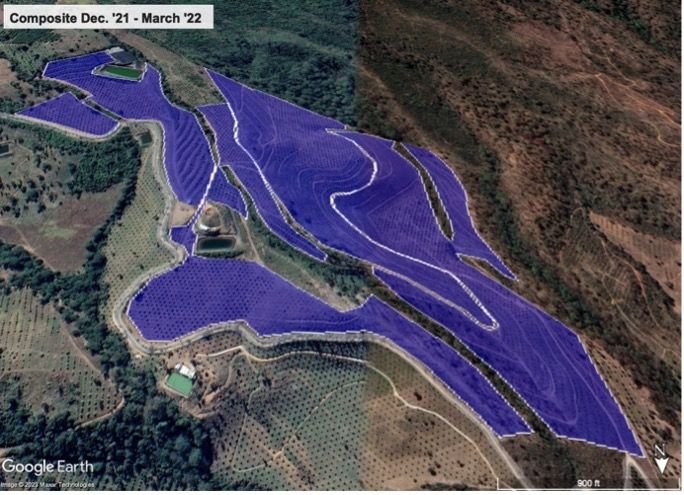
These Google Earth satellite images of an area in Purépero, Michoacán show that forested land seen in the February 2015 image was cleared and replaced by avocado orchards, including four that were certified to export to the United States as of 2023, and are denoted by the blue polygons. (The “after” and bottom images are composites of December 2021 and March 2022.) Two of the orchards supplied 5,712 kilos of avocados to Aztecavo in 2022, according to government shipment records.139The orchards are HUE08160700321 and HUE08160700323.
In addition to the 25,000 acres within export-certified orchards found by the UT at Austin geographers, Climate Rights International identified thousands more acres of forest cleared in Michoacán in recent years that are apparently destined for avocado production and, very likely, certification for export to the United States. In many cases, they already have small plantings visible, in the grid-like arrangement characteristic of the region’s orchards, as well as large water storage pools (called ollas) typically used for avocado irrigation.
According to the USDA, profit margins for avocado exports to the United States are typically more than 50 percent higher than supplies sold to the domestic market.140USDA Foreign Agricultural Service, “Avocado Annual,” Oct. 5, 2021. As one grower told Climate Rights International, “The aspiration of almost everyone is to export, because that’s where the money comes from.”141CRI interview with avocado producer, Tingambato, Michoacán, January 24, 2023 (name withheld).
Growers typically do not initiate the export certification process for their orchards until once they start to produce, which is generally two to five years after the orchard is planted.142CRI group interview with personnel from Junta Local de Sanidad Vegetal (JLSV) in Madero, Madero, Michoacán, December 14, 2023 (names withheld); CRI interview with personnel from JLSV in Tingambato, Michoacán, January 24, 2023 (name withheld); CRI interview with Armando Garcia, Managing Director of APEAJAL, Zapotlán el Grande, Jalisco, March 17, 2023. It is thus highly likely that many of the recently planted orchards will apply for certification once the avocado trees have begun to produce fruit. (Indeed, as noted above, according to government data, avocado producers have sought and obtained certification for 85 percent of the avocado production in Michoacán.)
The conclusion that they are likely destined for certification for export to the United States is also based on the fact that these additional cleared hectares are located adjacent or close to other export-approved orchards.

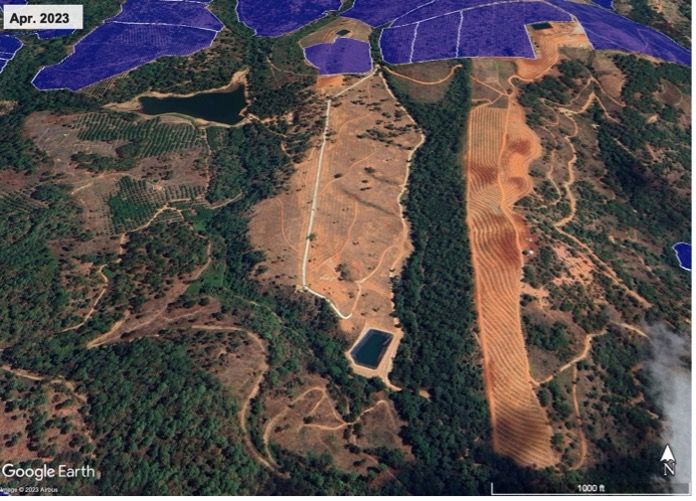
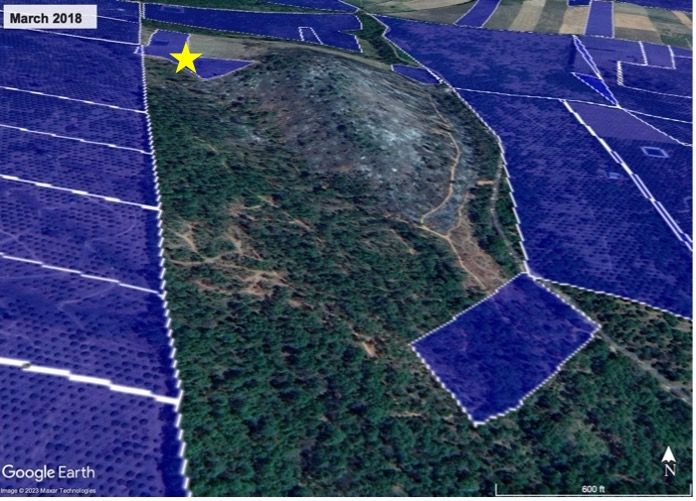
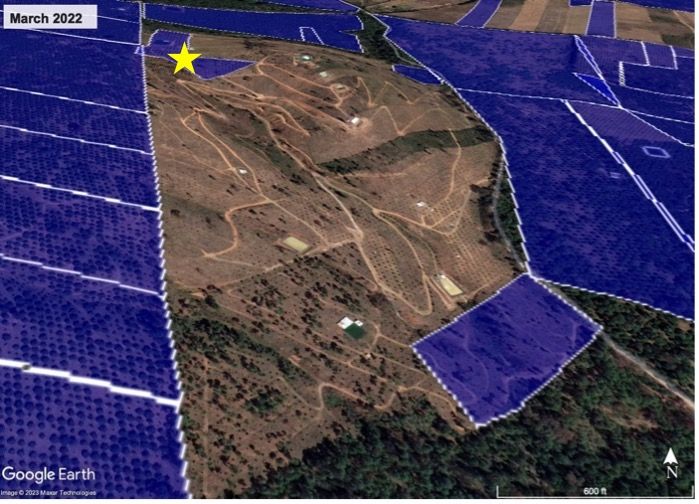
The top two images show deforestation since Oct. 2019 to install avocado orchards in an area surrounded by export-certified orchards, in Tacámbaro, Michoacán. The bottom two images show the same, since 2018, in Salvador Escalante, Michoacán. (The Salvador Escalante image from March 2018 shows the charred, ashy remnants of a forest fire, in an area later replaced by an orchard.) These orchards at risk of being certified for export to the United States. The export orchard with a yellow star contains land that was deforested at some point between 2015 and 2017 and provided 21,150 kilograms of avocados to West Pak in 2022, according to shipment records.143The orchard number is HUE08160660973.
By 2050, the area of avocado crops in Michoacán could increase from its current scale by between 44 and 83 percent, with much of the expansion requiring the clearing of forests, according to academic studies.144Audrey Denvir, “Avocado expansion and the threat of forest loss in Michoacán, Mexico under climate change scenarios, Applied Geography,” (projecting a total production area of 816,693 acres by 2050, with more than 148,200 acres of forest under “very high threat” of loss); Eugenio Arima et al, “Modelling avocado-driven deforestation in Michoacán, México,” Environmental Research Letters, Volume 17, Number 3, 022, https://iopscience.iop.org/article/10.1088/1748-9326/ac5419#erlac5419f4 (accessed August 21, 2023) (projecting 639,236 acres of avocado production by 2050). The studies—which take into account variables such as climate, elevation, soil type, and proximity to orchards and packing houses—show that without action by governments and companies, vast swaths of Michoacán’s forests remain at risk of further deforestation for avocados.
Avocado production is “one of the main direct causes of deforestation” in Jalisco, according to Jalisco’s Secretary of Environment and Territorial Development (SEMADET).145Carmen Gómez Lozano, Director of Biological Corridors and Watersheds, SEMADET, contribution to panel discussion “Environmental Impact of the Production and Trade of Avocados Between Mexico (Jalisco) and Europe,” online event hosted by the Embassy of the Netherlands in Mexico, May 9, 2023, attended by CRI personnel. Avocado expansion in the state has accelerated in recent years, as Jalisco approached the anticipated opening of the export market to the United States, finally achieved in 2022. SIAP reports that the total surface area of avocado plantings in Jalisco more than doubled between 2013 and 2023.146SIAP, “Statistical Yearbook of Agricultural Production,” (“Anuario Estadístico de la Producción Agrícola”), https://nube.siap.gob.mx/cierreagricola/ (accessed July 12, 2023). SEMADET estimates that the rate of at which avocado production expanded each year tripled between 2019 and the first quarter of 2022.147SEMADET, “Avocado Orchards in the South and Southeast Zone of the State.”
A significant part of the growth has been achieved through the deforestation of pines, oaks, and tropical deciduous forest, according to government officials. For example, a 2019 complaint reporting 3,705 acres of illegal deforestation, filed by the heads of several Jalisco government agencies with the Federal Attorney for Environmental Protection (PROFEPA), stated that the surface area of avocado crops had grown by 1,000 percent in recent years, and that “an important part of the expansion occurred in a presumably illegal way in forest ecosystems.”148Complaint filed by the Secretary of Government of Jalisco, General Strategic Security Coordinator of Jalisco, Secretary of Agriculture and Rural Development of Jalisco, and Secretary of Environment and Territorial Development of Jalisco, with PROFEPA, July 30, 2019, p. 2, obtained through transparency law response by Jalisco’s Coordination of Territorial Management to request number 142042123005004. In 2023, the PROFEPA office in Jalisco told Climate Rights International that there is “clearly” a relationship between deforestation and avocado expansion in the state, and that avocado is implicated in a high percentage of its investigations into illegal land-use change.149Written response to CRI’s written questions provided by Jalisco PROFEPA delegation on March 20, 2023.
A May 2022 study by SEMADET reported that avocado orchards caused at least 12,744 acres of deforestation in Jalisco between 2017 and the first quarter of 2022—and the analysis suggested that the actual amount of avocado-driven deforestation in the state could be almost four times higher, according to a former official with direct knowledge of the findings.150SEMADET, “Avocado Orchards in the South and Southeast Zone of the State.” The study identified, as of March 2022, 139,564 likely acres (56,504 hectares) of avocado orchards in Jalisco, 71 percent (99,090 acres) of which it verified. The SEMADET compared the 99,090 acres of verified orchards as of March 2022 with a government map of agriculture lands (the “agricultural frontier”) as of 2017. The agency found that 28,965 of the 99,090 acres were located outside of lands that had been classified as agricultural as of 2017. Of those 28,965 acres of orchards, 44 percent (12,744 acres) had provoked land-use change from forest to avocado. 75 percent of the lost forests were pine-oak, 16 percent tropical deciduous forest, and 8 percent oak-pine. The 12,744-acre figure is based on an analysis of only the 99,090 acres of orchards SEMADET verified as dedicated to avocado production, and not the additional 40,474 acres that SEMADET identified as likely avocado crops, but did not verify. The SEMADET analysis of the full 139,564 acres suggested that the amount of deforestation caused by avocado orchards in the state between 2017 and March 2022 could be as high as 47,251 acres, according to the former official.151CRI communications with person with direct knowledge of analysis, September 2023.
Moreover, Climate Rights International identified several examples of avocado orchards on lands that were deforested during the period of the study but were not counted in its tally of deforestation.


These Google Earth images show a roughly 271-acrea area in Zapotlán el Grande, Jalisco, that was deforested starting in 2017—and as recently as 2023—and is not included in the SEMADET study. The area is surrounded by avocado orchards—including ones certified for U.S. export—and it has a grid of avocado-looking plantings in the top right, as well as the trademark water storage pool of an avocado orchard.


The two Google Earth images above show deforestation for avocado production in Mazamitla, Jalisco—which occurred in 2018—and is not included in the SEMADET study. The deforested area is right below U.S.-export certified orchards outlined in white. Climate Rights International took the photograph below in 2023—it shows a portion of avocado production located on the land that was deforested.

The following is a slide showing images of deforestation for avocado in Jalisco, from a SEMADET and Jalisco Secretary of Agriculture and Rural Development PowerPoint presentation proposing an environmental certification scheme for avocado production in the state.152SEMADET and Jalisco Secretary of Agriculture and Rural Development, “Expansion of Avocado in Jalisco,” (“Expansión del aguacate en Jalisco”), undated presentation.
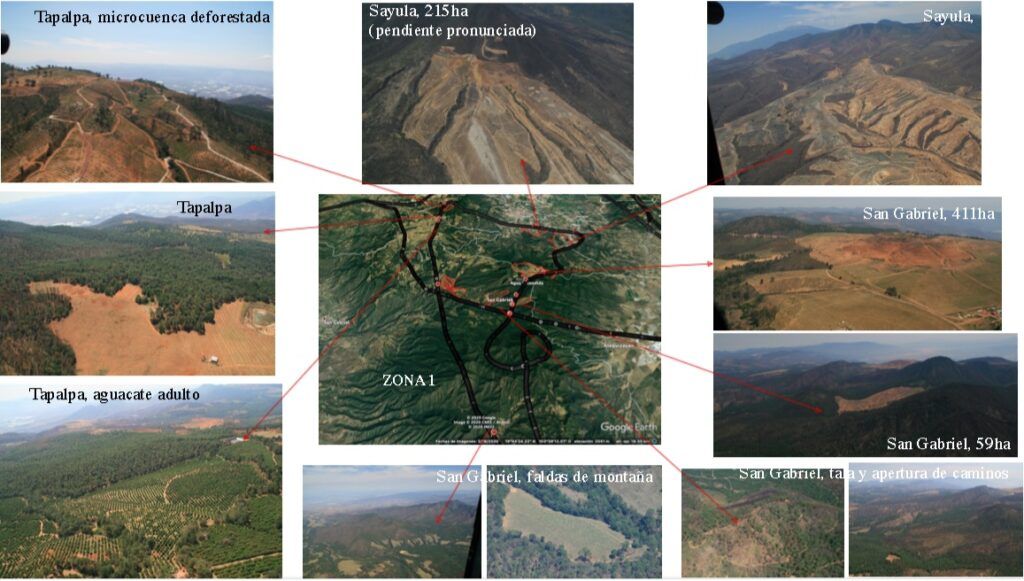
The opening of the lucrative export market to the United States is likely to drive increased avocado-related deforestation in Jalisco, as it has in Michoacán. U.S. officials recognized this environmental threat in internal reports by U.S. Trade Representative (USTR) personnel in April and June 2022, which were obtained by Climate Rights International through a FOIA request (see chapter 5).153Email from USTR personnel to Kelly Milton, Assistant USTR for Environment and Natural Resources, April 4, 2022, containing “USMCA Environment Monthly Newsletter”; Email from Michael Abbey, USTR Assistant Environment Attaché to Kelly Milton, Assistant USTR for Environment and Natural Resources and other USTR personnel, June 23, 2022, containing “USTR Environment Attachés’ Report 1 January – 31 March 2022 (FY22-Q2); both emails provided by USTR in response to FOIA request on March 30, 2023.
In fact, expectations of the opening of the U.S. market to Jalisco—reinforced by the U.S. and Mexican governments’ efforts in prior years to begin Jalisco exports—may have already contributed to the deforestation from the avocado boom in recent years. Jalisco growers have been seeking access to the U.S. market for at least a decade. When it was founded in 2013, the primary goal of the Association of Exporting Avocado Producers of Jalisco (APEAJAL), the state’s exporting producers’ association, was to obtain authorization to export to the United States.154CRI interview with Armando Garcia, Managing Director of APEAJAL, Zapotlán el Grande, Jalisco, March 17, 2023. Access was nearly obtained in 2017, as described in chapter 5.
The following three maps, produced by SEMADET, show avocado orchards in Jalisco as of 2022 in orange, and denote with magenta orchards that contain land deforested sometime between 2003 and the first quarter of 2022.
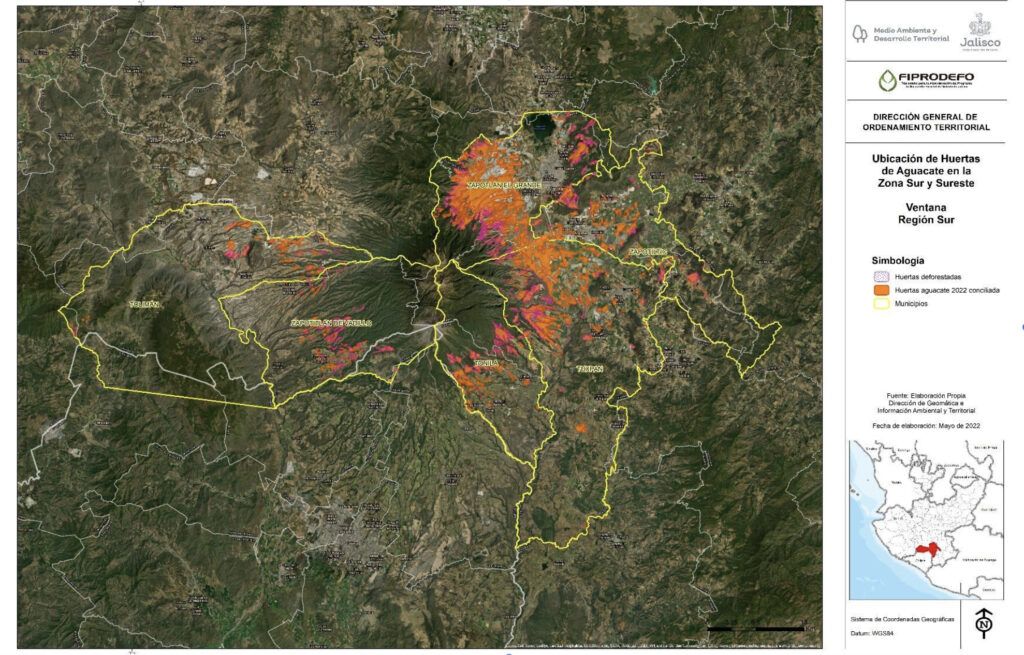
SEMADET map of avocado orchards containing deforested land in six municipalities of the southern region of Jalisco.155SEMADET, “Avocado Orchards in the South and Southeast Zone of the State.”

SEMADET map of avocado orchards containing deforested land in four municipalities of Sierra de Tapalpa region of Jalisco.156Ibid.

SEMADET map of avocado orchards containing deforested land in seven municipalities of the southeast region of Jalisco.157Ibid.
Climate Rights International identified numerous Jalisco avocado orchards certified for U.S. export that are located on land that was deforested over the past decade—including in 8 of the 10 of the municipalities approved to export to the U.S. (The two municipalities where we did not find such orchards—Arandas and Chiquilistan—contain just 701 of the 74,082 acres of avocado plantings in Jalisco reported by the government.)
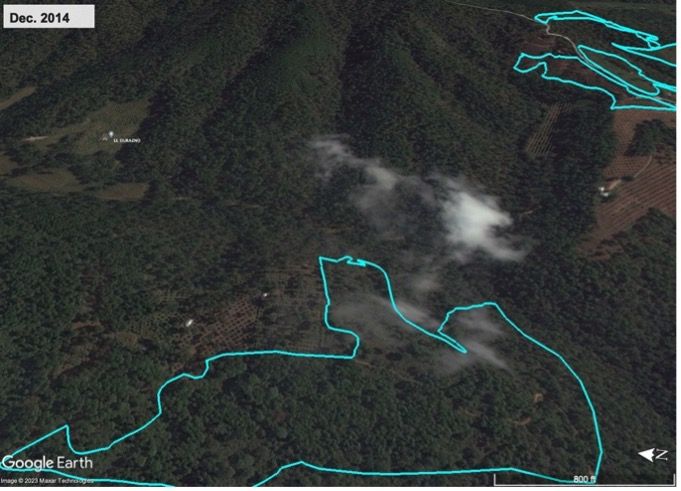

The deforested orchard outlined in blue at the bottom of the Google Earth satellite image of Zapotlán el Grande, Jalisco was certified to export to the U.S. as of January 2023. Above the certified orchard is another recently deforested orchard that has not yet been certified. (The two certified orchards at the top right were already orchards as of 2010.)
Based on our analysis of official records, it appears that the vast majority of the deforestation for avocado orchards over the past two decades in Michoacán and Jalisco has been in violation of Mexican law. Under Mexican law, the conversion of forest lands to agricultural or other uses requires a permit issued by the federal Secretary of Environment and Natural Resources (SEMARNAT).158General Law for Ecological Equilibrium and Protection of the Environment (Ley general del equilibrio ecológico y la protección al ambiente), 1988, art. 28(VII) (added in December 1996 Decree), https://www.diputados.gob.mx/LeyesBiblio/pdf/LGEEPA.pdf (accessed July 12, 2023); General Law for Sustainable Forest Development (Ley general de desarrollo forestal sustentable), 2018, art. 93, https://www.diputados.gob.mx/LeyesBiblio/pdf/LGDFS.pdf (accessed July 12, 2023). Converting forest to agricultural land without a permit is a federal crime—and also in Michoacán, a state crime—punishable by between 6 months and 9 years of prison.159Federal Penal Code (Código penal federal), 1931, art. 418 (added to penal code in February 2002), https://www.diputados.gob.mx/LeyesBiblio/pdf/CPF.pdf (accessed July 12, 2023); Penal Code for the State of Michoacán de Ocampo (Código penal para el estado de Michoacán de Ocampo), 2014, art. 302, http://congresomich.gob.mx/file/CODIGO-PENAL-REF-13-ENERO-2020.pdf (accessed July 12, 2023). It is also an administrative law violation, subject to sanctions such as fines, closures, and forfeiture of products.
As authorities have publicly recognized160Pedro Zamora Briseño, “Michoacán: the Environmental Disaster of the ‘Green Gold,’”; Ernesto Martínez Elorriaga, “Illegal Avocado Crops Sweep Away 1,500 Hectares of Forest Each Year,” La Jornada, Feb. 18, 2020; Mexico’s National Institute for Forestry, Agriculture and Livestock Research (INIFAP), “Impact of Land-Use Change From Forest to Avocado,” p. 22 (“Since the middle of the 1990s, SEMARNAT has not authorized requests for land-use change from forest land to agriculture or livestock uses in Michoacán. Therefore, those who have carried it out since then have done so irregularly. This problem has accelerated recently, in the face of the incapacity of regulatory authorities with insufficient human resources for its prevention, enforcement, and sanctions.”)—and CRI verified through transparency law requests and interviews with officials—SEMARNAT has not issued a single permit to convert forest land to agricultural land in Michoacán in at least 20 years.161Transparency law response from SEMARNAT to request number 330026723000053, February 7, 2023 (reporting no authorizations to convert forest lands to agricultural uses in Michoacán between 2000 and 2022); transparency law response from COFOM to request number 160336023000015, July 12, 2023. CRI interview with Rosendo Caro, General Director of Michoacán State Forest Commission, Morelia, Michoacán, December 15, 2022; CRI interview with state prosecutor’s office official, Morelia, Michoacán, December 15, 2022; CRI interview with Alejandro Méndez, Michoacán’s Secretary of Environment, Morelia, Michoacán, December 16, 2022; CRI interview with senior federal environmental official, Morelia, Michoacán, December 16, 2022; CRI interview with senior federal environmental official, Morelia, Michoacán, December 16, 2022. So, all of the deforestation for orchards in the state over at least the past two decades—including all of the deforestation featured in this report—appears to have been illegal, in violation of federal and state criminal and federal administrative laws.
The situation is similar in Jalisco. SEMARNAT did not issue a single authorization to convert forest lands to agriculture in the state between 2011 and 2022.162Transparency law response from SEMARNAT to request number 330026723000054, February 7, 2023. Previously, between 2000 and 2010, it issued nine authorizations to convert forest lands to avocado plantations, corresponding to a total of 573 hectares.163Ibid. Therefore, the vast majority of deforestation for avocado orchards in Jalisco has been illegal, in violation of federal criminal and administrative laws.
For example, the following Google Earth images show deforestation in a 1,565-acre area, between 2014 and 2022, at the border between the municipalities of Sayula and Tapalpa, Jalisco, outlined in purple, within which the light blue-outlined areas are orchards approved to export avocados to the United States as of January 2023. Likely all of the deforestation is illegal, given that not a single SEMARNAT authorization to convert forest to agricultural lands was issued in the two municipalities during the period of the deforestation.164Ibid. Between 2000 and 2022, there was not a single SEMARNAT authorization to convert forest to agricultural land in Sayula, and just one in Tapalpa, issued in 2009, for 79.6 hectares in two orchards with names different than the deforested export orchards shown in the images.

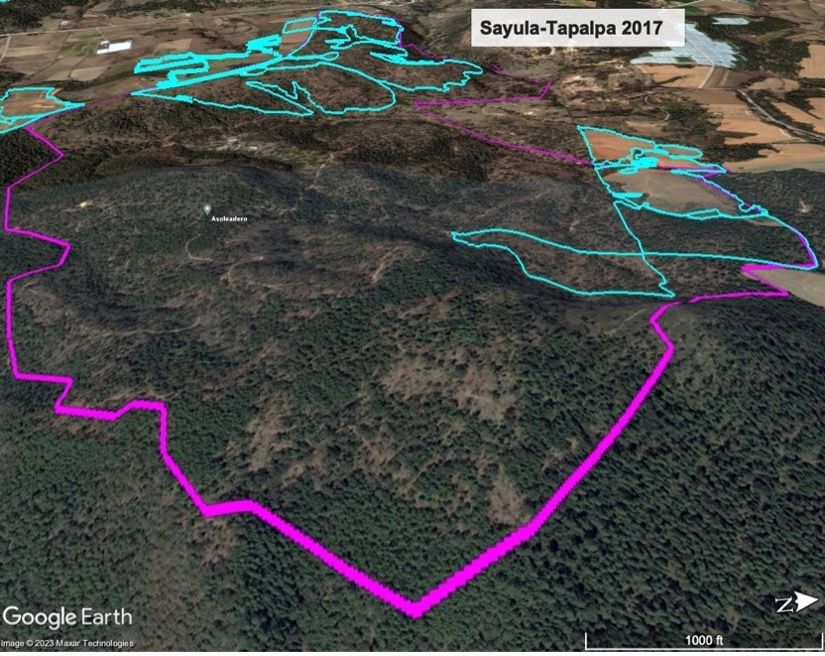

Intentional forest fires are commonly used to facilitate the clearing of trees and vegetation for avocado orchards in Michoacán and Jalisco. These fires often spread far beyond the forest that is converted to use for avocado production, generating carbon dioxide emissions from a greater area of forest than what is ultimately turned into orchards.
The fires are also illegal. Federally, it is a crime punishable by between 2 and 10 years of prison to illicitly “provoke a fire in a forest, natural vegetation, or forest lands, that damages natural elements, flora, fauna, ecosystems, or the environment.”165Federal Penal Code, 1931, art. 420 Bis (added to penal code in February 2002). In Michoacán, it is a crime, punishable by between 2 and 9 years of prison, to deliberately “provoke fires in forest areas to install orchards to change the use of land from forestry,” or to set fires, without authorization, to forest areas larger than half a hectare.”166Penal Code for the State of Michoacán de Ocampo, art 304(II) and (VII). In Jalisco, it is a crime, punishable by between 3 months and 8 years of prison, to “without taking the due cautions and previously informing competent authorities, start or provoke a fire that exceeds the limits of the terrain that one possesses and causes a generalized damage.” Penal Code for the Free and Sovereign State of Jalisco (Código Penal Para el Estado Libre y Soberano de Jalisco), https://docs.mexico.justia.com/estatales/jalisco/codigo-penal-para-el-estado-libre-y-soberano-de-jalisco.pdf, art. 294 (accessed July 18, 2023). A 2021 federal law also prohibits installing orchards on land that has been the site of recent forest fires: it established a 20-year waiting period before burned or logged forest lands can be granted permission to change land use to agricultural production.167General Law for Sustainable Forest Development, art. 97.
Yet, officials and residents told Climate Rights International that many avocado growers and their associates intentionally set forests on fire to clear for orchards. The head of the Forest Commission of Michoacán (COFOM) said that his office had filed 80 criminal complaints for alleged intentional fires in 2022, all of which were for installing avocado orchards.168CRI interview Rosendo Caro, General Director of Michoacán State Forest Commission, Morelia, Michoacán, December 15, 2022. A local environmental official in charge of the team of firefighters in his Michoacán municipality said there had been 10 intentional fires in the municipality in 2022 to clear forest for avocados.169CRI interview with official in Michoacán (name, date, and location withheld). An official from a different Michoacán municipality said all of the forest fires in the area were intentional, with the aim of converting the forest to avocado orchards.170CRI telephone interview with Parácuaro, Michoacán official, May 17, 2023 (name withheld).
In Zapotlán el Grande—a focal point of avocado production in Jalisco, including for export to the United States—municipal officials told Climate Rights International of orchards that have been installed on lands cleared using fires. They cited as an example a 2019 fire that spread over thousands of acres, producing so much smoke that the municipality had to suspend school activities for three days and warn the population not to go outside in the afternoons.
The following three Google Earth images show an approximately 123-acre avocado orchard being installed in the area of a forest fire in Zapotlán el Grande that occurred two years before the one cited by the officials:
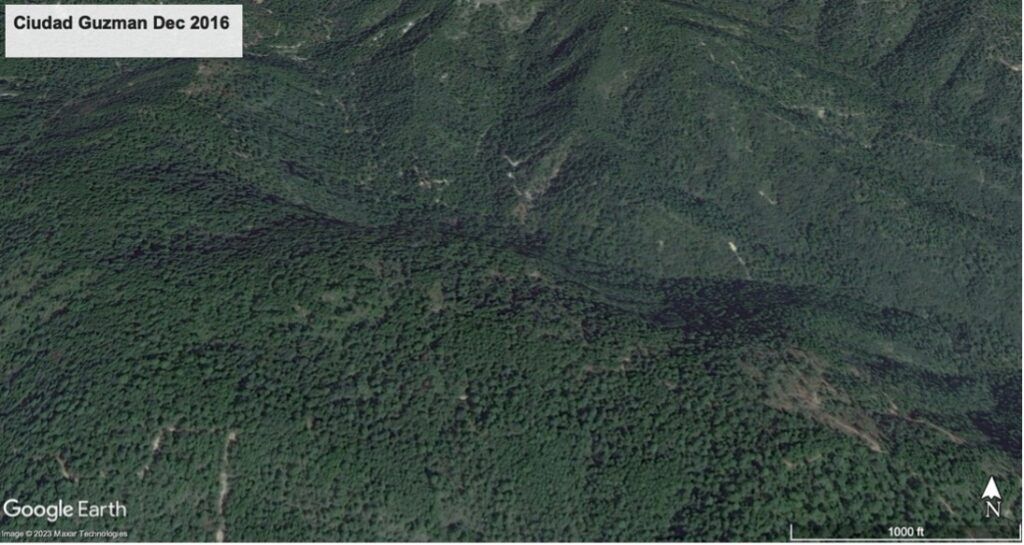
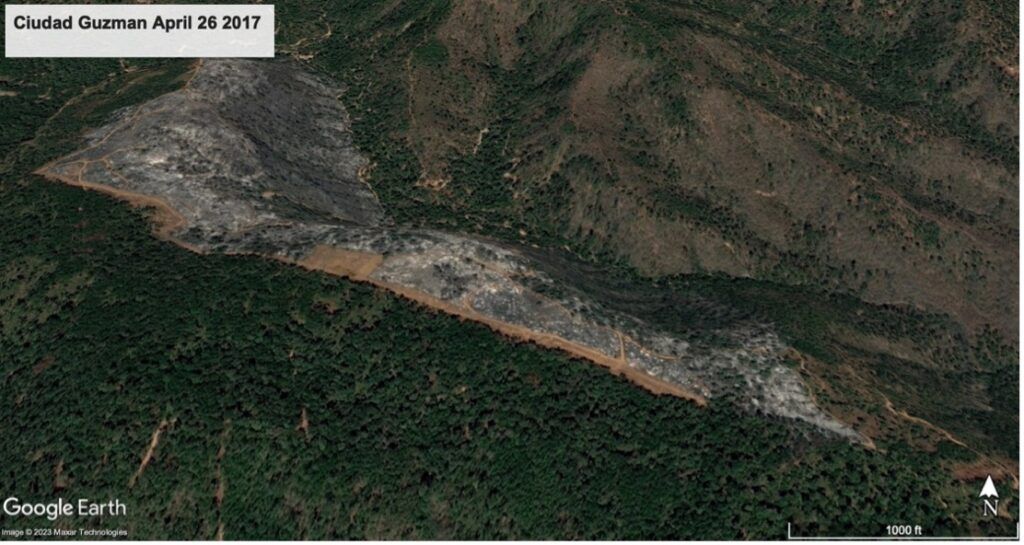
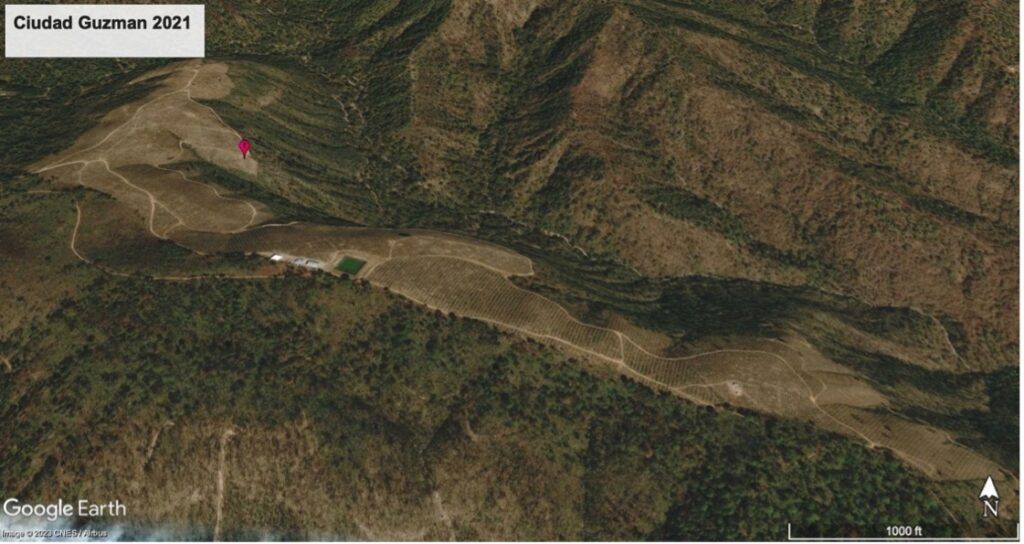
The following two Google Earth images show an approximately 242-acre avocado orchard being installed in the area of a 2021 forest fire in Taretan, Michoacán. The blue polygons are U.S.-export approved orchards.

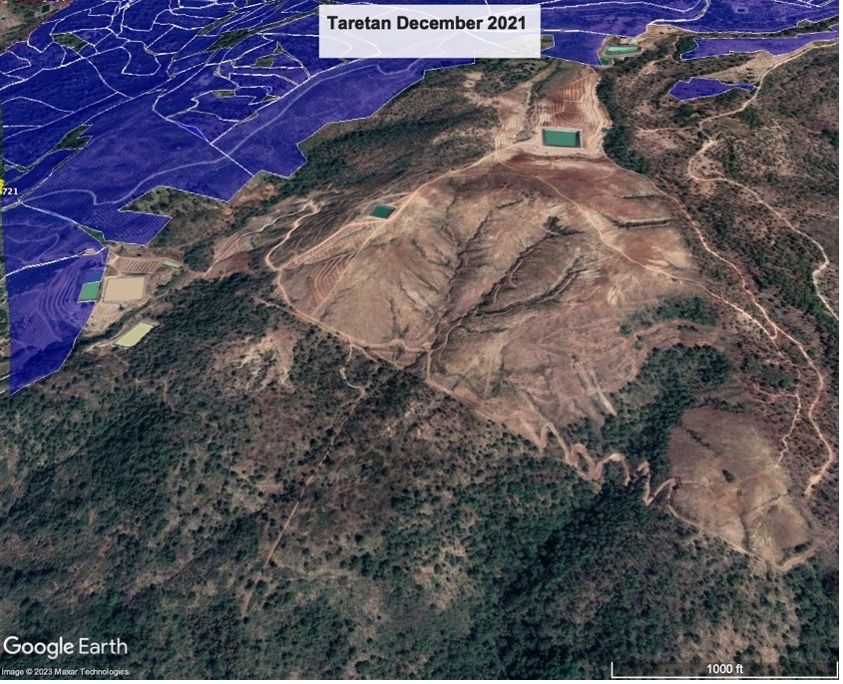
In addition to sometimes witnessing the intentional starting of fires, residents in both states said their intentionality is obvious from the fact that avocado orchards have repeatedly been installed in burned areas after fires. “When there’s a fire, it’s for avocado. All of them are started intentionally,” said a Jalisco resident with direct knowledge of fire suppression actions in his municipality.171CRI interview with resident, Jalisco, 2023 (name and exact date and location withheld).
Comparing maps of officially registered forest fires with U.S-export approved avocado orchards in Michoacán reveals a pattern of fires clearing the way for orchards producing avocados destined for U.S. markets. Climate Rights International identified 678 CONAFOR-registered forest fires in Michoacán between 2012 and 2022 that were located within 100 meters of the polygon map of a U.S.-export certified avocado orchard.172Fire suppression data from CONAFOR and National Council for Science and Technology (CONAHCYT), “Forest Fire Danger Prediction System of Mexico,” http://forestales.ujed.mx/incendios2/ (accessed September 13, 2023). The location data for the fire is one GPS point—not the full surface area of the fire, meaning that the area of the fire likely overlapped in many cases directly with the orchard.
In 185 of the 678 (27 percent) of the fires, CONAFOR identified the cause as being for “land-use change” (152) or “burn to clear” (quema para desmontar) (33). The 185 figure is likely a significant undercount of fires intentionally started to clear trees and other vegetation for avocado production, as the government ambiguously labeled or deemed “unknown” the causes of more than 250 other fires within the universe of 678.173Of the 678, the government classified the causes of 109 as “unknown,” 9 as “intentional” with a more specific cause “in litigation” or not specified, and 159 ambiguously as “burn to prepare to plant.” All of these classifications leave the possibility—combined with the proximity to the orchards—that the fires were intentional and for land-use change. Moreover, the 185 figure is based on the universe of 678 fires that are close only to U.S.-export approved orchards, and thus excludes fires close to or overlapping with the thousands of other avocado orchards that were not certified as of January 2023. In any case, for the 185, the government classifications of the fires, combined with their close proximity—if not direct overlap—with avocado orchards, suggests a high probability that they were intended to clear forest and vegetation for avocado orchards.174This does not necessarily mean the orchard owner was involved in setting the fire; someone else may have previously cleared the forest to put the property on the market for avocado-producing land. In either case, forest fires would be used to clear land for avocado expansion. (Even if the fire’s area did not overlap with a currently certified orchard, its close proximity indicates it could have been intentionally started for expanding the avocado frontier.)
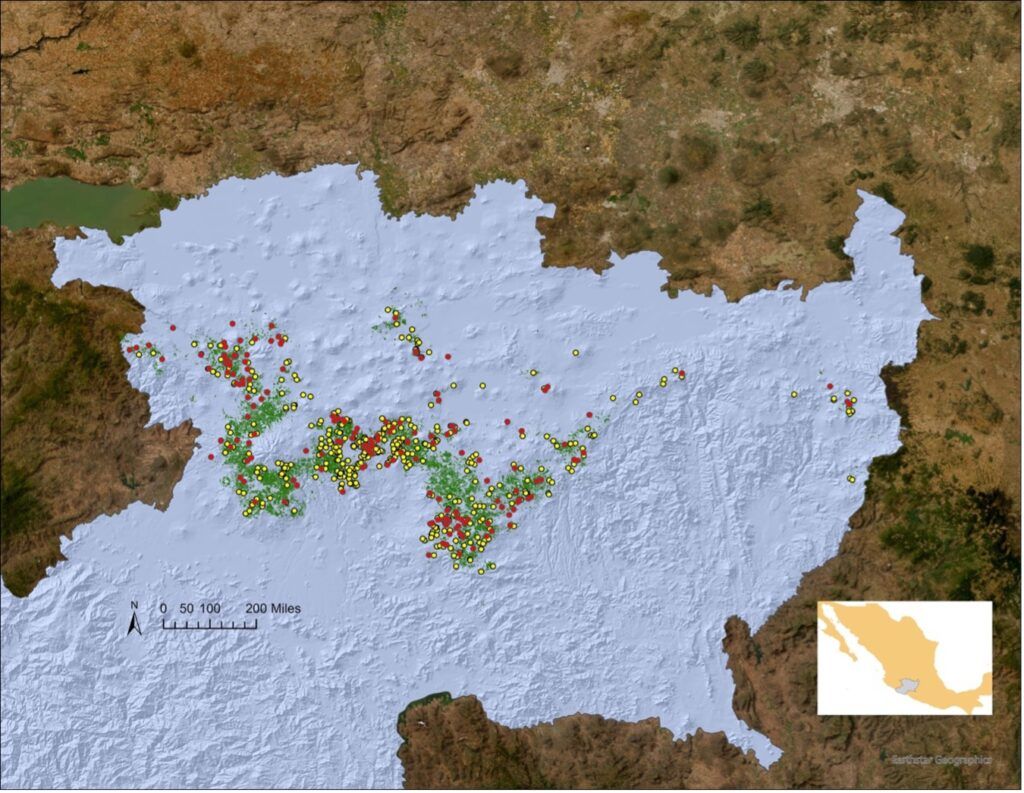
Green shows U.S.-export approved orchards in Michoacán. Yellow and red dots are government registered forest fires between 2012 and 2022, for which the GPS coordinates are within 100 meters of the export orchards. The red dots represent fires classified by the government as for “land use change” or “burn to clear.”
Only one of the 678 fires is classified as having a “natural” cause. This is consistent with an academic study of the 2401 records of fires in Michoacán’s avocado-growing region between 2000 and 2017 in which officials registered a cause: 0.37 percent were deemed to have natural causes, 67.7 percent intentional, and 31.9 percent accidental. The study concluded that fire is a “tool of land-use change to avocado” in the state.175Luis D. Olivares-Martinez et al, “Regional Drivers Behind the Burning of Remanent Forests in Michoacán Avocado Belt, Central Mexico,” Fire, 2023.
Climate Rights International found a striking example of the use of fires to clear forest for avocado production in an advertisement posted on a Facebook group, with more than 34,000 members, that is dedicated to buying and selling land for avocado orchards in Michoacán.176Facebook post in Facebook Marketplace Group, “AVOCADO MICHOACAN Purchase and Sale of Orchards and Land,” (“AGUACATE MICHOACAN Compra y Venta de Huertas y Terrenos”), https://www.facebook.com/groups/2032776826948260/permalink/4200963126796275/ (accessed July 12, 2023). The ad, posted on May 21, 2023, presents photographs of land that has evidently been recently burned and deforested—it is charred, with numerous tree stumps—and states “6 hectares for sale in [C]orupo. It’s ready to be planted and has a water storage pool (olla) for storing water that’s 40x40x10 and already full of water.” The ad asked for 2.4 million pesos (US$136,600). The sellers are apparently unconcerned about the prospect of environmental law enforcement.
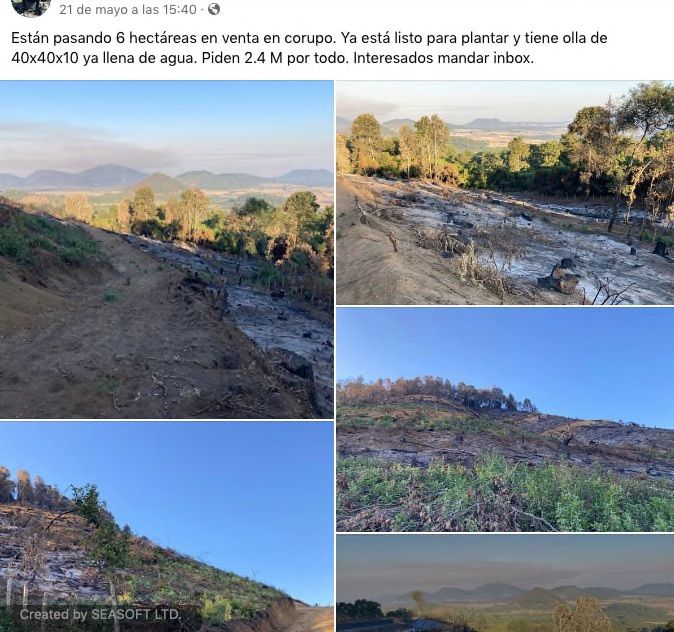

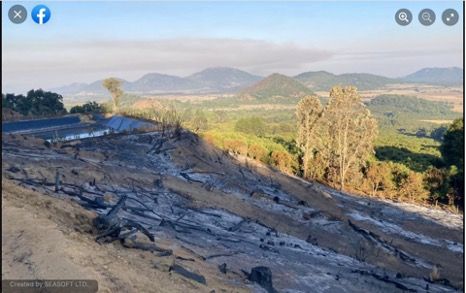
In addition to causing illegal deforestation, avocado producers consume vast quantities of water, often by illegally extracting it from rivers, streams, and underground aquifers to irrigate their orchards. The deforestation and massive water use have had significant negative impacts on local residents—causing or contributing to water shortages and to the risk of lethal flooding and landslides. In communities Climate Rights International visited, springs have dried up, water has flowed from faucets less frequently, and people have died from flash flooding.
The impacts affect an array of human rights, including the right to water, the right to life, and the right to a healthy environment The environmental degradation also undermines the fulfilment of Mexico’s obligation to protect at-risk populations from the foreseeable harms of climate change in Michoacán and Jalisco: increasing droughts as well as flooding and landslides triggered by heavy rains.
The expansion of avocado production in Michoacán and Jalisco—often involving illegal deforestation and water theft—has had a major impact on residents’ access to water, and in the absence of urgent measures, will continue to pose a systemic threat to the human right to water in coming years. This right entitles everyone to sufficient, safe, physically accessible, and affordable water for personal and domestic use. As the then-head of Michoacán’s State Water and Watershed Management Commission said in 2017, “In all the regions where there’s avocado the high areas [with the avocado production] are generating water scarcity in the lower areas.”177Uriel Morales Pérez, “Levels of Aquifer Mantles in Michoacán Go Down Because of Avocado Orchards: CEAGC,” (“Mantos acuiferos en Michoacán bajan nivel por huertas de aguacate: CEAGC”), Quadratin, June 18, 2017, https://www.quadratin.com.mx/principal/mantos-acuiferos-en-michoacan-bajan-nivel-huertas-aguacate-ceagc/ (accessed July 12, 2023).
Providing adequate water to communities requires ensuring the availability of water supplies: underground water in aquifers and surface water in watersheds. Avocado production in Mexico jeopardizes both. Scientific studies and official reports indicate that the conversion of forests to avocado orchards tends to impede the replenishment of aquifers. The irrigation of avocado orchards—much of it apparently illegal as discussed below—also drains vast quantities of water from aquifers and watersheds: the roughly 976 thousand metric tons of avocados exported from Michoacán and Jalisco to the United States in 2022 required the equivalent of some 290,000 Olympic swimming pools of water to grow.178A recent study of avocado production in Uruapan, Michoacán found an average water footprint of 744.3 liters per kilogram of avocados. Alberto Gómez-Tagle et al, “Blue and Green Water Footprint of Agro-Industrial Avocado Production in Central Mexico.” 976 thousand tons of avocados are 976 million kilograms, which would require 726.4 billion liters of water. An Olympic swimming pool has roughly 2.5 million liters. 744.3 billion divided by 2.5 million is 290 thousand. In the words of the then-Secretary of Environment of Michoacán, “We sell water to the United States in the form of avocado.”179Audrey Denvir, “Avocados Become a Global Commodity: Consequences for Landscapes and People,” p. 125 (citing personal communication, August 15, 2019).
The deforestation and water capture is occurring in a context of water vulnerability. In avocado-growing regions, many aquifers and watersheds already have deficits, and household access to water is limited, in some areas ranging from several hours of piped water every other day to months without the service in dry seasons.
In multiple specific communities, Climate Rights International found compelling evidence that avocado production has adversely affected residents’ access to water. In some instances, the impacts implicate residents’ human right to adequate water for personal and domestic use, such as by limiting their ability to bathe or wash clothes, and even forcing families to abandon their communities.
Climate change is likely to increase droughts in the region, further straining water supplies.
Water-intensive avocado production in Michoacán and Jalisco is mostly taking place in areas in which water is already in short supply, according to the Mexican government.
The Mexican government has recognized that protecting the availability of surface water in watersheds and underground water in aquifers is essential to safeguarding the human right to water. The first “strategic priority” in the government’s current National Water Program is to “protect the availability of water in watersheds and aquifers for the implementation of the human right to water.”180CONAGUA, “National Water Program 2020-2024 – Summary,” (“Program Nacional Hídrico 2020-2024 – Resumen”), https://www.gob.mx/cms/uploads/attachment/file/553479/PNH_Resumen_Imprenta_v200311.pdf, p. 24 (accessed July 12, 2023). This is because, as the government has stated, “taking care of the aquifers and hydrological watersheds is fundamental to ensure the permanence of the systems that make it possible to have the supply to cover the basic needs of the population.”181“National Development Plan 2007-2012,” (“Plan Nacional de Desarrollo 2007-2012”), 2007, https://www.gob.mx/cms/uploads/attachment/file/707911/Plan_Nacional_de_Desarrollo_2017-_2012_DOF.PDF (accessed July 12, 2023).
To protect water availability in watersheds and aquifers, the Mexican government has devised a federal water concession system. This system, codified in federal law, requires a government-issued concession (hereafter called a “license”) to use ground or surface water for most purposes, including for agricultural production and for municipal water provision systems.
Under Mexican law, the decision whether to grant a license must take into account the “mean annual availability” (“DMA”) of water, calculated at least every three years, in the watershed or aquifer from which the water will be drawn.182National Water Law (“Ley de Aguas Nacionales”), 1992, https://www.diputados.gob.mx/LeyesBiblio/pdf/LAN.pdf, art. 22 (accessed July 12, 2023). The DMA measures the volume of water—in addition to the water that has already been licensed—that can be sustainably extracted via license from an aquifer or watershed,183SEMARNAT, Official Mexican Norm NOM-011-CONAGUA-2015, “Which establishes the specifications and the method for determining the mean annual availability of national waters,” (“Que establece las especificaciones y el método para determinar la disponibilidad media anual de las aguas nacionales”), March 27, 2015, https://www.dof.gob.mx/nota_detalle.php?codigo=5387027&fecha=27/03/2015#gsc.tab=0; Huberto Silva-Hidalgo et al., “Methodology for determining the availability and deficit of surface water in watersheds: application to the case of Mexican norms,” (“Metodología para la determinación de disponibilidad y déficit de agua superficial en cuencas hidrólogicas: aplicación al caso de la normativa mexicana”), Tecnología y Ciencias del Agua, March 2023, https://www.scielo.org.mx/pdf/tca/v4n1/v4n1a2.pdf, p. 28 (accessed July 12, 2023). without “putting in danger the equilibrium of ecosystems.”184CONAGUA, “Availability in Aquifers,” (“Disponibilidad por Acuíferos”), https://sigagis.conagua.gob.mx/gas1/sections/Disponibilidad_Acuiferos.html (accessed July 12, 2023). When the DMA is a negative value, the aquifer or watershed is labeled as being in a deficit, meaning that additional water extractions cannot be sustained. The government’s DMA calculations measure extractions from watersheds and aquifers based on licensed uses—and thus do not factor in the unlicensed use—meaning that the DMA could very well overestimate water availability, and underestimate deficits.
As shown in the maps below, virtually all of the avocado-growing areas of Michoacán, and some of the growing regions of Jalisco, overlap with watersheds that the government determined to have a deficit in its most recent assessment, published in September 2020.185Maps of aquifer availability and deficits taken from CONAGUA, https://sigaims.conagua.gob.mx/dma/acuiferos.html (accessed July 12, 2023); As for deficits in aquifers, some of the growing region of Michoacán, and most of the region of Jalisco, were determined to have them in the assessment.
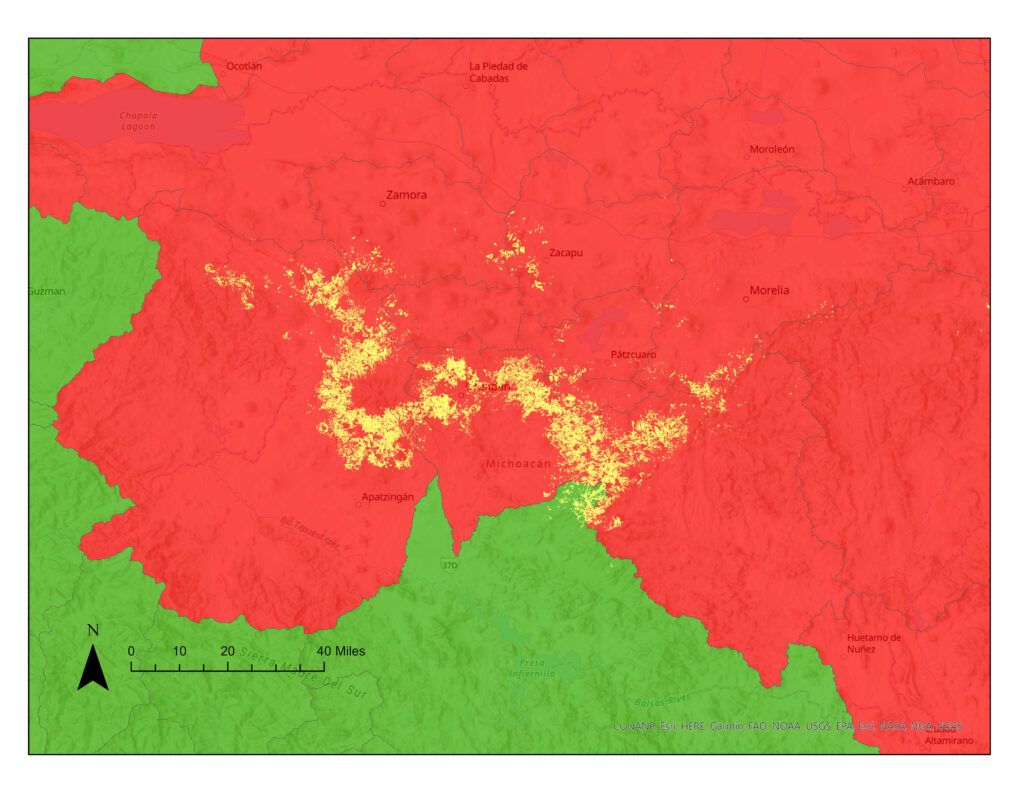
The yellow shows the area of U.S.-export approved orchards in Michoacán as of January 2023;186Polygons of U.S.-certified export orchards obtained in Transparency law response from SENASICA to request number 330028323000032, January 23, 2023. the red shows watersheds with a deficit, and green with availability, as of the latest government assessment, in September 2020.
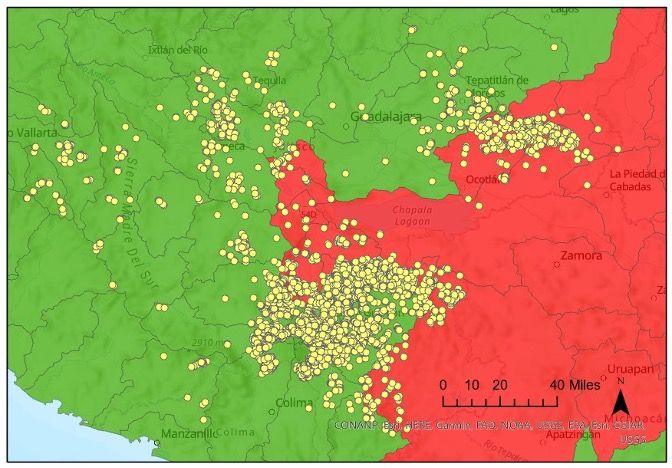
The yellow dots are government registered commercial avocado orchards in Jalisco as of October 2022, including many not yet approved for U.S.-export;187Transparency law response from SENASICA to request number 330028322000809, October 31, 2022. the red shows watersheds with a deficit, and green with availability, as of the latest government assessment, in September 2020.

The yellow shows the area of U.S.-export approved orchards in Michoacán as of January 2023; the red shows aquifers with a deficit, and green with availability, as of the latest government assessment, in September 2020.
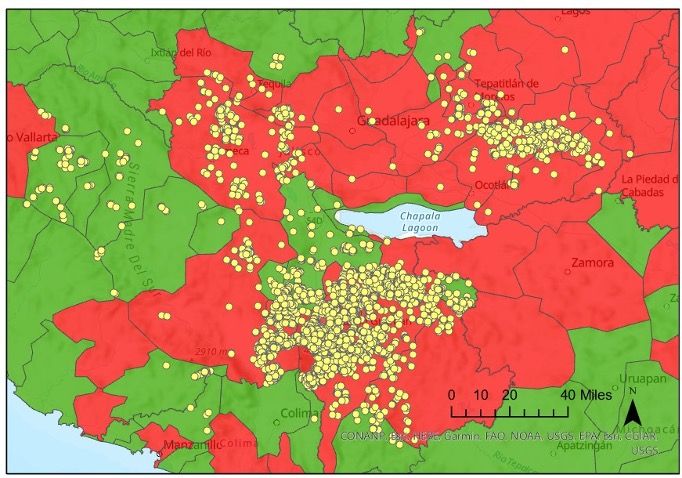
The yellow dots are government registered commercial avocado orchards in Jalisco as of October 2022, including many not yet approved for U.S.-export; the red shows aquifers with a deficit, and green with availability, as of the latest government assessment, in September 2020.
A recent report by the National Autonomous University of Mexico (UNAM) and civil society groups also documented water “stress” and “pressure” in the Lerma-Santiago-Pacífico (LSP) and Balsas Hydrological-Administrative regions, which cover Michoacán and Jalisco.188UNAM Water Network, Regional Center for Water Security Under UNESCO Auspices, and Agua Capital, “Perpsectives on Water in Mexico: Proposals for Water Security,” (“Perspectivas del agua en México: propuestas hacia la seguridad hídrica”), http://www.agua.unam.mx/assets/pdfs/Perspectivas_AguaenMexico2022.pdf, pp. 20, 31 (accessed July 12, 2023). According to the study, the LSP region is currently in a state of “water stress,” because the volume of renewable surface and groundwater—meaning the maximum amount of water that is feasible to use annually—there is less than 1,700 cubic meters annually per person in the region.189Ibid., p. 20. The study states that the Balsas region will also soon enter a state of “water stress” under this definition.190Ibid.
The study also reports that both the LSP and Balsas regions have a “high” level of “pressure” on water resources, a different metric based on the proportion of annual renewable surface and groundwater that is licensed by the government for any use.191Ibid., p. 31. With respect to the “pressure” metric, the Mexican government’s 2021-2024 Regional Hydrological Program for the LSP also states: “the rise in extraction of water in the [Lerma Chapala] Unit of Planning and its aquifers have caused a significant increase in the level of pressure on the resource, particularly with regard to agricultural use.”192CONAGUA, “Regional Water Program 2021-2024: VIII Lerma Santiago Pacific Hydrological-Administrative Region,” (“Programa Hídrico Regional 2021-2024: Región Hidrólogico-Administrativa VIII Lerma Santiago Pacífico”), https://files.conagua.gob.mx/conagua/generico/PNH/PHR_2021-2024_RHA_VIII_LSP.pdf (accessed July 12, 2023).
The provision of water to households is a major problem in many avocado-growing areas of Michoacán and Jalisco. In Michoacán, just 52.6 percent of households receive piped water to their homes or land on a daily basis, 27.9 percent every other day, 6.1 percent twice a week; 3.3 percent once a week; and 1.7 percent “once in a while,” according to the latest government survey, taken in 2017.193INEGI, “National Household Survey 2017,” (“Encuesta Nacional de los Hogares (ENH) 2017”), https://www.inegi.org.mx/programas/enh/2017/#Tabulados (accessed July 12, 2023). A 2011 government decree limiting new water licenses in much of the avocado-growing region of Michoacán cited “the very serious problem in supplying basic public services, including of potable water.”194Presidency of the Republic, “Decree by which the various ones constituting national water reserves are modified and a ban is established in the Balsas Number 18 Hydrological Region,” (“Decreto por el que se modifican los diversos por los que se constituyen reservas de aguas nacionales y se estabelece una veda en la Región Hidrológica número 18 Balsas”), March 22, 2011, https://dof.gob.mx/nota_detalle.php?codigo=5182688&fecha=22/03/2011#gsc.tab=0 (accessed July 12, 2023).
In Jalisco, 87.5 percent of households receive piped water to their homes or land on a daily basis; 6.3 percent every other day; 2.6 percent twice a week; 2 percent once a week; and 0.6 percent “once in a while,” according to the 2017 survey. Just 77 percent of households have access to piped water in the Sierra de Tapalpa region of Jalisco, a bastion of avocado production that includes San Gabriel and several other municipalities.195State Government of Jalisco, “Strategic Regional Plan for the Sierra Tapalpa 2019-2024 Vision 2030,” (“Plan Estratégico Regional Sierra de Tapalpa 2019-2024 Visión 2030”) https://plan.jalisco.gob.mx/wp-content/uploads/2022/10/PlanEstrategicoSierraTapalpa_web.pdf, pp. 55, 63 (accessed July 12, 2023) (stating that the region has a “deficient coverage of potable water”).
Residents, community leaders, and officials from multiple Michoacán and Jalisco populations in, or below, avocado growing regions told Climate Rights International that homes in their communities did not receive piped water on a daily basis. In these communities, access ranged from one or two hours every other day or once or twice a week, to enduring months without receiving water during the dry season, or having no piped water whatsoever. In most of these communities, Climate Rights International found evidence indicating avocado production had contributed to the lack of access to varying degrees. And even where we did not obtain evidence confirming or ruling out a causal connection, the lack of access underscores the communities’ vulnerability to the impacts of continued water use for avocado production, in a region where the IPCC has projected increasing drought in the future.
The clearing of forests for orchards negatively impacts water supplies for communities. This is because forests play a vital role in allowing water to enter the ground and replenish aquifers, which in turn provide water to populations via natural springs and wells. As one academic study observed, while forests “naturally act to retain water in the soil,” agricultural monocultures such as avocado production “usually result in lower soil water retention and increased runoff.”196Audrey Denvir, “Avocados Become a Global Commodity: Consequences for Landscapes and People,” 31 (citing Bravo-Espinosa, M., et al., “Effects of converting forest to avocado orchards on topsoil properties in the trans-Mexican volcanic system, Mexico,” Land Degradation & Development, 2014, https://doi.org/10.1002/ldr.2163(accessed July 12, 2023)).
Government officials and academics have sounded the alarm over the water impacts of replacing forests with avocado orchards in Mexico. An academic study by Dr. Alberto Gómez-Tagle and his colleagues at the Universidad Michoacana de San Nicolás Hidalgo estimates that native pine trees infiltrate into the groundwater at least 14 times more water than avocado trees, due to branch pruning altering the flow of water down avocado trees, the comparatively low density of avocado trees in an orchard, and the more horizontal nature of the avocado tree roots.197Alberto Gómez-Tagle et al., “Hydrological impact of green hold (avocado culture) in central Mexico; rainfall partition and water use comparison with native forests,” presentation at Joint Conference on Forests and Water, Valdivia, Chile, November 2018, https://www.researchgate.net/publication/329060308_Hydrological_impact_of_green_gold_avocado_culture_in_central_Mexico_rainfall_partition_and_water_use_comparison_with_native_forests/link/5bf3eddda6fdcc3a8de38777/download (accessed July 12, 2023); “Proceedings Book 2018,” Joint Conference on Forests and Water 2018, https://www.researchgate.net/publication/329060192_ID_1369_HYDROLOGICAL_IMPACT_OF_THE_GREEN_GOLD_AVOCADO_CULTURE_IN_CENTRAL_MEXICO_RAINFALL_PARTITION_AND_WATER_USE_COMPARISON_WITH_NATIVE_FOREST/link/5bf3eb1b4585150b2bc3d2ce/download ) (accessed July 12, 2023).
The study also found that an avocado tree consumes four to five times more than a native pine tree.198Ibid. Accordingly, Dr. Gómez-Tagle estimates that one hectare of avocado, with 156 trees, consumes 1.6 times more water than one hectare of pines, with 677 trees.199Ibid.
Overall, the Gómez-Tagle study concludes that “hydrological functioning may be severely affected by land use change from native forest to avocado plantations.”200“Proceedings Book 2018,” Joint Conference on Forests and Water 2018. Along the same lines, another recent academic study on water use for avocado asserts that land-use change “increases runoff, impedes the infiltration of water,” and is “probably pushing towards the accelerated loss of areas of water capture.”201Gerardo Ruíz-Sevilla and Carlos Francisco Ortiz-Paniagua, “Avocado Production’s Implications for Hydrological Balance from a Geographic Information Systems (GIS) Perspective, 2011-2019,” (“Implicaciones de la Producción de Aguacate en el Balance Hídrico desde una Perspectiva de los Sistemas de Información Geográfica (SIG), 2011-2019”), Revista CIMEXUS, October 18, 2021, https://doi.org/10.33110/cimexus160201, pp. 13, 18 (accessed July 11, 2023).
A 2012 report by a research agency within Mexico’s agricultural ministry, titled Impact of Land-Use Change From Forests to Avocado Orchards, warned that “the change of land use in forest lands to establish orchards reduces the water that infiltrates and increases evapotranspiration, thereby reducing the flow of springs.”202Mexico’s National Institute for Forestry, Agriculture and Livestock Research (INIFAP), “Impact of Land-Use Change From Forest to Avocado,” (“Impacto del cambio de uso de suelo forestal a huertos de aguacate”), p. 5. Similarly, the 2019 complaint denouncing 1,500 hectares of illegal deforestation, filed by the heads of several Jalisco government agencies with PROFEPA, stated that the “loss of forests and jungle…affects the capacity of ecosystems in their provision of environmental services such as the infiltration of water belowground, reducing the recharge of the aquifers.”203Complaint filed with PROFEPA, July 30, 2019, p. 2, obtained through transparency law.
Clandestine deforestation to convert forest land to avocado and berry plantations poses a “substantive” problem for water resources in Michoacán, according the Mexican government’s 2021-2024 Regional Hydrological Plan for the Balsas IV Hydrological-Administrative Region.204CONAGUA, “Regional Water Plan 2021-2024: Balsas IV Hydrological-Administrative Region,” (“Program Hídrico Regional 2021-2024: Región Hidrológico-Administrativa IV Balsas”), https://www.gob.mx/cms/uploads/attachment/file/779165/PHR-_Balsas_231122.pdf, p. 56 (accessed July 12, 2023). Along similar lines, CONAGUA’s 2020-2024 National Water Program states that “climate change and land use change will significantly affect water resources and sources of water supply in every region of the country,” and that “the deterioration of watersheds happen because of land use change.”205CONAGUA, “National Water Program 2020-2024 – Summary,” p. 13.
In April 2023, the Michoacán’s Secretary of Environment warned, at a press conference with the governor, that if deforestation continued in the Aguila Hill, the state’s capital city of Morelia could “run out of water” (nos vamos a quedar sin agua), since the hill is a principal recharge zone for a water spring that supplies 30 percent of the city’s water.206Government of Michoacán Facebook page, “Press Conference About the Advances in the Prior Consultation Process for the Declaration of a Protected Area,” (“Encuentro con medios de comunicacion sobre el avance en el proceso de consulta pública previa a la declaratoria de área natural protegida,”) April 17, 2023, https://m.facebook.com/gobmichoacan/videos/1197079354342411/ (accessed August 1, 2023). The Secretary of Environment said authorities had confirmed local residents complaints of deforestation for avocado orchards on the hill, and Climate Rights International reviewed satellite imagery showing U.S.-export certified orchards there containing land that was deforested over the past decade.
Residents in avocado growing regions reported that deforestation for orchards negatively impacts their communities’ water supply. In some areas, residents said they had noticed a reduction in water in springs as forests uphill had been cleared and/or burned. In others, residents said that protecting their water supply was one of the main reasons motivating them to oppose deforestation for avocados.
Even some avocado growers interviewed expressed fear that continued expansion of orchards at the cost of forests in the surrounding hills would affect the water supply in the region, including for their own crops. “They’ve deforested the hills without any fear. Soon we won’t have water,” said one avocado grower. “If they don’t stop there’s going to be a big problem in a few years…The water doesn’t penetrate the aquifer, it just runs.”207CRI interview with resident, Michoacán, 2023 (name and exact date and location withheld).
Climate Rights International found extensive evidence suggesting widespread unlicensed water use by many Michoacán and Jalisco avocado growers to irrigate their orchards.
Water to irrigate avocado crops generally comes from three sources: underground water extracted from wells or springs, surface water such as streams and rivers, and rainfall captured in storage systems directly from the sky. Generally, the water from all three sources is kept in water storage pools called “ollas,” which can range from 12 square meters to more than 10,000 square meters, the equivalent of almost two NFL football fields in area.208Gerardo Ruíz-Sevilla, Carlos Francisco Ortiz Paniagua, and Alberto Gómez-Tagle Chávez, “Estimate of Water Dammed for Irrigating Avocado Orchards Using Geographic Information Systems,” (Estimación del agua represada para riego de huertas de aguacate mediante uso de sistemas de información geografica”), VII National Congress of Irrigation, Drainage, and Biosystems, p. 4., https://www.riego.mx/congresos/comeii2022/assets/docs/ProtPonencias/PDF_Extenso/22015_Gerardo%20Ru%C3%ADz_extenso.pdf (accessed August 22, 2023). A recent study by Michoacán’s Forest Commission of just four avocado-growing municipalities in the state identified 6,872 storage pools, spanning 1,023 acres, and capable of storing nearly 5,000 Olympic pools-worth of water.209Michoacán Forest Commission, “Anti-Hail Cannons or Systems,” (Cañones o sistemas antigranizo), September 23, 2023. The municipalities were Tacámbaro, Uruapan, Ziracuaretiro, and Madero.

An empty water storage pool, with a recently deforested hill in background, in Panindícuaro, Michoacán. Photograph taken by Rodrigo Caballero in January 2023.
Under Mexican federal law, a federal government-issued license is required to store and use for avocado orchards (and other agricultural production) any water that comes from either (1) surface-level sources such as rivers, streams, springs, or lakes; or (2) underground sources, such as water extracted from aquifers using wells.210Political Constitution of the United Mexican States, art. 27; National Water Law, arts. 18 and 20; Presidency of the Republic, “Decree by which it is declared in the public interest the conservation of the aquifers and appropriation of the underground waters in all the Municipalities of the State of Michoacán,” (“DECRETO por el que se declara de interés público la conservación de los mantos acuíferos, y aprovechamiento de las aguas del subsuelo en todos los Municipios del Estado de Michoacán”), October 20, 1987, https://dof.gob.mx/nota_detalle.php?codigo=4695440&fecha=20/10/1987#gsc.tab=0 (accessed July 12, 2023); Presidency of the Republic, “Decree by which it is declared in the public interest the conservation of the aquifers in non-prohibited zones in various municipalities of the state of Jalisco and a prohibition is established for the use, extraction, and appropriation of underground waters in all the municipalities of the state of Jalisco,” (Decreto por el que se declara de interés público la conservacion de los mantos acuíferos en zonas no vedadas en diversos Municipios del Estado de Jalisco y se estabelce veda por tiempo indefinido para el alumbramiento, extracción y aprovechamiento de las aguas del subsuelo en todos los Municipios del Estado de Jalisco,”), December 7, 1987, “CONAGUA, https://www.dof.gob.mx/nota_detalle.php?codigo=4707479&fecha=07/12/1987#gsc.tab=0 (accessed October 3, 2023); “Provisional Suspension of Free Withdrawal,” (“Suspensión Provisional del Libre Alumbramiento”), https://sigagis.conagua.gob.mx/gas1/sections/LibreAlumbramiento.html (accessed July 12, 2023); CONAGUA, “Prohibitions, Reserves, and Regulations of Subterranean Waters,” (“Vedas, Reservas, Reglamentos De Aguas Subterraneas”), https://sigagis.conagua.gob.mx/dvedas/ (accessed October 3, 2023). The unauthorized use of this water without a license is an administrative law violation, subject to sanctions such as fines.211National Water Law, art. 119(VIII) Capturing direct rainfall is legal and does not require a concession.

It is often difficult for local residents and activists—and even government officials—to directly verify whether avocado orchards are illegally using water because, as discussed in chapter 4, they believe it would be dangerous to visit the areas where they suspect the water is being extracted or diverted. Nonetheless, interviews with officials and residents, Climate Rights International field visits, and academic studies point to pervasive water theft by avocado growers in both states.
Current and former senior officials in Michoacán and Jalisco told Climate Rights International that they believe many orchards are illegally using water. A CONAGUA official in Michoacán said that the illegal use of water for avocado orchards is a “very serious problem,” and that it is common for producers to pump water from wells or streams to water storage pools without licenses.212CRI interview with CONAGUA official, Morelia, Michoacán, March 6, 2023 (name withheld). Another senior official in Michoacán said he believed that many of the water storage pools are sourced from illegal wells and rivers.213CRI interview with environment official, Morelia, Michoacán, April 17, 2023 (name withheld).
In a 2020 interview, the then-head of Michoacán’s State Commission for Water and Watershed Management (CEAC) estimated that 50 percent of all wells in the state are unauthorized.214Arturo Molina, “Water Wells Threaten Aquifers in Michoacán: Half of Them are Illegal,” (“Pozos de agua amenazan mantos acuíferos en Michoacán: la midad de ellos son ilegales”), La Voz de Michoacán, Feb. 22, 2020, https://www.lavozdemichoacan.com.mx/michoacan/medio-ambiente/pozos-de-agua-amenazan-mantos-acuiferos-en-michoacan-la-mitad-de-ellos-son-ilegales/ (accessed July 12, 2023). The article with the interview summarized that “as many communities in the state lack potable water, the main fruit crops for export in the state continue to irregularly access large volumes of water.”
In Zapotlán el Grande, a large hub of avocado and berry production in Jalisco, environmental officials estimated that there could be as many as three times more unauthorized as authorized wells for agricultural use, including for avocado production.215CRI interviews with Zapotlán el Grande officials, Ciudad Guzman, Jalisco, March 17, 2023 (names withheld). They said land-use change also reduces infiltration to the underground aquifer. The officials said there has been a recent decline in household water access in the municipality, and that it is at risk of running out of water in the future.
Another official from Zapotlán el Grande stated that there are both unregistered wells, and wells whose actual extraction exceeds the licensed amount.216CRI interview with official, Jalisco, 2023 (name, and exact date and location withheld).
Residents in avocado growing regions across Michoacán and Jalisco also told Climate Rights International that orchards are using surface and groundwater without authorization—including water that is intended for communities’ domestic use:
In 2022, a group of environmental activists visited and attempted to stop the unauthorized digging of six wells for avocado production in Tancítaro.219CRI group interview with residents, Michoacán, 2023 (names and exact dates and locations withheld). Residents also provided Climate Rights Interntational with a March 2023 photograph of hoses coming from a river in Tancítaro, which they suspect to be taking water to avocado orchards without authorization.

March 2023 photograph of suspected unauthorized capture of water from river for orchards, provided by local residents.
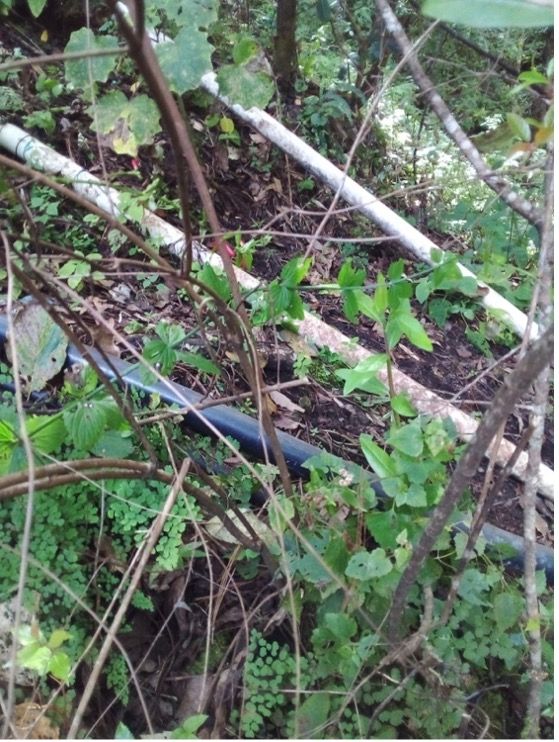

Photos provided by Madero resident
In two municipalities, residents and activists took Climate Rights International personnel to personally observe sites where pumps and tubes appeared to be illegally capturing water for avocado. Climate Rights International checked Mexico’s national registry of water licenses, and confirmed that there were no registered water licenses for the area. (The next section, with case studies, has additional examples of suspected unlicensed water use for avocado production reported by residents where Climate Rights International conducted research.)
Two academic studies of water use for avocado orchards in Michoacán also strongly suggest that growers are illegally using ground and surface water without required authorization. A 2022 academic study concluded that, in Uruapan in 2017, the amount of water used just for avocado crops was 120 percent of the amount of water the government had licensed for agricultural use of any kind in the municipality.222Alberto F. Gómez-Tagle et al., “Blue and Green Water Footprint of Agro-Industrial Avocado Production in Central Mexico.” The authors said their findings were “indicative of the existence of a nonregistered appropriation of water.”223Ibid.
Similarly, a 2022 doctoral thesis studying water use for avocados and strawberries in four municipalities of Michoacán concluded that the “intensive agricultural production… causes water vulnerability, due to the excessive use of unlicensed [surface and ground] water in the studied municipalities.”224Diana Janeth Fuerte Velázquez, “Evaluation of the Water Footprint of Avocado and Strawberry Production in the Municipalities of the Cointzio Sub-Watershed,” (“Evaluación de la huella hídrica en la producción de aguacate y fresa en municipios de la Subcuenca de Cointzio”), (Ph.D. diss., Universidad Michoacana de San Nicolás de Hidalgo, January 2022), http://bibliotecavirtual.dgb.umich.mx:8083/xmlui/bitstream/handle/DGB_UMICH/6785/FEVAQ-D-2022-0091.pdf?sequence=1&isAllowed=y, p. iii (accessed July 12, 2023). For the period of 2012 to 2017 in the municipality of Acuitzio, the study estimated an average annual use of 6.35 million cubic meters of surface and ground water for avocado production, as compared to an average annual license of 3.35 million cubic meters for agricultural use.225Ibid., p. 141.
By compounding the scarcity of water available to local populations, the water theft—like the deforestation—poses a systemic risk to their right to water. Moreover, it subverts the federal regulatory regime designed to protect this right through the protection of aquifers and watersheds. And it undermines the population’s human right to participate in decisions affecting their right to water, as it removes the allocation of water from a regulated process subject to democratic control and civic participation.226The right to participate is further hampered by the dangers of defending water resources, analyzed in chapter 4.
Local residents, including officials, from 12 Michoacán and Jalisco municipalities that produce avocado, or are located directly downhill from such production, told Climate Rights International that avocado expansion had significantly impacted access to water in their area, or posed a serious risk of doing so in the near future.227The municipalities are Parácuaro, Madero, Nahuatzen, Jimenez, Nocupétaro, Carácuaro, Tancítaro, Ziracuaretiro, San Gabriel, Zapotlán el Grande, Zapotitlán de Vadillo, and Mazamitla. The impact has in certain instances been so substantial that it has infringed on their human right to adequate water for personal and domestic use.
In some of these cases—such as when there has been long-term illegal deforestation and water extraction higher up in a watershed that appears to impact water availability below—the evidence suggests that the avocado production is a meaningful contributing factor, but it is beyond the scope of this report to determine its exact causal weight. We did not assess, for example, the extent to which rainfall variations and drought conditions may have contributed to reported reductions in water access. In others, the casual link appears very strong, direct, and preponderant—such as when the drilling and use of a well for avocados is immediately followed by a dramatic drop in water in a neighboring spring.
El Atascoso is a small rural community on the border between the municipalities of Tamazula de Gordiano and Mazamitla, Jalisco, where residents mostly live off rainfed corn and bean farming. The latest government figures for water availability in its aquifer show a “mean annual availability” (DMA) deficit of 26.3 million cubic meters of water, 9.5 percent of the 276 million cubic meters it would need to have no deficit.228CONAGUA, “Availability in Aquifers.” Residents told Climate Rights International that a water well used to irrigate a nearby, recently deforested avocado orchard has dramatically reduced the amount of water in the springs the community relies on for personal and domestic use, to the point that some residents have abandoned the community because of the lack of water.229CRI group interview with residents, El Atascoso, Jalisco, 2023 (names and date withheld).
Google Earth satellite imagery shows that the plot of land where the orchard is located, which residents call “Loma de las Carreras,” was first deforested between 2012 and 2016. PROFEPA detected the illegal land-use change for avocado on the property in 2014, according to a response to a transparency law request.230Agustín del Castillo, “Omissions by the Authority Amplified Damage to Forest,” (“Omisiones de la autoridad potenciaron daño al bosque”), Milenio.com, July 18, 2017, https://www.milenio.com/estados/omisiones-de-la-autoridad-potenciaron-dano-al-bosque (access July 12, 2023) (stating that PROFEPA partially closed an area in Mazamitla, called “Predio Los Colomos y Loma de las Carreras,” where satellite imagery shows there was land-use change between 2013 and 2016); transparency law response from PROFEPA to request number 330024422000065, February 9, 2022 (identifying an avocado plantation in Tamazula de Gordiano, in the Atascoso Ejido, as an area where PROFEPA identified that in 2014 there was deforestation to install an avocado orchard). Yet, satellite imagery shows that the clearing of trees continued between 2018 and 2021. There is now an approximately 56-acre avocado orchard there, which Climate Rights International visited in June 2023.
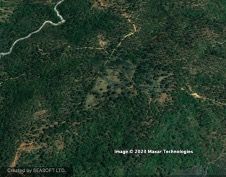
2012

2018

2016
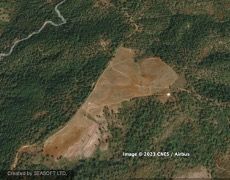
2021
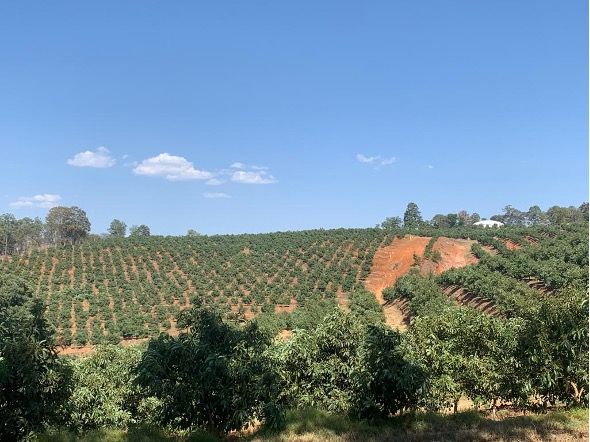
Part of the orchard, in photo taken by Climate Rights International in June 2023
Residents of El Atascoso, who live about one to two kilometers downhill from the orchard, said that around 2019, they saw workers use heavy machinery to dig a water well in the orchard.231CRI group interview with residents, El Atascoso, Jalisco, 2023 (names and date withheld). Workers then planted the orchard with avocado trees. At the end of the year—when the rainy season ended, and water from the well would have been needed to irrigate the avocados—the residents said they noticed a dramatic decline in the amount of water in the springs, downhill from the orchard, that had long been the community’s exclusive sources of water.
Since then, according to the residents, water levels have dropped dramatically in the springs, and several have completely dried up. They said they have lived there their entire lives—in some cases more than six decades—and had never before witnessed such a drop in water availability.
According to residents, since the drilling of the well, four families have left the community due to the lack of water. And several said they too would leave if the water scarcity continued. One man who lives alone after his family members left said that he now only has enough water to bathe once every week or two. He takes about 40 liters of water per day from a remaining spring, to use for bathing, washing clothes, flushing the toilet, cleaning dishes, and maintaining a farm animal. For drinking water, he takes about another 20 liters weekly from a different spring. He said he does not have enough money to buy water.
In the man’s words, the area that is now an orchard
was pure pines but they cleared it clean like a desert…. My spring was affected [by the well]. It dried up quickly. I don’t have enough water to wash my hands, let alone bathe.232Ibid.
Residents told Climate Rights International that they had reached out to the orchard hoping to make an arrangement to share water more equitably. They spoke with workers at the orchard and asked them to forward a request to the owner to allow them to pipe water from the orchard well to the community for two to three hours on the days when the pump is turned on.233Ibid. The request was denied.
According to our analysis, the orchard and well appear to be owned by Agro Gonzámex, a leading Jalisco avocado packing and exporting company previously called Agro González234Grupo Gonzámex website, http://grupogonzamex.com/ (accessed August 14, 2023); Agro Gonzámex website, www.agrogonzamex.com (accessed July 14, 2023).—which exports to Europe, Canada, Japan, and Hong Kong—or one of its executives, Ignacio González. According to the residents, workers told them the orchard owner’s name was “Nacho González.” Nacho González is the short name for Ignacio González, who is an executive from Agro Gonzámex.235In an April 2023 interview, Ignacio González is introduced by the interviewer as “Nacho González,” the founder of Agro Gonzámex, and the title in the broadcast lists him as the “General Director.” In the interview, Nacho González says that he and his two brothers are the “heads” (cabezas) of Agro Gonzámex. He also says that his son, also “Nacho,” works for the company. Inocuo, “Generational Transition of a Family Company,” (“Transición generacional de una empresa familiar”), video clip, vimeo.com, https://vimeo.com/829230785 (accessed July 12, 2023). One resident also said he had seen the logo for Agro González on the machinery that was used to dig the well. CONAGUA’s website shows that “AGRO GONZALEZ, S.P.R. de R.L.” owns the license, registered in 2007, for underground water extraction for agricultural purposes in the exact location of the orchard.
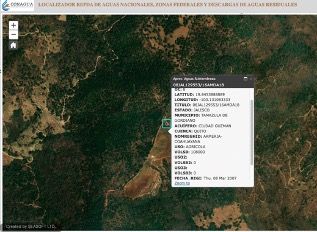
Screenshot of CONAGUA website, showing Title number 08JAL129553/16AMDA18 located inside of the orchard that appears to be affecting El Atascoso.236CONAGUA, https://sigagis.conagua.gob.mx/locrepda20/ (accessed July 12, 2023). A separate section of CONAGUA’s website states that Title 08JAL129553/16AMDA18 is registered to “AGRO GONZALEZ, S.P.R. DE R.L.”237CONAGUA, https://app.conagua.gob.mx/consultarepda.aspx (accessed July 12, 2023).
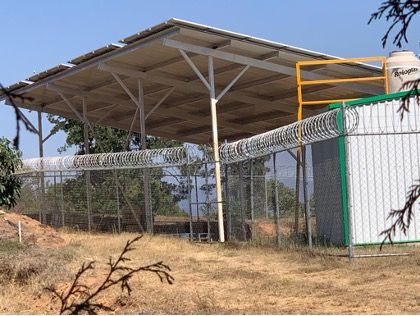

Climate Rights International photos from June 2023 of fencing around the well in the orchard (left), and a dried out spring in El Atascoso (right).
Climate Rights International found evidence strongly suggesting that the water supply of Epenche Grande, a community in Mazamitla, Jalisco, has been depleted by a well installed for an avocado orchard that appears to be owned by the avocado packing and exporting company Agro Gonzámex, also known as Agro González. Unlike the case of the orchard near El Atascoso, CONAGUA’s website shows that there is no active license to extract underground water in the area where this orchard is located.238The CONAGUA website shows a license for underground water right next to the orchard, but that it was registered in October 1998 and expired in September 2008. CONAGUA, https://sigagis.conagua.gob.mx/locrepda20/ (accessed September 13, 2023).
In 2021, workers dug a well in the orchard, according to residents.239CRI interview with residents, Jalisco (name, date and exact location withheld). When the orchard started pumping from the well, the community’s water spring completely dried up. The spring was the community’s only water source—it had long provided them with tubed water to their households.
Shortly after the spring dried up, community members met at the site of the spring with the municipal president and Ignacio González, of Agro Gonzámex. Climate Rights International obtained a video of the meeting, which was held in late 2021. Toward the beginning, before González arrives, community members complain to the municipal president about deforestation and forest fires for avocado in the area. “We’re a desert now,” one of them says. They discuss removing two wells in the orchard—the recently-drilled one and another previously existing one—that are affecting their spring. The municipal president states that the recently drilled well does not have a license. (The lack of active licenses in the area, noted above, suggests the prior well was also unlicensed.)
Ignacio González eventually shows up at the meeting—his face is clearly identifiable,240CRI identified him by comparing the face in the video with other publicly available images of Ignacio González of Agro Gonzámex. and the municipal president addresses him as “Nacho,” the short name for Ignacio. The municipal president asks González for the “favor” of keeping the wells shut down so that the spring can recover. González responds with “another proposal”: he says he’s installing a 200,000 liter water storage pool “above,” and could bring water down to them in tubes; and that his intention is to solve their water problem and build them their own well below. A community member rejects this proposal, stating, “where are you going to get the water to solve the issue here, if we’re going to shut down your two wells? As long as you are pumping water up there above,” he explains, their spring won’t recover below. A community member and the municipal president reiterate the request to not pump the wells, so that the spring can recover, to which González agrees. He later states: “If I don’t irrigate the orchard for two months, it will be ruined, but that’s no problem, that’s my issue…. My orchard will be ruined, sincerely speaking.” Ultimately the municipal president and community members postpone the resolution of the issue.
A municipal official speaking on behalf of the municipal government of Mazamitla told Climate Rights International that it is common sense—and he believes, as local residents do—that the well linked to González caused the spring to dry up, given the sequence of events, and the fact that the spring had not dried up before.241CRI telephone interview with Mazamitla municipal government official, September 14, 2023.
Shortly after the meeting, CONAGUA personnel inspected the well, according to the municipal official.242Ibid. CONAGUA’s website also appears to register the visit: it reports that the only inspection it conducted in Mazamitla in 2021 occurred on December 9, in relation to underground water, and that the visit was to “Agro Gonzalez, S.P.R. de R.L.”243CONAGUA, “PNI-2021: Visits Carried Out in the Period of January-December 2021” (“PNI-2021: Visitas realizadas en el periodo enero-diciembre del 2021,”), https://www.gob.mx/cms/uploads/attachment/file/695480/12_DICIEMBRE_PNI_2021_VP.pdf (accessed September 14, 2023). The municipal official said that inspection only resulted in the temporary closure of the well. (A CONAGUA official told Climate Rights International that they could not provide any information about the inspection—including whether there had been any sanction—because it was confidential.)244CRI telephone call with Jalisco-based CONAGUA official, September 18, 2023.
In March 2022, Ignacio González, acting as a “representative of the company AGROGONZALEZ,” met with the Mazamitla municipal president and Epenche Grande community leaders and residents, according to minutes of the meeting obtained by Climate Rights International.245Mazamitla Municipal Government, “Minutes of Meeting,” March 25, 2022. In the meeting, they reached “agreements to reestablish the potable water service in the town of ‘Epenche Grande.’”246Ibid. The agreements are that:
At the time of this publication, the well has not yet been dug.247CRI interview with resident, Jalisco (name, date and exact location withheld); CRI telephone interview with Mazamitla municipal government official, September 14, 2023.
Residents reported that the water provided by the orchard has been sufficient to cover their basic needs, though it is less than what the spring had provided them before it dried out. Their spring still has no water, leaving them at the mercy of the avocado company.
The towns of Carácuaro and Nocupétaro are down the mountain from the neighboring municipality of Madero. All three are located in the same sub-watershed, which is within the larger Tacámbaro River watershed.248INEGI, “Hydrographic Network Edition 2.0 H. Balsas Region,” (“Red hidrográfica edición 2.0. Región H. Balsas”), 2010, https://www.inegi.org.mx/app/biblioteca/ficha.html?upc=702825006993 (accessed July 12, 2023) (the sub-watershed is called RH18Hc – River Carácuaro). The latest government figures for water availability in the Tacámbaro River watershed show a DMA deficit of 241 million cubic meters of water, 22.5 percent of the 1.067 billion cubic meters it would need to have no deficit.249SEMARNAT, “Agreement to Update the Mean Annual Availability of National Surface Waters for 757 Hydrological Watersheds Constituting 37 Hydrological Regions in which the United Mexican States are Divided,” (“Acuerdo por el que se actualiza la disponibilidad media anual de las aguas nacionales superficiales de las 757 cuencas hidrológicas que comprenden las 37 Regiones Hidrológicas en que se encuentra dividido los Estados Unidos Mexicanos”), https://www.dof.gob.mx/nota_detalle.php?codigo=5600849&fecha=21/09/2020#gsc.tab=0 (accessed July 12, 2023). All three municipalities – Madero, Carácuaro, and Nocupétaro – are classified by CONAGUA as being at high risk of drought.250CONAGUA, “Map of Probability of Drought Threat,” (“Mapa de probabilidad de amenaza por sequía”), https://www.gob.mx/cms/uploads/attachment/file/781257/Probabilidad_de_Amenaza_por_Sequ_a_2020.pdf (accessed July 12, 2023).
Carácuaro’s and Nocupétaro’s main water supply is the Carácuaro River, which flows down from and is fed by streams in Madero. The Carácuaro River flows through Carácuaro, and nearby Nocupétaro, and the municipal governments pump water from it to tanks. From the tanks, the water flows through pipes to homes throughout the towns.251CRI group interview with Carácuaro officials, Carácuaro, Michoacán, January 23, 2023.
Carácuaro and Nocupétaro municipal officials said that over about the past decade, there has been a reduction in the amount of water in the river, which they attribute to the deforestation and water theft by avocado producers upstream. One reported observing the river shrink by two meters on each side, and then expand, without major changes in rain. He attributes these quick, dramatic changes to the pumping of water for orchards in Madero.252CRI interview with Nocupétaro official, Nocupétaro, Michoacán, January 23, 2023. Another official said he has seen in Madero small dams blocking streams, from which water was extracted for avocado orchards.253CRI interview with Carácuaro official, Carácuaro, Michoacán, January 23, 2023. The water runs lowest at the end of the dry season, in March to May, when sometimes the water is completely unavailable to pump for residents, they said.
A Nocupétaro official said residents now receive water every other day for about one to one and a half hours, or for as few as 40 minutes at the end of the dry season. In Carácuaro, municipal officials stated that sometimes they are only able to send water to homes for one hour every other day, or even once every six days, and that almost every day the population complains that they are not receiving enough water for personal and domestic use, including to bathe, wash dishes, and use for the bathroom. The water is not treated and is unsafe to drink, according to the officials.254In February 2023, the mayor announced the start of construction of a water treatment plant for the municipal seat of Carácuaro. “Reynaldo Gómez Starts Construction of Water Treatment Plant for the Municipal Seat of Carácuaro,” Siglo Veinte, February 7, 2023, https://sigloveinte.mx/reynaldo-gomez-da-arranque-a-la-construccion-de-una-planta-potabilizadora-de-agua-para-la-cabecera-municipal-de-caracuaro/ (accessed July 12, 2023).
Climate Rights International interviewed Carácuaro residents who described severely limited access to piped water, which forced them to spend substantial portions of their income in purchasing water in tanks sold by private vendors.
For example, one woman said the amount of water her household receives has declined in recent years. Between around April and June, her home receives piped water every other day for one hour, or sometimes just once every five to eight days.255CRI interview with Carácuaro resident, Carácuaro, Michoacán, January 23, 2023 (name withheld). She said that this can amount to about 400 liters of water every other day to divide among the four people in her home for cleaning, sanitation, and bathing. That’s about 50 liters per person per day—right at the threshold of what the UN Special Rapporteur on the Human Right to Water and Sanitation has stated is the minimum to ensure the full realization of the right to water.256UN Special Rapporteur on the Human Right to Safe Drinking Water and Sanitation, “Frequently Asked Questions,” https://sr-watersanitation.ohchr.org/en/rightstowater_5.html (accessed July 12, 2023). To supplement the piped water, the family occasionally buys 1,200-liter water tanks, for 200 Mexican pesos (US$11.25) each, and for drinking water buys about three to four jugs per week, at about 17 to 20 Mexican pesos each (about US$1). The total household income is approximately 3,200 pesos (US$185) per week, so in weeks where they purchase a tank, the home spends about 8 percent of its income on water.
Another woman living in a part of town where the piped water flow is particularly poor said that sometimes her household receives less than 100 liters in a day.257CRI interview with Carácuaro resident, Carácuaro, Michoacán, January 23, 2023 (name withheld). The home buys 150 peso (US$8.43) water tanks, sometimes twice a week, which would amount to as much as 30 percent of the household income of about 1,000 to 2,000 pesos (US$56.21 to US$112.42) per week.
Apatzingán and Parácuaro are two towns in adjacent municipalities directly below, and in the same two sub-watersheds and aquifer as, the municipality of Tancítaro, the biggest avocado producer in Michoacán. (See map below.) An academic study concluded that there were 404 acres of water-storing pools (ollas) in Tancítaro, holding the equivalent of approximately 3,902 Olympic swimming pools of water, and that the proliferation of water storage pools “contributes to water scarcity in the bordering municipalities at a lower altitude.”258Gerardo Ruíz-Sevilla et al., “Estimate of Water Dammed for Irrigating Avocado Orchards Using Geographic Information Systems,” p. 5. Another study found that the quantity of water needed for existing avocado production in Tancítaro was equivalent to 57 percent of annual rainfall in the municipality for 2011-2019.259Gerardo Ruíz-Sevilla and Carlos Francisco Ortiz-Paniagua, “Avocado Production’s Implications for Hydrological Balance from a Geographic Information Systems (GIS) Perspective, 2011-2019,” p. 27.
Tancítaro, Apatzingán, and Parácuaro’s watershed had, as of 2020, a DMA deficit of 293 million cubic meters of water, 22.5 percent of the 1.3 billion million cubic meters it would need for sustainable water extraction.260SEMARNAT, “Agreement to update the mean annual availability of national surface waters for 757 hydrological watersheds.” (Bajo Tepalcatepec River and Apatzingán River are the two sub-water sheds.) The underground aquifer in which Apatzingán and Parácuaro are located had 123 million cubic meters of water available, but as discussed above, this figure does not take into account the unlicensed extraction of water. Both of the municipalities are designated as being at “high risk” of drought by CONAGUA,261CONAGUA, “Map of Probability of Drought Threat.” which reported they were experiencing “extreme drought” as of June 2023.262CONAGUA, “Mexico Drought Monitor to June 30, 2023,” (“Monitor de Sequía de México al 30 de junio de 2023”), July 4, 2023, https://smn.conagua.gob.mx/es/climatologia/monitor-de-sequia/monitor-de-sequia-en-mexico (accessed July 12, 2023).
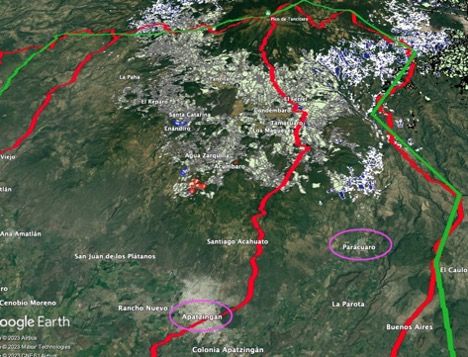
Sub-watersheds delineated in red. Aquifer delineated in green outline. Gray, green, blue and white polygons are U.S.-approved export orchards. The mountain above all the orchards is the Tancítaro Peak.
Climate Rights International interviews with officials, and news and government reports, suggest that illegal deforestation and water theft for avocado production have impacted water supplies for communities in Apatzingán and Parácuaro.
Satellite imagery shows deforestation where avocado orchards have expanded directly uphill from Parácuaro, in an area where northern Parácuaro, northern Apatzingán, and southern Tancítaro intersect. In the maps below, areas outlined in light blue are hotspots where Climate Rights International identified that deforestation has occurred, apparently for avocado orchards. (The entirety of the areas within the light blue outlines are not necessarily deforested.) The areas covered in beige or blue polygons have already been approved for U.S. export. The town of Parácuaro is at the bottom right of the map.

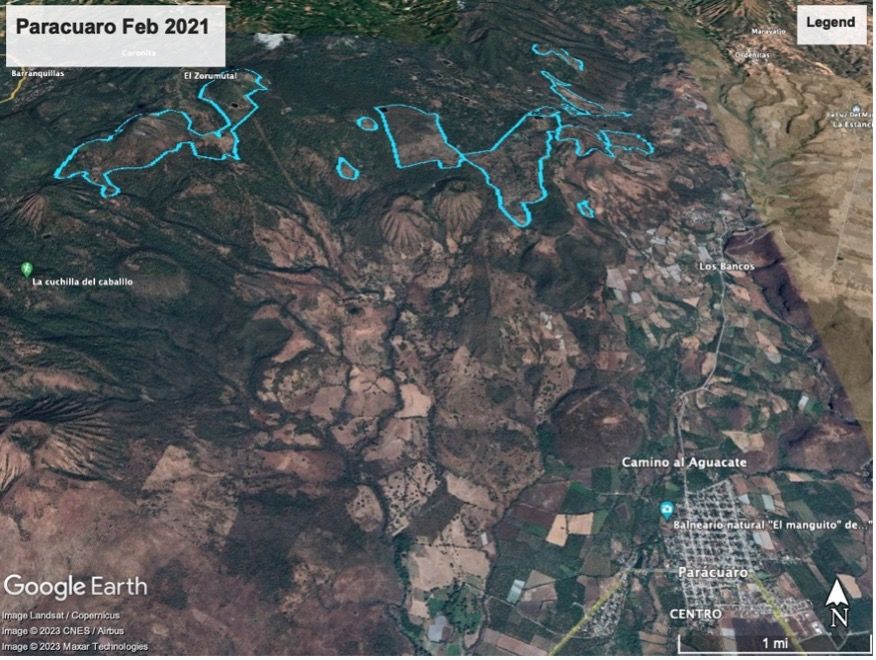
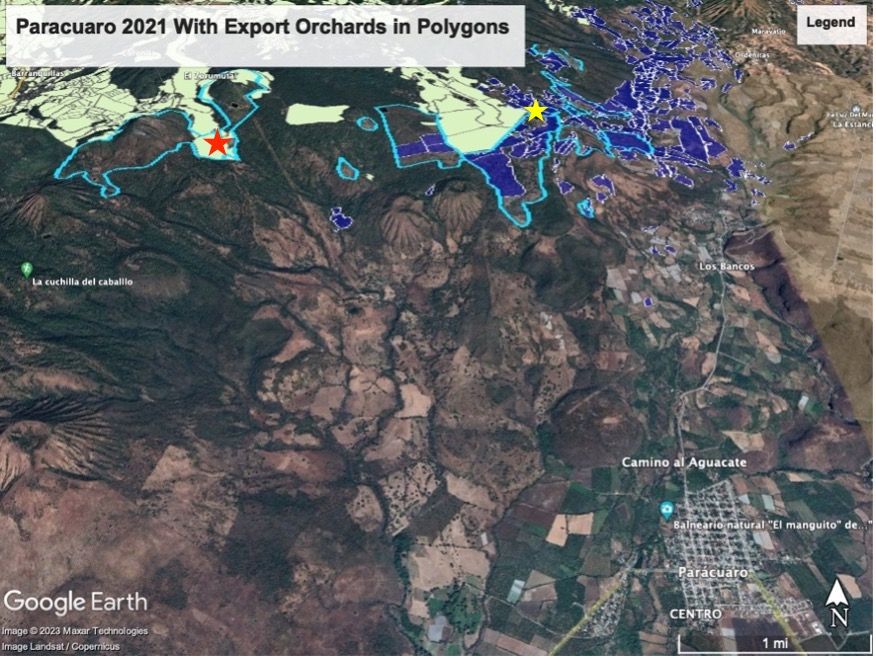
In 2022, the orchard with the red star—which Google Earth images show contains land that was deforested—principally between 2013 and 2017—supplied 29,460 kilograms of avocados to Calavo, and 19,060 to West Pak, according to government shipment records.263The orchard number is HUE08160837637. A Google Earth image from April 2023 shows a forest fire directly next to the orchard and other export-approved orchards, indicating the fire may have been for avocado expansion. The orchard with the yellow star—which contains land deforested since 2010—supplied 19,675 kilograms of avocados to Calavo in 2022, according to the records.264The orchard number is HUE08160640214.
In April 2022, a fire in southeastern Tancítaro raged for more than four days, spreading to more than 4,400 acres of vegetation—including 1074 acres of pine and oak forest—and impacting the aquifer in an area directly north of Parácuaro.265Transparency law response from COFOM to request number 160336023000002, February 7, 2023. (Data for fire 22-16-0338.) It took more than 300 firefighters and volunteers to put out the fire, according to Michoacán’s Forest Commission (COFOM).266Ibid. While the COFOM lists the cause as “unknown,” local residents said it was intentionally provoked for avocado production. The fire was at the edge of the expanding avocado frontier, surrounded by orchards, and in an area where residents had recently seen trees being cleared, and a water storage pool being installed.267CRI interviews with residents, Michoacán, 2023 (names and exact dates and locations withheld).
The potential negative effect of the fire on water supplies in Parácuaro is amplified by the fact that it overlaps with an area that an academic study classified as an important aquifer “recharge zone.”268Jesús Fuentes et al., “Ecological Ordering of the Territory: Municipality of Tancítaro, Michoacán,” (“Ordenamiento Ecológico del Territorio: Municipio de Tancítaro, Michoacán”), Center of Ecosystems Investigations, National Autonomous University of Mexico, Morelia Campus, January 10, 2010, https://docplayer.es/67770513-Ordenamiento-ecologico-del-territorio-municipio-de-Tancítaro-michoacan-fase-de-caracterizacion-informe-final.html, pp. 37-38 (accessed July 12, 2023). Recharge zones are areas where water is best able to filter below the ground and refill an aquifer, and their health is necessary for protecting groundwater supplies.
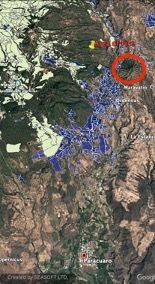
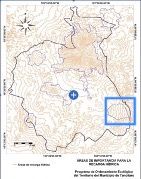
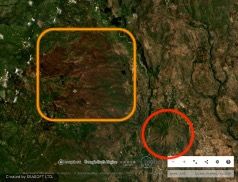

The image on the top left is from Google Earth, and shows red circle as a point of reference, in the same location as the Global Forest Watch image to the top right, from June 2022, that shows, outlined in orange, the brown earth that is the area of the fire. The map on bottom left, from the academic study, shows important aquifer recharge zones outlined in light blue.269Ibid. The map on bottom right, from Google Maps, shows that one of the recharge areas (identified with the blue square) is the area where fire was, using volcano in a red circle as reference point.
The Municipal Development Plan for Parácuaro for 2018-2021 calls attention to the negative impact that deforestation has had on the water supply, stating that “land-use change is growing at an alarming rate and that carries grave consequences such as the reduction in water in the aquifers.”270Parácuaro Municipal Government, “Parácuaro Municipal Development Plan 2018-2021,” (“Plan de Desarrollo Municipal de Parácuaro 2018-2021”), https://paracuaro.gob.mx/contenidos/paracuaro/docs/Plan_de_desarrollo_municipal_pdf_2019_9_17_201015.pdf, p. 70 (accessed July 12, 2023). The plan cites a study showing a reduction in water flow from six water springs between 1994 and 2014, ranging from a 15 percent to 100 percent reduction.271Ibid. pp. 62-63. It notes that the supply of water for agriculture is “at high risk,” with available volumes having reduced by up to 40 percent, due in part to “the indiscriminate cutting down of our forests.”272Ibid. p. 38.
An official from Parácuaro said avocado growers have, without licenses, illegally dug wells and pumped water from a river, to irrigate their orchards.273CRI telephone interview with Parácuaro, Michoacán official, May 17, 2023 (name withheld). He has personally snuck into orchards and seen wells being dug there, despite claims by the owners that they were not digging them. The official said the pumping of water from underground, and from a river—in addition to illegal deforestation for avocado production—has reduced water availability in Parácuaro. For example, the number of water springs in Parácuaro has gone down from 16 to 13, and there has been a reduction in water in the remaining springs. A spring that used to supply households in the municipal seat and nearby areas completely dried up, he said. He said that a community that used to be supplied by that spring had to dig their own well, from which they can now get water only one or two hours per day. He mentioned a different neighborhood, where water access has declined over the years due to avocado, to the point that when residents open the faucet, just a tiny amount of water comes out. Another municipal official said that avocado production is threatening to dry up even more of the municipality’s springs.274CRI telephone interview with Parácuaro, Michoacán official, May 17, 2023 (name withheld).
In recent years, local media has reported on officials raising alarm over—and residents protesting and mobilizing to stop—reductions in water in Parácuaro and Apatzingán stemming from avocado production. An August 2015 news article stated that, at a meeting with federal officials, community leaders from Apatzingán and Parácuaro said there “are outsiders who start the land-use change, by knocking down pines without authorization and planting avocado, for which they dig wells that damage the lands below, because the capture of water is reduced by up to 50 percent and the families that live there now resent the lack of water.”275“Grave Water Scarcity in the Parácuaro Region,” (“Grave escasez de agua en la región de Parácuaro”), Atiempo.mx, https://www.atiempo.mx/estado/grave-escasez-de-agua-en-la-region-de-paracuaro/ (accessed July 12, 2023). They complained that, in other properties with land use change, the owners “connect hoses to the river to irrigate their lands without any control,” and that the flow of the water is reduced, which harms the families down river. The community leaders asked for the authorities to intervene and warned that “the people are tired, and could take radical actions in this region to get attention.”276Ibid.
According to a July 2017 news report, Michoacán’s then-Secretary of Environment had indicated that “after being left without water, residents of Parácuaro decided to take up arms to rescue a spring from which avocado producers had extracted the liquid to water their orchards.”277Rebeca Hernández Marín, “They Arm Themselves in Parácuaro to Recover Water Taken by Avocado Growers,” (“Se arman en Parácuaro para recuperar agua tomada por aguacateros”), Quadratín, July 5, 2017, https://www.quadratin.com.mx/principal/se-arman-en-paracuaro-recuperar-agua-tomada-aguacateros/ (access July 12, 2023). The Secretary of Environment reportedly stated that in other areas, residents had declared their intention to recover water from uphill orchards that had dug deep wells.
Similarly, the head of Michoacán’s state water commission reportedly stated in 2017 that “a lot of water is being used for production of avocado, the liquid is not going down to the lower part of Apatzingán and many are suffering.”278Daniela Osorio Cabrera, “Avocado Orchards Provoke Water Scarcity in at Least 12 Municipalities,” (“Huertos de aguacate provocan escasez de agua en al menos 12 municipios”), El Sol de Zamora, June 19, 2017, https://www.elsoldezamora.com.mx/local/huertos-de-aguacate-provocan-escasez-de-agua-en-al-menos-12-municipios-2523496.html (accessed July 12, 2023). A senior official in Michoacán similarly told Climate Rights International that water use for avocado orchards is affecting water supply in Apatzingán and Parácuaro below.279CRI interview with environment official, Morelia, Michoacán, April 17, 2023 (name withheld).
Zapotitlán de Vadillo is a municipality south of San Gabriel, in a region with Nahua Indigenous populations. More than half of Zapotitlán’s residents self-identify as Indigenous.280National Institute of Indigenous Peoples, “Regions of the Integral Plans for Regional Development of Indigenous and Afro-Mexican Peoples and Communities By Municipality, January 2022,” (“Regiones de los planes integrales de desarrollo regional de los pueblos y comunidades indígenas y afromexicanas por municipio, enero 2022”), https://www.gob.mx/cms/uploads/attachment/file/722382/Regiones-indigenas-inpi-enero-2022.pdf (accessed August 9, 2023). A recent municipal planning document for Zapotitlán de Vadillo describes the municipality’s “inequality in the provision of the vital liquid in such a way that while there are some that have thousands of liters of water to develop productive activities such as ranching and farming, there are families and communities that lack the service for up to four months out of the year and it’s in an intermittent way.”281Zapotitlán de Vadillo Municipal Government, “Municipal Plan for Development and Governing: Zapotitlán de Vadillo 2018-2021. Vision 2023,” (“Plan Municipal de Desarrollo y Gobernanza: Zapotitlán de Vadillo 2018-2021. Visión 2030”), https://plan.jalisco.gob.mx/wp-content/uploads/2022/09/mapa/pdf2018/122.pdf, p. 17 (accessed July 12, 2023). A local NGO that surveyed water access in Zapotitlán de Vadillo in 2019 and 2022 found that several schools had no piped water.282CRI interview with NGO leader, Jalisco, 2023 (name and exact date and location withheld). Community leaders described one particularly water-scarce community where a teacher reminded parents to bathe their children before school, to which the parents responded they had no water to do so.283CRI group interview with community leaders and residents, Jalisco, 2023 (names and exact dates and locations withheld).
Communities in San Gabriel and Zapotitlan de Vadillo are supplied by water originating in the hills and the Nevado de Colima volcanic mountain, which flows in tubes downhill, passing through areas of expanding avocado orchards, before reaching the communities. Community leaders and residents said that some avocado growers have illegally diverted water from pipes flowing downhill that are intended to supply communities with water for household use. They believed that this water theft has negatively impacted the amount of piped water that arrived at homes. For example:
In one village, several residents from different households said the amount of piped water they receive has declined in recent years, and that they now experience periods of months without getting any water.287CRI group interview with residents, Jalisco, 2023 (name and exact date and location withheld). One said that she does not have enough water to wash clothes as much as she would like. She said if she had more water, she would grow food in her garden for household consumption, which would help her family’s food security. They are currently financially limited in their food choices, and usually eat two times a day, plus rice and milk at night.
Residents of another village estimated that the piped water they receive has reduced by about two-thirds since avocado orchards started expanding in the area.288CRI group interview with community leaders and residents, Jalisco, 2023 (names and exact date and location withheld). They said that in the dry season, they receive water one or two days a week.
In 2022, a resident from a different village in the area told a Mongabay reporter that avocado businesses “have provided a lot of work, but since the orchards began to grow, we live with very little water.”289Agustín del Castillo, “Avocados: The green gold that wipes western Mexico’s forests from the map,” Mongabay, https://news.mongabay.com/2023/06/avocados-the-green-gold-that-wipes-western-mexicos-forests-from-the-map/ (accessed July 12, 2023). She explained: “We’re six families in nine homes, and piped water has not arrived since they made a new well, about five months ago; before we drank from a spring and were given water once a week; but now we depend on a water tank the town provides us.”
The Jalisco government’s 2019-2024 Strategic Regional Plan for the Sierra Tapalpa region, which encompasses San Gabriel, identified “the availability of underground water” as a problem in the region, and listed “avocados” as one of the three causes.290State Government of Jalisco, “Strategic Regional Plan for the Sierra Tapalpa 2019-2024 Vision 2030,” (“Plan Estratégico Regional Sierra de Tapalpa 2019-2024 Visión 2030”) https://plan.jalisco.gob.mx/wp-content/uploads/2022/10/PlanEstrategicoSierraTapalpa_web.pdf p. 98 (accessed July 12, 2023).
Climate Rights International collected similar testimony of water shortages in other areas of the avocado region as well. In the municipality of Madero, for example, as detailed in the water theft section above, the residents of several different communities said that illegal deforestation and water theft by avocado growers had caused a reduction in water supplied from the springs that they rely on to cover their water needs.291CRI interviews with residents, Madero, Michoacán, 2023 (names and exact dates withheld). An environmental activist in Madero described the avocado orchards’ impact on water as follows:
People in this area have traditionally been able to get water from the streams for their animals – goats, cows or sheep. They can’t find water anymore, sometimes even for themselves, and now they have to haul it in pickup trucks or on foot or with horses.292Mark Stevenson, “Mexican town protects forest from avocado growers, cartels,” Associated Press.
In Tancítaro, also discussed in the water theft section, local residents said that, about two years ago, their village started rationing water, turning it off between 7pm and 7am. This has had a particularly hard impact on mothers who work outside the house during the day and thus are not at home when there is access to water.293CRI personnel visited a water line that, according to residents, is supposed to take water for domestic consumption in that village, but instead has multiple tubes diverting water for avocado orchards. The apparent diverting of water intended for the village for orchards, combined with the recent rationing, creates a strong inference that avocado production could be diminishing access to water for human consumption in the village.
In 2017, dozens of residents from six localities in the municipality of Morelia sent a letter to the state environmental inspector expressing “concern over the installation of deep wells and dams that have proliferated in the last 10 years around us, causing a reduction and loss in the springs and above-ground water that supply us for human consumption and traditional activities. These wells and dams have been installed to take water to large water storing pools that are used to irrigate extensive avocado orchards.”294Letter from dozens of residents to Juan Carlos Vega Solórzano, then-Michoacán state environmental inspector, received October 3, 2017.
The letter asked the authorities to address the problem, to ensure compliance with the law “and the protection of the human right that thousands of us residents who live in these places have and who already lack water during the dry seasons.”
In addition to affecting the specific communities examined in this report, it is likely that the deforestation and water capture for avocado production have contributed to the broader problems of water supply availability and household access affecting avocado-growing regions of Michoacán and Jalisco, given the amount of water being consumed, and the pervasiveness of the deforestation and water theft.
Michoacán and Jalisco are already drought-prone. CONAGUA’s map of the “probability of threat of drought”—based on drought data between 2003 and 2020—shows most of Michoacán, including the avocado growing region, at a “high” risk of drought.295CONAGUA, “Map of Probability of Drought Threat.” The avocado growing regions in Jalisco are labeled as either medium or high risk. CONAGUA classified large swaths of Michoacán and Jalisco, including avocado-growing areas, as experiencing “extreme” or “severe” drought as of June 30, 2023.296CONAGUA, “Mexico Drought Monitor to June 30, 2023.”
The IPCC reports that continued global warming will likely make the problem worse. It projects increased drought and aridity in the region of “North Central America,” where Michoacán and Jalisco are located.297IPCC Working Group I, “Climate Change 2021: The Physical Science Basis,” 2021, https://www.ipcc.ch/report/sixth-assessment-report-working-group-i/, p. 126 (showing high confidence in increase of mean temperature, extreme heat; heavy precipitation and pluvial flood; aridity; fire weather; and medium confidence of increased agricultural drought at global warming of 2.0-2.4 degrees Celsius). Furthermore, the Mexican National Institute of Ecology and Climate Change (INECCC)’s Atlas on Climate Vulnerability shows decreased precipitation and increased temperatures with ongoing global warming in both Jalisco and Michoacán. INECC, https://atlasvulnerabilidad.inecc.gob.mx/page/Proyecciones/P_16.html (accessed July 13, 2023). By threatening water supplies for human consumption,298IPCC Working Group II, “Climate Change 2022: Impacts, Adaptation and Vulnerability,” 2022, https://report.ipcc.ch/ar6/wg2/IPCC_AR6_WGII_FullReport.pdf, p. 1954 (accessed September 13, 2023) (noting that in North America, warming-related drought amplification risks reducing water availability for human uses). increasing droughts pose a risk to the human right to water.
In light of this foreseeable climate change impact, a “key” adaptation strategy should be “[p]reserving and protecting aquifers,” because they are “strategic reserves to manage droughts,” according to the UN Special Rapporteur on the human right to water and sanitation.299UN Commission on Human Rights, Special thematic report on climate change the human rights to water and sanitation by the Special Rapporteur on the human rights to safe drinking water and sanitation, Part 3, para. 19. But, as elaborated above, deforestation and massive, often illegal water use by avocado growers is undermining the government’s efforts to do so.
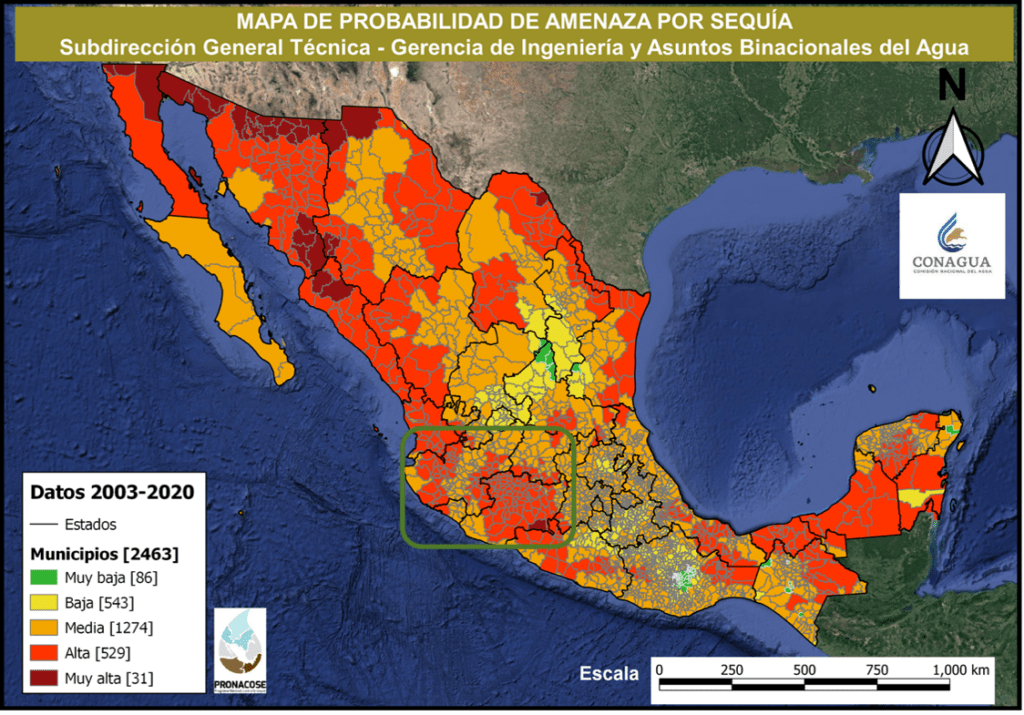
CONAGUA map of threat of drought in Mexico. Michoacán and Jalisco in the green rectangle.300CONAGUA, “Map of Probability of Drought Threat.”
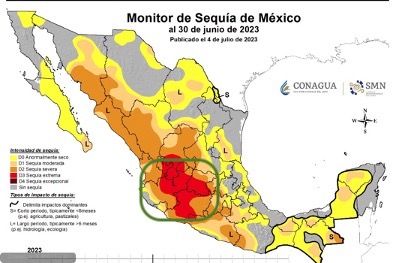
Droughts in Mexico the week of June 30, 2023. Michoacán and Jalisco in green rectangle.301CONAGUA, “Mexico Drought Monitor to June 30, 2023.”.
Deforestation and forest fires for avocado production can increase the risk of life-threatening floods and landslides,302CRI interview with disaster expert, Morelia, Michoacán, January 17, 2023. as exemplified by the flash flood that killed five people in San Gabriel, Jalisco, in 2019. The unregulated expansion of water storage pools containing vast quantities of water for irrigation also poses a risk of flooding to downhill communities if they break.
Deforestation and forest fires can increase the risks of floods and landslides for a number of reasons, including by increasing runoff, clogging riverways, and loosening soil.
The IPCC has stated that “upstream forest ecosystems reduce flood risk by storing water and slowing water flow, in most circumstances,” and that human-caused land-use changes such as deforestation can reduce water infiltration, “leading to frequent flooding.”303IPCC Working Group II, “Climate Change 2022: Impacts, Adaptation and Vulnerability,” 2022, pp. 278, 663. The IPCC has also highlighted the link between forest fires and flooding and landslide hazards: “Wildfires increase impacts of extreme precipitation due to climate change, which contribute to increased surface runoff and hence increased risks of land erosion, landslides and flooding.”304Ibid., p. 278; see also “Binbin V. Li, Clinton N. Jenkins, and Weihua Xu, “Strategic protection of landslide vulnerable mountains for biodiversity conservation under land-cover and climate change impacts,” PNAS, 2022, https://doi.org/10.1073/pnas.21134161 (accessed July 12, 2023).
Mexican authorities have similarly flagged these risks. Mexico’s National Center for Disaster Prevention (CENAPRED) warns:
The deforestation and fires cause the loss of vegetation, and consequently, the resistance that roots provide to the surface level of the soil. When a change in vegetation occurs, it’s feasible that rains detonate slides and flows of mud, rocks, debris, which endanger communities located in or near the riverbeds and ravines.305CENAPRED, “Socioeconomic Impact of the Principal Disasters that Occurred in Mexico,” p. 40. CENAPRED issued the following warning after a flash flood killed five people in San Gabriel, Jalisco in 2019: “Deforestation is an important factor in the development of floods[.] Avoid excessive tree clearing in high zones.” CENAPRED, “Rapid Runoff in the Mountain Zone of San Gabriel, Jalisco,” (“Escurrimientos súbitos en la zona serrana de San Gabriel, Jalisco”), June 3, 2019, https://www.gob.mx/cenapred/articulos/escurrimientos-subitos-en-la-zona-serrana-de-san-gabriel-jalisco (accessed July 12, 2023).
Both Michoacán and Jalisco authorities have cautioned that deforestation—including specifically for avocados—increases landslide risks. In 2021, the then-Secretary of Environment for Michoacán reportedly stated that landslide “risk zones are those where there has been deforestation, where the natural container of soils has been lost.”306Miriam Hernández, “Deforestation Increases Risk of Landslides in Michoacán,” (“Deforestación aumenta riesgo de deslaves en Michoacán”), El Sol de Morelia, June 29, 2021, https://www.elsoldemorelia.com.mx/local/deforestacion-aumenta-riesgo-de-deslaves-en-michoacan-6903950.html (accessed July 12, 2023). The press also reported previous statements by the then-secretary linking landslides and floods to land-use change, and as saying “you can’t take down [forest] to introduce other systems like avocados, berries, cattle ranching or irregular settlements.” César Velázquez, “Land-Use Change Factor in Natural Disasters Suffered in Michoacán: SEMACCDET,” (“Cambio de uso de suelo factor en desastres naturales sufridos en Michoacán: SEMACCDET”), September 27, 2018, https://cbtelevision.com.mx/cambio-de-uso-de-suelo-factor-en-desastres-naturales-sufridos-en-michoacan-semaccdet/ (accessed July 12, 2023). In Jalisco, the government’s “Territorial Ordering” plan for the Sierra de Tapalpa region asserts that land-use change for avocado, potatoes and ranching has increased landslides, and that San Gabriel in particular “has suffered a constant land use change due to agriculture, specifically avocado crops,” a practice that has “increased the risk of landsides that affect principally the lower and flatter parts where a large part of the population is concentrated.”307State Government of Jalisco, “Territorial Ordering of the Region Denominated ‘Tapalpa,’” (“Ordenamiento territorial de la región denominada ‘Tapalpa’”), October 6, 2021, https://periodicooficial.jalisco.gob.mx/sites/periodicooficial.jalisco.gob.mx/files/11-20-2i-viii_0.pdf pp. 16, 53 (accessed July 12, 2023).
An academic study of a 2018 flash flood in the avocado-growing area of Peribán, Michoacán—which killed eight people—concluded that the area’s lowlands, and the broader avocado growing region surrounding the Tancítaro volcano, could “be exposed to intense and more frequent flood events, due to the persistent loss of natural vegetation cover.”308R. Vásquez et al., “Numerical modelling of a flash-flood event at Peribán de Ramos, Michoacán Mexico,” Physical Geography (2023), https://doi.org/10.1080/02723646.2022.2163539, p. 20 (accessed September 14, 2023).
Municipal officials in Zapotlán el Grande, Jalisco, told Climate Rights International that land-use change has led to flooding that has impacted the livelihoods of small-scale farmers.309CRI interviews with Zapotlán el Grande officials, Ciudad Guzman, Jalisco, March 17, 2023 (names withheld). Specifically, they said deforestation for avocado and raspberries in the mountains surrounding the municipal seat of Ciudad Guzman has caused eroded soil and sediment to run off and settle in Lake Zapotlán, leading to a significantly expanded floodplain over the past 10 years. Now, during the rainy season, some 1,900 acres surrounding the lake flood. This flooding has impacted some 170 agricultural producers, including about 60 to 70 percent who are small-scale farmers and can no longer produce there, they said.310See Appendix D, for images of deforestation in Zapotlán el Grande.
Climate change will likely amplify the increased flooding and landslide risks caused by avocado-linked deforestation and forest fires. The IPCC projects that when it does rain, there will be an increase in heavy precipitation311IPCC Working Group I, “Climate Change 2021: The Physical Science Basis,” p. 126.—a global phenomenon stemming from warmer air holding more water vapor.312Ibid., p. 1156. The heavier rain will likely increase the risks of rain-induced floods and landslides in the mountainous areas of Michoacán and Jalisco where the expansion of avocado production is mostly taking place.313Ibid., p. 126; IPCC Working Group II, “Climate Change 2022: Impacts, Adaptation and Vulnerability,” pp. 2276, 2292, 2301. Thus, as in the case of droughts, illegal environmental degradation by avocado producers undermines populations’ abilities to adapt to the projected consequences of climate change, and increases their risk of life-threatening floods and landslides.
Climate Rights International found evidence linking avocado expansion to deforestation and forest fires that authorities have identified as central causes of the June 2, 2019, flash flood in San Gabriel, Jalisco that killed five people.
In the years prior to the flood, the mountains in the high part of the sub-watershed surrounding the town of San Gabriel had endured “intense deforestation,” and in the month before the disaster, forest fires had consumed thousands of acres, according to authorities.314CENAPRED, “Socioeconomic Impact of the Principal Disasters that Occurred in Mexico,” p. 41; Complaint filed by Jalisco Secretary of Environment and Territorial Development and other authorities with the PROFEPA, February 28, 2022, p. 3., obtained via transparency law. A complaint filed by top state officials with PROFEPA alleged that, “the principal factor for the disaster was the accumulation of abundant dead vegetative material in the high parts of the watershed that resulted from illegal tree clearing, land-use change and forest fires.”315Complaint filed by Jalisco Secretary of Environment and Territorial Development and other authorities with the PROFEPA, February 28, 2022, p. 2. The complaint singles out a May 5, 2019 forest fire that burned more than 12,000 acres in the watershed above San Gabriel. As the complaint explains, the reduced infiltration capacity of the soil and increased runoff, combined with the dragging of vegetation and ashes to—and thus obstruction of—the riverbeds, generated an increase in the volume and velocity of river flows that led to the flood.316Ibid., pp. 2-3.
Mexico’s federal CENAPRED similarly concluded that the principal causes of the flow of debris and mud were intense rain combined with “the forest fires in the beginning of May 2019” and “the deforestation caused for land-use change in the mountains of San Gabriel,” where avocado plants are “proliferating in a concerning way.”317CENAPRED, “Socioeconomic Impact of the Principal Disasters that Occurred in Mexico,” p. 53.
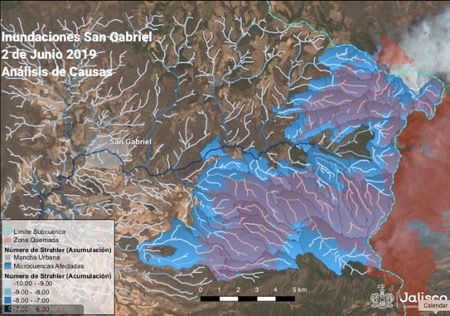
A map produced by Jalisco authorities as part of their analysis of the causes of the disaster that shows, in red, areas affected by May 2019 fires, and in blue, the parts of the sub-water sheds affected by the fires. The dotted blue line is the limit of the sub-watershed within which the town of San Gabriel—pictured in the left side of the map—is located.318Transparency law response from Jalisco’s Coordination of Management of the Territory (Coordinación de Gestión del Territorio) in response to appeal 2001/2023, May 23, 2023.
The satellite imagery below indicates that, prior to the flooding, avocado expansion caused deforestation in mountainous areas higher up in San Gabriel’s watershed, which officials identified to be a cause of the disaster. The images show a portion of the area uphill from San Gabriel, in the same sub-watershed, which is denoted by the green line. (The town of San Gabriel is to the bottom left of the frame.) The sequence shows deforestation between 2003 and May 2019. Climate Rights International drew the purple outlines and orange circles to identify areas that were deforested between October 2003 and May 2019 and either now have government-registered avocado orchards (denoted with a red pin with a “T”) or strongly appear to have avocado plantings, based on zoomed-in satellite imagery.319Only some of the government-registered orchards have been certified for export. Data points of orchards from transparency law response from SENASICA to request number 330028322000809, October 31, 2022. (Deforestation between October 2003 and 2017 is outlined in purple, and deforestation between 2017 and May 2019 is in orange circles in the bottom image.)

October 2003, Google Earth

April-December 2017, Google Earth
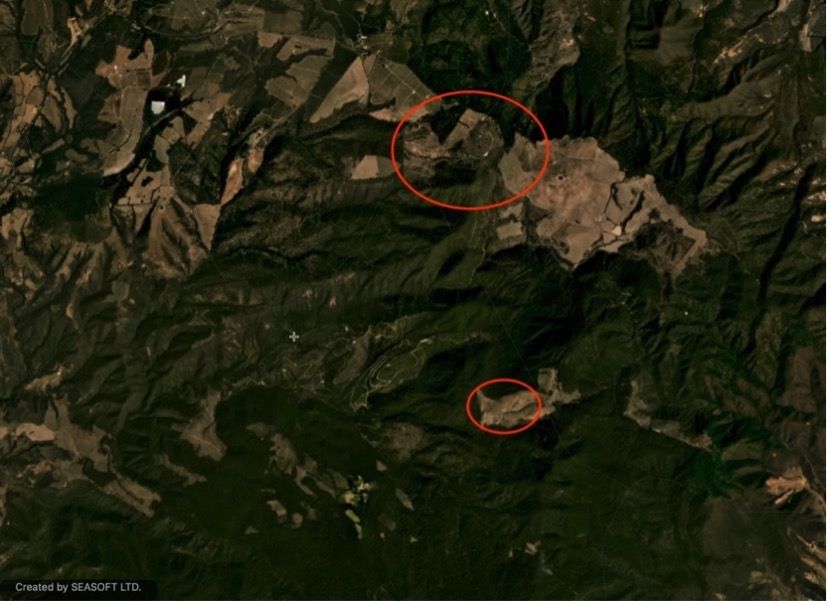
December 2018-May 2019, (Global Forest Watch)
Statements by public officials after the flood also pointed to a connection between avocado orchards and the deforestation that had contributed to the disaster. The month after the disaster, and apparently in response to public outcry, state officials announced the filing of a complaint to PROFEPA denouncing 3,885 acres of land-use change across San Gabriel and 12 other Jalisco municipalities for agricultural activities, including avocado production.320State Government of Jalisco, “Government of Jalisco Denounces Illegal Land Use Change to Federal Authority.” The complaint highlighted the expansion of avocado crops in recent years, and asserted that “an important part” of the growth “presumably occurred illegally in forest ecosystems.”321Complaint filed by the Secretary of Government of Jalisco, General Strategic Security Coordinator of Jalisco, Secretary of Agriculture and Rural Development of Jalisco, and Secretary of Environment and Territorial Development of Jalisco, with PROFEPA, July 30, 2019, p. 2, obtained through transparency law response by Jalisco’s Coordination of Territorial Management to request number 142042123005004.
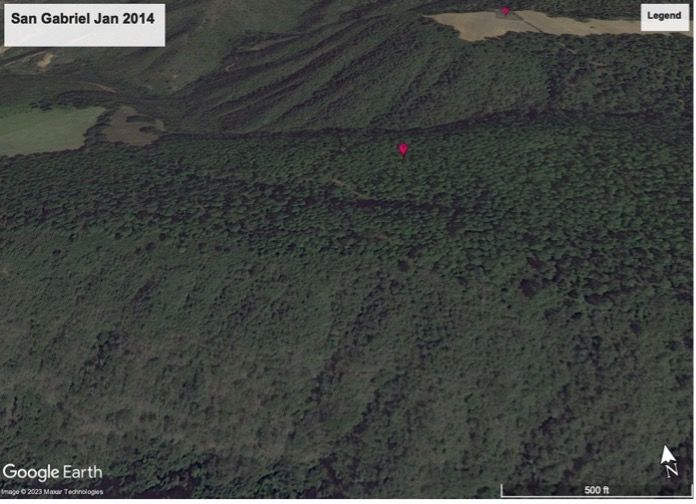

Google Earth images of an 86-acre plot of land in San Gabriel, in the sub-watershed above the town, which was deforested between 2014 and 2017. It is now a government-registered avocado orchard, as indicated by the red pin, showing the GPS location of such orchards.
There is strong indication that at least some of the May 2019 fires—identified by authorities as a cause of the disaster—were intentionally set, likely to install avocado orchards.
As discussed in chapter 2, avocado growers commonly use intentional fires to expand the avocado frontier. Map B below shows that the May 2019 fires occurred at the edges of the avocado-growing frontier. One person who was an official at the time of the fires said that an official flying over them in a helicopter could see people intentionally igniting them, and that the fires were presumably for avocado.322 CRI interview with official at time of fires, 2023 (name, location, and exact date withheld). Another said it was highly probable that the fires were intended to clear land for avocado orchards.323CRI interview with official at time of fires, 2023 (name, location, and exact date withheld).
Orchards were subsequently installed in some of the areas where the May 2019 fires occurred. Maps C through F below show that in the mountainous areas above San Gabriel, in the same sub-watershed, heat points detected by Mexico’s Fire Alert System in May 2019 coincide with many areas that were later converted to avocado orchards.
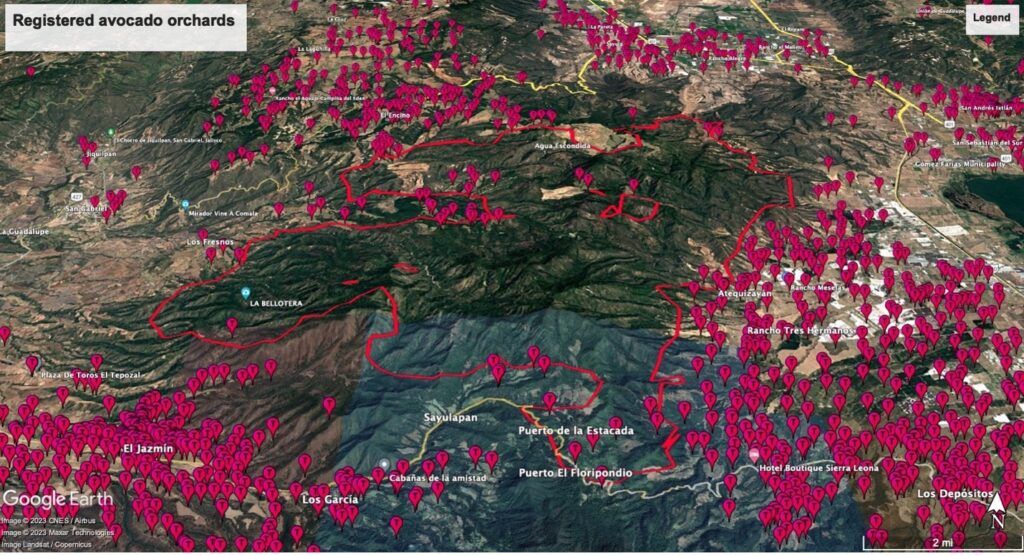
Map B: The “T” pins are government-registered avocado orchards as of October 2022.324Transparency law response from SENASICA to request number 330028322000809, October 31, 2022. The red outline is a rough approximation of the surface areas of fires in May 2019 produced by the Forest Fire Danger Prediction System of Mexico.325CONAFOR and National Council of Science and Technology (Consejo Nacional de Ciencia y Tecnologia, CONACYT), “Forest Fire Danger Prediction System of Mexico,” (Sistema de Predicción de Peligro de Incendios Forestales), http://forestales.ujed.mx/incendios2 (accessed September 14, 2023). The data shows the perimeter of historical “conglomerations” of “forest heat points” detected by satellite. The map thus shows that the fires were at the edge of the avocado frontier.

Map C: Google Earth satellite image. Town of San Gabriel middle-left; sub-watershed outlined in green; purple star is reference for other maps.

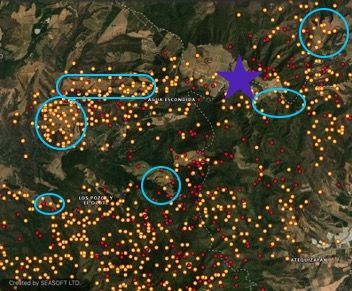
Map E: zoom in of Map D, which has satellite imagery from approximately 2022. The light blue outlines show areas where post-May 2019 avocado expansion overlapped with May 2019 heat points detected by CONABIO’s Fire Early Warning System. That the orchards appeared after May 2019 is evident when comparing to Map F below, which shows satellite imagery for the same area for December 2018-May 2019.

Map F: Global Forest Watch satellite imagery for the same area in December 2018-May 2019.
The two Google Earth images below, from January 2020 and 2023, show the unabated deforestation for avocado production in the sub-watershed above San Gabriel, even though authorities recognized after the June 2019 disaster that the deforestation increases the risk of another catastrophe.
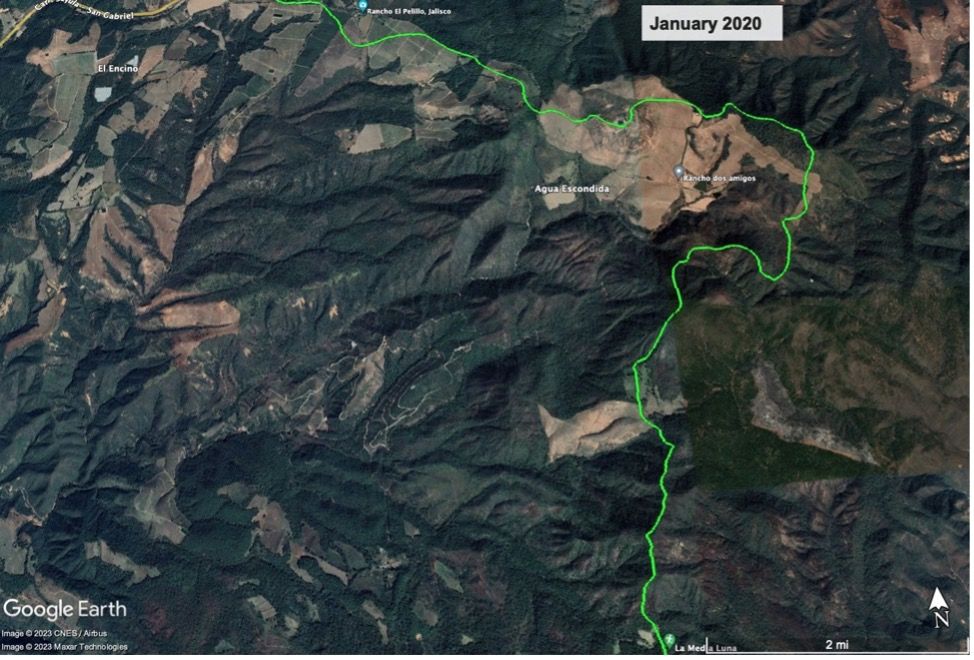
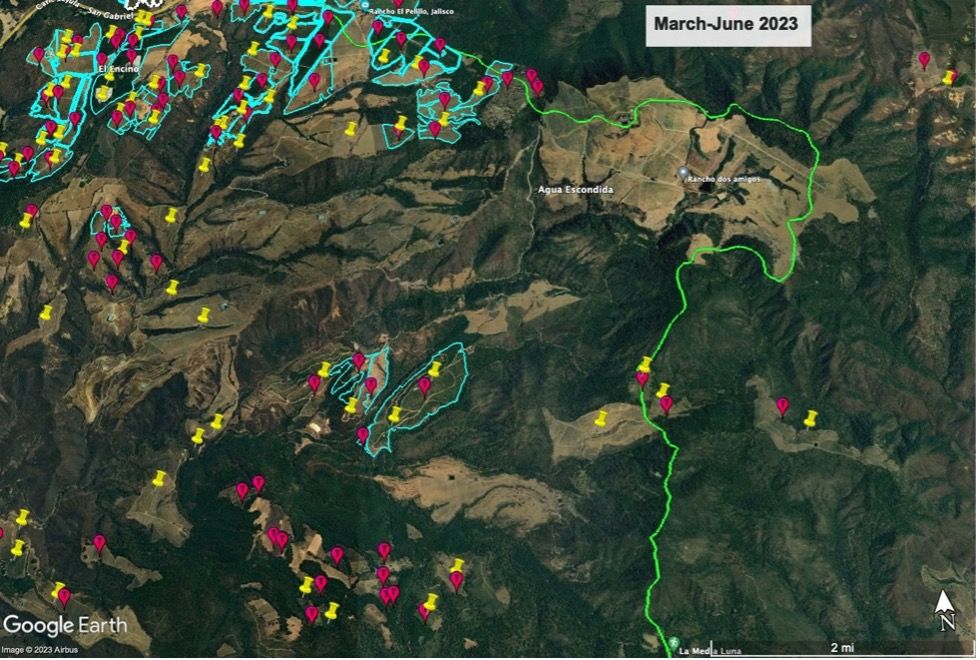
Yellow pins are where the Jalisco SEMADET identified deforestation for avocado production at some point between 2003 and the first quarter of 2022; the red pins with a “T” are government registered avocado orchards as of October 2022; and the blue polygons show orchards certified to export to the United States as of January 2023.
As noted above, a recent study by Michoacán’s Forest Commission of just four avocado-growing municipalities in the state identified 6,872 water storage pools capable of storing nearly 5,000 Olympic pools worth of water. In March 2023, the head of Michoacán’s state water commission estimated that there could be more than 20,000 water storage pools (ollas) in the state.327Dalia Villegas Moreno, “Without Regulation, 20 Thousand Water Ollas For Agricultural Irrigation in Michoacán,” (“Sin regular, 20 mil ollas de agua para riego agrícola en Michoacán,”) Quadratin, March 12, 2023, https://www.quadratin.com.mx/principal/sin-regular-20-mil-ollas-de-agua-para-riego-agricola-en-michoacan/ (accessed August 22, 2023). In 2022, a study by academics found 2,900 water ollas in Tancítaro alone. Gerardo Ruíz-Sevilla et al., “Estimate of Water Dammed for Irrigating Avocado Orchards Using Geographic Information Systems,” p. 4. He noted that there’s no law that regulates the pools, and that they “capture water and don’t let it arrive where it should be going, [and] in some way are robbing the water.”
In addition to impacting water supplies, the unregulated proliferation of thousands of water storage pools for irrigating avocado orchards also creates flood risks.
Mexico’s CENAPRED observed that, in San Gabriel, if water storage pools are constructed without engineering supervision, they could collapse and flow into a nearby river, causing it to overflow and flood the town of San Gabriel, with disastrous consequences.328CENAPRED, “Socioeconomic Impact of the Principal Disasters that Occurred in Mexico,” p. 55.
In Zapotlán el Grande, Jalisco in October 2022, a water storage pool with 12 thousand liters overflowed, causing mud and water to pour into Ciudad Guzman, dragging cars and flooding some businesses, according to municipal officials. The flooding rendered inoperative for three weeks a water treatment plant covering 30 percent of the city, meaning that the water was dumped untreated into Lake Zapotlán.329CRI interviews with Zapotlán el Grande officials, Ciudad Guzman, Jalisco, March 17, 2023 (names withheld).
A Michoacán resident said that around 2016, an enormous water storage pool located in an orchard on a hill above their village broke. The water flowed into a river, causing it to overflow, with the flooding almost reaching the community’s homes. They said community members are afraid they could die in another flood, and asked the grower not to refill the water storage pool, but he did anyway.330CRI interview with resident, Michoacán, 2023 (name and exact location and date withheld). Satellite imagery from 2022 shows several water storage pools—with a combined surface area of around 134,000 square feet—in an area of orchards on the hill right above the community.
Over the course of seven months, Climate Rights International visited more than 25 communities in 16 municipalities in Michoacán and Jalisco—all but three of which are certified to export avocado to the United States—as well as the state capitals, Morelia and Guadalajara. We interviewed more than 100 residents of these communities (in person) and other avocado-producing areas in Michoacán and Jalisco (by phone or outside their communities), as well as dozens of officials in the two states. Throughout these communities, we encountered a widespread fear that by taking action to defend the environment—and defend their rights—they would put themselves in danger. Many even believed that calling out the environmental crimes linked to avocado production could cost them their lives.
In some places we visited, the fear was palpable. Several people declined to be interviewed for security reasons, including one previously threatened person, who explained that they had to look out for their family’s safety. In multiple communities, residents said it was too dangerous to take Climate Rights International to certain orchards and sites of deforestation or water theft, due to fear of reprisals or the possible presence of armed men. Climate Rights International had to cancel a planned trip with activists to visit an area with deforested orchards in Madero, because heavily armed men, presumably belonging to an organized crime group, had just been seen on the road to the area.331There is no indication the armed men’s presence had anything to do with CRI’s planned trip, but their mere presence was viewed by the local activists as too much of a danger to complete the visit to document the deforestation.
This fear is rooted in the recent history of violence and organized crime in the region. For more than a decade, brutal drug cartels have terrorized the populations of Michoacán and Jalisco. Today, in both states, the Jalisco New Generation Cartel (CNGJ)—one of Mexico’s most feared criminal organizations—have a dominant presence, with many other smaller criminal groups vying for territory in Michoacán.
The fear is also rooted in the common knowledge that organized crime is linked to parts of the avocado sector on multiple levels, as discussed below. These links mean that anyone who tries to stop illegal deforestation and water theft by avocado producers risks running afoul of a criminal group, with potentially grave consequences.
Above all, the fear has been fueled by widespread acts of violence and intimidation linked to avocado production. Climate Rights International documented more than 30 threats or other acts of intimidation, four abductions, and six shootings (five fatal) that have occurred in Michoacán or Jalisco since 2019 in connection with avocado expansion, many of them reactions to people’s efforts to safeguard forests and water supplies.
Impunity is common for these abuses, and for violence more generally in Michoacán and Jalisco.332CRI submitted a transparency law request to the Michoacán’s State Prosecutor’s Office about the status of investigations into shootings and abductions documented in this report, and the office responded that it could not disclose the information to non-parties to the cases. Michoacán State Prosecutor’s Office’s response to transparency law request number 162155723000390, June 13, 2023. However, interviews with victims and others with direct knowledge of the cases indicate that few if any of the perpetrators of the violence and acts of intimidation documented in the report have been brought to justice. And official statistics show rampant impunity for violence crimes in Michoacán and Jalisco more generally. See, e.g., “100% of Disappearances and Kidnappings in Jalisco in Impunity,” (“Impunes, el 100% de desapariciones y secuestros en Jalisco,”) México Evalúa, November 22, 2022, https://www.mexicoevalua.org/impunes-el-100-de-desapariciones-y-secuestros-en-jalisco/ (accessed September 19, 2023); Juan Antonio Le Clercq Ortega et al,, “Global Index of Impunity Mexico 2022,” (“Indice Global de Impunidad México 2022,”), Universidad de las Américas Puebla (2022), https://www.udlap.mx/cesij/files/indices-globales/IGI-MEX-2022-UDLAP.pdf (accessed September 19, 2023). The lack of credible investigations makes it impossible to be certain, in most cases, who committed the crime and why—including, in particular, whether organized crime was involved, or whether the motive was indeed related to avocado expansion. Yet the evidence pointing to organized crime’s involvement in many of the cases—and organized crime’s often-flagrant connection to environmental degradation for avocado production—fully justify the fear shared by local residents and officials alike that fighting illegal deforestation and water theft linked to avocado production is exceedingly dangerous.
This fear has a powerful deterrent effect on local efforts to defend forests and water supplies, and reinforces the need for urgent action to be taken—not only by the Mexican government but also the U.S. government, and the corporations that are purchasing avocados from the businesses linked to these environmental and human rights harms.
Michoacán and Jalisco are both epicenters of drug trafficking, organized crime, and violence in Mexico. Between 2000 and 2013 the dominant cartels in Michoacán evolved from the Gulf Cartel and Zetas, to the Michoacán Family Cartel, to the Knights Templar Cartel.333Romain Le Cour Grandmaison, “Ten Years of Vigilantes: The Mexican Autodefensas,” Global Initiative Against Transnational Organized Crime, March 2023, https://globalinitiative.net/wp-content/uploads/2023/03/Romain-Le-Cour-Grandmaison-Ten-years-of-vigilantes-The-Mexican-autodefensas-GI-TOC-March-2023.pdf, pp. 2-4, and 7-8 (accessed July 20, 2023). In 2013, armed vigilante groups, called autodefensas, or “self-defense groups,” rose up in the state to oust the Knights Templar, in a conflict that lasted until 2015. The conflict led to the emergence of multiple smaller criminal groups in the state, some of whom reportedly formed a loose coalition, also including former self-defense groups, under the banner of United Cartels (Cárteles Unidos).334Ibid.
These smaller local groups have competed with the Jalisco New Generation Cartel (CJNG), one of Mexico’s biggest and most feared drug-trafficking organizations, which the U.S. Department of the Treasury recently described as responsible “for a significant proportion of the fentanyl and other deadly drugs trafficked into the United States.”335U.S. Department of the Treasury, “Treasury Sanctions Individuals Linked to CJNG’s Arms Trafficking, Fuel Theft, and Money Laundering,” June 6, 2023, https://home.treasury.gov/news/press-releases/jy1523 (accessed July 20, 2023). The CJNG’s power has grown in Michoacán in recent years, and the cartel maintains a hegemonic presence in Jalisco.
The organized crime groups, ranging from smaller local gangs to the CJNG, are involved in a variety of economic activities, depending on their location, size, and sophistication, including drug trafficking, illegal logging, and extortion of businesses. They have routinely engaged in killings, disappearances, kidnappings, and public displays of extreme violence. In August 2019, 19 mutilated corpses, including nine hung half-naked from a bridge, appeared in Uruapan, a hub of avocado production and packinghouses in Michoacán. Three years later, authorities reportedly announced finding 12 more bodies in three hidden graves in an avocado orchard and nearby properties in Uruapan.336Pedro Zamora Briseño, “12 buried bodies found in an avocado orchard in Caltzontzin, Michoacán,” (“Hallan 12 cuerpos enterrados en una huerta de aguacate en Caltzontzin, Michoacán”), Proceso, August 4, 2022, https://www.proceso.com.mx/nacional/estados/2022/8/4/hallan-12-cuerpos-enterrados-en-una-huerta-de-aguacate-en-caltzontzin-michoacan-290940.html (accessed July 13, 2023). In January 2023, two well-known Michoacán community activists were disappeared on the Pacific coast.337Maria Verza, “Search for missing activists intensifies in western Mexico,” AP, January 19, 2023, https://apnews.com/article/politics-caribbean-mexico-73ae311b2a4420c02364e2d3388a4c66 (accessed July 20, 2023). A few months later, authorities discovered 45 bags of human remains in a ravine outside of Jalisco’s capital.338“Mexican prosecutors say 45 bags of human remains may belong to missing group,” Reuters, June 2, 2023, https://www.reuters.com/world/americas/mexican-prosecutors-say-45-bags-human-remains-may-be-linked-missing-group-2023-06-02/ (accessed July 20, 2023).
In 2022, Michoacán registered 50 victims of intentional homicides per 100,000 inhabitants—more than double the national rate.339Executive Secretariate of National System of Public Security, “Statistics of crimes and victims per 100 thousand residents 2015-2023” (“Cifras de delitos y víctimas por cada 100 mil habitants 2015-2023”), https://drive.google.com/file/d/1gFVHSg6MM6tgobUN_Qu7y8uZLc6grXjh/view (accessed September 19, 2023). Michoacán is one of six Mexican states on the U.S. State Department’s “do not travel” list, and Jalisco is on its “reconsider travel” list.340U.S. Department of State, “Mexico Travel Advisory,” August 22, 2023, https://travel.state.gov/content/travel/en/traveladvisories/traveladvisories/mexico-travel-advisory.html (accessed September 14, 2023).
The drug cartels and other organized crime groups have sought to profit from the expansion of avocado production in both states. The PROFEPA office in Jalisco told Climate Rights International that due to the high profits in the avocado business, “criminal groups are widely linked to” avocado production, including through their involvement in illegal deforestation.341Written response to CRI’s written questions provided by Jalisco PROFEPA delegation on March 20, 2023. In addition to clearing forests for avocado production, multiple federal and state officials told Climate Rights International about organized crime engaging with elements of the avocado industry in other ways, such as acquiring ownership of orchards, and extorting avocado businesses.342CRI group interview with SEMARNAT officials, Mexico City, March 21, 2023; CRI interviews with environmental officials, Morelia, Michoacán, December 15 and 16, 2022 (names withheld).
Organized crime is involved in much of the illegal logging that takes place in Michoacán and Jalisco, including deforestation aimed at clearing land for avocado orchards, according to multiple federal and state officials who spoke with Climate Rights International.343CRI interviews with environmental officials, Morelia, Michoacán, December 15 and 16, 2022 (names withheld); written response to CRI’s written questions provided by Jalisco PROFEPA delegation on March 20, 2023.
In a statement accompanying an anti-logging bill sent to Congress in February 2023, the administration of President Andrés Manuel López Obrador observed “organized crime groups have diversified their sources of income to activities beyond drug trafficking, one of them, the sale of wood”; that they are responsible for “devastation of large forest masses”; and that they provoke land-use change “through violence.”344Chamber of Deputies, “Parliamentary Gazette,” (“Gaceta Parlamentaria”), Number 6224-III, February 28, 2023, http://gaceta.diputados.gob.mx/PDF/65/2023/feb/20230228-III.pdf (accessed July 13, 2023).
Local residents also told Climate Rights International that they believe—based on their personal experiences, including interactions with members of criminal groups—that organized crime is often involved in deforestation for orchards. In one area of Michoacán, for example, a local organized crime leader told the community not to interfere with the removal of illegally cut wood from the forests where avocado orchards were expanding.345CRI group interview with residents, Michoacán, 2023 (names and exact date and location of interview withheld). Elsewhere, residents have reported seeing armed men present at sites where deforestation for orchards was taking place, and transporting illegally logged wood in avocado-expansion areas.346CRI interviews with residents in Michoacán, 2022 and 2023 (names and exact dates and locations withheld).
For example, one man in Michoacán recounted seeing heavily armed men guarding trees being cut down on a site where, three years later, an avocado orchard had been established.347CRI interview with resident, Michoacán, December 2022 (name and exact date and location withheld). Residents of another area of Michoacán said that an acquaintance who had participated in clearing a large tract of forest for an avocado orchard had told them that there were “soldiers”— presumably armed, uniformed men—guarding the area when they cut down the trees.348CRI interview with residents, Michoacán, 2023 (names and exact date and location withheld).
Locals’ testimonies describe a dynamic of avocado growers utilizing organized crime to clear forests for them. In Madero, Michoacán, residents said that organized crime has been involved in clearing forests for orchard owners, and keeps the valuable wood to sell.349CRI interviews with Madero residents, Madero, Michoacán, December 13 and 14, 2022. According to the 2021 testimony of an avocado grower interviewed by Michoacán security expert Romain Le Cour Grandmaison: “You go with a [criminal] group, you tell them you want to clean up the area and you pay them or come to an arrangement with them, you let them chop down the trees, for example… [L]ater, after or few months or years, right there is a certified avocado orchard.”350Romain Le Cour Grandmaison, “To Die for Participating in Mexican Democracy,” (“Morir por participar en la democracia mexicana”), Gato Pardo, October 18, 2022, https://gatopardo.com/opinion/violencia-mexico-politica/ (accessed July 13, 2022).
An internal U.S. Trade Representative report also states that “[d]rug cartel competition over illegal logging pervades the multibillion-dollar avocado industry.”351Email from Glenn Yeck, USTR Assistant Attaché for USMCA Environmental Issues, to Kelly K. Milton, Assistant USTR for Environment and Natural Resources, Sarah B. Lopp, USTR Director for Environment & Natural Resources, and other USTR officials, February 2, 2022, containing January 2022 report USTR, “Environmental Defenders in Mexico: An Overview,” obtained from USTR via FOIA.
Interviews with residents and officials, and other credible sources, revealed a common perception that organized crime members own some orchards, including with the purpose of laundering money.
In Michoacán, the Secretary of Environment said that there are many law-abiding avocado growers, but that people in the “mafia” are also in the business.352CRI interview with Alejandro Méndez, Michoacán Secretary of Environment, Morelia, Michoacán, December 16, 2022. A man from Michoacán who sells avocados from orchards to packinghouses said there are areas where it’s known that the orchards belong to organized crime. He cited a specific example of an orchard owner he knows from a nearby town who belongs to an organized crime group, and whose orchard was taken over by a rival cartel after business dealings with them soured.353CRI interview with resident, Michoacán, 2023 (name and exact location and date withheld). In Jalisco, officials also told us that they have received information that organized crime owns some orchards in the state.354CRI interviews with Jalisco officials, Jalisco, 2023 (names and exact location and date withheld).
News and academic articles have also reported on organized crime groups owning and investing in some avocado orchards in Mexico.355Alfonso De la Vega-Rivera and Leticia Merino-Pérez, “Socio-Environmental Impacts of the Avocado Boom in the Meseta Purépecha, Michoacán, Mexico,” Sustainability, 2021, https://doi.org/10.3390/su13137247(accessed July 13, 2023) (“[a]ccording to interviewees, many people who have opted for the change of land use to avocado orchard on their lands requested loans from people linked to organized crime, which in many cases have taken over their land or have forced them to pay constant extortion payments.”); Maria Abi-Habib, “In Mexico, One Cartel Is Cleared, but Others Storm In,” The New York Times, May 4, 2022, https://www.nytimes.com/2022/05/04/world/americas/mexico-cartels-michoacan.html (accessed July 12, 2023) (reporting that some cartels “are entering into the avocado and lime business, not only extorting them like in the past, but also directing them. Some of them are planting orchards and opening avocado packing plants to diversify their income and finance their efforts to gain more territory.”); Castillo, “Avocados: The Green Gold that Wipes Western Mexico’s Forests From the Map,” Mongabay (concluding, based on an in-depth investigation of the environmental impacts of the avocado industry, that in “some places, the control of criminal organizations is present in the entire avocado production process, from planting to marketing.”)
While these common perceptions and reports of trends are extremely difficult to confirm through individual cases, Climate Rights International found evidence pointing to ownership in several specific instances. Residents of an avocado-growing area in Michoacán told Climate Rights International that the regional leader of an organized crime group convened a meeting in an avocado packinghouse and said he owned orchards.356CRI group interview with residents, Michoacán, 2023 (names and exact location and date withheld). In response to a FOIA request, the U.S. Department of Justice’s Organized Crime Drug Enforcement Task Forces (“OCDETF”) stated that case files for investigations into organized crime and drug trafficking in Mexico contained references to eight instances of “suspected (unverified) money laundering through avocado business,” and two instances of “investments into avocado farms(s) by a [Drug Trafficking Organization] member.”357Letter from OCDETF FOIA office to CRI, March 27, 2023. For investments, the two instances were in 2016 and 2020; for suspected laundering, there was one incident in 2013, 2014, 2015, 2017, 2018, and 2020, and two instances in 2021.
Organized crime groups in Michoacán have historically extorted avocado growers and packinghouses. The practice became prevalent during the reign of the Knights Templar cartel, which dominated Michoacán between 2011 and 2015.358See e.g., June S. Beittel, “Mexico: Organized Crime and Drug Trafficking Organizations,” Congressional Research Service, December 20, 2019, https://www.everycrsreport.com/files/20191220_R41576_9daf21c37beafa9b8e2fe6dbaef2c26d51e5d9d5.pdf, p. 25 (accessed July 13, 2023); Ruth G. Ornelas, “Organized crime in Michoacán: Rent-seeking activities in the avocado export market,” Politics & Policy, 2018, https://doi.org/10.1111/polp.12270 (accessed July 13, 2023); Romain Le Cour Grandmaison, “Ten Years of Vigilantes: The Mexican Autodefensas.”
U.S. Embassy cables from 2013 provide a window into the extortion. They describe how on April 24, 2013 arsonists burned two avocado packing facilities in Tancítaro, a municipality that at the time was exporting avocados worth about US$250 million annually.359U.S. Embassy in Mexico cable, “Embassy officers visit Tierra Caliente region of Michoacán,” December 24, 2013, https://s3.documentcloud.org/documents/2090067/partial-responsive-documents.pdf (accessed July 13, 2023). The cables say the packinghouses were targeted because the “owners refused to pay them a cuota, or protection fee,” and that according to press reports, the masked arsonists threatened to shoot anyone who tried to put out the flames.360U.S. Embassy in Mexico cable, “Mexico City: U.S. Department of Agriculture Restricts the Work Hours of its Personnel After Two Avocado Packing Facilities Are Attacked by Arsonists,” April 26, 2023, https://s3.documentcloud.org/documents/2090067/partial-responsive-documents.pdf (accessed July 13, 2023).
Extortion of avocado businesses by organized crime appears to remain a serious problem in Michoacán today, based on a broad range of evidence gathered by Climate Rights International, including official data and statements, and interviews with residents and individuals in the avocado sector.361Abi-Habib, “In Mexico, One Cartel Is Cleared, but Others Storm In,” The New York Times; June S. Beittel, “Mexico: Organized Crime and Drug Trafficking Organizations,” Congressional Research Service, June 7, 2022, https://crsreports.congress.gov/product/pdf/R/R41576/47, p. 34 (accessed July 13, 2023) (“In addition, the Cartel Jalisco Nueva Generacion and other DTOs are frequently reported to be imposing ‘extortion rackets’ on legal agricultural products, such as limes and avocados.”); Falko Ernst, “America’s appetite for avocados is helping to fuel the Mexican cartels,” International Crisis Group, Feb. 25, 2020, https://www.crisisgroup.org/latin-america-caribbean/mexico/americas-appetite-avocados-helping-fuel-mexican-cartels (accessed July 13, 2023); “Mexico’s gangs are becoming criminal conglomerates,” The Economist, May 11, 2023, https://www.economist.com/the-americas/2023/05/11/mexicos-gangs-are-becoming-criminal-conglomerates (accessed July 13, 2023); Scott Simon, “Mexican drug cartels are getting into the avocado and lime business,” NPR, Feb. 22, 2022, https://www.npr.org/2022/02/19/1081948884/mexican-drug-cartels-are-getting-into-the-avocado-and-lime-business (accessed July 13, 2023). However, it is difficult to determine its scale, given the chronic underreporting and the fear surrounding the issue.
The Michoacán’s prosecutor’s office reports that it received 40 complaints of extortion of avocado growers or packers between 2019 and 2022.362Transparency law response by Michoacán’s State Prosecutor’s Office to request number 162155723000025, January 11, 2023. Yet, the actual number of extortion cases is likely much higher: in Mexico, 97.4 percent of extortion crimes do not result in a criminal complaint or case file being opened, according to government figures published in 2022.363INEGI, “National Survey of Victimization and Perception about Public Security (ENVIPE) 2022,” (“Encuesta Nacional de Victimización y Percepción sobre Seguridad Pública (ENVIPE) 2022”), https://www.inegi.org.mx/programas/envipe/2022/#Tabulados (accessed July 13, 2023).
When the army arrested the alleged Michoacán leader of the Jalisco New Generation Cartel (CJNG) in December 2022 in Uruapan, the prosecutor’s office reportedly alleged that he had ordered extortions of avocado producers.364“Army detains Cartel Jalisco leader in Mexican state of Michoacán,” (“Ejército detiene a líder del Cártel Jalisco en estado mexicano de Michoacán”), San Diego Union-Tribune, Dec. 6, 2022, https://www.sandiegouniontribune.com/en-espanol/noticias/mexico/articulo/2022-12-06/ejercito-detiene-a-lider-del-cartel-jalisco-en-estado-mexicano-de-michoacan (accessed July 13, 2023).
While some avocado growers told Climate Rights International they were not currently being extorted, others—and ordinary residents—said they knew of growers subject to recent extortion.365CRI interviews with residents, Michoacán, 2023 (names and exact date and location withheld). For example, a grower said that growers in another municipality told him that a criminal group there is charging them 5,000 pesos (US$280) per hectare of avocado.366CRI interview with avocado grower, Michoacán, 2023 (name and exact date and location withheld).
In May 2023, the Economist reported that avocados exported to the United States are a “huge source of income” for criminal groups in Mexico.367“Mexico’s gangs are becoming criminal conglomerates,” The Economist. It cited the example of a farmer who for the past three years had paid 10,000 pesos (US$560) per hectare to the Familia Michoacana organized crime group.
Interviews with individuals in the avocado industry368A grower said that a packinghouse representative told him in 2021 and 2022 that the reason he was receiving a low price for his harvest was that the packinghouse had to pay extortion.CRI interview with resident, Michoacán (name and date and exact location withheld). Another man who is an intermediary buyer and seller between orchards and packinghouses believes all packinghouses are extorted, explaining that his acquaintances work in packinghouses that are getting extorted. CRI interview with resident, Michoacán, 2023 (name and exact date and location withheld). and news reports suggest that organized crime groups may also be extorting at least some packinghouses.369Scott Simon, “Mexican drug cartels are getting into the avocado and lime business,” NPR; Salvador García Soto, “The Multimillion Dollar Extortion of Mexican Avocado,” (“El multimillonario cobro de piso al aguacate mexicano”), El Universal, Nov. 11, 2022, https://www.eluniversal.com.mx/opinion/salvador-garcia-soto/el-multimillonario-cobro-de-piso-al-aguacate-mexicano/ (accessed July 13, 2023).
Climate Rights International documented violence and intimidation associated with avocado expansion in both Michoacán and Jalisco—including more than 30 threats or other acts of intimidation, four abductions, and six shootings, five of which were fatal.
In many cases, the victims had been attempting to halt illegal deforestation and water theft by avocado producers. In others, the abuses appeared to be linked to land acquisitions for avocado production—compounding the perceived danger of interfering with avocado expansion and deforestation. These latter cases included some in which individuals employed the threat of violence to take over another’s property before and/or during the deforestation of the property, as well as instances of intimidation and violence against community leaders apparently linked to land acquisition for avocado production in their communities.
The cases are detailed below in the community and municipal case studies, as well as the bullet-point examples of individual cases.
Ocumicho is an Indigenous community along the northern edge of Michoacán’s expanding avocado-producing frontier. Community members have repeatedly confronted violence and intimidation in their efforts to defend the territory from land-use change for avocado, land acquisitions by outsiders, and organized crime. These efforts have included establishing a communal patrol and prohibiting the renting or sale of communal lands. Government authorities have repeatedly failed to deliver on the community’s multiple requests for protection for its physical safety and the environment. The expansion of avocado has contributed to significant divisions in the community.
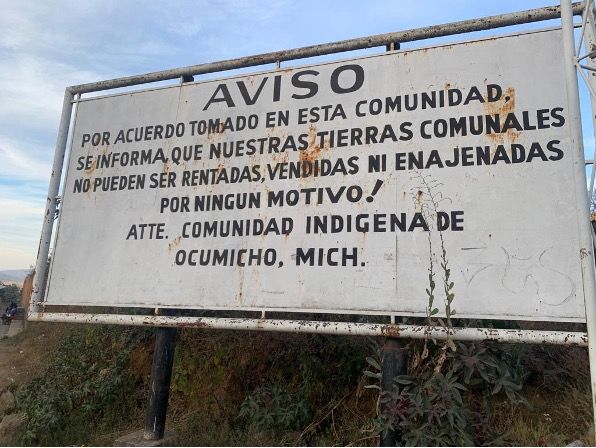
Photo taken by Climate Rights International at entrance to Ocumicho in January 2023. It reads: “Notice. Based on an agreement made in this community it is informed that our communal lands cannot be rented, sold, or alienated for any reason! Sincerely, Indigenous Community of Ocumicho, Michoacán.”
The community began mobilizing to stop the expansion of avocado production within their territory in 2018. In October of that year, the community convened an “assembly,” with 70 community members and community leaders Prudencio Ortiz Alonso and Santos Morales Quiroz, to discuss one issue: “the planting of avocado by people who are not from the community.”370“Assembly Agreement,” (“Acuerdo de Asamblea”), No. 119/2018, October 7, 2018. At the end of the meeting, they produced a resolution prohibiting anyone from outside the community from planting avocado in Ocumicho.371Ibid.
Less than two years later, on May 30, 2020, then-Secretary of Communal Property Ortiz, and then-Representative of Communal Property Morales, were shot by gunmen in Ocumicho, killing Ortiz and wounding Morales.
Soon after the attack, on June 14, 2020, the Ocumicho community held a “general assembly” that resulted in “assembly minutes” collectively signed by community leaders and scores of community members.372“Minutes of Extraordinary General Assembly in the Indigenous Population of Ocumicho, Charapan Municipality, Michoacán,” (“Acta de asamblea general extraordinaria de la población indígena de Ocumicho municipio de Charapan, Michoacán”), June 14, 2020. According to the minutes, the two agenda items were (1) the May 30 shootings and (2) conflict in the community “due to the sale of communal lands by people in the community of Ocumicho to third parties who aren’t from the community” where “where pines and oaks are cut down to grow avocado… Destroying the ecological equilibrium of the communal lands.” The community agreed to:
The complaint that the community resolved to file states that the shooting of Ortiz and Morales was “related to those who are dedicated to planting avocados,” and alleges that the triggermen were avocado workers.373Signed complaint addressed to Agrarian Inspector-General (Procuraduría Agraria) and/or Federal Public Ministry (Ministerio Público Federal), June 14, 2020. The complaint accuses Ortiz and Morales of having received bribes to facilitate land transfers to avocado growers, and accuses several other community members of deforesting and selling, renting, and being frontpeople for the transfer of land to avocado growers. It adds that there are rumors in the community that “people who try to defend the communal rights” will be “eliminate[d].” The complaint says the reason for founding the community patrol was to “not allow unknown and armed people to keep entering the community with high powered weapons” and to “defend our communal rights.”
On August 25, 2020, PROFEPA, the federal environmental enforcement agency, visited Ocumicho to inspect alleged illegal land-use change for avocado. According to a PROFEPA document recording the inspections, in six of the seven pieces of land the officials visited, they found cleared trees and avocado plantings, and in the seventh site they found cleared trees and the removal of soil and vegetation to build a water storage pool to “later serve to irrigate avocado plants.”374PROFEPA, “Record of Circumstances,” (“Acta Circunstanciada”), Investigation Number FED/MICH/ZAM/0001645/2020, Aug. 25, 2020. A community member later told Climate Rights International that PROFEPA posted signs closing off the orchards, but that avocado workers kept tending to them.
Over the following months, Ocumicho leader Esteban Cruz Rosas persisted in efforts to defend the community’s land and rights. On December 4, 2020, Cruz Rosas, who directed the community’s radio station, and another resident, filed a complaint with PROFEPA denouncing the deforestation of additional pieces of land for avocado.375Complaint filed by Esteban Cruz with PROFEPA, December 4, 2020. On May 30, 2021, Cruz Rosas gave an interview for Michoacán’s Channel 13, in which he stated:
Organized crime dressed up as avocado growers (aguacateros)… on May 30 last year killed one of the authorities… We presented the complaint … But because there’s money involved, the request isn’t being addressed…. What they’ve done is land-use change, cutting oaks, pines, cutting trees, leaving the hills bald… The problem is that there are armed people. What can we do with armed people? There’s fear. There’s threats.376“Avocado Growers Work with Organized Crime,” (“Aguacateros trabajan con crimen organizado”), video clip, YouTube, May 10, 2021, https://www.youtube.com/watch?v=UEEd__Hu22c (accessed July 13, 2023).
On April 20, 2022, a convoy of 10 trucks armed with high caliber weapons entered Ocumicho, according to a letter sent that day to Michoacán’s governor by Cruz Rosas, who by then was the General Coordinator of the Ocumicho Community Council, and two other leaders. The letter requested state police protection for the community.377Letter from Esteban Cruz Rosas and other community leaders to Alfredo Ramírez Bedolla, Governor of Michoacán, April 20, 2022 (Stamped as received by the office of a “subsecretary” on April 21, 2022). A week later, on April 28, 2022, Cruz Rosas was kidnapped by organized crime members when leaving the town of Ocumicho in a vehicle with family members.378CRI interview with Esteban Cruz Rojas, Ocumicho, Michoacán, January 18, 2023. He said that his captors hit him during the abduction. Cruz Rosas was released after roughly 24 hours.
A week after the kidnapping, community leaders again reportedly asked the governor for public security presence in the town to protect against organized crime.379Francisco Valenzuela, “Inhabitants of Ocumicho Demand More Security for Their Community,” (“Habitantes de Ocumicho demandan más seguridad en su comunidad”), El Sol de Morealia, May 5, 2022, https://www.elsoldemorelia.com.mx/local/habitantes-de-ocumicho-demandan-mas-seguridad-en-su-comunidad-8236308.html (accessed July 13, 2023). Armed men continued in their territory. A community leader told Climate Rights International that in August 2022, he went to a piece of land with the community patrol in response to a report of deforestation, and saw a man with an assault rifle fencing recently deforested land for avocado.380CRI interview with community leader, Ocumicho, Michoacán, January 18, 2023 (name withheld). On November 11, 2022, community members and the community patrol detained alleged members of an organized crime group in town, took away their weapons, and expelled them from the town.381CRI interviews with Ocumicho community leaders and residents, Ocumicho, Michoacán, January 18 and 19, 2023 (names withheld). The next day, leaders again sent a request for protection in Ocumicho, this time to the regional police.382Letter from Commander Víctor Alfonso Acosta Castro, Coordinator of Regional Police States of the Michoacán State Secretary for Public Security to Esteban Cruz Rosas, December 8, 2022 (denying November 12, 2022 request).
On November 27, 2022, community leaders and the community patrol found and stopped eight people from outside of the community who were clearing trees for avocado, according to a community leader and a document registering the incident.383CRI interview with community leader, Ocumicho, Michoacán, January 19, 2023; written community report of incident, dated November 27, 2022. The community authorities informed them that, pursuant to the October 2018 community decision, the selling or renting of land to people outside of the community was prohibited.
Around December 1, 2022, organized crime members sent threatening messages—with images of a group of armed people—to Ocumicho leaders, warning them that the group was going to return for their weapons and enter the town of Ocumicho. The messages included a photograph with an arrow pointing to Pedro Pascual Cruz, one of the community patrolmen who had stopped the outsiders from deforesting days before.384CRI interview with community leader, Ocumicho, Michoacán, January 19, 2023.
On December 8, 2022, a regional state police commander sent a letter to Cruz Rosas denying the November 12 request for police protection in Ocumicho, stating that he did not have adequate forces.385Letter from Commander Víctor Alfonso Acosta Castro, Coordinator of Regional Police States of the Michoacán State Secretary for Public Security to Esteban Cruz Rosas, December 8, 2022.
On December 10, 2022, Pascual Cruz was shot dead in Ocumicho. The killing terrified community members, several of whom said they believed the organized crime group murdered him. An Indigenous community leader from Ocumicho said that following Pascual Cruz’s murder, they could not sleep for five days and considered renouncing their leadership role. They said the head of the community patrol fled town.386CRI interview with community leader, Ocumicho, Michoacán, January 19, 2023
The aggressions continued in 2023. On May 12, 2023, Ocumicho’s Autonomous Community Council issued a communique stating that organized crime members had disarmed their communal guard and had threatened to return to the community. The community reiterated its request that public security forces install a post in the community to guarantee their safety.387Autonomous Purépecha Community Council of Ocumicho, Michoacán, “Communiqué,” May 12, 2023.
All told, the violence and intimidation between 2020 and 2023, combined with community divisions and market demand for land to produce avocado in Michoacán, has undermined the ability of Ocumicho’s Indigenous authorities to enforce their ongoing prohibition on selling or renting communal lands.388Autonomous Purépecha Community Council of Ocumicho, Michoacán, “Communiqué,” Dec. 22, 2022 (reiterating prohibition on renting or selling communal lands).
Climate Rights International found a February 2023 ad for an 11-hectare piece of land in Ocumicho “to plant avocado,” posted on a Facebook group for buying and selling land for avocado orchards in Michoacán, which has 34,700 members.389Facebook post in Facebook Group, “AVOCADO MICHOACAN Purchase and Sale of Orchards and Land,” https://www.facebook.com/groups/2032776826948260/permalink/4126757667550155/ (accessed July 13, 2023). Climate Rights International contacted the poster of the ad, who said the land is next to orchards, on communal land, and sent the GPS coordinates. Ocumicho community members also identified the area as being part of their communal lands. As shown in maps in Appendix G, the land indicated by the coordinates was recently cleared of trees, and is near the areas where PROFEPA conducted its inspections in August 2020.

Screenshot of the February 2023 ad on Facebook
The same Facebook group has an ad, posted on three occasions in April and May 2023, for a different, 23-hectare avocado orchard in the same area of Ocumicho that community members identify as part of their communal lands. The ad states that the land “is communal,” already has avocado plantings that are 2.5 years old, and a 40x40x7 meter water storage pool.390Facebook post in Facebook Group, “AVOCADO MICHOACAN Purchase and Sale of Orchards and Land,” https://www.facebook.com/groups/2032776826948260/permalink/4177316029160985/ (accessed July 13, 2023). Climate Rights International contacted the poster, who provided the GPS coordinates. As shown on maps in the Appendix G, since 2016 there has been a forest fire and clearing of trees in the area indicated by the coordinates, and one portion of the land directly overlaps with the plot of land PROFEPA inspected in August 2020, where it found cleared trees and avocado plantings. The land also directly borders a U.S.-certified orchard containing deforested land that, according to government records, supplied more than 15,000 kilograms of avocados to West Pak and Mission Produce in 2022.391Transparency law response from SENASICA to request number 330028323000180, June 27, 2023. The orchard number is HUE08160210404.

Facebook ad for 23.5 hectares
In the municipality of Madero, residents have organized a network of environmental defenders to oppose the illegal conversion of forests to avocado orchards, which threatens their water supplies, both because deforestation negatively impacts the recharging of aquifers, and because of orchards’ unlicensed water use.392CRI interviews with Madero activists and residents, Madero, Michoacán, December 13 and 14, 2022. Their efforts have been stymied by well-founded fear of violence.
Around 2016, the activists began mobilizing community members to go to areas being deforested and try to persuade the perpetrators to stop, filed environmental complaints with state and national authorities, and tried to pressure them to enforce the law. In 2018, for example, they sent a complaint to PROFEPA and CONAGUA protesting CONAGUA’s granting of a concession for a well in an area that “for the past three years has been logged and in which avocado has been planted,” and stating that “the well goes against the human right to water” of the populations that live downhill from it.393Letters from community leader to C. Talía Mendoza Coria, PROFEPA Delegate to Michoacán and C. Oswaldo Rodríguez Gutiérrez, CONAGUA Delegate to Michoacán, April 6, 2018 (name of author of letter withheld).
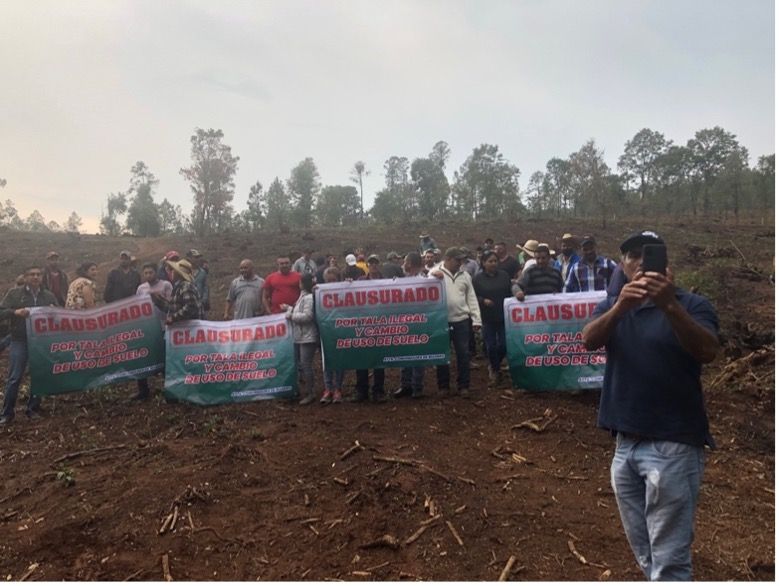
July 2021 photograph of activists and residents symbolically “closing down” a deforested property in Madero, provided by local residents. The signs state “Closed for illegal logging and land use change.”
In 2021, the Madero activists started organizing periodic meetings with local, state, and federal authorities to address the “concerning problems of land use change, illegal logging, and impacts on springs that provide water to multiple communities.”394“Minutes of assembly of Madero residents and municipal authorities,” (“Acta de asamblea de pobladores de Madero y autoridades municipales”), June 14, 2021. At the first meeting, in June 2021, the participants “made known the social disagreement in the localities due to the fact that logging and land-use change have affected their quality of life given the scarcity of water.”395Ibid. At the third meeting, on November 26, 2021, authorities agreed to close down various orchards residents had identified as being located on illegally deforested land.396“Report of Agreements of the Third Roundtable Meeting to Address the Environmental Problems in Madero,” (“Relatoría de Acuerdos de la Tercera Mesa de Trabajo Para Atender la Problematica Ambiental de Madero”), (Draft), November 26, 2021. Activist Guillermo Saucedo, who had been mobilizing community members to stop deforestation in Madero, told Climate Rights International that at the November 2021 meeting, he publicly stated that environmental activists were under threat.397CRI interviews with Guillermo Saucedo, Madero, December 13 and 14, 2022.
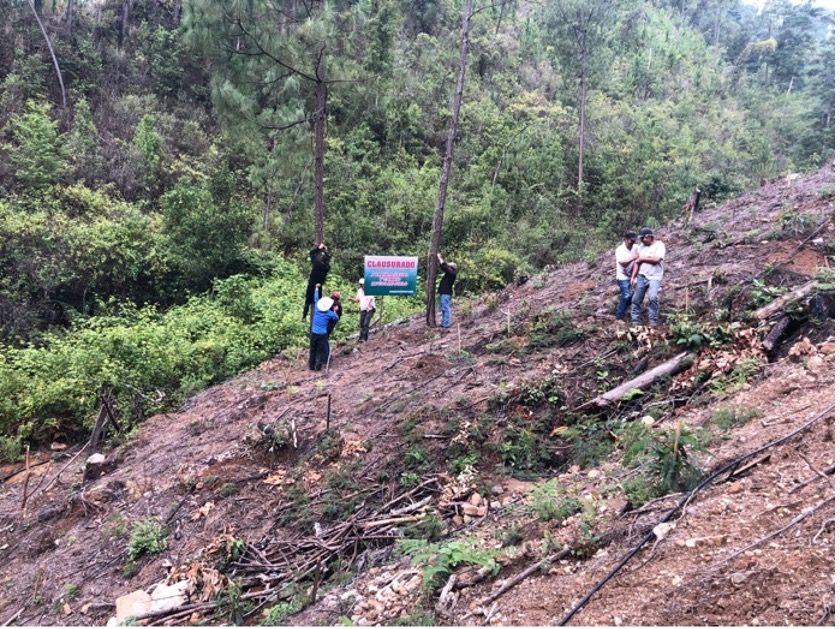
Activists symbolically “closing down” a property in July 2021. Photograph provided by local residents.
About two weeks later, in December 2021, heavily armed organized crime members forced Saucedo into an SUV in downtown Madero, within 50 meters of the local police headquarters.398Ibid. See also Mark Stevenson, “Mexican town protects forest from avocado growers, cartels,” Associated Press, January 27, 2022, https://apnews.com/article/business-world-news-mountains-mexico-caribbean-32a4508534bffb00cf341119de733d5d (accessed July 11, 2023). They drove him to a remote area, striking him with the butts of their guns along the way. He was released within 24 hours, after authorities started searching for him.399Ibid. His captors instructed him to blame a rival organized crime group. He believes he was kidnapped because of his activism, given previous incidents of threats and intimidation against him when carrying out the environmental work, and the fact that he was interfering with avocado and logging interests.
Despite the kidnapping, Saucedo and the group of activists continued their efforts.
Francisco Gómez Cortez, an activist who works with Saucedo, told Climate Rights International that in November 2022, he was threatened by armed men in Madero. He was driving when a truck intercepted him, a man got out of the truck with a rifle and ordered him to get out of the car, threatening to kill him.400CRI interview with Francisco Gómez Cortez, Madero, Michoacán, December 14, 2022. A second car then pulled up with four armed men. According to Gómez, one of the men said “that’s the leader of the environmentalists that we’re going to take.” Gómez said he radioed to his network of environmentalists, and one of them drove up in a car, leading the assailants to drive away. After the attack, his family temporarily moved out of their house for their own safety.
When visiting Madero in December 2022, Climate Rights International had to cancel our planned trip to one area of the municipality to document deforestation for avocado orchards because the activists deemed it unsafe due to the presence of heavily armed men seen that morning on the road to the area. Climate Rights International interviewed a man who said he saw the armed men.401CRI interview with man, Madero, Michoacán, December 14, 2022 (name withheld). There is no indication that the armed men’s presence had anything to do with CRI’s planned trip.
Climate Rights International did visit a rural community in Madero where residents said that the actions of avocado growers directly uphill from them have led to a reduction in water supplied from a spring, which is one their community’s two main water sources.402Climate Rights International interviews with Madero residents, Madero, Michoacán, December 13, 2022 (names withheld). They attribute the water reduction to unauthorized pumping of water from the spring for orchards, and deforestation and fires for the expansion of orchards above them. The immediate reduction in available water when orchards pump from the spring above is noticeable to them. They said that the reduced water supply—which is particularly low between the months of March and June—led them to stop planting certain crops, such as tomatoes, and onions, and that they had less water for animals.
With satellite imagery, official data, and a site visit, Climate Rights International verified the deforestation, fires, and illegal water use directly uphill from the community. When asked why they had not disassembled one illegal pump for orchards that Climate Rights International saw, residents said the reason was out of fear that they could be killed.403Ibid.
This was part of a general fear, expressed by environmental defenders in Madero, of violent reprisals for denouncing deforestation and unlicensed water use, which they said led them to restrict their activism. They believe organized crime is involved in clearing forest for the avocado growers and positioned to protect both avocado and logging interests.404CRI interviews with Madero residents, Madero, Michoacán, December 13 and 14, 2022 (names withheld). As an example, one resident said that in the area of Madero where he lives, cutting down a tree requires getting the permission of and paying a fee to members of an organized crime group.405CRI interview with Madero resident, Madero, Michoacán, December 14, 2022 (name withheld).
Several senior Michoacán environmental officials told Climate Rights International that in their view, environmental defense by activists in Madero puts their safety at ongoing risk.406CRI interview with senior environment officials, Morelia, Michoacán, December 16, 2022; CRI interview with environmental official, Morelia, Michoacán, January 17, 2023 (names withheld).
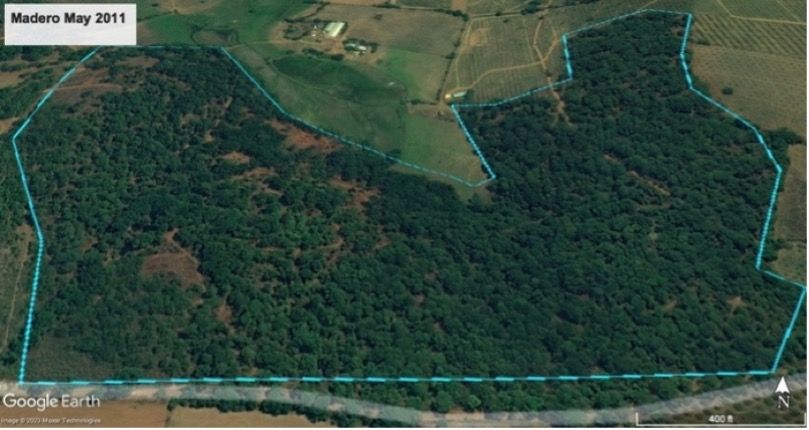

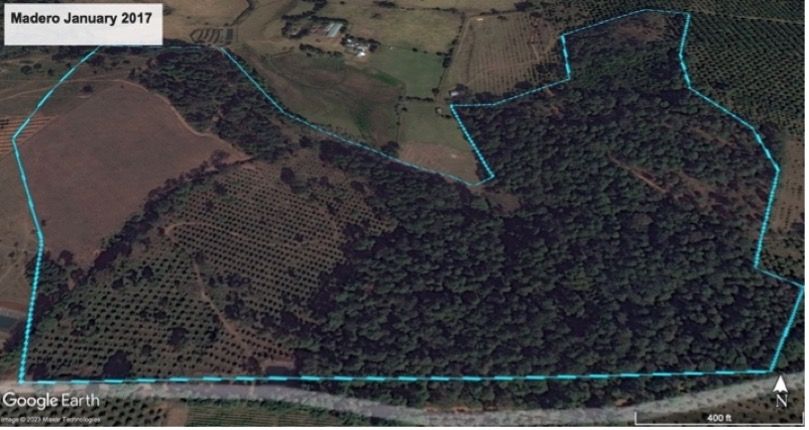
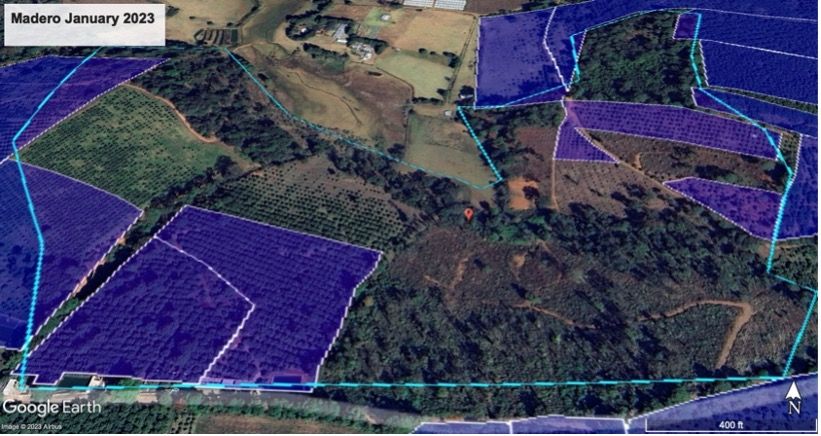
Google Earth images. The light blue outline is of an 84-acre area directly outside the municipal center of Madero, where forest has been converted to avocado orchards. The image from March 2021 shows charred land from a forest fire. According to residents, avocado was subsequently planted in the area of the fire, a man armed with a rifle guarded it, and would interrogate people passing by.407CRI interviews with Madero residents, Madero, Michoacán, December 13 and 14, 2022 (names withheld). Blue polygons are U.S.-export approved orchards.
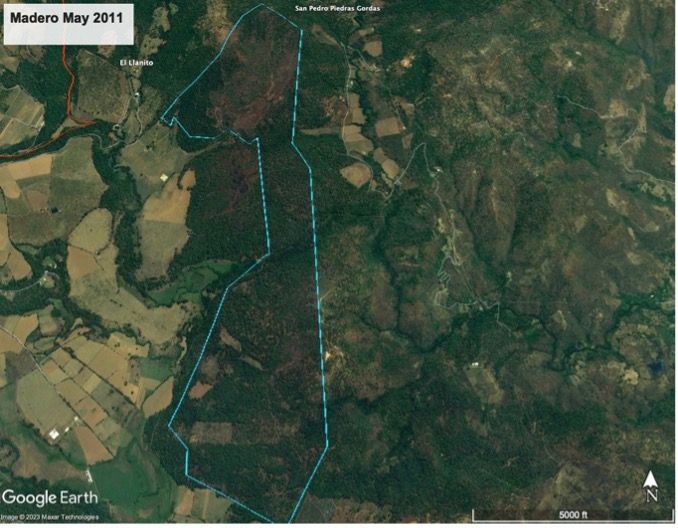
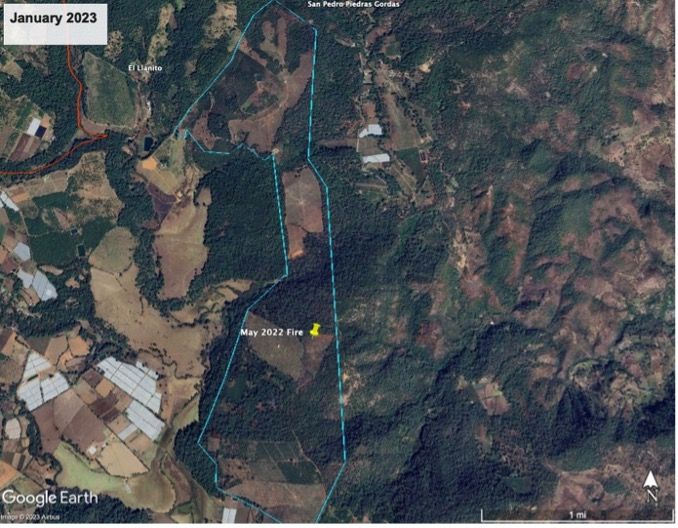
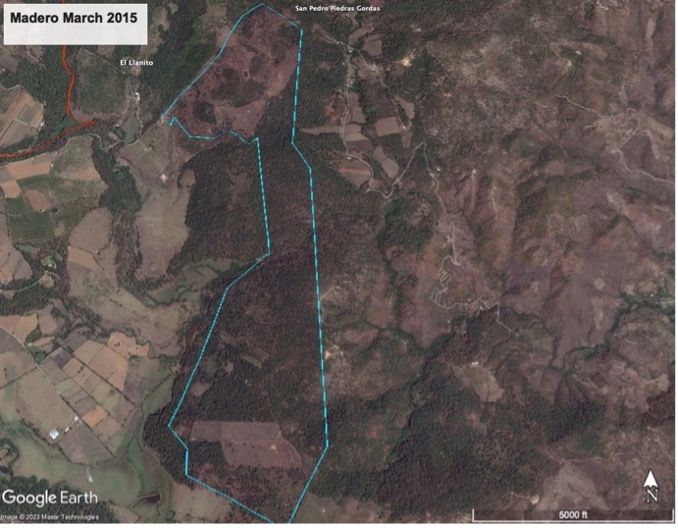

Google Earth images of an area of Madero. The light blue outlines an area just north of the deforested area shown in prior images. As the images show, multiple avocado orchards have replaced forest in this area, and some—denoted with blue polygons—have already been approved for U.S. export. Government shipment records indicate that in 2022, the deforested orchard with a red star supplied Mission Produce with 17,330 kilograms of avocados;408The orchard number is HUE08160490979. and the deforested orchard with the yellow star supplied Fresh Del Monte with 6,255 kilograms.409The orchard number is HUE08160490766.
The yellow pin above the two starred orchards shows an area directly adjacent to an export-approved orchard, where there was a forest fire in May 2022, which authorities classified as being for land-use change.410Transparency law response from COFOM to request number 160336023000002, February 7, 2023. (Data for fire 22-16-0583.) The following Google Earth images, from January 2023, show a bulldozer and truck (left image), and several trucks (right image) in the area of the fire a half a year later, presumably preparing to plant avocado.
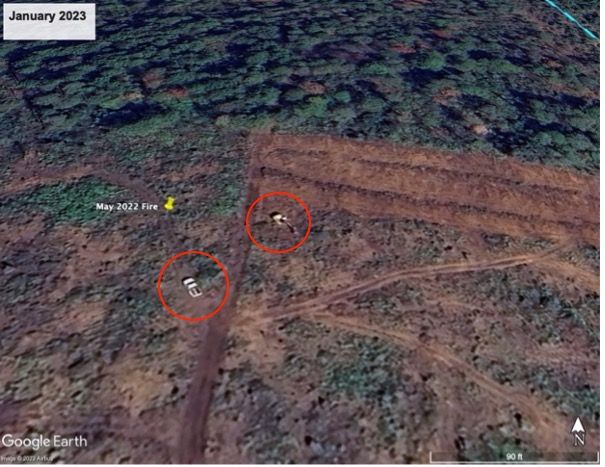


Photograph of May 2022 fire, provided by local residents.
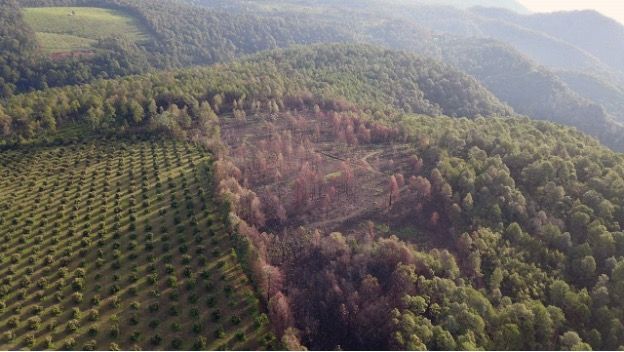
Drone image from 2022, provided by local residents, showing deforested area of May 2022 fire to right of avocado orchard to left, which also had been forest several years before. The orchard in top left corner also is the product of deforestation, as evident from the Google Earth images above.
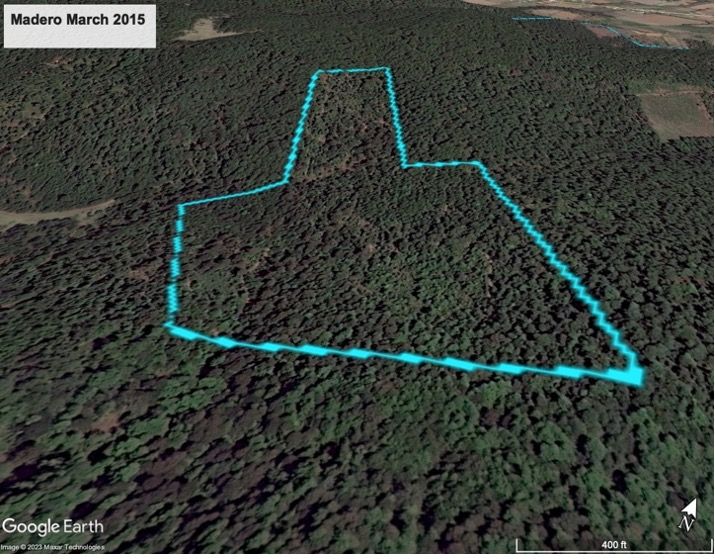


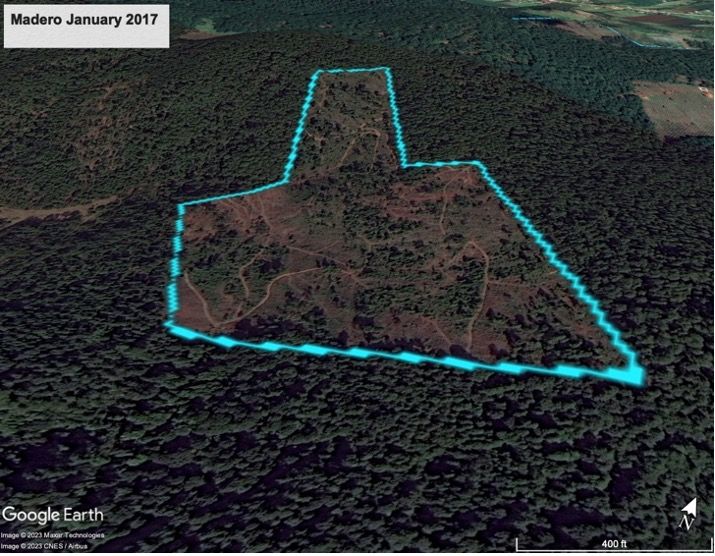
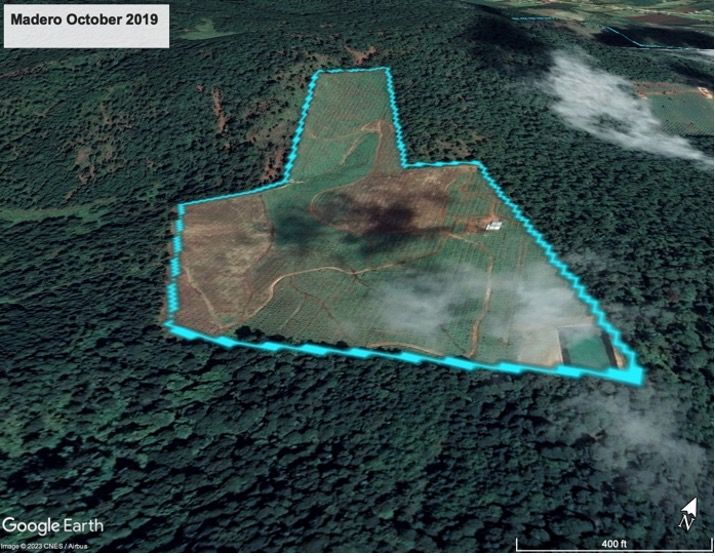
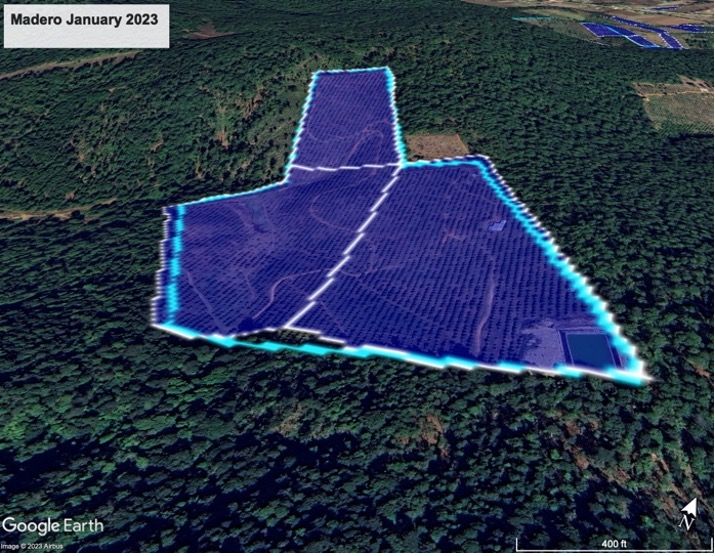
Google Earth images of a roughly 60-acre plot of forest in Madero that was deforested since 2015 and converted into three U.S.-approved export orchards, shown in blue polygons. The neon green polygon shows the area of a March 2017 forest fire, classified by the government as having unknown causes.411CONAFOR and CONACYT, Forest Fire Danger Prediction System of Mexico, http://forestales.ujed.mx/incendios2/; Transparency Law Response from COFOM, N. SPDF/002/012/2023. (Data for fire 17-16-0259). As the images show, avocado was later planted in the area of fire.

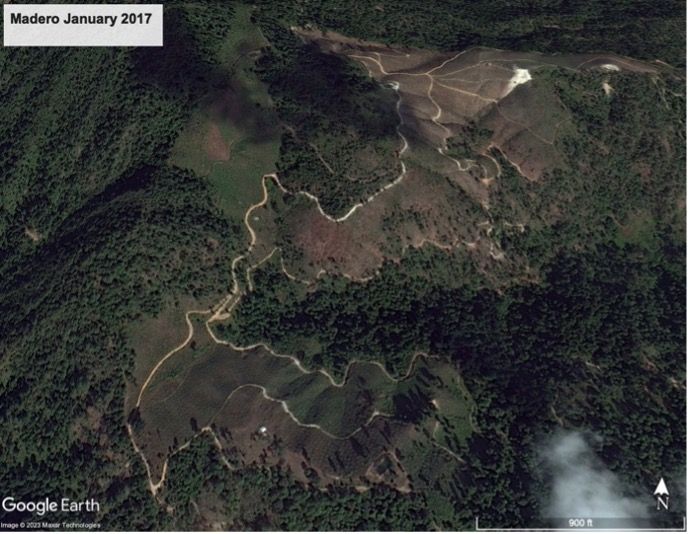
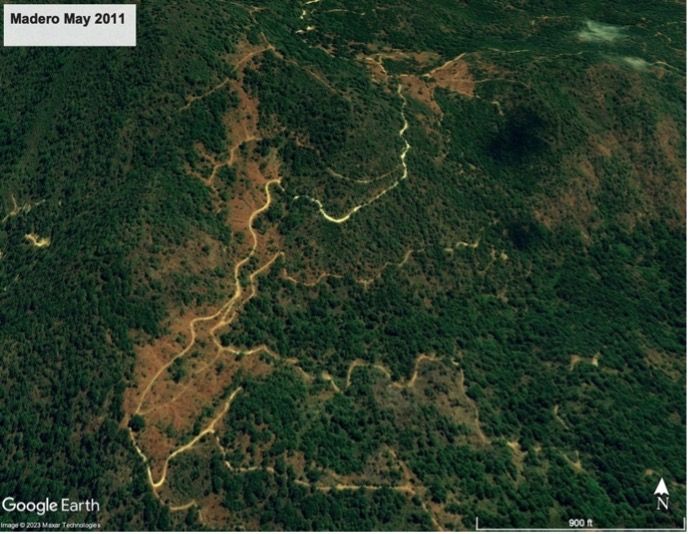
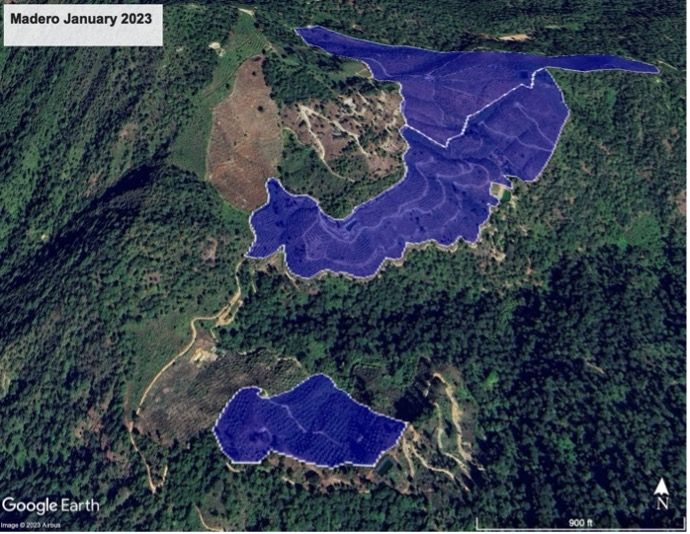
Google Earth images showing deforestation for avocado orchards in Madero, some of which are approved for U.S.-export. Government data also indicates there was a forest fire in the area of the deforestation in 2012.
Two Indigenous leaders from a community in an avocado-growing area of Michoacán—who asked to remain anonymous for their safety—told Climate Rights International they had been attacked and intimidated in relation to their defense of communal lands.412CRI group interview with community leaders, Michoacán, 2023 (names and exact date and location withheld). Their account points to links between organized crime, deforestation, and avocado production in the area.
The leaders’ description of violence and land-use change in their community dates back to around 2010. One of them said that the top leader of the community at the time confided to them that an organized crime group had threatened to disappear him if he did not transfer about 100 acres of communal land, some of which was forested and some agricultural. The leader had no choice but to comply. The organized crime group planted avocado on the land, and the community has not gotten it back since.413Ibid.
They said that around 2017, individuals identified by community members as linked to organized crime cleared an additional 50 acres of forested communal land, they believe with the intent of converting it to avocado production. When they filed an anonymous complaint with PROFEPA, an inspector warned them that land-transaction papers linked the plot to a member of a powerful organized crime group. The leaders identified a point on Google Maps where the deforested area is located, and Climate Rights International subsequently confirmed that forest was cleared there between 2015 and 2017, and there are avocado orchards in the immediate area, including U.S.-export approved orchards.414Ibid.
In roughly 2018, individuals from outside of the community began to try to claim ownership over—and clear trees in—two areas of land that the leaders said were communal lands. The leaders believe the intention was to convert both areas to avocado orchards: the individuals trying to acquire the land said they would give the community the wood, what mattered to them was having the area cleared. Around this period, the community started organizing to patrol the territory to prevent deforestation and robberies.415Ibid.
Around 2019, the two leaders were kidnapped by a group of heavily armed, masked men, who took them to an avocado orchard, pointed guns at them, and said they had been getting in the way of their business, which included the sale of drugs in the area. They threatened to harm their family members if they continued, and then released them. The leaders later learned that the same organized crime group had publicly dismembered someone in a nearby community.416Ibid.
Around 2021, the leaders went with community members and the police to stop trucks from removing wood from one of the areas individuals had been trying to acquire since 2018. The people transporting the wood threatened to shoot them. That night, one of the leaders received a call from a man who identified himself as a “commander” of the area, and said that they “didn’t know who they were messing with.” The leaders identified a point on Google Maps where the deforested area is located, and Climate Rights International subsequently confirmed that forest was cleared there between 2017 and 2022, and that there are avocado orchards in the immediate area, including U.S.-export approved orchards.417Ibid.
Around the end of 2021, a local organized crime boss called the leaders to a meeting at an avocado orchard, where he arrived in an armored car and with armed guards. The organized crime boss told them that a landowner was offering money to “scare” the community in relation to the dispute over one of the pieces of land the community had been defending since 2018.418Ibid.
As noted in the summary, Indigenous community members in Cherán, Michoacán have set up an autonomous government, prohibited the planting of avocado on communal lands, and established their own officially-recognized police force to patrol and protect the forests. The municipality of Nahuatzen is located to the southeast of Cherán, and is home to several Indigenous Purépecha communities, including Nahuatzen, Sevina, and Comachuén. In recent years, members of these communities have attempted to establish autonomous governments, like Cherán did. (Sevina now does have an autonomous government.)419Francisco Valenzuela, “Two Years of Self-Government: The History of Sevina, Rising Up for Autonomy,” (“Dos años de autogobierno: la historia de Sevina, levantada por autonomia”), El Sol de Morelia, Jan. 3, 2023, https://www.elsoldemorelia.com.mx/local/dos-anos-de-autogobierno-la-historia-de-sevina-levantada-por-autonomia-video-9393856.html (accessed July 13, 2023).
While Nahuatzen currently has relatively few U.S.-export certified orchards, many orchards have been established there in recent years, and the export-certified frontier is encroaching from the north, from Zacapu, and the south, from Tingambato. The expansion of these orchards has often caused deforestation.
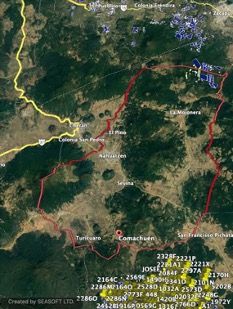
Google Earth satellite image. Outline of municipality of Nahuatzen in red.420Map of Nahuatzen by government agency CONABIO. The yellow pins to the south are U.S.-export approved orchards in the municipality of Tingambato. The blue and green polygons in north are U.S.-export approved avocado orchards.

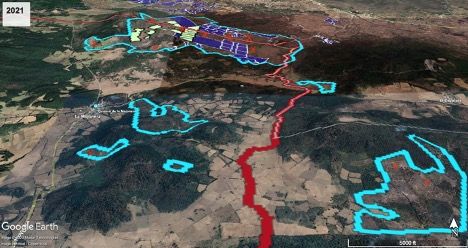
These Google Earth satellite images show land-use change between 2015 and 2021, along the northeast corner of Nahuatzen municipality. The red line is the outer limit of Nahuatzen; the green and blue polygons are U.S.-export certified orchards; and the light blue outlines denote some of the areas where Climate Rights International identified focal points of deforestation (though the entire area within the light blue outlines was not necessarily deforested). The red x’s are where Climate Rights International identified avocado plantings and/or water storage pools that were already visible, zooming in on the 2021 satellite image.
Leaders and members of Nahuatzen and Comachuen Indigenous communities, in the municipality of Nahuatzen, said that deforestation and the expansion of orchards in the area has been linked to organized crime, land grabs, threats, and violence.421CRI group interviews with community leaders and residents, Michoacán, 2023 (names and exact dates and locations withheld); CRI interview with community leader, Michoacán, 2023 (name and exact date and location withheld).
Nahuatzen community leaders told Climate Rights International that, starting around 2016, a group of men from the community who they believe have links to organized crime started clearing trees, taking over land, and selling the land plots to other people.422CRI group interviews with community leaders and residents, Michoacán, 2023 (names and exact dates and locations withheld).
For example, two community leaders, who are related, said that several years ago, their close relative discovered that the group had sold her plot of land in the hills to a man from outside the community, without her knowledge.423Ibid. The family learned that the group had also been telling her neighbors to sell their land to them, and had threatened the neighbors with a gun to keep quiet. The neighbors told the community leaders’ family that they had sold the land, because the neighbors did not want to lose their lives over it. When the community leaders’ relative learned of the sale of her land, she initially tried to prevent it, but eventually acquiesced, after being warned there would be consequences if she did not. One of the leaders said she heard from community members that avocado has started to be planted in the area.
Community leaders said that armed men are present in the areas of the hills where the group is carrying out land takeovers and deforestation, and that there have been shootings there. One night in 2020, a community’s member’s horse was shot at. Around October 2021, a community member was shot in the back and killed while hunting in the hill. A community leader said that a few months later, she went to the area and heard gun shots. The community leaders suspected the land takeovers could be for a variety of reasons, including selling the wood, drug trafficking activities, and/or avocado production.424Ibid.
In June 2022, the Indigenous Citizen Council of Nahuatzen sent a letter to the head of CONAFOR requesting support to reforest the hills in the community, where “around 150 to 200 hectares have been deforested by organized crime and excessive avocado crops.”425Letter from Indigenous Citizens Council of Nahuatzen to Luis Meneses Murillo, General Director of CONAFOR, June 27, 2022. In January 2023, the council filed a complaint with PROFEPA denouncing land-use change in the hills.426 Complaint filed by Indigenous Citizens Council of Nahuatzen with PROFEPA, January 27, 2023.
In addition to their alarm over deforestation,427See Appendix H for images of deforestation and a forest fire around the Nahuatzen community. water is another concern for Nahuatzen community leaders. They said that avocado growers have been diverting for orchards water that comes from two of the main water sources for the population.428CRI group interviews with community leaders and residents, Michoacán, 2023 (names and exact dates and locations withheld). For example, they said community members and an orchard owner have gone back and forth four times, connecting and then disconnecting tubes siphoning off water for the orchard. These water conflicts are particularly troubling given the precarious access to water there: some residents interviewed said they receive water in their homes once or twice a week; and that some homes have no access to piped water.
In the Indigenous community of Comachuén, at the southern edge of the municipality of Nahuatzen, there has been significant deforestation for avocado on lands that—according to a community leader and maps published in an academic study—are subject to a boundary dispute between the Indigenous community of Comachuén and its southern neighbor of Tingambato.429CRI interview with community leader, Michoacán, 2023 (name and exact date and location withheld); Pablo Sebastán Felipe, “Memory and Territory in the P’urhépecha Mountains. The Primordial Titles of Comachuen and its Neighboring Communities,” (“Memoria y territorio en la Sierra P’urhépecha. Los títulos primordiales de Comachuen y sus pueblos vecinos”) (Ph.D. diss., El Colegio de Michoacán, A.C., August 2020), https://colmich.repositorioinstitucional.mx/jspui/bitstream/1016/1127/1/Sebasti percentc3 percenta1nFelipePablo2020Tesis.pdf, pp. 288-89 (accessed July 13, 2023).
The first of the following four maps was published in an academic study, and shows the disputed territory shaded in red.430Felipe, “Memory and Territory in the P’urhépecha Mountains. The Primordial Titles of Comachuen and its Neighboring Communities,” p. 289. The Comachuén territory is shaded in diagonal black stripes. The next three maps show land use change for avocado in the area of the disputed territory.

Map from the academic study, showing in red cross-hatching the “territory in conflict” between Comachuén and Tingambato.431Pablo Sebastán Felipe, “Memory and Territory in the P’urhépecha Mountains. The Primordial Titles of Comachuen and its Neighboring Communities.” The black cross-hatching represents the territory of Comachuén.
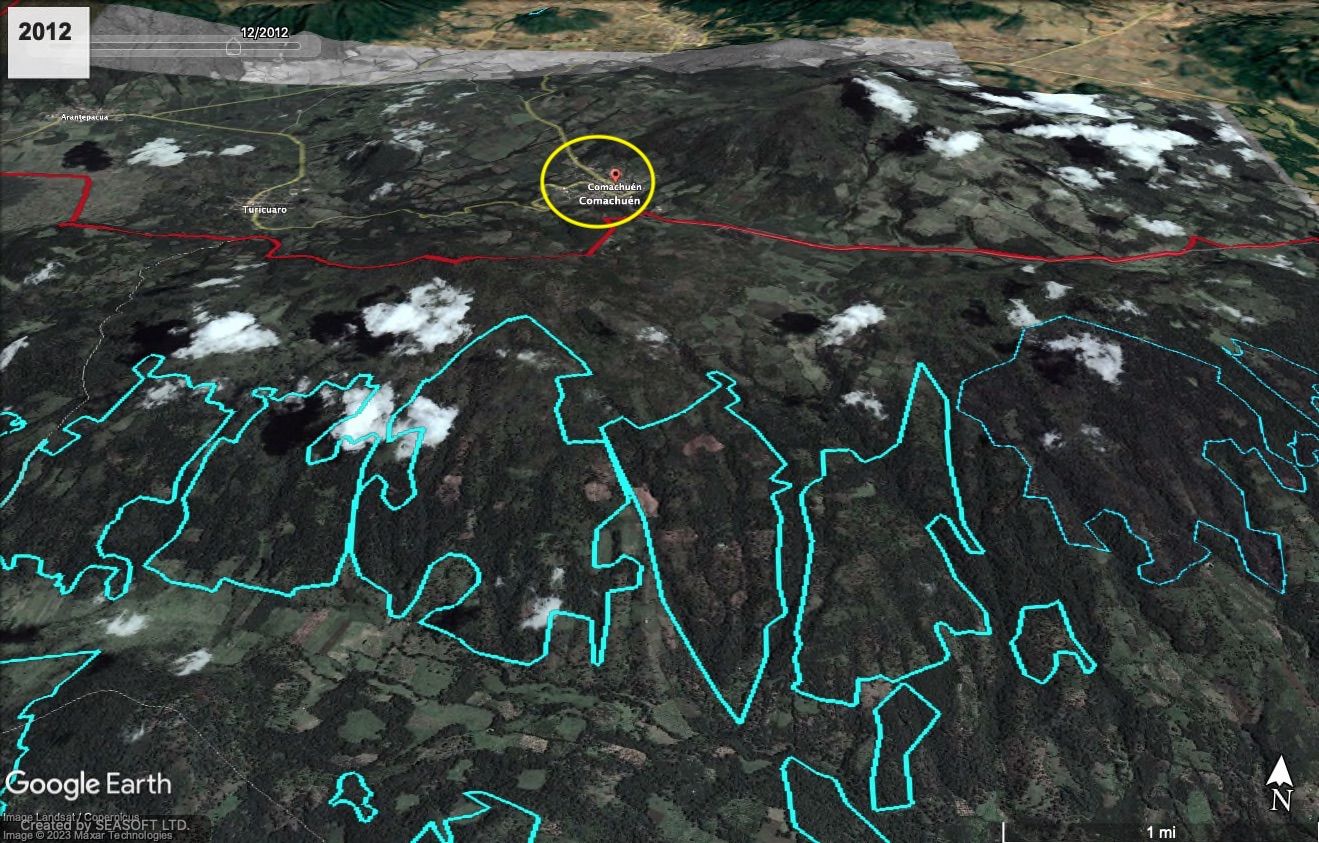

Google Earth satellite images of the same area from 2012 and then 2021. Yellow circle around town of Comachuén. The red line divides the municipalities of Nahuatzen and Tingambato. The light blue outlines areas where Climate Rights International identified significant deforestation and avocado orchard growth between 2012 and 2021 (though the entire area within the light blue outlines is not necessarily deforested).
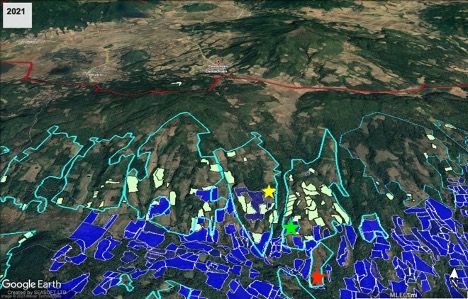
Google Earth satellite image from 2021, with U.S.-export approved orchards covered in blue and green polygons. The area of the photograph below is denoted with red star at the bottom of image. According to government shipment records:
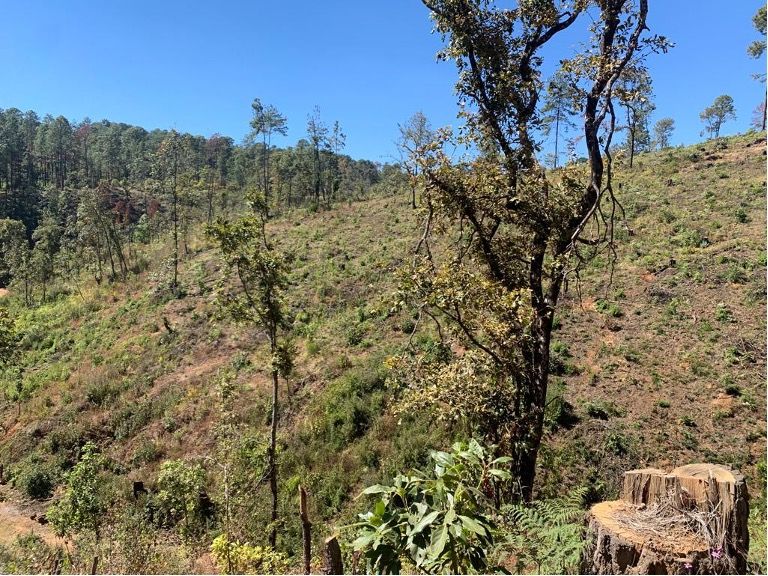
2023 photograph by Climate Rights International of deforested area of hill denoted with red star in image above.
Climate Rights International interviewed a community leader from Comachuén who said she had publicly advocated for Comachuén’s claim to the disputed land undergoing deforestation for avocado.434CRI interview with community leader, Michoacán, 2023 (name and exact date and location withheld). She said that in 2019, an avocado company truck stopped next to her on the street in Comachuén, and three men inside of it pointed a gun at her. She hid in a house, and they screamed for her to come out.
The community leader also said that starting about five years ago, it has become unsafe to go to the hills where the deforestation for avocados is occurring, due to the presence of armed men. She said community members have stopped going there.
Just north of Zacapu, Jimenez, Purépero, and Panindícuaro are three municipalities where in recent years deforestation has facilitated avocado expansion. In August 2020, a group of residents and a lawyer from the region produced and posted on Facebook a video denouncing environmental destruction for avocado production in the area. In the video, which includes footage of a bulldozer clearing a path on deforested land, and a well being drilled—which the lawyer said lacked a license—they say:
In recent years the clandestine logging of our forests and territory and takeover of land by big businesspeople is evident…. They are using our territory to grow avocado. At different times community members from this region have presented complaints before the regional prosecutor’s office in Zacapu; they have presented their complaints before state and federal environmental authorities, even the governor has knowledge of this situation…. And nobody—absolutely nobody—has addressed this problem…. The excessive abuse of aquifers is a reality. People from these populations don’t have enough water for their own consumption, and much less for their cattle…. How do these businesspeople act?… Their way of operating is through intimidation, through armed groups, through the takeover of land…. Because their investments are in the millions, it doesn’t matter to use shock groups, armed groups to pressure, which obviously are part of organized crime, and pressure and intimidate society…. Therefore we’re going to try to organize, draw attention, and denounce this reality of land takeover, impact on our environment, and of course violations of our individual and collective human rights.435“We have the historic responsibility to make visible the takeover of our territories,” (“Tenemos la responsabilidad histórica de visibilizar el despojo de nuestros territories”), video clip, Facebook, August 19, 2020, https://www.facebook.com/daviddaniel.romerorobles/videos/3168161483267438 (accessed July 13, 2023).
The video received 25,000 views on Facebook. One of the residents who appeared in the video said that months after it was posted, a man from the region warned him that he and the others in the video were almost killed for having published it, and not to create problems for himself.436CRI interview with resident, Michoacán, 2023 (name and exact date and location withheld). The resident said that he took the warning seriously and decided to keep quiet. He also said that he had also previously had trouble with an avocado grower from the area who belonged to an organized crime group, and had threatened to kill him, while armed with a pistol, on two occasions in 2014 and 2015.437Ibid.
The following satellite images, from Global Forest Watch, show an area at the border between Jimenez and Panindícuaro where large tracts of forest have been cleared over the past seven years. Residents said the clearing is for avocados, which have already been planted on some of the deforested land. The deforested swaths are near U.S-export approved orchards, and water storage pools typically used for avocados are visible from Google Earth satellite imagery. The red stars show apparent areas of deforestation that Climate Rights International identified, when comparing the image to the one that precedes it.

Global Forest Watch Composite June-November 2016
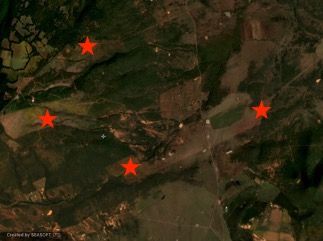
Global Forest Watch November 2021

Global Forest Watch December 2022. The red star on the left denotes the area that satellite imagery shows was cleared around November 2022. Climate Rights International took the photograph below of that area in early 2023.
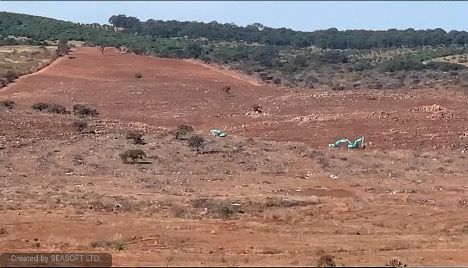
Climate Rights International photograph of land cleared around November 2022, in the area denoted with red star on the left side of the satellite image above. Blue bulldozers are clearing the land. Climate Rights International saw burnt trunks and uprooted trees in the area.
Even when local residents haven’t themselves been victims of attacks or threats, they reported feeling intimidated by the frequent presence of armed men in areas of avocado expansion. In Madero, Michoacán, for example, residents said that in an area just outside of the town where avocado had been planted after an April 2021 forest fire, a man with an AR-15 rifle would guard the orchard, and sometimes question people who passed by.456CRI interview with residents, Madero, Michoacán, December 13 and 14, 2022. In Ocumicho, Michoacán, Indigenous leaders reported encountering, in late 2022, a man with an AK-47 rifle fencing off land for avocado in an area where trees had recently been cleared.457CRI interviews with community leaders, Ocumicho, Michoacán, January 18 and 19, 2023. A member of the Indigenous forest guard of Cherán, Michoacán said that when patrolling the outer limits of Cherán that borders Zacapu, he has seen workers in avocado orchards armed with rifles.458CRI interview with member of Indigenous forest guard, Cherán, Michoacán, March 2, 2023.
The repeated attacks and threats associated with avocado expansion—as well as the presence of organized crime groups and their apparent links to many avocado businesses—have generated widespread, well-founded fear that defending the environment from the impacts of avocado production could trigger violent reprisals. This fear has deterred and impeded efforts by residents, journalists, and officials to defend forests and water and enforce environmental laws.
Even the managing director of the Association of Exporting Avocado Producers of Jalisco (APEAJAL) told Climate Rights International that it would be too dangerous for its officials to prohibit orchards on deforested land from exporting, because the officials could be threatened or killed.459CRI interview with Armando Garcia, Managing Director of APEAJAL Zapotlán el Grande, Jalisco, March 17, 2023.
In many instances that Climate Rights International documented of local residents being attacked or threatened, those people and/or others in their communities subsequently chose to reduce their efforts to defend the forests and water supply:
Climate Rights International also spoke with numerous residents in both states who had not directly experienced threats or violence themselves, but also refrained from speaking out or acting to protect their forests and water out of fear of reprisals. For example, some said that the fear of violent retaliation deterred them from disconnecting pipes stealing water for orchards, or from denouncing the water theft to authorities.466CRI interviews with residents, Michoacán, 2022 and 2023 (names and exact dates and locations withheld).
Local journalists are also deterred by fear from critical reporting on the avocado industry:
One Indigenous leader in Michoacán summed up what Climate Rights International found to be a common perception among people throughout the avocado region: “If you point the finger or talk, they’ll kill you.” They added: “There is no freedom to act due to fear of reprisals.”469CRI interview with community leader, Michoacán, 2023 (name and exact date and location withheld).
Authorities said that the presence of organized crime and fear of violence significantly hinder their ability to contain illegal deforestation and water theft in the avocado regions of Michoacán and Jalisco.
Officials told Climate Rights International of multiple instances where the presence of armed men—presumed members of organized crime—forced them to abort operations in the field. A National Water Commission (CONAGUA) official in Michoacán said that in 2022 an inspector went to verify the possible illegal pumping of water from a spring, but armed men stopped him and turned him around.470CRI interview with CONAGUA official, Morelia, Michoacán, March 6, 2023 (name withheld). Another Michoacán official said that in inspecting land-use change or assisting firefighting, including in 2022, he and other officials have encountered armed men who will not let them enter the area.471CRI interview with official, Morelia, Michoacán, January 17, 2023 (name withheld) Sources in Madero said that in 2022, armed men prevented firefighters from putting out a fire in an area where forest is being converted to orchards.472CRI interviews with residents, Madero, Michoacán, December 13 and 14, 2022. A resident of Jalisco also said that about three years ago when they went with volunteers to help put out a fire, they encountered armed men who told them to go away, saying they had lit the fires and would be the ones who put them out. CRI interview with resident, Jalisco, 2023 (name and exact date and location withheld).
Officials said some areas of avocado expansion are often simply too dangerous for them to go by themselves. In Michoacán, environmental agents often need a police escort to carry out inspections of alleged deforestation and land use-change due to the possible presence of organized crime and armed men.473CRI telephone interview with environmental official, February 10, 2023 (name withheld); CRI interview with official, Morelia, Michoacán, January 17, 2023 (name withheld). In Jalisco, the PROFEPA office said that investigations are delayed because security forces are not always available to escort inspections, and that because of links between organized crime and avocado, safety is the biggest obstacle to investigating and sanctioning land-use change.474Written response to CRI’s written questions provided by Jalisco PROFEPA delegation on March 20, 2023. One environmental official said that, when they started their job in Jalisco, colleagues showed them a map of where they could not go to investigate deforestation because of the presence of organized crime.475CRI interviews with official, 2023 (name, date and location withheld).
In response to a recent complaint concerning deforestation for avocado production in Jalisco, presented to the United States-Mexico-Canada Agreement (USCMA)’s Commission for Environmental Cooperation (CEC), the Mexican federal government stated that organized crime participates in “various cases” of illegal logging and land-use change, which “implies a big risk for inspectors to work in the field.”476Response by the United Mexican States to complaint to Commission for Environmental Cooperation (CEC) regarding illegal logging in Jalisco, http://www.cec.org/wp-content/uploads/wpallimport/files/23-6-rsp-redacted-es.pdf (accessed October 3, 2023), p. 12.
Fear also impedes the investigation of potential water theft. In Michoacán, a CONAGUA official said that, due to the presence of organized crime, there are many places in the avocado growing zone of the state where inspectors of illegal water use cannot visit.477CRI interview with CONAGUA official, Morelia, Michoacán, March 6, 2023 (name withheld) Municipal officials in Michoacán communities downhill of avocado producing areas said that fear for their safety deters them from visiting the avocado-growing areas to verify what they suspect to be illegal use of water.478CRI telephone interview with Parácuaro, Michoacán official, May 17, 2023 (name withheld); CRI interview with Nocupétaro official, Nocupétaro, Michoacán, January 23, 2023. A local water official in another avocado-growing area of Michoacán said they are concerned that illegal wells for avocado could affect the town’s long-term water supply, but they have not denounced them out of fear of reprisals from organized crime.479CRI interview with official, Michoacán, 2023 (name and exact date and location withheld).
Officials said that fear of violence led them to restrict their enforcement efforts. One official in Jalisco said that it is dangerous to stop trucks transporting wood, and that avocado production and illegal logging are not issues that they can openly speak about, especially when it comes to enforcement, because it’s too risky.480CRI interview with environmental official, Jalisco, March 2023 (name and exact date and location withheld). A municipal official in an avocado-growing area of Michoacán said that if not for the fear of being kidnapped or killed, they would do more as an official to stop deforestation, such as by simply visiting sites where deforestation was occurring and telling the perpetrators to stop. An official from another Michoacán municipality said that when they filed a complaint with federal authorities denouncing deforestation for avocado production, a colleague warned the official they could face reprisals and persuaded them to stop pushing the case.481CRI telephone interview with Parácuaro, Michoacán official, May 17, 2023 (name withheld).
Effective environmental law generally requires active input and collaboration from local populations—in the form of tips, complaints, and testimony. This collaboration is all the more critical in situations when the ability of environmental agents to operate in the field is curtailed by the threat of violence, as it is in the avocado regions of Michoacán and Jalisco. At the same time, the failure of the authorities to enforce the law—at least in part due to the risks described in this chapter as well as the problem of apparent corruption in Michoacán’s state prosecutor’s office described in the next—is not only a violation of the state’s obligation to protect the rights of the population, but also imposes a cruel burden on local communities to put themselves at risk if they want to protect their forest and water.
Many are understandably unwilling to do so. According to officials and residents, people refrain from reporting illegal deforestation to authorities because they believe it is dangerous and futile.482CRI interviews with residents, Michoacán, 2023 (names and exact dates and locations withheld); CRI interviews with environmental officials, Morelia, Michoacán, December 15 and 16, 2023. As one official in Jalisco put it, people don’t report environmental crimes because they could return home from making the complaint to find their family “cut into pieces.”483CRI interview with environmental official, Jalisco, March 2023 (name and exact date and location withheld).
“World Capital of Avocado” reads a sign on the side of the road driving into Tancítaro, Michoacán. As of April 2023, Tancítaro had nearly 61,000 acres of avocado planted, more than any other Mexican municipality.484SIAP, “Advance of Plantings and Harvests.” Climate Rights International found evidence suggesting that the only local media outlet in this global hub of avocado production has forbidden environmental defenders from criticizing avocado growers, who partially fund the local police, pursuant to a confidential agreement whose terms are not accessible by the public. While not an example of violence and intimidation, this case study shows a different dimension of the obstacles for Michoacán residents to speak out against environmental harms with links to avocado production.
Tancítaro was once a site of extreme violence, where the Knights Templar cartel terrorized the population and systematically extorted—and even took over some—avocado orchards. Armed civilian “self-defense” groups—who academics report were funded by Tancítaro avocado growers—485Eduardo Moncada, “The Political Economy of Collective Vigilantism: Comparative Evidence from Mexico,” Comparative Politics, January 2023, DOI: 10.5129/001041523X16648946835112 pp. 11-13; Denisse Román-Burgos and Ricardo F. Macip-Ríos, “Export quality: the historical bloc, state of exception, and the hegemonic process in the avocado enclave of Michoacán,” Dialectical Anthropology, https://doi.org/10.1007/s10624-022-09662-9 (accessed July 11, 2023). expelled the Knights Templar in 2013.
Pursuant to a confidential agreement with the municipality, avocado growers have provided substantial funds to the municipal police budget since at least 2019. Under a “Plant Health Agreement,” the municipal police received 6.2 million pesos (US$348,902) in private donations in 2019, 3.4 million pesos in 2020 (US$191,333), 2.2 million pesos in 2021 (US$123,804), and 2.3 million pesos in 2022 (US$129,431), according to information obtained through Mexico’s transparency law.486Transparency law response from the municipality of Tancítaro to request number 160349823000022, May 5, 2023. Climate Rights International requested a copy of the “Plant Health Agreement,” but Tancítaro authorities denied the request, stating the information was classified “public security” information.487Transparency law response from the municipality of Tancítaro to request number 160349823000026, June 1, 2023. However, the authorities’ response confirmed that the “Plant Health Agreement” was an agreement with the Local Committee for Plant Health of Tancítaro (Junta Local de Sanidad Vegetal de Tancítaro) (“JLSV”)—a group of avocado growers that plays a key role in certifying that orchards meet pest-control requirements to export to the United States.488Tancítaro JLSV Facebook page, https://www.facebook.com/JuntaLocalDeSanidadVegetalDeTancítaroMichoacan/ (accessed July 11, 2023) (the Facebook group for Tancítaro JLSV, describing itself as a “business proudly dedicated to exporting Mexican avocado”).
Radio Cultural Tancítaro is the only media outlet in Tancítaro focused on covering local issues. Data provided by Tancítaro authorities in response to a transparency law request indicates that the municipality has provided the station at least 680,000 pesos (US$38,266) between 2016 and 2023.489Transparency law response from the municipality of Tancítaro to request number 160349823000019, April 20, 2023.
Climate Rights International obtained evidence that suggests Radio Cultural Tancítaro has forbidden environmental defenders from criticizing avocado growers on air. The defenders are part of a local group called the Movement for the Defense of the Forests and Watersheds of Tancítaro (Movimiento por la Defensa de los Bosques y Cuencas de Agua de Tancítaro). According to the group, starting in the end of 2017, they had a weekly radio program on Radio Cultural Tancítaro called “Protecting Our Forests,” in which they discussed illegal logging, land-use change, water theft, environmental complaints, public policy, and human rights in Tancítaro and Michoacán.490CRI interview with Tancítaro activist, 2023 (name, location, and exact date withheld); “Report ‘Protecting our Forests,” undated, provided by Movement for the Defense of the Forests and Watersheds of Tancítaro. In September 2021, the station informed the group that due to COVID-19, radio programming would be suspended until further notice. But according to the group, all of the other programs were allowed to quickly return to the air except for theirs.
The group complained to the Mexico office of the World Association of Community Radio Broadcasters (AMARC), with which Radio Cultural Tancítaro is affiliated. AMARC responded in a May 2022 letter to the group explaining that it had had a phone conversation with the programmer of Radio Cultural Tancítaro about the reasons for the September 2021 suspension of the “Protecting Our Forests” program.491Letter from AMARC-Mexico to the Movement for the Defense of the Forests and Watersheds of Tancítaro, May 24, 2022. The letter states that, according to the programmer, “Protecting our Forests” was suspended because the radio was being used for “political attacks” (“golpeteos politicos”), and COVID-19 sanitary measures were not being respected.
However, the letter states that Radio Cultural Tancítaro said “Protecting Our Forests” could return to its weekly program if it met five conditions, including, as relevant here: “(3) Not saying the name and location of the orchard for fear of reprisals, (4) Not giving information that could affect the avocado growers (aguacateros), and (5) Providing a script before starting the program.”492Ibid. The first two conditions were “(1) Not promoting the personalization of political actors or others in conflict, in the radio, that is, not ‘using the radio to knock the people.’ (2) Not having problems with political parties.”
This apparent censorship of commentary by environmental defenders that could “affect avocado growers” likely violates the terms of the concession for the station granted by Mexico’s Federal Institute of Communications (IFT), which prohibits, in the provision of radio services, “discrimination motivated by… opinion.493Federal Institute of Telecommunications, “Unique Concession Title for Social Comunitarian Use that The Federal Institute of Telecommunications Grants to Provide Public Telecommunication and Radio Transmission Services, in Favor of Comunicators of Tancítaro, A.C.,” March 15, 2018, para. 8. “Protecting Our Forests” has not returned to the air.
The limit on speech, and confidential agreement between avocado growers and local police, occur in a context of ongoing environmental harms linked to avocado production. While Tancítaro has long had extensive avocado crops—and is not currently a hot spot for land use-change for avocado expansion in Michoacán—deforestation for avocado continues in the municipality, especially at the edge of the U.S.-export frontier in southeast Tancítaro, which borders the municipalities of Parácuaro and Apatzingán. Deforestation, and a recent forest fire, in this frontier area are discussed in chapter 3’s case study on water impacts in Parácuaro and Apatzingán, and unlicensed water use in Tancítaro is discussed in the section on water theft.
The following sequence of satellite images is an example of deforestation in Tancítaro for avocado.
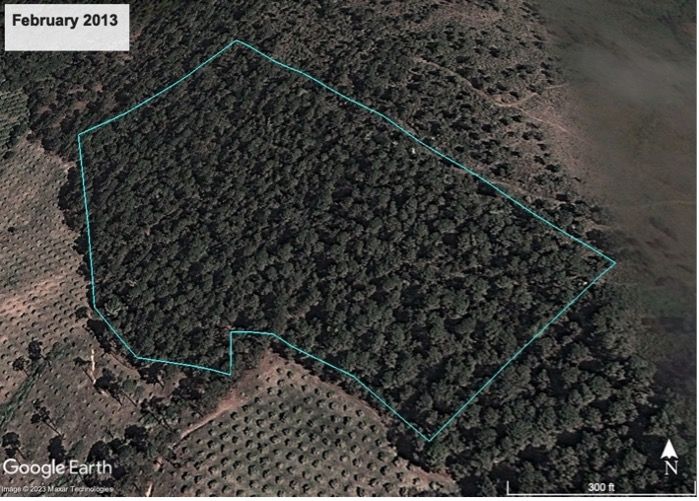


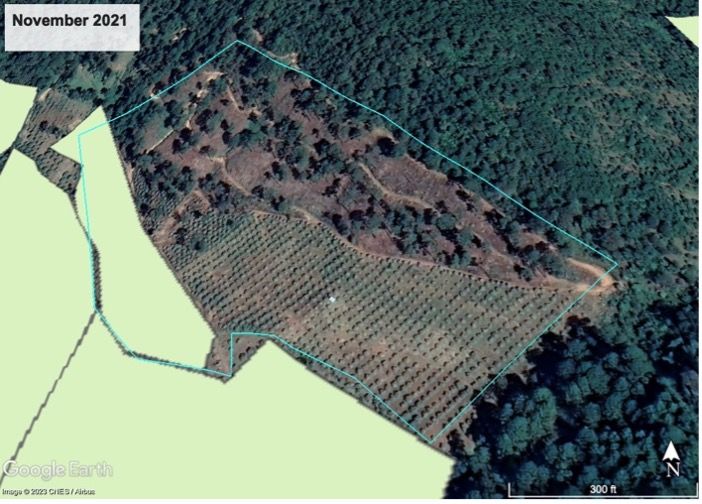
Google Earth satellite imagery of deforestation for avocado orchards in Tancítaro, with light blue outline drawn by Climate Rights International. Top left: February 2013; top right: February 2016 (with charred earth, apparently from fire, visible); bottom left: November 2021; and bottom right: November 2021, with U.S.-export certified orchards as of January 2023 in green. Government shipping records indicate that in 2022, the export-certified orchard within the deforested area outlined in blue supplied 10,690 kilograms of avocados to “Promotora Mexicana Gaitan S.A. de C.V.,” a packinghouse that, according to Mexican customs data compiled by Treid, provided U.S.-based Del Rey Avocado with US$7.8 million worth of avocados between January 2019 and April 2023.494The orchard number is HUE08160838375.
The U.S. and Mexican governments have made climate pledges to work to end deforestation worldwide, including by eliminating deforestation from agricultural commodity production; and both also have an obligation under the United States-Mexico-Canada Agreement (USMCA) trade deal to effectively enforce their environmental laws.
By joining the 2015 Paris Agreement, 196 parties, including the United States and Mexico, have agreed to cut greenhouse gas emissions, with the overarching goal of limiting “the increase in the global average temperature to well below 2°C above pre-industrial levels” and pursuing efforts “to limit the temperature increase to 1.5°C.”495Paris Agreement to the United Nations Framework Convention on Climate Change, Dec. 12, 2016, T.I.A.S. No. 16-1104, art. 1(a). In recent years, global leaders have emphasized the need to hold global warming to 1.5°C by the end of the century, to avoid the most severe consequences of climate change.496UN Framework Convention on Climate Change Secretariat, “What is the Paris Agreement,” https://unfccc.int/process-and-meetings/the-paris-agreement (accessed July 13, 2023).
Under the Paris Agreement, each country is required to submit a plan setting forth its greenhouse gas reduction targets and measures it will take to adapt to the impacts of climate change. These plans, referred to as Nationally Determined Contributions (NDCs), must be updated every five years, with increasingly ambitious targets.
Mexico’s most updated NDC, from November 2022, identifies as priority emissions reduction measures the conservation of ecosystems including forests, and its “commitment to achieve a goal of net zero deforestation.”497Government of Mexico, “Nationally Determined Contribution, 2022 Update,” (“Contribución Determinada a Nivel Nacional Actualización 2022”), November 18, 2022, https://unfccc.int/sites/default/files/NDC/2022-11/Mexico_NDC_UNFCCC_update2022_FINAL.pdf, p. 10 (accessed July 13, 2023). The NDC highlights that, in addition to mitigating climate change, the conservation of forests is also an important adaptation measure for Mexico.
Both the U.S. and Mexican governments have repeatedly committed to halting deforestation globally, including by eliminating deforestation from the production of agricultural commodities. The 2014 New York Declaration on Forests, endorsed by Mexico and the United States that year, committed to at least halving the rate of loss of natural forests globally by 2020 and striving to end the loss by 2030. The declaration also included a commitment to help meet the “private sector goal of eliminating deforestation from the production of agricultural commodities.”498“New York Declaration on Forests,” Climate Action Summit 2014, https://forestdeclaration.org/wp-content/uploads/2021/08/NYDF_Declaration.pdf (accessed July 13, 2023).
At the 2021 Conference of the Parties (COP) to the UN Framework Convention on Climate Change (COP26), the U.S., Mexican, and many other governments again committed “to working collectively to halt and reverse forest loss and land degradation by 2030.”499“Glasgow Leaders’ Declaration on Forests and Land Use,” November 2, 2021. The joint statement—ultimately endorsed by more than 140 governments—pledged to strengthen shared efforts to: “conserve forests”; “facilitate trade and development policies, internationally and domestically, that promote sustainable development and sustainable commodity production and consumption, that work to countries’ mutual benefit, and that do not drive deforestation and land degradation”; and “implement and, if necessary, redesign agricultural policies and programmes to incentivize sustainable agriculture, promote food security, and benefit the environment.”
The Biden administration has announced commitments and policy goals to address commodity-driven deforestation in supply chains. In January 2021, President Biden issued an executive order stating that “it is the policy of my Administration that climate considerations shall be an essential element of United States foreign policy and national security.”500The White House, “Executive Order on Tackling the Climate Crisis at Home and Abroad.” Pursuant to that policy, the administration issued a Plan to Conserve Global Forests: Critical Carbon Sinks, in late 2021, which states as an objective “creating sustainable supply chains, and achieving more sustainable commodity sourcing.”501The White House, “Plan to Conserve Global Forests: Critical Carbon Sinks,” https://www.whitehouse.gov/wp-content/uploads/2021/11/Plan_to_Conserve_Global_Forests_final.pdf, p. 7 (accessed September 15, 2023).
An April 2022 executive order by President Biden reaffirmed his administration’s commitments to “deliver, by 2030, on collective global goals to end natural forest loss.”502The White House, “Executive Order on Strengthening the Nation’s Forests, Communities, and Local Economies,” April 22, 2022, https://www.whitehouse.gov/briefing-room/presidential-actions/2022/04/22/executive-order-on-strengthening-the-nations-forests-communities-and-local-economies/ (accessed July 13, 2023). In response to this executive order, the State Department produced an April 2023 report, Combatting International Deforestation Associated with Agricultural Commodity Production. The report highlights that “decoupling agricultural commodity production from deforestation” is fundamental to achieving the commitment to end forest loss by 2030.503U.S. State Department, “Combatting International Deforestation Associated with Agricultural Commodity Production: A Report for the President In Response to E.O. 14072,” April 26, 2023, https://www.state.gov/wp-content/uploads/2023/05/Tab-2-EO-14072-Report-1-Commodities-FINAL.pdf, p. 4 (accessed July 13, 2023). As part of the report’s release, the State Department publicly reaffirmed that the U.S. government is committed to “addressing both commodity-driven deforestation and the related importation of agricultural commodities sourced from recently deforested land.”504U.S. State Department, “Reporting on Whole-of-Government Approaches to Stopping International Deforestation,” May 31, 2023, https://www.state.gov/reporting-on-whole-of-government-approaches-to-stopping-international-deforestation/ (accessed July 13, 2023).
A key recommendation in the April 2023 State Department report is that the “U.S. government should continue to prioritize monitoring and enforcement of environmental provisions in existing U.S. trade agreements, including those related to effective enforcement of environmental laws.”505U.S. State Department, “Combatting International Deforestation Associated with Agricultural Commodity Production,” p. 11. One such trade agreement is the USMCA, which entered into force on July 1, 2020, replacing the North America Free Trade Agreement (NAFTA).
The “Environment” chapter of the USCMA provides, in Article 24.4:
No Party shall fail to effectively enforce its environmental laws through a sustained or recurring course of action or inaction in a manner affecting trade or investment between the Parties, after the date of entry into force of this Agreement.506United States-Mexico-Canada Agreement, entered into force July 1, 2020, https://ustr.gov/sites/default/files/files/agreements/usmca/24_Environment.pdf, art. 24.4.1. (accessed July 13, 2023) (internal footnotes omitted).
A party is in compliance with this obligation
if a course of action or inaction reflects a reasonable exercise of… discretion, or results from a bona fidedecision regarding the allocation of those resources in accordance with priorities for enforcement of its environmental laws.507Ibid., art. 24.4.2.
If a party fails to carry out this obligation, another party may initiate “dispute settlement” procedures under Article 31 of the USCMA.508United States-Mexico-Canada Agreement, https://ustr.gov/sites/default/files/files/agreements/FTA/USMCA/Text/31 percent20Dispute percent20Settlement.pdf (accessed July 13, 2023).
As analyzed in the following sections, both U.S. and Mexican government policies and practices toward deforestation for avocado production constitute a failure to fulfill their climate and trade commitments and obligations.
Converting forest to agricultural land without a government-issued permit is both a federal crime enforceable in Michoacán and Jalisco, and a state crime in Michoacán, each punishable by between 6 months and 9 years of prison. Unauthorized land-use change is also an administrative violation that is enforced by PROFEPA and subject to potential sanctions ranging from fines and closures, to the confiscation of products, materials, and assets.509General Law for Ecological Equilibrium and Protection of the Environment, arts. 28, 170-71; General Law of Sustainable Forest Development, arts. 93; 155-56. In addition to unauthorized land-use change, the unauthorized logging of trees and illicit provoking of forest fires are separate federal crimes—and also state crimes in Michoacán—as discussed in chapter 2.510Federal Penal Code, arts. 418(III) (land-use change crime), 418(II) and (III) (illegal clearing of trees or destruction of vegetation) and 420 Bis (forest fire crime); Penal Code for the State of Michoacán de Ocampo, arts. 302(III) (land-use change crime), 302(II) and (III) (illegal clearing of trees or destruction of vegetation) and 304(II) and (VII) (forest fire crimes). Impunity is the norm for those who violate these laws in clearing trees to replace them with avocado orchards.
A 2012 government report noted the inefficacy of authorities in containing illegal land-use change:
Since the middle of the 1990s, [the federal environment agency] SEMARNAT has not authorized requests for land-use change from forestlands to agricultural or livestock uses in Michoacán…. So, the [land-use changes] that have been carried out since then have been irregular. That problem has accelerated recently, in the face of the incapacity of regulatory authorities.511INIFAP, “Impact of Land-Use Change From Forest to Avocado,” p. 22.
Senior environmental officials continue to recognize the ongoing impunity. A federal environmental official told Climate Rights International that there has been “total impunity” for land-use change in Michoacán.512CRI interview with environmental official, Morelia, Michoacán, December 16, 2022. The Secretary of Environment in Michoacán said it is unrealistic to expect “prohibiting, monitoring, and punishing” illegal-land use change to be effective in Michoacán, given the weak rule of law.513CRI interview with Alejandro Méndez, Michoacán Secretary of Environment, Morelia, Michoacán, December 16, 2022. The head of the state forest commission said that the violators “laugh at our impotence.” (se burlan de nosotros por inutilidad).514CRI interview Rosendo Caro, General Director of Michoacán State Forest Commission, Morelia, Michoacán, December 15, 2022.
According to the managing director of APEAJAL, the private avocado business association in Jalisco, “what’s lacking is the rule of law. You don’t see producers who deforest paying the consequences.”515CRI interview with Armando Garcia, Managing Director of APEAJAL, Zapotlán el Grande, Jalisco, March 17, 2023
The following two Google Earth images show that avocado growers have been able to establish orchards on illegally deforested land in close proximity to the main prosecutorial unit charged with investigating illegal land-use change in Michoacán: the Specialized Prosecutor’s Office in Combatting Crimes Against the Environment and Fauna.516Most of the land-use change depicted in the images may have predated the establishment of the unit in 2019; however, at least part of the nearby illegal deforestation for avocado would still be obvious—and easily verifiable on Google Earth—to anyone working at the unit. Climate Rights International confirmed in a field visit that one of the orchards is in direct, unimpeded sight from the office.
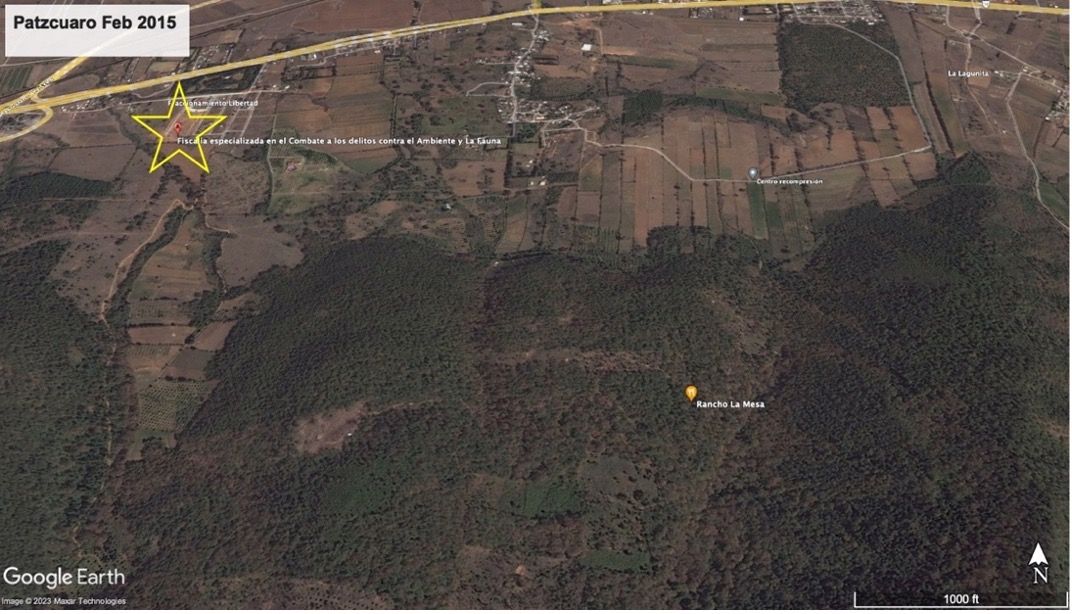

Google Earth images from February 2015 and May 2023. The yellow star denotes the location of the office; the purple outlines show deforestation sites for orchards; and the blue polygons shows areas that have already been certified for U.S. export
The main prosecutor’s office in Mexico dedicated to investigating deforestation for avocado in Michoacán is the Specialized Prosecutor’s Office in Combatting Crimes Against the Environment and Fauna (“Environment Unit”), within Michoacán’s State Prosecutor’s Office.
Climate Rights International submitted five requests under Mexico’s transparency law about the results of the Environment Unit’s investigations, with each successive request seeking clarifications to prior responses. The responses strongly appeared to be inaccurate and to exaggerate the unit’s success, including the claims that it has pressed charges in 80 percent of cases of land-use change, illegal logging, and forest fires, and that 90 percent of cases of land-use change and illegal logging from 2019, 2021, and 2022 ended in the “conditional suspension of the case.” (A “conditional suspension of the case” occurs when the prosecution is closed in exchange for the accused complying with various conditions, including repairing the harm.517National Code of Criminal Procedure (Codigo Nacional de Procedmientos Penales), 2014, https://www.diputados.gob.mx/LeyesBiblio/pdf/CNPP.pdf, art. 191 (accessed July 13, 2023).)
First, the responses contained dramatically inconsistent statistics.518In a January 10, 2023 response, the Environment Unit stated that it had initiated investigations into the crimes of land-use change, illegal logging, or forest fires in 30 cases that occurred in 2019, 50 cases that occurred in 2020, 80 cases that occurred in 2021, and 100 cases that occurred in 2020. The unit claimed that in 80 percent of these 260 cases, at least one person has been charged (“imputado”). It also claimed that 90 percent of cases of land-use change and illegal logging from 2019, 2021, and 2022 ended in the “conditional suspension of the case.” It reported that just one case, of land-use change, had resulted in a conviction after trial. Transparency law response by Michoacán State Prosecutor’s Office to request number 162155723000018, January 10, 2023 (noting that the data was provided by the Environmental Unit). In a February 13, 2023 response, the unit stated that 0 cases of land-use change or illegal logging from 2019 resulted in the “conditional suspension of the case”; 10 cases of land-use change from 2020 and 10 cases of illegal logging from 2020 resulted in the “conditional suspension of the case”; 20 cases of land-use change from 2021 and 20 cases of illegal logging from 2021 resulted in the “conditional suspension of the case”; and 30 cases of land-use change from 2022 and 30 cases of illegal logging from 2022 resulted in the “conditional suspension of the case.” In all these cases, the unit said that reforestation was the reparation required in exchange for the conditional suspension. Transparency law response by Michoacán State Prosecutor’s Office to request number 162155723000062, February 13, 2023 (noting that the data was provided by the Environment Unit). In an April 13, 2023 response, the unit stated that it received complaints for land-use change in 5 cases in 2019, 80 cases in 2020, 85 cases in 2021, 90 cases in 2022, and 8 cases between January and April 13, 2023. Of those 268 land-use change cases, it said none from 2019 were in the initial investigation state; 10 from 2020, 8 from 2021, none from 2022, and 8 from 2023; that none have been closed (“archivados”) or had declined prosecution; and five has resulted in a sentence after an abbreviated procedure, none had resulted in a conviction after a trial. Notably, it claimed that “80 percent of 250 files”—meaning 200 cases—result in the “conditional suspension of the case.” Transparency law response by Michoacán State Prosecutor’s Office to request number 162155722000254, April 13, 2023 (noting that the data was provided by the Environment Unit). A February 13 response says 60 cases of land-use change between 2019 and 2022 resulted in the “conditional suspension of the case.” However, an April 13 response says that 200 cases did.519The 8 complaints from 2023 were all in the preliminary investigation state, according to the response. The prosecutor’s office declined to provide any copies of the resolutions declaring the “conditional suspension of the case,” which they said could only be accessed by parties to the case.520Transparency law response by Michoacán State Prosecutor’s Office to request number 162155723000099, February 14, 2023.
Second, the statistics provided by the Environment Unit conflict with data provided, in response to transparency law requests, by the Michoacán court system, which recorded far fewer conditional suspensions for land-use change cases than the number claimed by the prosecutor’s office. If a conditional suspension has been granted, there is reason to believe courts should have a record of it, because judges set the terms of and approve the suspensions. The Michoacán Judicial Branch reported only 22 instances of conditional suspensions for land-use change between 2015 and 2023—9 from 2019 and 13 from 2021.521Transparency law response by Michoacán Judicial Branch to request number 160341823000081, March 30, 2023. The courts reported 41 instances of conditional suspensions for illegal logging—5 from 2020, 6 from 2021, 28 from 2022, and 2 from 2023—again, fewer than the 60 claimed by prosecutor’s office’s February 13 response.
Third, a senior official told Climate Rights International that, as part of their job, they know when criminal investigations into illegal land-use change are opened in Michoacán, and that 90 to 99 percent of the cases do not advance.
Finally, the Environment Unit’s reported statistics are at direct odds with the broad consensus Climate Rights International found, among state and federal officials, as well as residents, of rampant impunity for illegal deforestation for avocado in Michoacán.
Climate Rights International received testimony from multiple state and federal officials and residents that point to a corruption problem within the Environment Unit of the Michoacán State Prosecutor’s Office. The testimonies suggest that officials have repeatedly received bribes in exchange for dropping investigations and prosecutions of illegal land-use change for avocados. In the words of one senior official, the state prosecutor’s office is a “nest of corruption” (bola de corrupción), where cases of illegal deforestation didn’t advance despite blatant evidence of illegality.522CRI interview with official, Morelia, Michoacán, April 17, 2023 (name withheld).
Some Michoacán residents told Climate Rights International that they believed that reporting illegal land-use change to the prosecutor’s office was pointless because of corruption. Others said they had been told by workers on avocado orchards located on illegally deforested land that bribes had been made to prosecutors in exchange for letting the orchards continue to operate. Climate Rights International reviewed one criminal complaint from 2021 in which another Michoacán resident stated that an avocado grower who had cleared trees announced to community members that he had paid the prosecutor’s office and PROFEPA not to act.523Complaint filed by community leader with Federal Prosecutor’s Office, 2021 (exact date withheld).
According to information provided to Climate Rights International by the Federal Prosecutor’s Office, between 2013 and 2022, federal prosecutors in Michoacán opened investigations into 58 cases of land-use change and filed charges in nine of them. During this period, they also opened investigations into 318 cases of illegal logging, filing charges in 50.524Transparency law response from Federal Prosecutor’s Office to request number 330024623000047, February 21, 2023. (There could be overlap between the two sets of cases, as a single incident of clearing forest for agricultural purposes could be charged as both illegal land-use change and illegal logging.)
In Jalisco, where illegal land-use change and logging are exclusively prosecuted as federal crimes, federal prosecutors have closed, without any results, the vast majority of investigations into land-use change and illegal logging in the state. They reported having already closed, without results, 19 of the 24 cases of land-use change, and 70 of the 71 cases of illegal logging, that they initiated in Jalisco between 2015 and March 2023.525Transparency law response from Federal Prosecutor’s Office to request number 33024623001610, June 7, 2023.
In response to requests about how many charges in Michoacán and Jalisco had ultimately resulted in a sentence after a trial, or a conditional suspension or sentence after an abbreviated procedure, federal prosecutors told Climate Rights International to ask the judiciary, which in turn directed us to a database that produced zero records of any such resolutions to the cases.526Federal prosecutors said to request that information from the Council of the Federal Judiciary. The Council of the Federal Judiciary, in turn, responded to CRI’s requests that the sentences are available in a public database, and provided instructions for searching the database. Transparency law response by Council of the Federal Judiciary to request number 330030423002456, March 28, 2023; transparency law response by Council of the Federal Judiciary to request number 330030412002516, April 3, 2023. Following the instructions, CRI found zero sentences in the database for land-use change or illegal logging in Michoacán or Jalisco. Council of the Federal Judiciary, “Consult Sentences Emitted in the Accusatory Penal Justice System,” (“Consulta de Sentencias Emitidas en el Sistema de Justicia Penal Acusatorio”), https://www.cjf.gob.mx/CJPF/sentencias/Consulta.aspx?AspxAutoDetectCookieSupport=1 (accessed July 13, 2023). The instructions were to go to this database, filter for “ecological equilibrium crimes” and search for the penal code number of the crimes.
Under Mexican federal environmental laws, unauthorized land-use change is an administrative infraction, subject to investigation and sanction by the SEMARNAT, through its PROFEPA agency.527General Law for Ecological Equilibrium and Protection of the Environment, arts. 28, 156; General Law of Sustainable Forest Development, arts. 155-56. Potential sanctions include fines; temporary or permanent closure; administrative arrest; forfeiture of the instruments, products or subproducts directly related to the infractions, and machinery equipment, tools and transportation used to commit the infraction; and restorative measures in the affected area.
Most instances of illegal land-use change for avocado production in Michoacán and Jalisco have not resulted in PROFEPA investigations, and thus have not been sanctioned by the agency. When PROFEPA has investigated and meted out sanctions, they were usually fines and/or closures.528PROFEPA reports that it imposed sanctions in 186 cases of unauthorized land-use change in Michoacán between 2017 and 2022, all but three of which involved at least fines. PROFEPA also reported that it had carried out either temporary or permanent “closures” in 233 cases in Michoacán between 2017 and 2022; and imposed unspecified “corrective measures” in 193 cases. Transparency law response by PROFEPA to request number 330024423000035, February 1, 2023. For Jalisco, PROFEPA reports that it imposed sanctions in 32 of 137 cases in which it received complaints of illegal land-use change in Jalisco between 2017 and 2022. All 32 involved at least fines. It reported temporary or permanent “closures” in 97 cases in Jalisco; and unspecified “corrective measures” in 55. Transparency law response by PROFEPA to request number 330024423000036, February 17, 2023. Both data sets include any type of land-use change, and do not break down which ones are for avocado production, though interviews with officials indicate avocado-related cases constitute a significant portion of the dockets. PROFEPA only twice imposed the more severe sanction of forfeiture of products or instruments directly related to the infraction in Michoacán and Jalisco land-use change cases between 2017 and 2022. In the avocado context, this could entail seizing avocado plantings, avocados, and machinery, equipment, and infrastructure in orchards.
The ongoing, unimpeded clearing of forests for avocado orchards shows that the prospect of PROFEPA sanctions is not broadly deterring these illegal acts. Nor are the sanctions sufficient to stop the sanctioned growers from producing avocados on the orchards, and thus carrying out the intended purpose of the environmental crime. Fines appear to essentially be a cost of doing business, and closures often amount to little more than posting “closed” (clausurado) signs at the orchards, which are routinely disregarded by the growers.
The ineffectiveness of PROFEPA sanctions is evidenced by the examples Climate Rights International identified in the field of “closed” orchards continuing to operate. For instance, the following images are of a roughly 500-acre tract of land in Salvador Escalante, Michoacán, which evidence indicates was illegally deforested in 2017, and subsequently covered in avocado plantings. Climate Rights International visited the property in the first quarter of 2023 and took the first three images then. The first image, top left, shows PROFEPA’s “closed” sign inside the fencing of the property. The second image, top right, shows small avocado plantings inside the property. The third image shows a tractor, outlined in a yellow circle, working within the fenced property, despite PROFEPA’s “closed sign.” Climate Rights International visited the property again in October 2023, and again saw the “closed” sign” and a man on a tractor working inside the property. (CRI did not see any fencing separating the planted areas, and area where the tractor was spotted, from where the “closed” sign was, so they all appear to be the same orchard.)
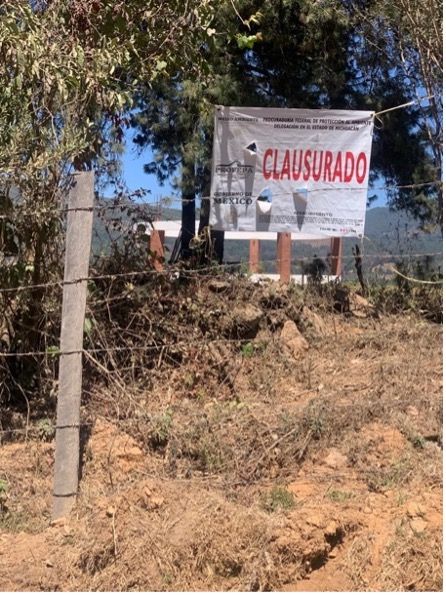


Photographs taken by Climate Rights International in 2023.
The three Google Earth images below show, outlined by Climate Rights International in yellow, the area of avocado production where we visited and took the photographs above. The images show avocado crops replacing cleared trees and vegetation on the tract of land, as well as an apparent fire in 2017, evident in charred ground. The orchard is surrounded by U.S.-export approved orchards, and could very well become certified once it starts producing.
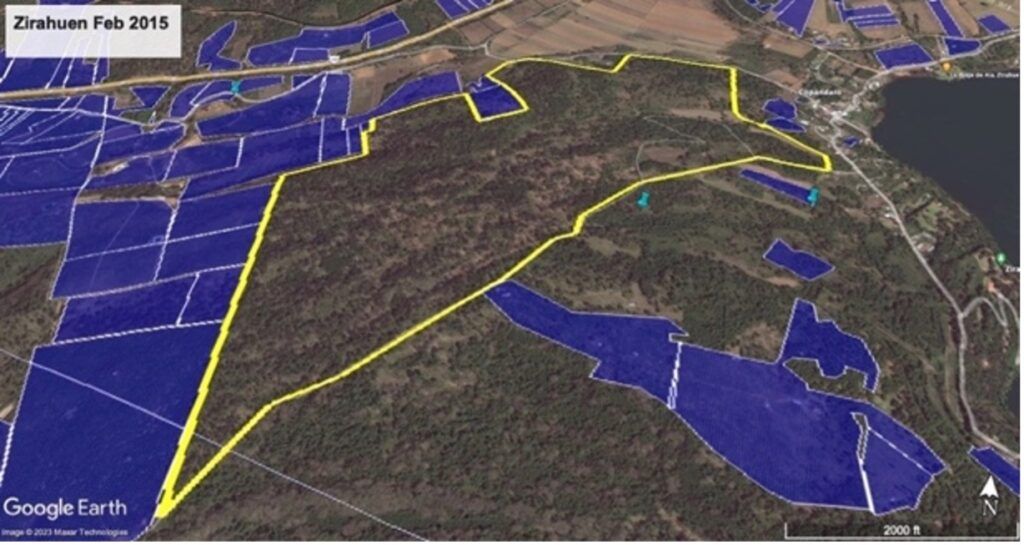


Google Earth images
The photograph below was taken by residents of Madero in 2019, and shows a truck entering an avocado orchard, despite what appears to be PROFEPA’s “closed” sign at the gate.

Photograph provided by Madero residents
Further evidence of the inefficacy of PROFEPA’s sanctions are the numerous orchards Climate Rights International identified that were certified to export to the United States as of January 2023,529Transparency law response from SENASICA to request number 330028323000032, January 23, 2023. despite overlapping with locations where PROFEPA reports it had imposed sanctions at some point between 2015 and 2022 for illegal land-use change.530The GPS coordinates of the sanctions were provided in transparency law response by PROFEPA to request number 330024423000035, February 7, 2023. In the response, PROFEPA did not report imposing sanctions of any kind in 2023.
For each sanctioned piece of land, PROFEPA provided one GPS coordinate, represented by a single light blue pin in the maps below. In the examples below, the pins are located within the boundaries of orchards certified to export to the United States as of January 2023—or in one case, about 13 feet away, on a road next to the boundary. Because PROFEPA did not provide GPS coordinates for the full area of the sanctioned property, or the size of the property, Climate Rights International cannot conclusively verify the extent to which the sanctioned area overlaps with the area of the certified orchard. However, in the examples below, the location of the sanction pins within the orchard indicate a likelihood of at least some overlap between the sanctioned area and the certified orchard, and at a bare minimum indicates that orchards containing illegally deforested land are being certified for export even though they are right next to orchards recently sanctioned for illegal land-use change.
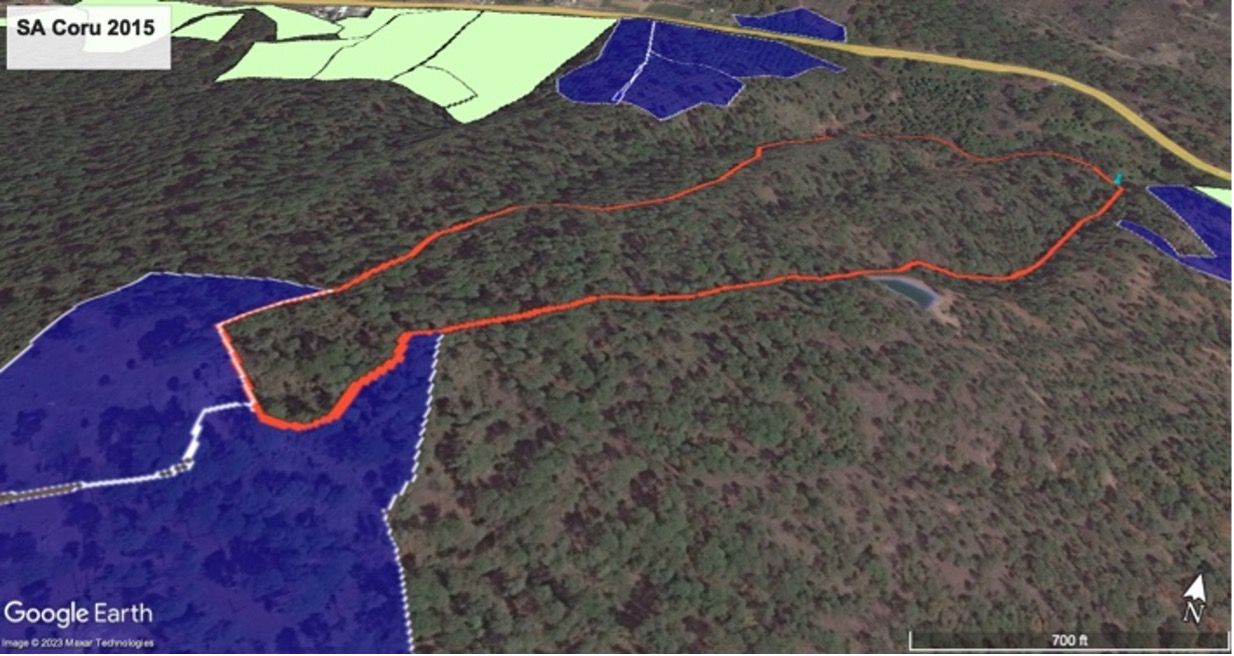
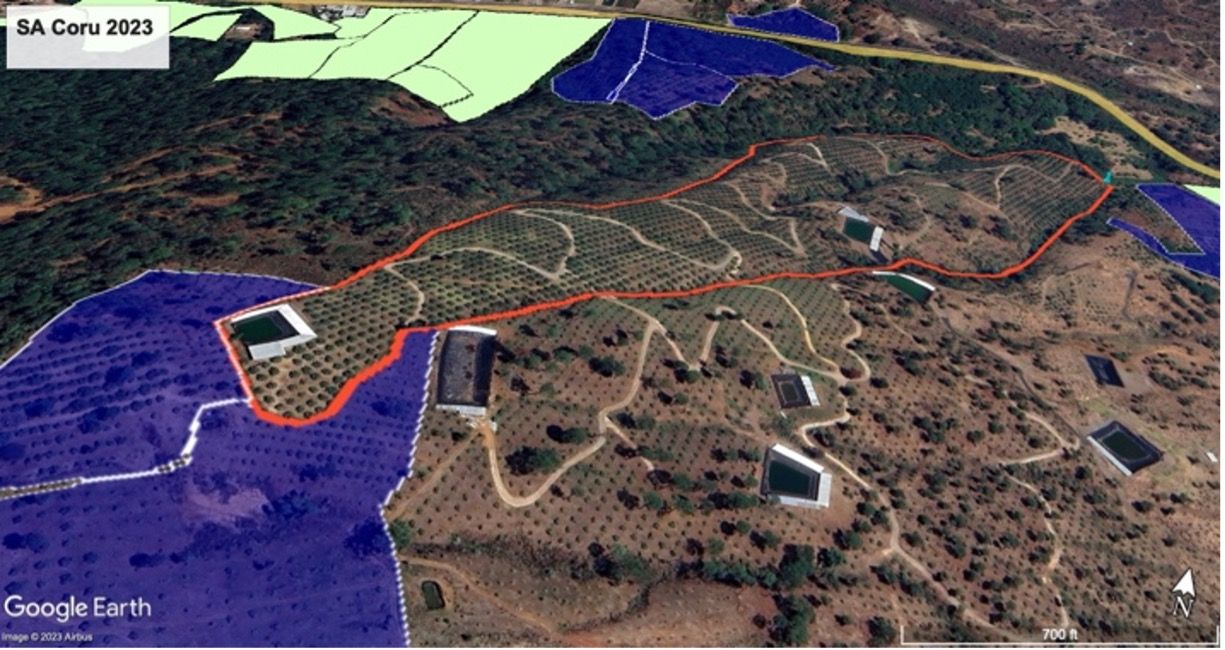
Google Earth images. U.S.-export approved orchards in shaded blue, green, and outlined in red. Light blue pin showing PROFEPA sanction in top right corner of red-outlined orchard. This orchard was deforested starting in 2016, and in 2022, supplied 11,770 kilograms of avocado to Mission Produce and 24,900 kilograms to Del Monte.531The orchard is HUE08161114299.
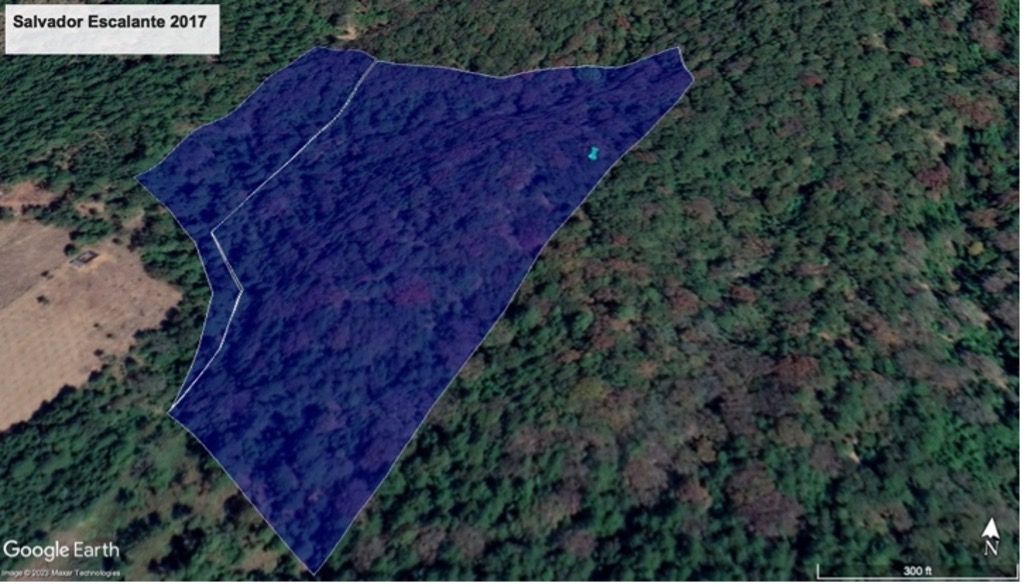

Google Earth images. The dark blue polygons, divided by a white line, show two U.S.-export approved orchards. The light blue pin, in the top middle of images, is a GPS point indicating where PROFEPA said it imposed sanctions for illegal land-use change.
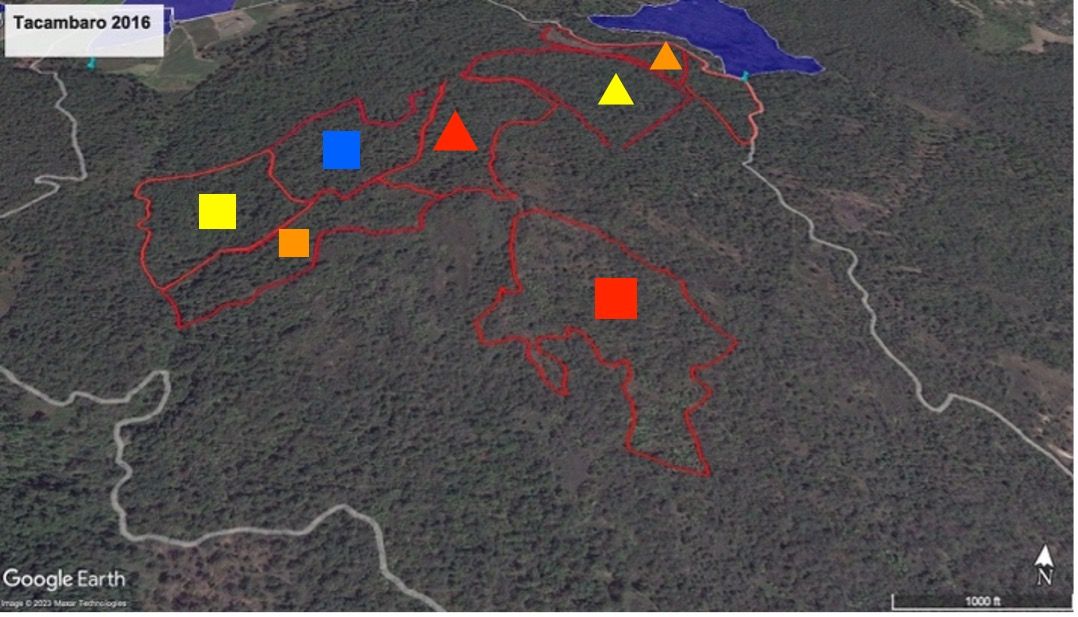
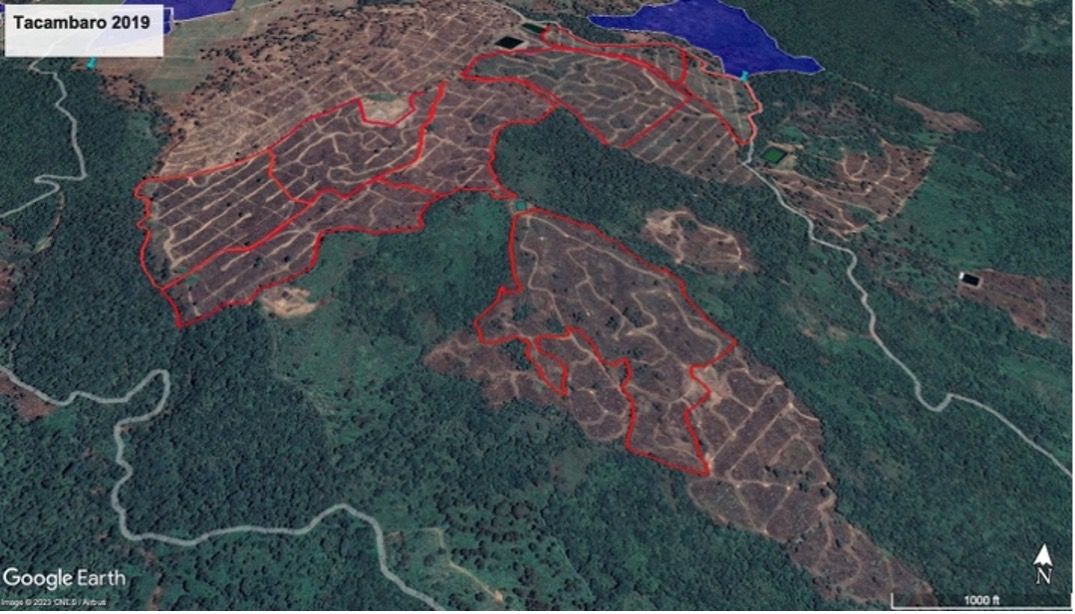
Google Earth images. The orchards outlined in red, as well as the darker blue polygons, are U.S.-export approved orchards. The light blue pin, showing where sanctions were imposed, is in top-right corner. Government shipment records indicate that in 2022:
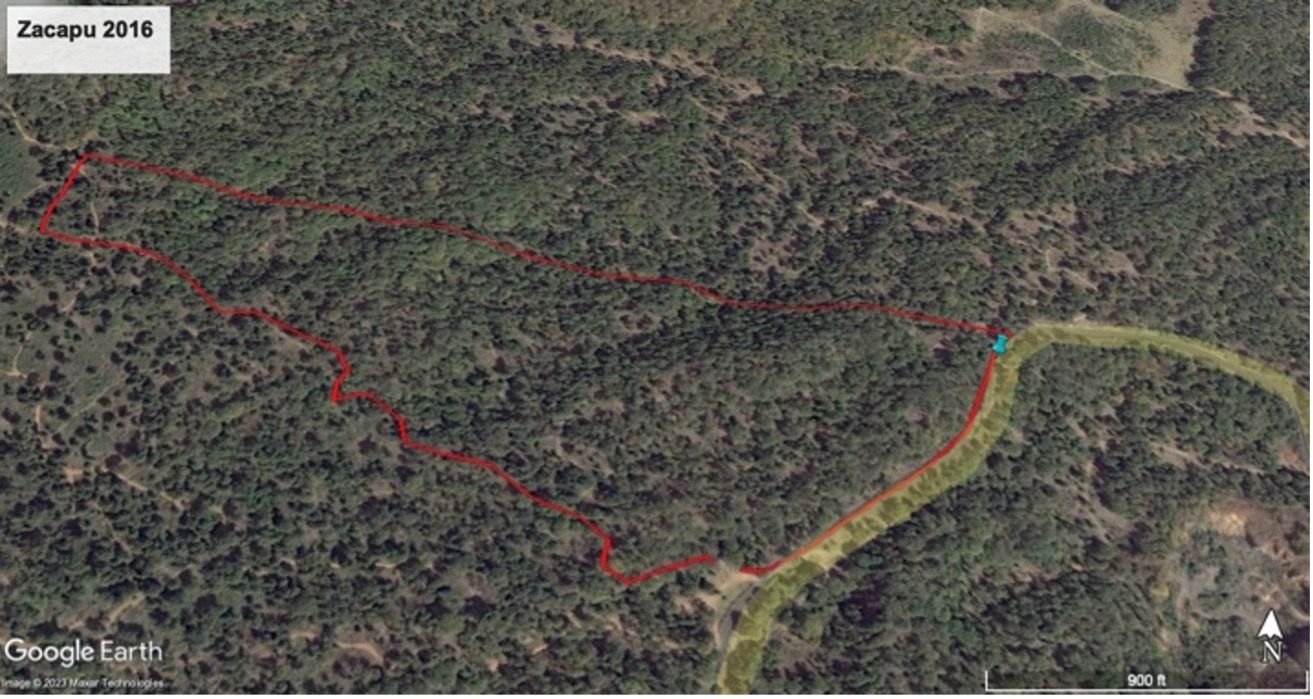
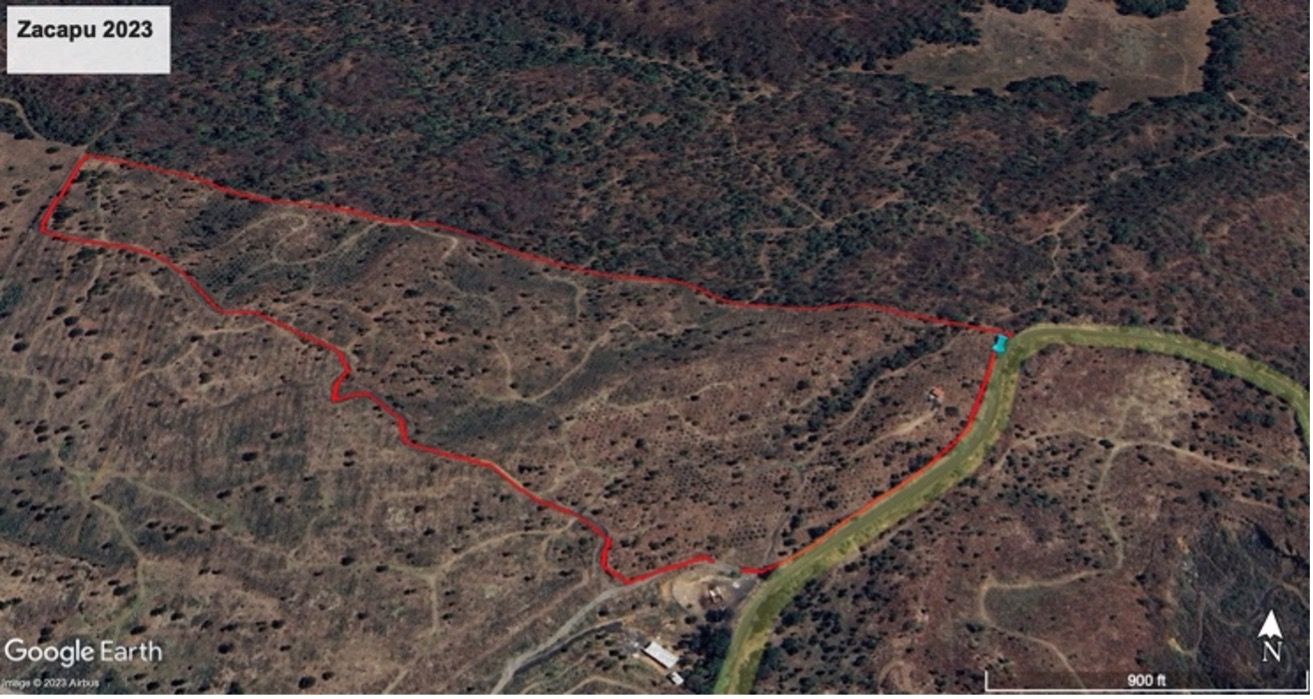
Google Earth images. U.S.-export approved orchard outlined in red. Light blue pin showing PROFEPA sanction in top right corner.

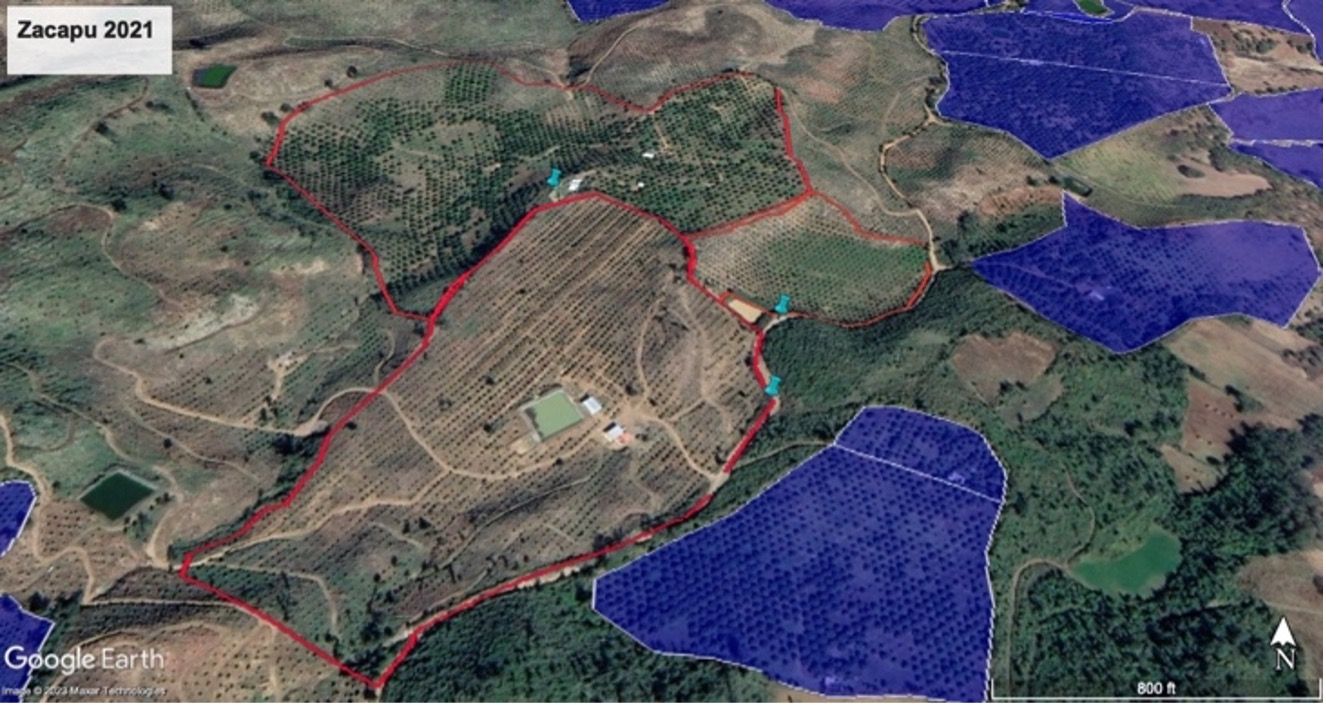
Google Earth images. U.S.-export approved orchards in blue and outlined in red; three PROFEPA sanctions points in middle in light blue pins. In 2022, the orchard at the top—which is denoted by a yellow star and has a sanction pin within its boundaries—supplied Mission Produce with 7,160 kilograms of avocado and Fresh Del Monte with 2,456, according to government shipping records.540The orchard number is HUE08161070041. For the other two orchards, the sanction pins are located directly next to, but not inside, the boundaries.
CONAGUA, the federal agency charged with investigating and sanctioning unlicensed water use,541National Water Law, art. 9(XXXVI). reported receiving 896 complaints of unlicensed water use in Michoacán between 2017 and January 2023, and an additional 106 complaints of the unlicensed installation of wells or other mechanisms for extracting underground water.542Transparency law response by CONAGUA to request number 330009423000104, February 21, 2023. (Complainants reporting unlicensed water use or illegal deforestation can request that their identity be maintained secret, for security reasons.543National Water Law, art. 124 Bis (referring to General Law for Ecological Equilibrium and Protection of the Environment Chapter VII).) It reported imposing sanctions in only 24 cases from that period—fines, closures, and in four cases, seizures of machinery.
An official from CONAGUA’s Michoacán office said it has only one inspector for the entire state. They said that the office orders the “closure” of the illegal extraction, but that it is the central CONAGUA office in Mexico City that is in charge of implementing the closure process to ensure that the extracting infrastructure is disassembled.544CRI interview with CONAGUA official, Morelia, Michoacán, March 6, 2023 (name withheld). They said the last time officials from Mexico City visited for that purpose was in 2018. As for the fines, they said they are 184,000 pesos (US$10,337), regardless of the quantity of water illegally extracted.
The Organismo de Cuenca Lerma Santiago Pacífico, which conducts inspections for CONAGUA in Jalisco, reports having received 400 complaints for unlicensed water use between 2017 and January 2023.545Transparency law response by CONAGUA to request number 330009423000104, February 21, 2023. For that period, CONAGUA reported 28 site inspections of possible unlicensed above and below-ground water use and works, such as wells, to extract underground water. For January 2022 to January 2023, it reported only 12 sanctions imposed in what appeared to be 8 cases.
The government’s failure to enforce the law to prevent water theft violates Mexico’s obligation to adopt necessary and effective measures to prevent third parties from “inequitably extracting from water resources.”546UN Committee on Economic, Social and Cultural Rights (CESCR), General Comment No. 15, The Right to Water, U.N. Doc. E/C.12/2002/11(2003), para. 23.
The U.S. government closely regulates the importation of avocados from Mexico, maintaining a list of all the orchards that are allowed to sell to U.S. markets, which it updates twice a year. It deploys scores of inspectors to visit every single new orchard, twice a year, to make sure they are in compliance with detailed pest-control requirements. If any is found to be out of compliance, it can be decertified.547SENASICA, “Operational Work Plan (OWP).
When one of these inspectors was threatened in Michoacán in early 2022—apparently after discovering out-of-state avocados being passed off as produced in Michoacán—the United States shut down all avocado imports from Mexico for one week.548USDA-APHIS, “Fresh Avocado Imports from Mexico Resume,” Feb. 18, 2022, https://www.aphis.usda.gov/aphis/newsroom/stakeholder-info/sa_by_date/sa-2022/avocado-imports-mexico (accessed July 21, 2023). The United States lifted the ban a week later after Mexican authorities promised to take more safety measures for the inspectors.
In short, when it comes to the avocado trade, the U.S. government has exercised its regulatory authority to advance U.S. interests and policy goals in several areas, including promoting pest control and the security of its workers. But it has neglected to use the authority to uphold other fundamental policy commitments and goals: reducing deforestation, fighting climate change, and promoting the human rights of communities in Michoacán and Jalisco.
This neglect does not stem from ignorance of the environmental and human rights harms associated with avocado production, which have been reported on repeatedly for years by prominent media outlets, NGOs, academics, and Mexican government agencies.549See, e.g., Mexico’s National Institute for Forestry, Agriculture and Livestock Research (INIFAP), “Impact of Land-Use Change From Forest to Avocado,” (2012); Haroon Siddique, “Rising avocado prices fueling illegal deforestation in Mexico,” The Guardian, August 10, 2016, https://www.theguardian.com/lifeandstyle/2016/aug/10/avocado-illegal-deforestation-mexico-pine-forests#:~:text=The%20popularity%20of%20the%20avocado,to%20plant%20young%20avocado%20trees (accessed November 7, 2023); Mark Stevenson, “In Mexico, High Avocado Prices Fueling Deforestation,” Associated Press, August 10, 2016, https://apnews.com/article/plants-mountains-mexico-forests-trees-9176bc7479e048508203f10a68da6fa7 (accessed September 19, 2023); Mark Stevenson, “Mexico: Deforestation For Avocados Much Higher Than Thought,” Associated Press, Oct. 31, 2016, https://apnews.com/f3077e3318b24e1db1f373ab71043124/mexico-deforestation-avocados-much-higher-thought (accessed September 19, 2023); Victoria Burnett, “Avocados Imperil Monarch Butterflies’ Winter Home in Mexico,” The New York Times, Nov. 17, 2016, https://www.nytimes.com/2016/11/18/world/americas/ambition-of-avocado-imperils-monarch-butterflies-winter-home.html (accessed September 19, 2023); “Editorial: There’s Blood in Your Guacamole,” Los Angeles Times, Dec. 6, 2019, https://www.latimes.com/opinion/story/2019-12-06/avocado-cartels-satisfy-our-hunger (accessed September 19, 2023); Mauricio Mondragón and Valeria López Portillo Purata, “Will Mexico’s Growing Avocado Industry Harm Its Forests,” World Resource Institute, February 4, 2020, https://www.wri.org/insights/will-mexicos-growing-avocado-industry-harm-its-forests (accessed September 19, 2023); Suzanne O’Connell, “The Avocado in Your Super Bowl Guacamole is Bad for the Environment. You can Make it Better,” The Washington Post, February 4, 2021, https://www.washingtonpost.com/climate-solutions/2021/02/04/climate-solutions-avocados/ (accessed September 19, 2023). Indeed, internal memos and emails obtained by Climate Rights International show high-level U.S. officials being made aware that the industry is driving illegal deforestation and has links to organized crime.
Nor is the neglect due to logistical difficulties: The U.S. government maintains maps, with GPS coordinates, of all U.S.-export approved avocado orchards in Michoacán and Jalisco. With minimal effort, it could identify deforestation-tainted U.S.-export orchards, just as Climate Rights International did with the same maps for this report.
The U.S. government could enact a policy to exclude these easily identifiable deforested orchards from export certification. Barring the certification of deforested, or even just illegally deforested, avocado orchards, would be in keeping with the U.S. government’s climate commitments to work toward ending global deforestation, “facilitate trade…policies… that promote… sustainable commodity production… and that do not drive deforestation,”550“Glasgow Leaders’ Declaration on Forests and Land Use,” November 2, 2021. and to address “the importation of agricultural commodities sourced from recently deforested land.”551U.S. State Department, “Reporting on Whole-of-Government Approaches to Stopping International Deforestation.” Focusing on illegal deforestation would also advance U.S. foreign policy goals to support the rule of law and efforts to root out corruption.
But the United States has not sought to adopt any such export requirements. In fact, Climate Rights International obtained documents through Mexico’s transparency law suggesting that U.S. officials have disregarded requests from senior Mexican officials to include an environmental requirement in the bilateral avocado export agreement between Mexico and the United States.
In 2021, Mexican officials from CONAFOR, SEMARNAT, and SADER, federal environmental and agricultural agencies, came up with a proposal to modify the bilateral agreement, called the Operational Work Plan (OWP), to exclude from export “those orchards that have had illegal land-use change.”552Transparency law response from SEMARNAT to request number 330026723001262, May 15, 2023. The Director General of CONAFOR and a senior SEMARNAT official sent a letter to a regional director for the USDA’s APHIS branch, on June 29, 2021, requesting a meeting to discuss the proposal.553Letter from León Jorge Castaños Martínez, General Director of CONAFOR and Arturo Argueta Villamar, Deputy-Secretary for Planning and Environmental Policy for SEMARNAT, to Darya Chehrezad, “Regional Director USDA-IS-México,” June 29, 2021 (marked received by USDA-APHIS on July 14, 2021), obtained in transparency law response from SEMARNAT to request number 330026723001262, May 15, 2023. The letter states that the Mexican agencies have been collaborating to establish strategies to avoid deforestation for avocado crops and “promote compliance with environmental norms in the production of avocado.”554Ibid. Among those actions, the letter states, is a “proposal to modify the [OWP]” governing the export certification process for avocado, by including an “addendum.” A Mexican official involved in the process confirmed that the “addendum” referenced in the letter was to not certify orchards on illegally deforested land.555CRI interview with official, 2023 (name and location and exact date withheld).
Climate Rights International requested from CONAFOR, SEMARNAT, and SADER copies of communications between the agencies and U.S. authorities about the proposal. The only communications provided were an email chain between August 20 and 26, 2021.556Transparency law response by CONAFOR to request number 330009623000174, April 27, 2023. An August 20 email from CONAFOR to USDA-APHIS officials asked if they knew the status of the document sent to USDA about the protocol for exporting avocados to the United States. An APHIS official responded on August 24 stating that the official to whom the letter had been addressed had ended her service in Mexico, and the letter would be directed to the new APHIS regional director and agricultural attaché. There are no further communications from U.S. officials in the information provided to Climate Rights International by the Mexican agencies. And to date, no modification has been made to add environmental requirements to the OWP.
Meanwhile, the United States continues to certify thousands of acres of orchards located on illegally deforested land, including plots where PROFEPA has imposed sanctions for land-use change.
The U.S. government’s authorization of Jalisco to export avocados to the United States is another example of the U.S. government’s failure to act on the harms of Mexican avocado production, and failure to adhere to its commitments and goals regarding deforestation. The United States approved Jalisco without taking any measure to address the serious, known deforestation and human rights risks of doing so.
The opening of U.S. markets to Jalisco avocados strongly appears to have been in exchange for opening Mexican markets to U.S. potatoes, for which the U.S. potato industry had long been lobbying. The apparent U.S. potato-Jalisco avocado quid pro quo shows that the United States has significant discretion in its policy towards Mexican avocado exports. So far, the United States has exercised this discretion to benefit agribusiness, rather than protect the environment and human rights—a common problem that extends far beyond avocado and deepens the climate crisis.
The following timeline of events illustrates the U.S. government’s willful disregard of the environmental and human rights consequences of its approval of avocado exports from Jalisco:
On Wednesday January 18 the Mexican potato producers submitted a writ and a judge granted it, consequently the import of potatoes to Mexico was stopped…. The U.S. government’s position is that if its potato does not enter Mexico, then avocado will not enter that country because it does not comply with the fact that was agreed between the two governments.562Ibid.
puts U.S. fresh potatoes one step closer to finally gaining access to Mexico following nearly 20 years of negotiations…. [The issue] was something I prioritized as Secretary between 2009-2016 and one of the first issues I discussed with Mexico’s Secretary of Agriculture when I returned this year. U.S. industry representatives estimate that implementation of full market access for U.S. potatoes could increase U.S. exports from approximately $50 million in 2020 to $150 million or more.565USDA Foreign Agricultural Service, “Statement from Secretary Vilsack on Mexico Ruling in Favor of U.S. Potato Growers,” April 28, 2021, https://www.fas.usda.gov/newsroom/statement-secretary-vilsack-mexico-ruling-favor-us-potato-growers (accessed July 13, 2023).
[A]ttached is a letter to Amb. [to Mexico] Salazar with cc: to [USTR Rep] Amb Tai dated 13 September 2021 from an individual documenting their repeated attempts to have state and federal agencies intervene to prevent the taking and subsequent illegal logging on their property in the state of Jalisco, Mexico. They report 59 hectares were illegally cordoned off, logged/cleared, and then replanted with avocados. The embassy received the letter….568Email from Hector Aguirre, with State Department email address, to Sara B. Lopp, USTR Director for Environment & Natural Resources and other State Department and USTR officials, October 1, 2021, obtained via FOIA request from USTR.
The Office of Environment and Natural Resources is the branch of the USTR that carries out its duty to monitor compliance with the requirement in the United States-Mexico-Canada Agreement (USMCA) that the countries effectively enforce their environmental laws.569Office of the USTR, ”Bilateral and Regional Trade Agreements,” https://ustr.gov/issue-areas/environment/bilateral-and-regional-trade-agreements (accessed October 23, 2023).
The letter, from a widowed mother and her daughter, begins by stating that in January 2021, they were visited in their family home in Jalisco by a man who said “unidentified third parties” were interested in acquiring part of the land on their property. When told they did not want to sell, the man said that “if it was not sold , it would be taken or stolen.”572Letter from Jalisco family to Ken Salazar, U.S. Ambassador to Mexico and Katherine Tai, U.S. Trade Representative, September 13, 2021 (translated by U.S. government), obtained via FOIA request from USTR. In the following days, the family filed a complaint with prosecutors for “having been the object of threats by persons who intend to use force to oblige us to sell them fractions or the totality of our property… in order to cut down all the trees, change the use of the forest land and put it to use growing avocados.”
The letter further states that, in July 2021, the family expanded their initial complaint to prosecutors, since neighbors had informed them “that there were armed people inside the property cutting down trees, burning and extracting wood with machinery and trucks.” The family went to the site and confirmed that a new fence had been installed changing the boundaries of the property “and that unknown people were indeed cutting down trees without our authorization, burning and extracting wood with machinery and trucks.” They also filed complaints with federal environmental authorities, including PROFEPA, and asked the State Coordination of the National Guard to intervene, “due to our concern for the danger to our personal and physical safety.” None of these authorities had acted in response to their complaints and requests for intervention.
The letter states that more than 145 acres (59 hectares) of their property had been invaded and deforested, despite, as their letter puts it, “our constant refusal to sell some fractions or the totality of the land of our property… to various messengers that have approached us.”
The letter states that the land invasion for avocado is part of a pattern in the region:
My daughter and I face each day alone – since my husband died a few years ago – this whole series of illegal acts carried out by criminals who are commonly known as “los aguacateros” [the avocado growers], and are plaguing the owners of the land in the region…. [O]nce they have taken possession of the piece of land, they proceed to illegally – since they do not have authorization to do so – cut down indiscriminately with machinery all existing tree species, to extract the wood in trucks and sell it…. [A]nd once the land is cleared of trees, they change the use of the land without any authorization and immediately set up avocado plantations, mainly for their export.
The letter to Ambassadors Salazar and Tai closes by underscoring “the pattern of omissions in the effective enforcement of environmental legislation” in Mexico, with the consequence of, “in the possible near future, the entry into [the United States] of large quantities of avocado from orchards whose origin and operation have criminal roots.” The letter urges that, “to discourage this harmful practice, U.S. authorities should require Mexican avocado exporters to prove that the product comes from legally constituted and operating orchards.”573Ibid.
The family and its lawyers told Climate Rights International that after sending the letter, they never received any response from U.S. authorities, or any indication from Mexican authorities that U.S. authorities had contacted them about the case.574CRI telephone interviews with family and lawyers, March 31, 2023 and April 4, 2023; CRI interview with lawyers, Jalisco, April 18, 2023 (names and location withheld).
In Mexico, environmental defenders (ED) are subject to intimidation, arrest, disappearances, and death…. Impunity for crimes against EDs is high, with 95 percent of murders resulting in no prosecutions… [I]llegal logging was linked to nearly a third of ED attacks…. Drug cartel competition over illegal logging pervades the multibillion-dollar avocado industry.581Ibid.
In May 2023, the same case detailed in the September 2021 letter to Ambassadors Salazar and Tai was submitted anonymously in a complaint to the USCMA’s Commission for Environmental Cooperation (CEC).589Commission for Environmental Cooperation, “CEC Receives Environmental Enforcement Submission on Illegal Logging and Forest Land Use Change in Jalisco, Mexico,” May 18, 2023, http://www.cec.org/wp-content/uploads/wpallimport/files/23-6-sub_registro-publico_redacted_es.pdf (accessed July 14, 2023). The complaint concludes that the illegal acts have continued unimpeded despite being timely denounced to Mexican authorities, thereby
introducing into the national and possibly international market, illegal wood and eventually avocados from Jalisco, promoting in that way the growth… of money laundering and financing of criminal bands, [and] violence in the country.590Anonymous complaint to USCMA Commission for Environmental Cooperation (CEC), regarding illegal logging and forest land use change in Jalisco, Mexico, p. 9.
The family and its lawyers told Climate Rights International that even though avocado trees have not yet been planted on the property, they believe, for several reasons, that the purpose of the deforestation was to establish an avocado orchard. First, there was deforestation and then avocados planted in a neighboring property. Second, during the deforestation of their property, the family saw bags of avocado plants, ready to be planted, presumably on their property, about 50 meters away from the property. Third, one of the people who contacted them trying to buy said they had “orchards in Michoacán,” according to social media messages reviewed by Climate Rights International.
The following images, from Global Forest Watch, show deforestation in the land described in the letter, and the surrounding area. The top two images show the installation of avocado orchards in the area of the yellow circle, including on previously forested land. The middle left image shows an area deforested between June 2020 and 2021. The middle right, and bottom two images show deforestation of the piece of land that is the subject of the letter. The yellow outlines of deforestation areas were drawn by Climate Rights International.
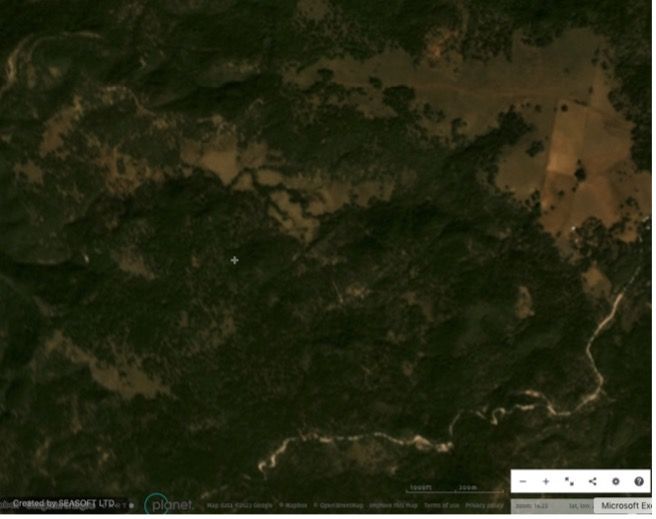


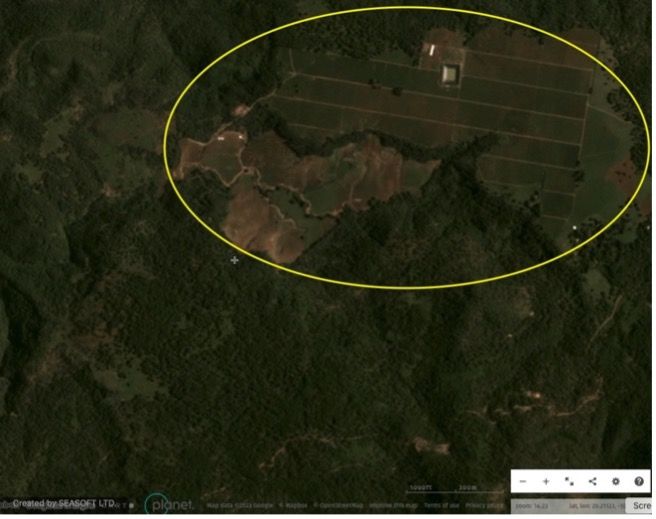
Global Forest Watch June 2020
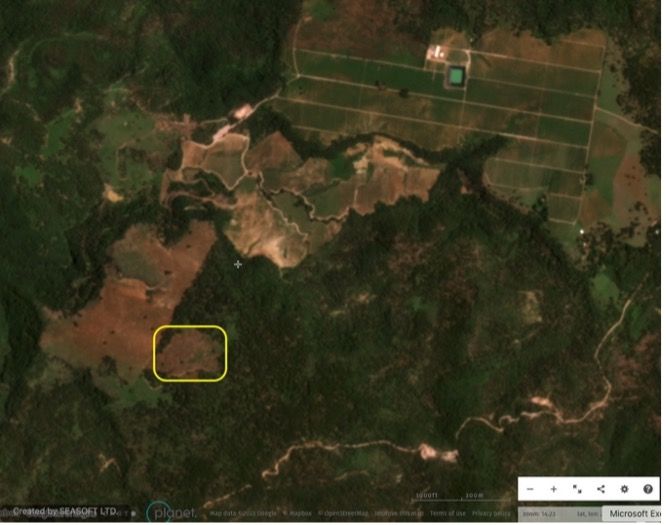
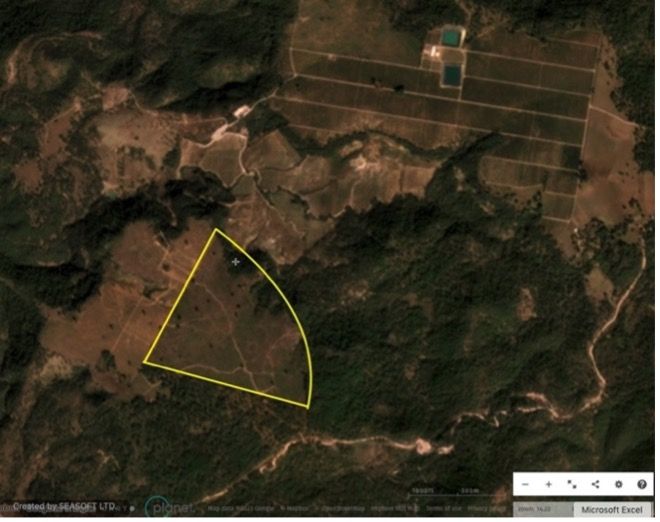

Truck with logged wood being removed from property referenced in the letter, provided by family.
Climate Rights International sent a FOIA request to the U.S. State Department in January 2023, asking for records from 2013 to the present related in whole or in part to avocados produced in Mexico.591CRI FOIA request to U.S. State Department, January 27, 2023. In March 2023, the State Department informed Climate Rights International that the “estimated date of completion” for the request was July 31, 2025.592Email from U.S. Department of State, FOIA Requester Service Center to CRI personnel, March 31, 2023. CRI wrote to the chief of the Requester Liaison Division of the State Department on March 31 and April 20, 2023, asking if there was any way to work with their office to facilitate and thus expedite the request—such as by limiting the search to electronic records—but CRI did not receive a response.
Companies that sell avocados, ranging from packinghouses, exporters, and importers to supermarkets, have responsibilities to conduct due diligence to identify, prevent, and mitigate human rights and environmental harms in their supply chains.
The UN Guiding Principles on Business and Human Rights, unanimously endorsed by the UN Human Rights Council in 2011,593UN Human Rights Council, Resolution 17/4: Human Rights and transnational corporation and other business enterprises, A/HRC/RES/17/4, July 6, 2011, https://documents-dds-ny.un.org/doc/RESOLUTION/GEN/G11/144/71/PDF/G1114471.pdf?OpenElement. are the internationally-accepted framework for addressing the risks of human rights impacts by businesses. The Guiding Principles make clear that businesses have the responsibility to “[a]void causing or contributing to adverse human rights impacts through their own activities and address such impacts when they occur.”594Special Representative of the Secretary-General on the issue of human rights and transnational corporations and other business enterprises, “Guiding Principles on Business and Human Rights: Implementing the United Nations ‘Protect, Respect and Remedy’ Framework,” UN document A/HRC/17/31, March 21, 2011, https://www.ohchr.org/Documents/Issues/Business/A-HRC-17-31_AEV.pdf, principle 13(a) (accessed July 14, 2023). The obligation to avoid causing or contributing to human rights harms applies to acts such as deforestation, which adversely affects human life and health, ecosystems and biodiversity.595OHCHR, “Frequently Asked Questions on Human Rights and Climate Change, Fact Sheet, No. 38,” 2021, https://www.ohchr.org/sites/default/files/2021-09/FSheet38_FAQ_HR_CC_EN_0.pdf. See also UN Human Rights Special Procedures, Working Group on the issue of human rights and transnational corporations and other business enterprises, “Information Note on Climate Change and the Guiding Principles on Business and Human Rights,” June, 2023, https://www.ohchr.org/sites/default/files/documents/issues/business/workinggroupbusiness/Information-Note-Climate-Change-and-UNGPs.pdf, para. 16 (The responsibilities of business enterprises under the Guiding Principles…include the responsibility to act in regard to actual and potential impacts related to climate change.”).
Even if the businesses have not contributed to impacts, they must “seek to prevent or mitigate” impacts that are “directly linked to their operations, products or services by their business relationships,” including entities in their value chain.596Ibid, principle 13(b).
To fulfill these responsibilities, companies should have in place due diligence processes that assess actual and potential impacts, act upon the findings, track responses and communicate how the impacts are addressed.597Ibid, principle 17. The human rights due diligence should cover environmental and climate-related harms that impact human rights, including the right to water and the right to a healthy environment.
When a business determines that it has caused or contributed to adverse impacts, it should provide for remediation.598Ibid, principle 22. When it identifies adverse impacts in its value chain, it should use whatever leverage it has to change the harmful practice. If it lacks sufficient leverage to prevent or mitigate the adverse impacts, it should consider ending the relationship.599Ibid, principle 19(b) commentary. See also UN Human Rights Special Procedures, Working Group on the issue of human rights and transnational corporations and other business enterprises, “Information Note on Climate Change and the Guiding Principles on Business and Human Rights,” June, 2023, https://www.ohchr.org/sites/default/files/documents/issues/business/workinggroupbusiness/Information-Note-Climate-Change-and-UNGPs.pdf (“The responsibilities of business enterprises under the Guiding Principles…include the responsibility to act in regard to actual and potential impacts related to climate change.”), para. 17(g).
The OECD’s Guidelines for Multinational Enterprises on Responsible Business Conduct similarly provide that businesses should carry out risk-based due diligence to identify, prevent and mitigate actual and potential adverse impacts on human rights600OECD, “OECD Guidelines for Multinational Enterprises on Responsible Business Conduct,” 2023, https://www.oecd-ilibrary.org/docserver/81f92357-en.pdf?expires=1692737412&id=id&accname=guest&checksum=A346CD0BBAF7F84311A1A0B63F62F09A, principle IV, p. 25 (accessed November 12, 2023). Both the United States and Mexico are members of the Organization for Economic Cooperation and Development. and the environment, including deforestation.601Ibid, principle VI, p. 33. An enterprise “causes” an adverse impact if its activities on their own are sufficient to result in the adverse impact; it “contributes” if “its activities, in combination with the activities of other entities cause the impact, or if the activities of the enterprise cause, facilitate or incentivize another entity to cause an adverse impact.”602Ibid, para. 68, p. 36. Just like in the UN Guiding Principles, even if the enterprise does not cause or contribute to the impact, it still has a responsibility to prevent and mitigate impacts directly linked to a “business relationship,” including “entities in the supply chain which supply products or services that contribute to the enterprise’s own operations, products or services.”603Ibid, para. 17, p. 18.
As elaborated below, there are strong reasons to conclude that major companies in global avocado supply chains—as well as the trade association APEAM—do not conduct adequate due diligence to prevent sourcing from deforestation-linked orchards or those that have contributed to other environmental or human rights harms. So, when a consumer buys a Mexican avocado in a United States supermarket, she has no way of knowing whether it is thus tainted.
This report has satellite imagery showing 75 illustrative examples of U.S.-export certified orchards in Michoacán containing deforested land that, according to government records, in 2022, supplied 2.13 million kilograms (4.69 million pounds) of avocados to packinghouses owned by at least one of the following major companies in global avocado supply chains: Aztecavo, Calavo, Fresh Del Monte, Mission Produce, and/or West Pak. Government records indicate that, as with all conversion of forests to avocado orchards over the past two decades in Michoacán, the deforestation in these 75 orchards was illegal. Our analysis of government records indicates that each of the companies was supplied by at least 14 of the 75 orchards, which in many instances supplied several of the companies. The examples are identified below in this section, or in prior chapters—in captions for satellite imagery noting the implicated companies and quantities supplied—or in Appendix L.
To identify these examples, Climate Rights International used previously unpublished official data that has been available to Mexican and U.S. authorities, as well to the companies, all of whom could have used the same methodology that we used to detect tainted shipments in supply chains. Specifically, we obtained, via Mexico’s transparency law, records for shipments from orchards to packinghouses called “Harvest Registration forms” (Bitácora de Cosecha, BICO).604Transparency Law Response from SENASICA to request number 330028323000180, June 27, 2023. Under the Operational Work Plan (OWP) between Mexico and the United States, a BICO must accompany each shipment from an avocado orchard to a local packinghouse if the shipment is ultimately destined for U.S. export.605SENASICA, “Operational Work Plan (OWP): Systems Approach for the Importation of Fresh Hass Avocado from Mexico into the United States,” para. 4.6.1 Each BICO record lists the official registration number of the orchard of origin, the weight of the shipment, and the packinghouse destination, among other information.
We obtained the BICO records for shipments from Michoacán orchards in 2022. By comparing the orchard registration numbers in the BICO shipment records with the registration numbers of orchards that government maps and satellite imagery showed contain deforested land, we found evidence linking shipments from illegally deforested orchards to specific packinghouses owned by the five major companies. In the vast majority of the examples, the orchards contain land that was deforested at some point over the past decade.
The more than 75 illustrative examples are by no means a complete accounting of the orchards containing deforested land that supplied the five companies in 2022. The examples are based on Climate Rights International’s review of shipping records for just a small fraction of the orchards that, according to the government maps and satellite imagery, contain deforested land. Moreover, Climate Rights International’s review of the shipping records showed that orchards containing illegally deforested land supplied many other packinghouses, in addition to the five companies listed here.
The examples below list the municipality in Michoacán where the orchard containing deforested land is located, and the weight of avocados that—according to BICO records—the orchard supplied to each of the five companies in 2022. The satellite images are from Google Earth and the polygons are Mexican government maps of U.S.-export certified orchards. In each of the images, orchards outlined in red contain deforested land and, according to BICO records, supplied at least one of the five companies in 2022. The blue and green polygons are other U.S. export-certified orchards where we either have not identified deforested land, or have not identified shipments to at least one of the five companies, or both. (We did not check all of the blue and green polygons for deforestation and/or shipments.)
Many of the images show additional deforestation for avocado production directly adjacent to the certified orchard. In some cases, this could represent ongoing deforestation by the producers supplying the companies. In others, it simply demonstrates the continued deforestation-driven expansion of the avocado frontier in areas supplying major companies.
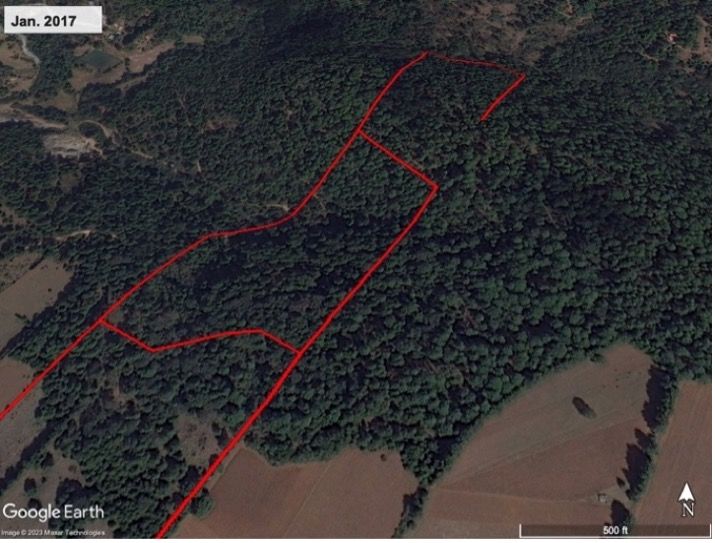
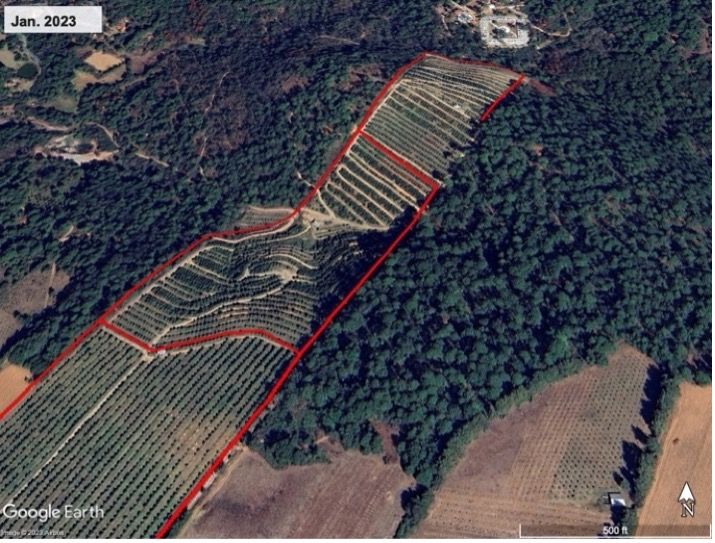
In 2022, the three Morelia orchards outlined in red supplied 24,800 kilograms to West Pak, 24,665 to Calavo, and 8,030 to Fresh Del Monte, according to government records.606The orchards are HUE08160530568 (a non-deforested portion of which continues out of the bottom left of the frame), HUE08160530573, and HUE08160530574.
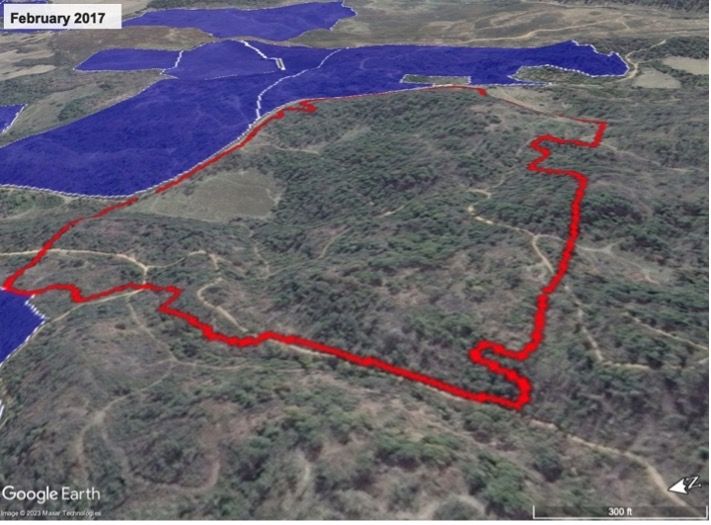
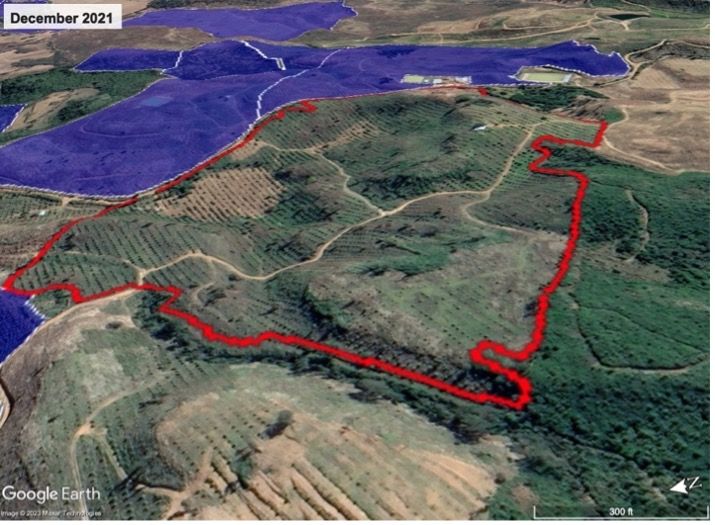
In 2022, the Zacapu orchard outlined in red supplied 1,290 kilograms to Fresh Del Monte and 520 kilograms to Calavo, according to government records.607The orchard is HUE08161070741.
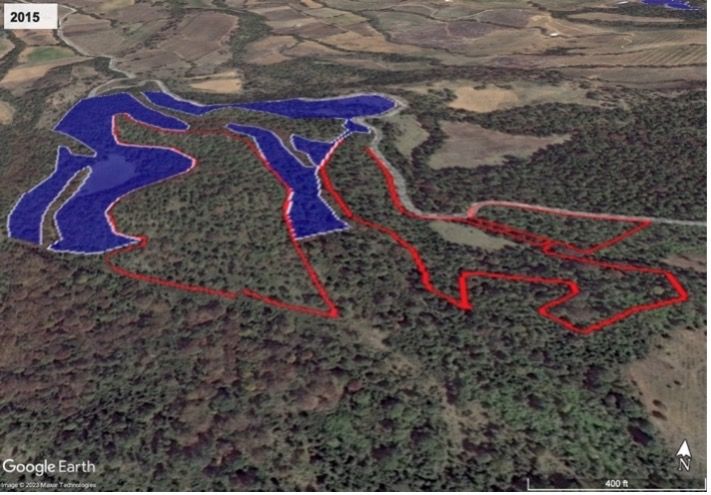



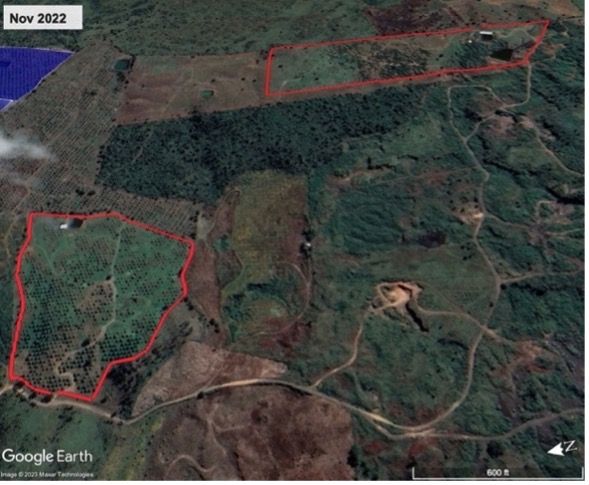
In 2022, the two Zacapu orchards outlined in red supplied 12,984 kilograms to Fresh Del Monte Grupo, according to government records.609The orchards are HUE08161070500 (left) – 10,754 kilograms and HUE08161070501 (right) – 2,230 kilograms. The image from February 2015 shows that the orchard on the top right was installed after a fire on the piece of land.


In 2022, the two Zacapu orchards outlined in red supplied 9,810 kilograms to West Pak, according to government records.610The orchard numbers are HUE08161070701 and HUE08161070720.


In 2022, the Madero orchard outlined in red supplied Mission Produce with 16,290 kilograms and Aztecavo with 24,901 kilograms, according to government records.611The orchard number is HUE08160490325.

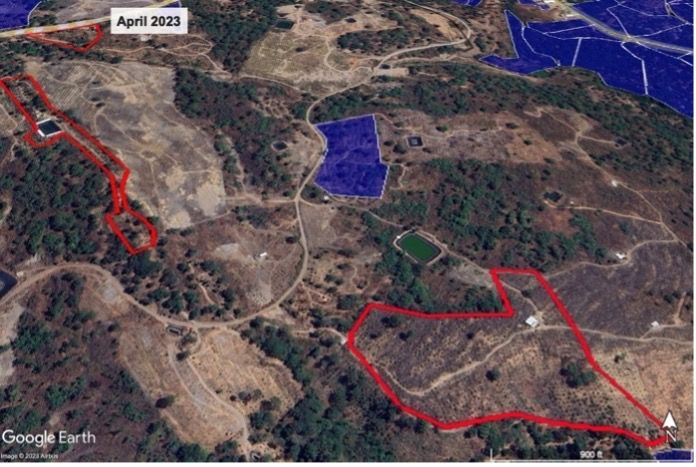
In 2022, the three Ziracuaretiro orchards outlined in red supplied 4,410 kilograms to Mission Produce (top), 1,570 kilograms to West Pak (middle), and 1,980 to Del Monte (bottom), according to government records.612The orchards are HUE08161114570 (bottom), HUE08161027022 (middle); HUE08161114137 (top).

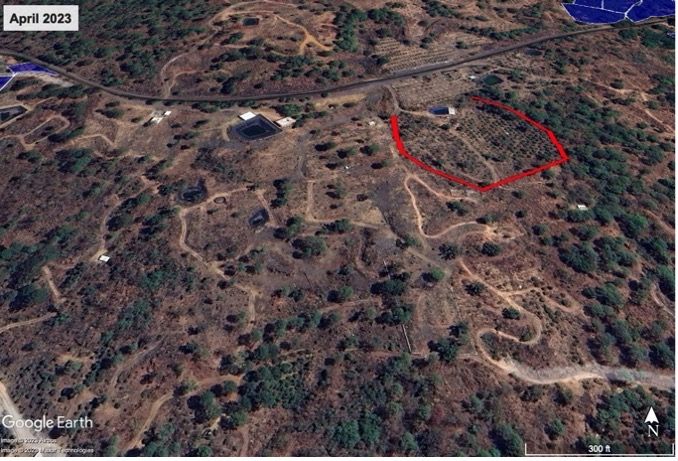
In 2022, the Ziracuaretiro orchard outlined in red supplied 6,130 kilograms to Mission Produce, according to government records.613The orchard is HUE08161114658.
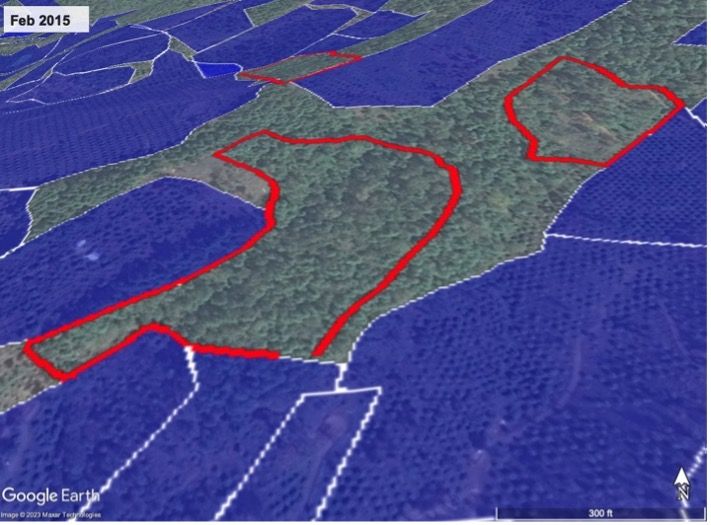
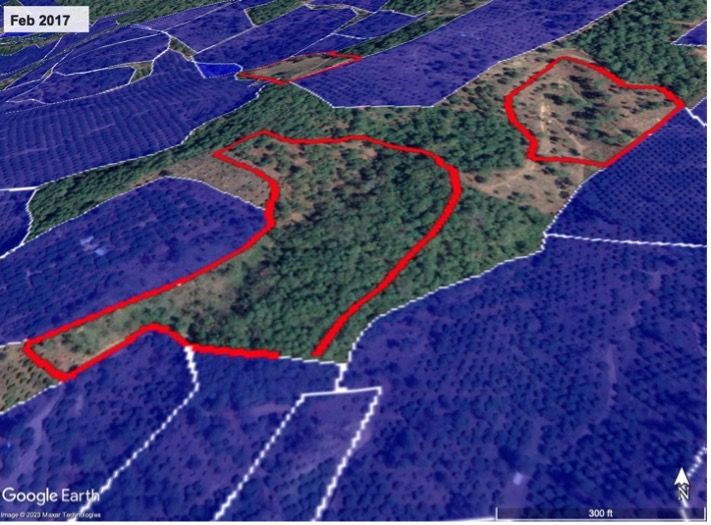
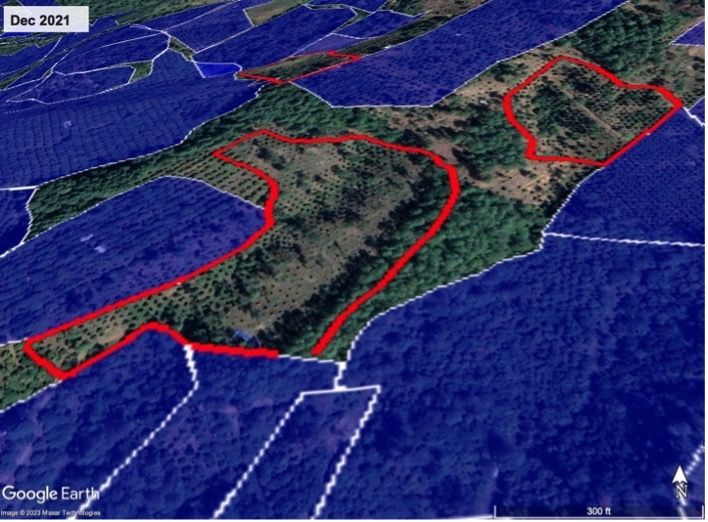
In 2022, the three Ziracuaretiro orchards outlined in red supplied 7,700 kilograms to Mission Produce (bottom and top left), and 7,215 kilograms to Aztecavo (top right), according to government records.614The orchards are HUE08160870679 (bottom) – 3,400 kilograms, HUE08160795278 (top left) – 4,300 kilograms; HUE08160795067 (top right).




The nine Tacámbaro orchards outlined in red each contain deforested land and, according to government records, in 2022, collectively supplied Calavo with more than 700,000 kilograms.615The shipping records stated the following weights of shipments for each avocado orchard: HUE08160826643: 75,685; HUE08160825241: 425,371; HUE08160826641: 30,850; HUE08160825240: 62,890; HUE08160823052: 9,990; HUE08160826640: 26,180; HUE08160825239: 57,580; HUE08160826642: 15,415; HUE08160826621: 12,755. The orchard outlined in yellow supplied 8,680 kilograms to West Pak in 2022, according to the records.616The orchard is HUE08160825393.


In 2022, the Cotija orchard outlined in red supplied Calavo with 3,310 kilograms, according to government records.617The orchard is HUE08160190925.
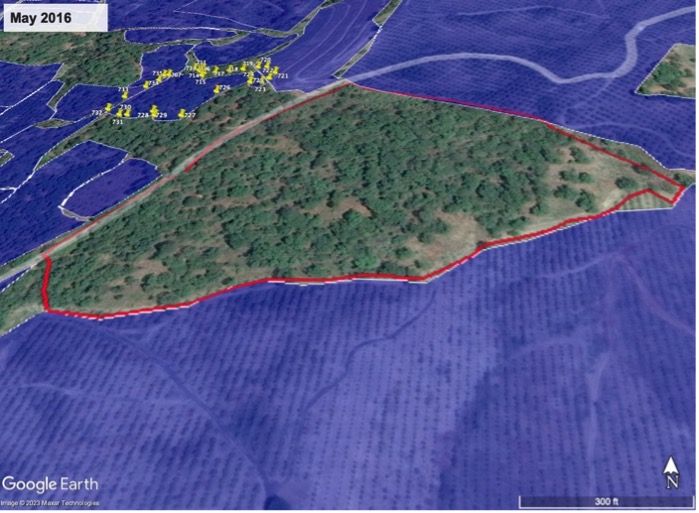
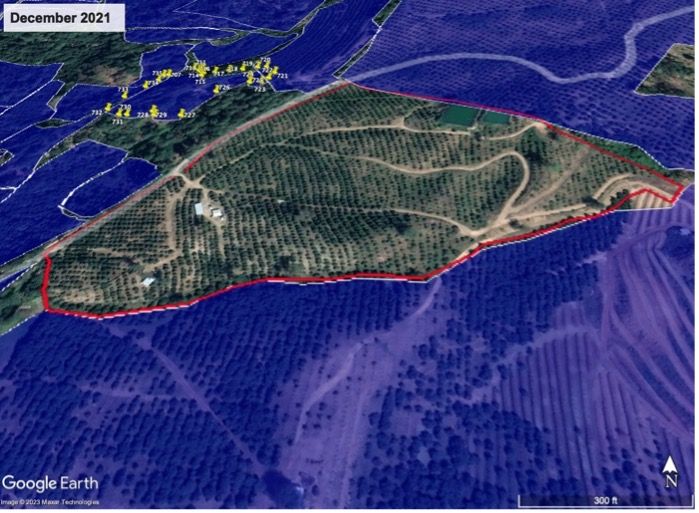
In 2022, the Taretan orchard outlined in red supplied West Pak with 1,920 kilograms of avocados, according to government records.618The orchard is HUE08160870616.

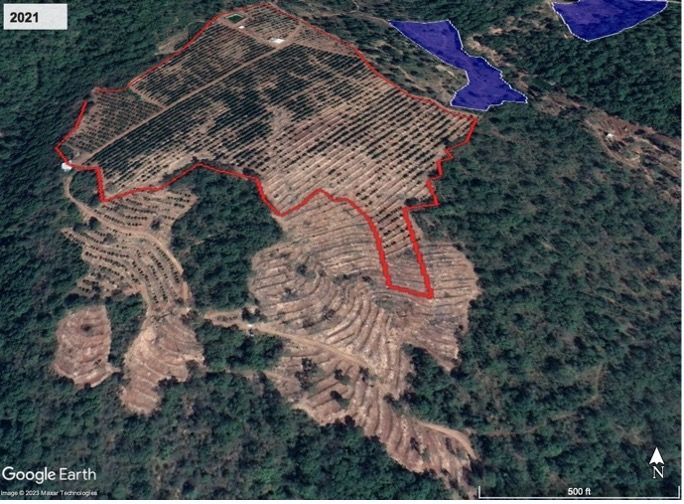
In 2022, the Taretan orchard outlined in red supplied West Pak with 53,990 kilograms, Fresh Del Monte with 6,050, and Aztecavo with 7,390, according to government records.619The orchard is HUE08161114200.


In 2022, the Turicato orchard outlined in red supplied 4,545 kilograms of avocados to Calavo, according to government records.620The orchard is HUE08160972175.
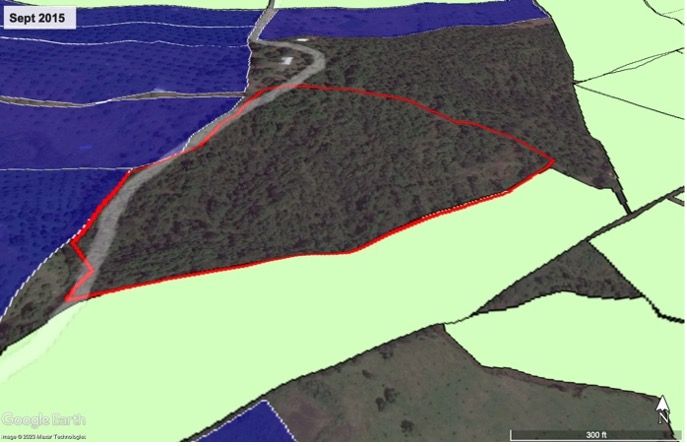
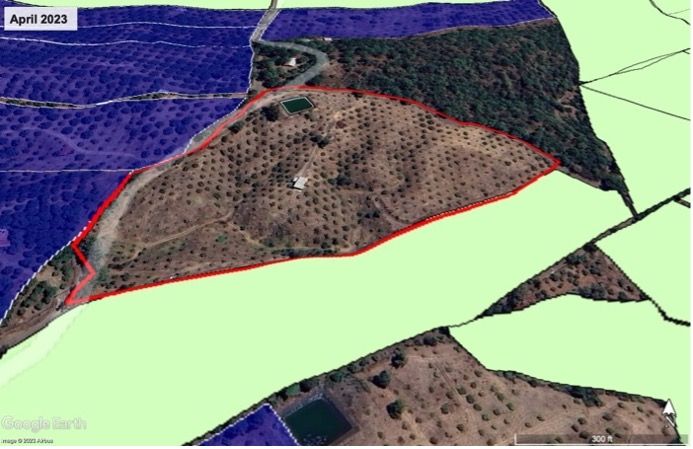
In 2022, the Uruapan orchard outlined in red supplied 5,520 kilograms to Calavo, according to government records.621The orchard number is HUE08161027099.
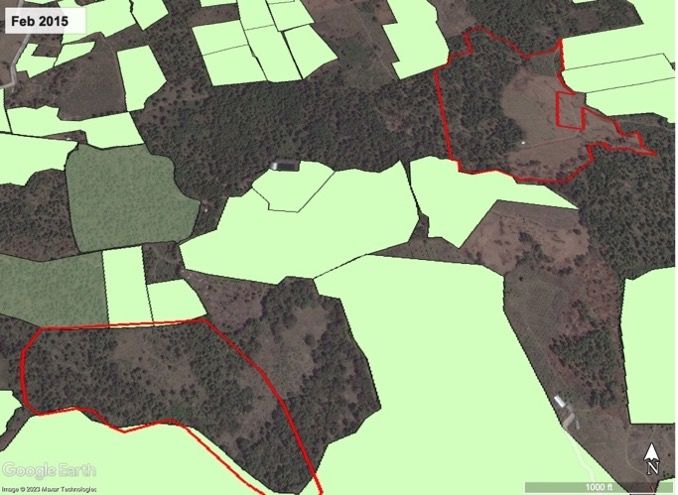
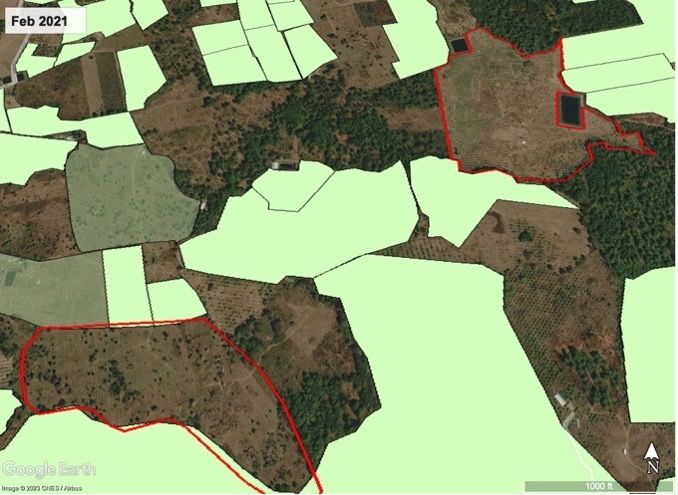
In 2022, the two Uruapan orchards outlined in red supplied 171,407 kilograms to Aztecavo (orchard on right) and 4,820 kilograms to Mission Produce (orchard on left), according to government records.622The orchard on right is HUE08161026910 and the orchard on left is HUE08161027476.
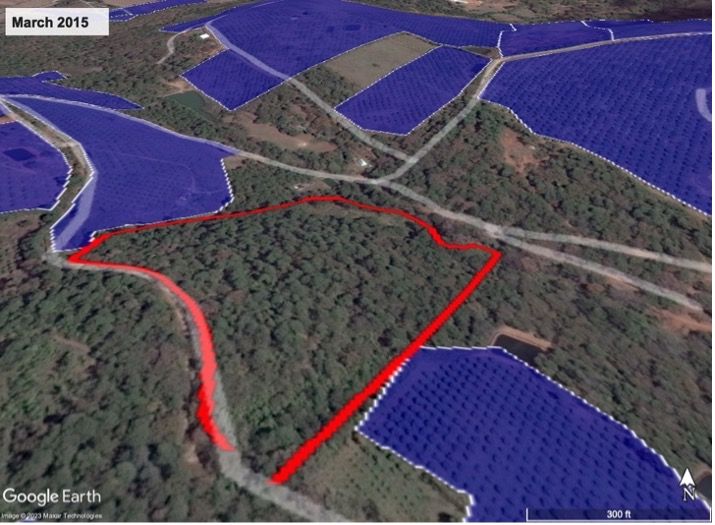

In 2022, the Acuitzio del Canje orchard outlined in red supplied 2,845 kilograms to Fresh Del Monte, according to government records.623The orchard is HUE08160010522.
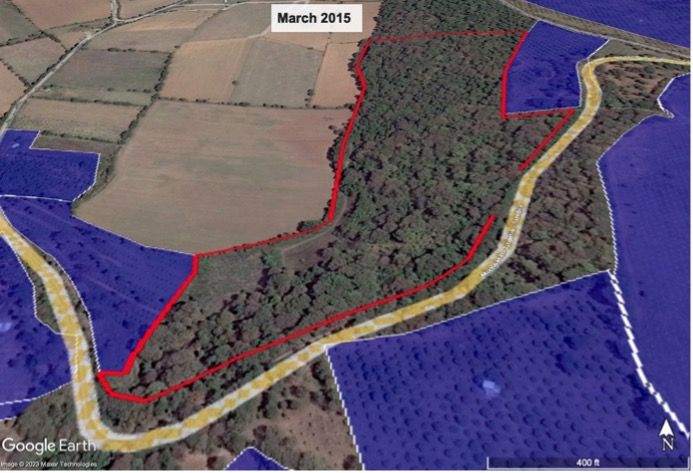
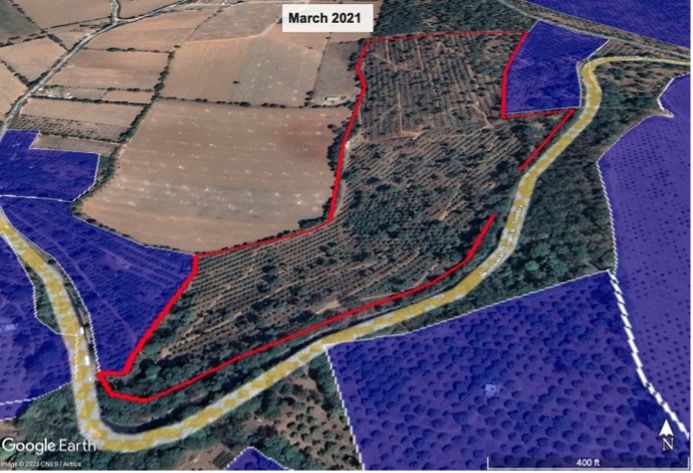
In 2022, the Acuitzio del Canje orchard outlined in red supplied 33,195 kilograms of avocado to West Pak, according to government records.624The orchard is HUE08160010317.


In 2022, the Zitácuaro orchard outlined in red supplied 1,850 kilograms to Mission Produce, according to government records.625The orchard is HUE08161125337.
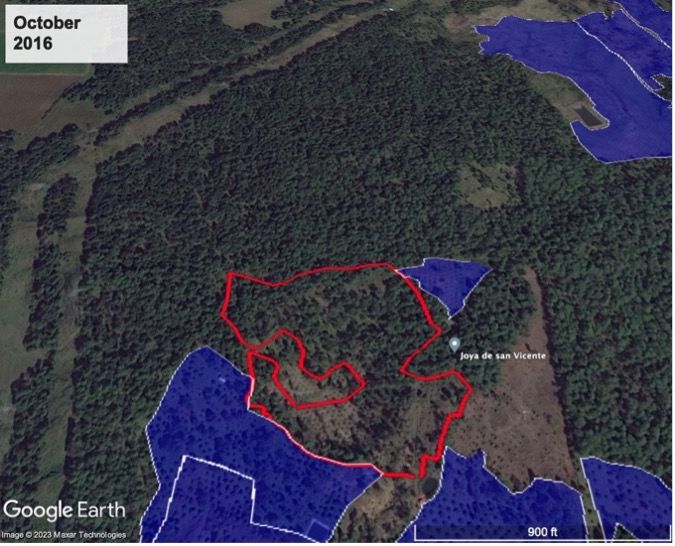

In 2022, the Nuevo San Juan Parangaricutiro orchard outlined in red supplied 7,710 kilograms of avocado to Aztecavo, according to government records.626The orchard is HUE08160583115.
Between January 2019 and April 2023, the Michoacán-based Aguacates La Bonanza S.A. de C.V. exported US$477 million worth of avocados from Mexico to the United States, according to Mexican customs data compiled by Treid. The three U.S.-export approved orchards containing deforested land, outlined in red in the following image, supplied Aguacates La Bonanza in 2022, according to BICO records.


The three Zacapu orchards in red supplied Aguacates La Bonanza with 133,208 kilograms of avocado in 2022, according to government records.627The orchards are HUE08161070651, HUE08161070652, and HUE08161070653.
Between January 2019 and April 2023, the Jalisco-based Agro Gonzámex exported, through its packinghouse called Avo Select, US$16.2 million worth of avocados from Mexico to the United Kingdom, US$13.4 to France, US$12.5 to Spain, $11.6 million to the Netherlands, US$5.5 million to Japan, and US$2.6 million to Canada, according to Mexican customs data compiled by Treid.628Treid data for “Avo Select SA de CV.” Multiple sources show that Avo Select belongs to Agro Gonzámex. See Grupo Gonzámex website, http://grupogonzamex.com/ (accessed August 14, 2023) (stating that one of its two divisions is Agro Gonzámex, and that “thanks to the vision of its founders,” Avo Select was created as a packinghouse in 2003); Inocuo, “Generational Transition of a Family Company,” (“Transición generacional de una empresa familiar”), video clip, vimeo.com, https://vimeo.com/829230785 (Ignacio González states in the interview that in Grupo Agro Gonzámex, “we manage” (manejamos) Avo Select, “which is the packinghouse.”); https://tinyurl.com/2msa6eub (accessed August 14, 2023) (a November 2021 letter signed by Ignacio González, “Executive Director,” on “Grupo Gonzámex” letterhead, states: “Grupo Gonzámex is a company which operates various business units in the Mexican agricultural sector. AgroGonzalez produces avocado of their highest quality … and Avo Select is the leading exporter of high quality Avocado to the European, Asian, and American markets.”); Agro Gonzámex Facebook account, https://es-la.facebook.com/AgroGonzamex/videos/avo-select-de-grupo-gonz%C3%A1mex-nos-complace-compartir-con-ustedes-nuestra-nueva-ce/966693001002486/ (accessed August 14, 2023) (stating that “Avo Select of Grupo Gonzámex” was happy to announce it received a new certification). It was the largest supplier from Mexico to the United Kingdom, accounting for 30 percent of avocado exports from Mexico to the United Kingdom; and fourth biggest to France, accounting for 9.32 percent of exports from Mexico to France. The clients to whom it has exported include Nature’s Pride (US$8 million) and Mission Produce Europe BV (US$1.1 million), according to the data compiled by Treid.
On February 7, 2023, Agro Gonzámex posted on Facebook that it would be sending avocados to the United States for the Super Bowl.629Agro Gonzámex Facebook account, https://www.facebook.com/AgroGonzamex/ (accessed July 14, 2023).
The El Atascoso, Jalisco study in the chapter on water impacts shows recent deforestation in the location of an orchard apparently owned by Agro Gonzámex or one of its executives. Two cases in that chapter show water impacts linked to Agro Gonzámex. The San Gabriel case study in the Emblematic Case Studies chapter also shows deforestation for avocado orchards in close proximity to a water concession registered to Agro Gonzámex.
The following images are an additional example of deforestation for avocado orchards that strongly appears to be linked to Agro Gonzámex, including because they are located directly next to an orchard prominently shown on the Agro Gonzámex website.


Google Earth images in Gomez Farias, Jalisco. The polygons outlined in light blue and black and white circles are U.S.-approved export orchards. The images show significant deforestation between December 2016 and 2023, surrounding those orchards, with water storage pools typically used for avocado irrigation located inside the cleared land. The yellow pin—located in one of the recently deforested areas—is the location of an underground water concession, registered in 2009 to “Elias Gonzalez Flores, Ignacio Gonzalez Flores [and] Hector Gonzalez Flores.”630The CONAGUA concession number is 08JAL133296/12APDA18. As described earlier in the report, Ignacio Gonzalez is an executive at Agro Gonzámex and in a recent interview was introduced as a founder of the company, and stated that he and his two brothers are the “heads” of the company, which is also known as “Agro González.” Hector Gonzalez Flores is named in legal documents as a legal representative of the company.631Agreement between the Centro Universitario de Ciencias Exactas e Ingenierías and Agro Gonzalez, February 27, 2023, http://www.cucei.udg.mx/sites/default/files/agro_gonzalez_s.p.r.de_r.l.pdf (accessed July 14, 2023). Other documents also link Elias and Ignacio to Agro Gonzámex.632SEMARNAT, “Ecological Gazette,” (“Gaceta Ecológica”), February 28, 2008, http://sinat.semarnat.gob.mx/Gacetas/archivos2008/gaceta_8-08.pdf (accessed July 14, 2023); “Agricultural Expo Jalisco,” https://noticiastecnoagricola.com/wp-content/uploads/2021/04/ProgramaEAJ20211.pdf (accessed August 14, 2023); https://docplayer.es/204571756-En-ciudad-guzman-municipio-de-zapotlan-el-grande-jalisco-siendo-las-09-00-hrs-nueve-horas-del-dia-lunes-25-veinticinco-de-noviembre-del-ano.html (accessed July 14, 2023) ; https://tinyurl.com/2msa6eub (accessed August 14, 2023). An image posted on Google Maps for the location “Rancho Providencia,” located in the polygon with black and white circles, shows a family emblem stating “Gonzalez,” above what appears to be a sculpture of an avocado. The green star marks the perspective, looking to the right of the image, from which the following images are taken, which also show deforestation.

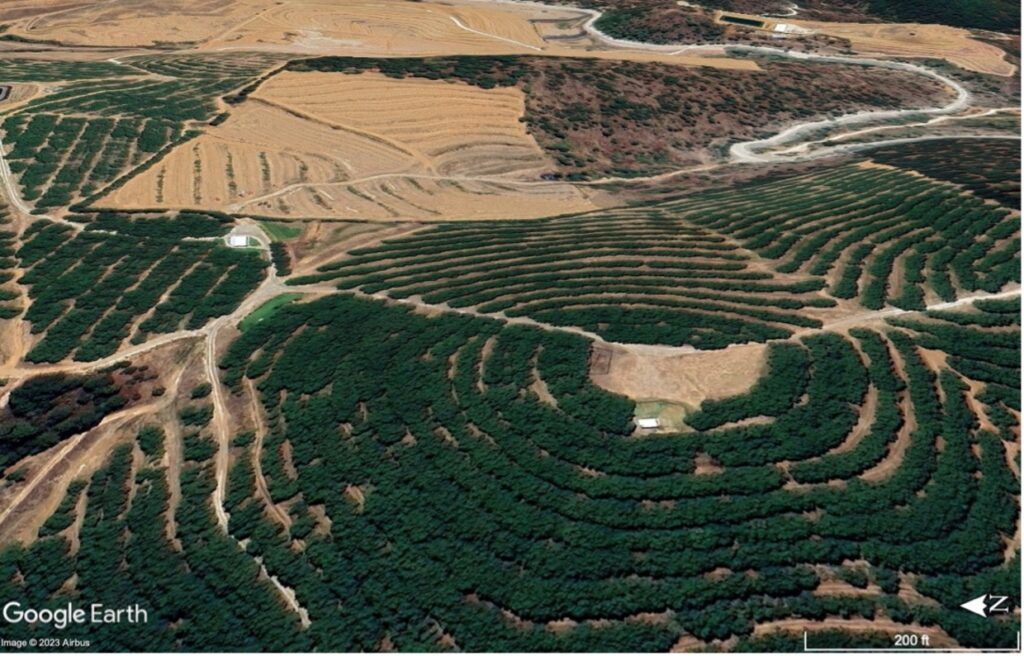
The above two images are from the perspective the green star in the first two Google Earth images, looking to the right. The first image is from the Agro Gonzámex website.633Agrogonzamex.com (accessed July 14, 2023). The Google Earth image below is from April 2023. There is significant deforestation in the areas surrounding the orchard Agro Gonzámex showcases on its website, with the slogan “the great flavor that’s born out of the land.”
Climate Rights International also identified orchards containing deforested land that supplied two large avocado-exporting companies based in Tancítaro: Aguacates Seleccionados JBR and Frutas Finas de Tancítaro. These packinghouses have, respectively, exported US$435 million and US$249 million to the United States since 2019.634Mexican customs data processed by Treid. Sixty-nine percent of the companies to whom Aguacates Seleccionados JBR exported are listed by Treid as “unknown.” Of the remaining 31 percent, clients include Westfalia Fruit Marketing USA (US$17.5); Eco Farms Trading Operations, 65 percent owned by Dole (US$11.1 million);635 Dole plc Form 20-F, filed with SEC, filed March 22, 2023, https://www.sec.gov/Archives/edgar/data/1857475/000185747523000013/dole-20221231.htm, p. F-70 (accessed September 15, 2023). and Del Rey Avocado Co Inc (US$5.1 million).636Mexican customs data processed by Treid.


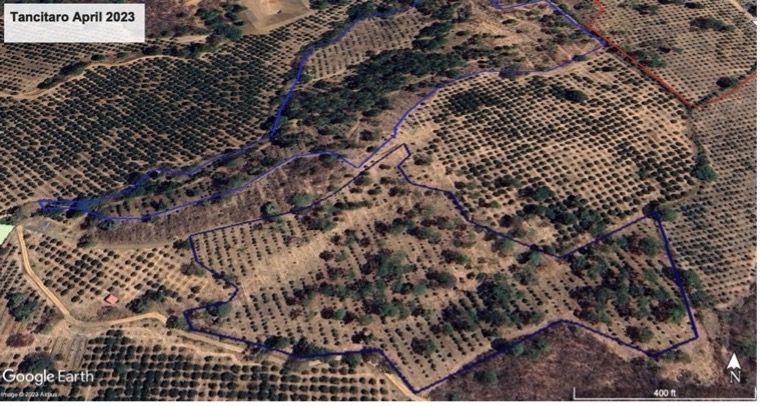
The U.S.-export approved orchards outlined in blue, and located in Tancítaro, supplied Aguacates Seleccionados JBR, S.A. de C.V. with 11,191 kilograms of avocados in 2022, according to government records.637The orchards are HUE08160838965 and HUE08160838966.
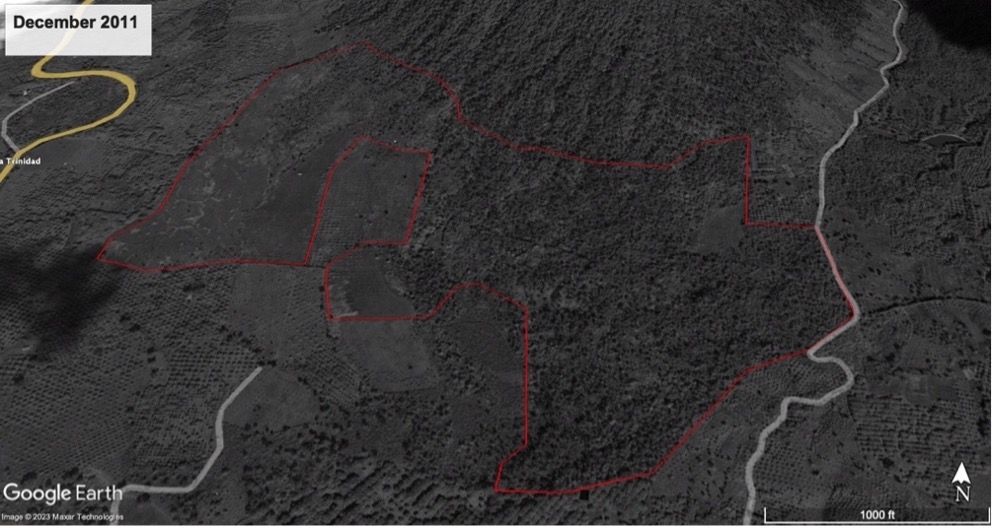

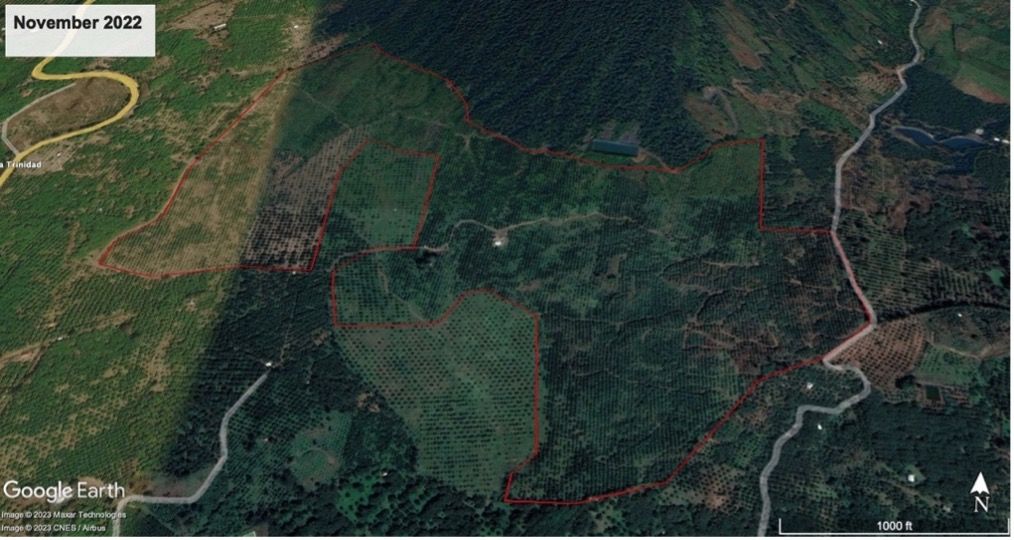
This U.S.-export approved orchard, outlined in red, is located in Uruapan and in 2022 supplied 226,610 kilograms of avocados to Frutas Finas de Tancitaro, S.A. de C.V., according to government records.638The orchard is HUE08161026236.
APEAM is funded by and represents all producers and packers who export to the United States. To export to the United States, growers and packers must participate in the OWP-established export program “through” APEAM, the designated “Cooperator” under the OWP agreement between the U.S. and Mexican governments.639SENASICA, “Operational Work Plan (OWP): Systems Approach for the Importation of Fresh Hass Avocado from Mexico into the United States,” paras 4.8 and 5.6. The OWP provides that APEAM “represent[s]” all growers and packers who participate in the export program.640Ibid., para 6.1. Pursuant to the OWP, APEAM maintains “polygon maps of all certified orchards and their geographic location.”641Aguacates Para Siempre, “Traceability, the Mark of Quality Avocado for Export,” (“Trazabilidad, marca del aguacate con calidad de exportación”), https://aguacatesparasiempre.com/avodatos/trazabilidad-marca-del-aguacate-con-calidad-de-exportacion/ (accessed October 3, 2023) (visual has APEAM trademark on it and Aguacates Para Siempre website is copyrighted to APEAM AC.) APEAM also manages the “BICO” records of shipments from the orchards to packinghouses, which Climate Rights International used to identify contaminated supply chains in the preceding section.642“Mexico’s Commitment to Food Safety in the Avocado Orchard and Beyond,” Avocado Institute of Mexico, https://avocadoinstitute.org/avo-journey/commitment-to-quality-and-food-safety/food-safety-and-traceability/ (accessed August 9, 2023). See also, SADER Transparency Committee, Confidentiality Resolution No. CT-2023-34, for Transparency Law Request Number 330028323000041, March 21, 2023 (in which a SENASICA official wrote that APEAM “guarantees the traceability of avocado fruits through the Harvest Log (BICO).”)
APEAM states that, overall, exported “Mexican avocados follow a very rigorous process that step by step traces the path of each fruit from the tree until the destination country.”643Aguacates Para Siempre, “Traceability, the Mark of Quality Avocado for Export”; see also SENASICA, “Operational Work Plan (OWP): Systems Approach for the Importation of Fresh Hass Avocado from Mexico into the United States,” para. 4.6.1 (“Each shipment to the packinghouse will be accompanied by an industry “Harvest Registration” form Bitácora de Cosecha, (Bico) for purposes of traceability of the fruit.”). The Avocado Institute of Mexico, a website whose trademark is registered to APEAM,644United States Patent and Trademark Office, “Trademark Electronic Search System,” https://tmsearch.uspto.gov/bin/gate.exe?f=tess&state=4805:mo8w4j.1.1 (trademark serial numbers 90468616, 90468595, and 90468644). and was apparently launched by Avocados From Mexico645The LinkedIn page of the Avocados From Mexico’s Director of Corporate Communications, Crisis and PR states that while in this position, she “[d]eveloped and launched the Avocado Institute of Mexico, a digital resource for news, facts, and insights on the Mexican avocado industry.”—which is partly funded and managed by APEAM—states that “whether at the packing house or at the consumer’s dining room table, every [exported] avocado can be tracked back to the exact orchard in Mexico in which it was grown, and the date and time of day it was picked from the tree.”646“Mexico’s Commitment to Food Safety in the Avocado Orchard and Beyond,” Avocado Institute of Mexico.
Given its possession of this information, APEAM could play a critical role in preventing avocados grown on illegally deforested lands from reaching U.S. markets. It could compare orchard maps it already has with Google Earth satellite imagery to identify recently deforested orchards, and prevent them from participating in the export program through APEAM, or at the very least publicly track which shipments of avocados come from deforested land, so that buyers in the supply chain and consumers could avoid purchasing them. These due diligence measures would be easy, low-cost, and largely based on information and tracking systems they already have in place.
Yet, APEAM admits that it does not have policies or practices to prevent the export of avocados from orchards containing deforested land, or that use illegally sourced water. In August 2023, Climate Rights International sent a letter to APEAM asking if it had any policies or practices in place to:
APEAM responded “no,” to all of these questions, in an October 2023 email.648Email from APEAM’s office of sustainable development to CRI personnel, October 26, 2023. APEAM said that these matters are regulated by the government.
Additional evidence that APEAM has no due diligence policies for deforestation include the facts that:
The Climate Rights International letter to APEAM also sought more detailed information about a reforestation program the association has touted. APEAM reports having a “reforestation initiative” that, since 2011, has planted more than 5,500 acres of native “trees and plants” in Michoacán, with a claimed survival rate of greater than 85 percent.650Avocado Institute of Mexico, “The Initiative by APEAM to Rehabilitate the Forests of Michoacán,” https://staging-avoinstitute-staging.kinsta.cloud/apeam-mhaia/the-initiative-by-apeam-to-rehabilitate-the-forests-of-michoacan/ (accessed September 21, 2023); APEAM, “Green Agenda: Sustainable Production of Avocado in Mexico.”APEAM said that the plantings were of seven native pine species, but declined to provide documentation showing the locations where the trees have been planted, stating that this information is confidential.651Email from APEAM’s office of sustainable development to CRI personnel, October 26, 2023. APEAM said that the asserted 85% survival rate was based on the “technical opinion of an external auditor who is certified” by Mexico’s federal environmental agency, and did not respond to Climate Rights International’s request for any documentation in support of the claim.
Assuming that 5,500 planted acres had an 85% success rate, the surviving 4,675 acres would pale in comparison to the area of deforestation linked to the avocado growers and packinghouses APEAM represents. Furthermore, preventing deforestation has substantial advantages over reforestation and afforestation, the latter of which means growing trees where they hadn’t previously existed. Conserving forests is more effective than reforestation at lowering atmospheric greenhouse gas concentrations, according to a consensus document released by leading global environmental organizations, which cited academic studies for their conclusion.652World Wildlife Fund, World Resources Institute, Wildlife Conservation Society, The Nature Conservancy, IPAM Amazonia, Environmental Defense Fund, Conservation International, Coordinator of Indigenous Organizations of the Amazon, “Tropical Forest Credit Integrity Guide for Companies,” May 2022, https://jaresourcehub.org/wp-content/uploads/2022/05/TFCI-Guide-2022-Eng-3.pdf, p. 22, 22 n.16 (access July 13, 2023). And as the IPCC has noted, in addition to mitigation, “[r]educing deforestation provides numerous and substantial co-benefits, preserving biodiversity and ecosystem services (e.g., air and water filtration, water cycling, nutrient cycling) more effectively and at a lower cost than afforestation/reforestation.”653IPCC Working Group III, “Climate Change 2022: Mitigation of Climate Change,” p. 779.
As previously noted, packers, exporters, and importers tend to be vertically integrated. This means, for example, that companies such as Calavo own packinghouses in Mexico, have exporting operations to bring the avocados from packinghouses to the U.S. border, and also control imports from within the United States, before distributing to retailers.
In April 2023, Climate Rights International sent letters to ten packinghouses, exporters, and/or importers who play a significant role in supply chains from Mexico to the United States and/or globally.654See Appendix I for an example of the types of questions CRI sent to packinghouses, exporters, and importers. The letters requested detailed information about their due diligence policies and practices to address deforestation and other harms in avocado supply chains from Mexico. The companies include:
Most of these companies publicize—including on websites and in investor reports—codes of conduct for their general global operations, stating that suppliers must comply with certain environmental and human rights requirements—including not violating environmental laws of their countries of operation—and referring to the possibility of audits. But Climate Rights International was unable to find clear publicly available information from these companies about what measures, if any, they have actually taken to audit and ensure compliance with the codes for avocados sourced from Mexico. And none mention the existence of due diligence systems to specifically address the potential risks of avocados sourced from Mexico.
Of the ten companies to whom we wrote, the only companies that responded were Dole, Fresh Del Monte, and Nature’s Pride—and their responses provided only limited, boilerplate information. They provided no indication that they have adequate due diligence systems to prevent their avocado supply from Mexico from being contaminated with deforestation and other harms. Nor did they respond to questions asking how many times they or a third party have conducted audits to verify compliance, and what actions, if any, they have taken based on such audits. (In November 2023, Climate Rights International sent a summary of findings to packers, exporters, and importers named in this report, and the responses to those letters are in Appendix M.)
Perhaps the clearest evidence that packinghouses, exporters and importers are failing to conduct adequate due diligence to prevent deforestation in their supply chains are the 75 illustrative examples documented in this report indicating that, in 2022, Aztecavo, Calavo, Fresh Del Monte, Mission Produce, and West Pak cumulatively sourced millions of pounds of avocados from orchards containing deforested land. (We focused on these five companies because they own packinghouses in Michoacán, which allowed us to use the BICO records to trace shipments from deforested orchards directly to their supply chains—a research methodology we could not use for the six other companies to whom we wrote, who buy avocados from other packinghouses and exporters.)656For detailed information on packinghouse, importer, and exporter trade figures, sourcing policies, responses to CRI letters, and misleading claims, see Appendix K. The report also documents other major packinghouses that supplied avocados from orchards containing deforested land in 2022.
About four out of five avocados consumed in the United States come from Mexico.657 U.S. Department of Agriculture (USDA), Economic Research Service, “Imports play dominant role as U.S. demand for avocados climbs”; Avocados From Mexico website, https://avocadosfrommexico.com/about/. According to the Hass Avocado Board, an entity created by the U.S. Congress to promote consumption of the green fruit, 83.8 percent of the United States’ Hass avocado supply came from Mexico in 2021; 77.6 percent in 2022; and 80.9 percent in January-June 18, 2023.658Hass Avocado Board, “Volume Data & Projections,” https://hassavocadoboard.com/volume-data-projections/ (accessed June 18, 2023). Avocados produced in Michoacán, and more recently, also in Jalisco, are thus nearly ubiquitous throughout supermarkets in the United States.
In visits to supermarkets in the United States, Climate Rights International documented avocados labeled as being from Mexico, including in many instances with the “Avocados From Mexico” sticker, being sold at Walmart; Whole Foods (owned by Amazon); Ralphs (owned by Kroger); Costco; Target; Trader Joe’s; Safeway (owned by Albertsons); Sprouts; Smart & Final; and Stop & Shop (owned by Ahold Delhaize). Globally, websites for Amazon.com; FreshDirect (owned by Ahold Delhaize); Publix; Stater Bros; Tesco; and Wegmans also advertise avocados and/or guacamole listed as being from Mexico.659Amazon.com website, https://www.amazon.com/dp/B000NOGKN4?ref_=cm_sw_r_cp_ud_dp_JNE5DV6AT7N31WRGQYH8 (accessed July 27, 2023); FreshDirect website, https://www.freshdirect.com/fresh_produce/veg/sc/avc/p/veg_fd_fgavcrdypk(accessed July 27, 2023); Publix website, https://www.publix.com/pd/hass-avocados/RIO-PCI-107578 (accessed April 28, 2023); Stater Bros website, https://shop.staterbros.com/shop/product/cabo-fresh-guacamole-organic/2628600 (accessed July 27, 2023); Tesco website, https://www.tesco.com/groceries/en-GB/products/284605046 (accessed July 27, 2023); Wegmans website, https://shop.wegmans.com/product/257439/wegmans-guacamole (accessed July 27, 2023). Climate Rights International did not find public information about the amount of avocados each company sources from Mexico. Transactions between importers and retailers are the most opaque component of the avocado supply chain.
In April 2023, Climate Rights International sent letters to 11 major supermarkets that have stores in the U.S., Europe, and other countries:
The letters requested detailed information about the amount of avocados they source from Mexico, and due diligence policies and practices to address deforestation and other harms in avocado supply chains from Mexico. Walmart, Ahold Delhaize, and Lidl are the only companies that responded. (In November 2023, Climate Rights International sent a summary of findings to supermarkets named in this report, and the responses to those letters are in Appendix M.)
With the exception of Lidl, none of the companies provided information indicating that they have adequate due diligence to prevent their avocado supply from Mexico from being contaminated with deforestation and other harms. And none of their public information—including on websites and in investor reports—mentions a due diligence system to specifically address the potential risks of avocados sourced from Mexico. Many of them publicize codes of conduct or supplier standards for their general global business, stating that suppliers must comply with certain environmental and human rights requirements—including not violating environmental laws of their countries of operation—and referring to the possibility of audits. But Climate Rights International was unable to find clear publicly available information from these companies about what measures, if any, they have actually taken to audit and ensure compliance with the codes in the avocado sector.
In a June 2023 phone call responding to the letter, Walmart’s Vice President for Environmental, Social, and Governance (ESG) confirmed that Walmart sources most of its avocados from Mexico.661Telephone call between CRI personnel and Brendan Morrissey, Walmart’s Vice President, ESG Global Responsibility, June 23, 2023. He said that Walmart’s sourcing profile essentially mirrors the production statistics on Hass avocados posted on hassavocadoboard.com (which show Mexico as by far the world’s leading producer), though Walmart supplies a slightly higher portion from Peru than its share of supply to the U.S. in general. He told Climate Rights International that he was not aware of any audits by Walmart or third parties to verify whether avocados were being sourced from illegally deforested land in Mexico.662Ibid. He says suppliers submit audit reports based on one of the approved 11 third-party audit programs listed on Walmart’s website. CRI reviewed the programs and found that a supplier could choose a program without environmental, let alone deforestation, criteria. Walmart, “Approved Third-Party Audit Programs,” https://one.walmart.com/content/responsiblesourcing/home/approved-third-party-audit-programs.html (accessed August 1, 2023). Walmart has supported, as a member of the Consumer Goods Forum, a resolution to achieve net zero deforestation in its supply chain by 2020.663Walmart, “Walmart Policies and Guidelines,” https://corporate.walmart.com/policies (accessed July 14, 2023). Its deforestation-free policies focus on palm oil, pulp and paper, timber, beef, and soy. The Walmart official said that avocado is not a priority in its deforestation-free policy, and he was not aware of verification measures with respect to avocado supply chains and meeting zero-deforestation goals.664Telephone call between CRI personnel and Brendan Morrissey, Walmart’s Vice President, ESG Global Responsibility, June 23, 2023.
The letter in response from Ahold Delhaize does not provide detailed information about the audits or other due diligence measures applied to avocado growers in its supply chains.665Letter from Nathan Prater, Vice President of Compliance & Ethics, Ahold Delhaize, to CRI personnel, June 26 2023. It says that Ahold Delhaize’s brands have conducted environmental assessments—dealing with both land conversion and water use—to “assess products categories and the raw materials used in own-brand products.” But the letter does not provide any specifics about how such assessments have been carried out in the avocado sector. The letter says “private label avocados that our brands source directly from Mexico meet requirements on social compliance and are subject to social audits” and that no audit reports have flagged issues Climate Rights International mentioned in its letter. However, the letter does not specify whether the social compliance requirements relate to issues mentioned in the letter, including deforestation, water theft, or violence and intimidation.
Lidl stated in a letter that “the proportion of avocados originating from Mexico is very low in our main market Europe.” It asserted that it requires certification for avocados sourced from Mexico, and referred to the Sustainable Agriculture Standard (SAS 2020) from the Rainforest Alliance. Lidl stated that the SAS 2020 demands supply chains free of deforestation as of January 1, 2014, and that producers comply with laws for using surface and groundwater, among other requirements. Lidl stated that these requirements are regularly checked by independent inspection bodies. (For the full letter, see Appendix N.)
APEAM, its U.S. branding arm Avocados From Mexico, and several avocado packing, importing, and exporting companies have publicly made misleading and false environmental claims about avocados. The following are examples of claims that are misleading or false when compared to the findings contained in this report, which include information that was or should have been well-known to the avocado industry.666Additional examples are detailed in the appendix.
The following statements appear on both the Spanish-language website of APEAM,667APEAM, “Green Agenda: Sustainable Production of Avocado in México,” (“Agenda Verde: Producción sustentable de Aguacate en México”), https://www.apeamac.com/agenda-verde/ (accessed July 14, 2023). and the English-language website of the “Avocado Institute of Mexico,”668Avocado Institute of Mexico, “Green Agenda: Sustainable Avocado Production in Mexico,” https://avocadoinstitute.org/the-green-agenda-a-cycle-of-sustainability/ (accessed July 14, 2023). which, as noted above, has its trademark registered in the United States to APEAM, has the APEAM logo at the bottom of its website, and was apparently launched by Avocados From Mexico.
An online article by the CEO of APEAM states that at APEAM, “[w]e will continue to protect the region’s environment as its brave guardians.”669José Armando Lopez Orduña, “Upholding Responsible Avocado Production in Michoacán,” Mexico Business News, https://mexicobusiness.news/agribusiness/news/upholding-responsible-avocado-production-michoacan?tag=apeam (accessed July 14, 2023).
The Avocado Institute of Mexico website states:
Avocados From Mexico is a Texas-based branding agency with the stated “dual responsibility of promoting a brand for Mexican avocados and growing the demand of the precious fruit throughout the U.S.”671Avocados From Mexico, https://avocadosfrommexico.com/about/ (accessed July 14, 2023). It has run ads in the Super Bowl eight times over the past decade, including in 2023, and spent $52.8 million on “advertising and promotion” in 2022.
Public information indicates that APEAM funds and manages Avocados From Mexico to carry out marketing activities in the United States on its behalf. The Avocados From Mexico trademarks are registered to APEAM.672USPTO Trademark Electronic Search System, https://tmsearch.uspto.gov/bin/gate.exe?f=tess&state=4805:mo8w4j.1.1 (search “Avocados From Mexico”). The Avocados From Mexico website says that “our parent organizations are APEAM and the Mexican Hass Avocado Importers Association (MHAIA).”673Avocados From Mexico, https://avocadosfrommexico.com/about/ (accessed September 15, 2023). The website for the Avocado Institute of Mexico states that under a joint agreement, APEAM and MHAIA “have combined resources to fund and manage AFM, with the intent to provide a focused, highly effective and efficient marketing program in the United States.”674APEAM’s website also says that Avocados From Mexico is in charge of “coordinating the marketing activities for MHAIA and APEAM.” APEAM, “Avocados From Mexico,” https://www.apeamac.com/avocados-from-mexico/?lang=es (accessed July 14, 2023). Avocados From Mexico’s 2022 tax filing listed the then-president of APEAM as AFM’s “Chairman.”
A 2022 U.S. Securities and Exchange Commission (SEC) filing by Calavo indicates that it funds Avocados From Mexico, through payments it makes to APEAM. The filing states that Avocados From Mexico is the “marketing arm” of APEAM and MHAIA, and that in “fiscal year 2022, 2021 and 2020, we remitted approximately $4.2 million, $5.7 million and $5.2 million to APEAM primarily related to these marketing activities for Mexican avocados.”675Calavo Growers, Inc., 10-K filing with SEC, p. 35.
Avocados From Mexico directly markets avocados to consumers in the United States. Avocados in supermarkets often have Avocados From Mexico labels; they are also often put on displays or in boxes that have the logo. (One Avocados From Mexico’s merchandise catalog offers a portable display with a “farmer’s market style graphic for a perceived sustainable appearance.”676Avocados From Mexico, “2016-2017 Merchandising Catalog,” https://avocadosfrommexico.com/wp-content/TRADE/2016/m/LA1021 percent20- percent202016-17 percent20PMA percent20DISPLAY percent20CATALOG_v4 percent2020 percent20pg percent20lo percent20res.pdf, p. 13 (accessed July 14, 2023).) The Avocados From Mexico website has a “shop” section, which directs visitors, based on their zip code, to retailers that sell avocados from Mexico.
Avocados From Mexico has publicly made misleading claims about the environmental impact of avocados produced in Mexico. Avocado From Mexico’s director of corporate communications reportedly said during an April 2023 virtual press briefing to celebrate Earth Day that the Mexican avocado industry “is very committed to sustainability and the preservation of forests.”677“Mexican Avocado Industry Committed to Sustainability,” (“Industria mexicana del aguacate comprometida con la sustentabilidad”), April 20, 2023, https://www.portalfruticola.com/noticias/2023/04/20/industria-mexicana-del-aguacate-comprometida-con-la-sustentabilidad/ (accessed July 14, 2023). She also reportedly stated:
[W]e want to make sure that [our] avocado-producing practices and farming is responsible and environmentally friendly…. For the Mexican avocado industry, success depends on the conservation of natural resources – soil, forest and water – which is why it is working to reduce its impact to protect the natural environment.678Jennifer Strailey, “Avocado Institute touts commitment to biodiversity, sustainability,” April 17, 2023, https://www.thepacker.com/news/sustainability/avocado-institute-touts-commitment-biodiversity-sustainability#:~:text=its percent20biodiversity percent20efforts.-, percentE2 percent80 percent9CWithout percent20a percent20healthy percent20planet percent2C percent20there percent20cannot percent20be percent20a percent20thriving percent20avocado,communications percent2C percent20said percent20during percent20the percent20briefing (accessed July 14, 2023).
The virtual briefing also reportedly included the release of a video produced by the Avocado Institute of Mexico. The video is linked in a press release that listed Avocados From Mexico’s communication’s director as the “media contact,” and is available on the Avocado Institute of Mexico website. The communication’s director also linked to the video on her LinkedIn profile. The video claims: “The Mexican avocado industry, including APEAM and MHAIA, are committed to preserving and enhancing biodiversity and promoting sustainable development and forest conservation.”679The video also states: “For the Mexican avocado industry, success depends on the conservation of natural resources – soil, forest and water – which is why it is working to reduce its impact to protect the natural environment….One important priority is supporting biodiversity—the variety of plants and animals in one region or ecosystem—through environmentally friendly and responsible practices.” And that “APEAM’s efforts to preserve more than 1.3 million acres of the ‘avocado strip’ include preventing and responding to fires, creating a biological corridor, and researching sustainable developments for soil and water.”
In April 2022, Avocados From Mexico put out a press release for Earth Day, stating that, “avocados are one of the most sustainable foods on the market,” and that “Avocados From Mexico is dedicated to producing fresh avocados year-round under the highest environmental standards.”680Avocados From Mexico, “Avocados From Mexico Celebrates Earth Day with Important Sustainability Commitment,” April 20, 2022, https://www.newswire.ca/news-releases/avocados-from-mexico-celebrates-earth-day-with-important-sustainability-commitment-829860753.html (accessed July 14, 2023).
In October 2023, Avocados From Mexico issued a press release stating: “For 10 years, Avocados From Mexico has built a platform on goodness. … Goodness for the environment by embedding sustainable practices into the avocado industry.”681“Avocados From Mexico ® Celebrates 10 Years of Goodness,” Oct. 20, 2023, https://www.prnewswire.com/news-releases/avocados-from-mexico-celebrates-10-years-of-goodness-301962717.html (accessed October 26, 2023).
A post on Mission Produce’s website, called “The Journey of a Sustainable Avocado,” states “How sustainable are Mission avocados?… From field to fork, our avocados are grown and distributed using sustainable practices to minimize the impact of our avocados on the planet.”682Mission Produce, “The Journey of a Sustainable Avocado,” https://missionproduce.com/blog/post/the-journey-of-a-sustainable-avocado (accessed July 14, 2023). The “field to fork claim” was also posted on Mission’s Facebook page on August 16, 2021.683Mission Produce Facebook post, April 12, 2023, https://www.facebook.com/profile/100063497352988/search/?q=sustainable (accessed July 14, 2023).
Calavo’s website states: “Sustainability is embedded in all of our decision-making processes, whether they occur within our packing, distribution and manufacturing operations or extend to our individual growers and suppliers from whom we source.”684Calavo, “Sustainability,” https://calavo.com/sustainability/ (accessed July 14, 2023).
Fresh Del Monte’s website states: “Our vendors and growers comply with all applicable local environmental laws, regulations, and standards and adopt and implement the best practices that protect the environment.”685Fresh Del Monte, “Vendors and Growers,” https://freshdelmonte.com/vendors-growers/ (accessed July 14, 2023). It also states: “At Fresh Del Monte, sustainability isn’t just a word, it’s woven into every fiber of our business.”686Fresh Del Monte, “Our Approach,” https://freshdelmonte.com/our-approach/ (accessed July 14, 2023).
West Pak’s website states: “Our Mission[:] To bring delicious, healthy, sustainable, and responsibly sourced avocados to consumers around the world.”687West Pak Avocado, “Company Overview,” https://www.westpakavocado.com/about/ (accessed July 14, 2023).
Agro Gonzámex’s website states “In Agro Gonzámex we are committed to the growth of our community, and to creating well-being in harmony with the environment. That’s why our processes are based upon the principles of sustainability, which means designing common objectives for our clients and partners, workers and orchards.” Under the header “sustainability” is a category called “care for the environment.”688Agro Gonzámex, “Processes in harmony with the environment,” https://www.agrogonzamex.com/en/what-moves-us (accessed July 14, 2023). The website also has a photograph of an orchard with a prominent title stating: “Processes in harmony with the environment.” It states that it participates in community development and growth, “always preserving our processes and protecting our planet with environmentally-friendly growing methods.” It also states under the head “sustainability”: “efficient business practices to respect our natural resources.”
The human right to water—enshrined under international law and the Mexican Constitution—entitles everyone to sufficient, safe, physically accessible, and affordable water for personal and domestic use.689UN CESCR, General Comment No. 15, para. 2, https://www.refworld.org/docid/4538838d11.html (accessed October 3, 2023); UN General Assembly, The human rights to safe drinking water and sanitation, Resolution 70/169, U.N. Doc. A/RES/70/169, December 17, 2015, para 2, https://documents-dds-ny.un.org/doc/UNDOC/GEN/N15/442/72/PDF/N1544272.pdf?OpenElement (accessed October 3, 2023); Inter-American Court of Human Rights, Lhaka v. Argentina, Judgment of February 6, 2020, Inter-Am.Ct.H.R., paras. 222-30, https://www.corteidh.or.cr/docs/casos/articulos/seriec_400_ing.pdf (accesed October 3, 2023); Political Constitution of the United Mexican States, art. 4, https://www.diputados.gob.mx/LeyesBiblio/pdf/CPEUM.pdf (accessed July 12, 2023) (“Everyone has the right of access, provision and drainage of water for personal and domestic consumption in a sufficient, healthy, acceptable and affordable manner. The State will guarantee such right….”) Personal and domestic uses “ordinarily include drinking, personal sanitation, washing of clothes, food preparation, personal and household hygiene.”690UN CESCR, General Comment No. 15, para 12(a). The costs and charges associated with securing water must not compromise or threaten the realization of other human rights,691Ibid., para. 12(c)(2). including the right to an adequate standard of living, from which the right to water is derived.692UN General Assembly, The human rights to safe drinking water and sanitation, preamble.
While the adequacy of water varies according to conditions, the UN Special Rapporteur on the Human Right to Water and Sanitation has stated that to “ensure the full realization of the right, States should aim for at least 50 to 100 liters per person per day.”693UN Special Rapporteur on the Human Right to Safe Drinking Water and Sanitation, “Frequently Asked Questions,” https://sr-watersanitation.ohchr.org/en/rightstowater_5.html (accessed July 12, 2023). A 2020 report by the World Health Organization (WHO) defined “optimal access” to water—which carries “low” levels of health concern—as having more than 100 liters per person per day, supplied to the home through multiple taps and continuously available. It defined “intermediate access”—with a “medium” level of health concern—as an average quantity of about 50 liters per person per day, supplied through one tap on the plot of land, or within 100 meters or 5 minutes total of collection time. It defined “basic access”—carrying “high” levels of health concern—as an average quantity unlikely to exceed 20 liters per person per day, with 100-1000 meters in distance or 5 to 30 minutes in collection time. Guy Howard et al., “Domestic water quantity, service level and health,” World Health Organization, 2020 (second edition), https://www.globalwaters.org/resources/assets/domestic-water-quantity-service-level-and-health p. x (accessed July 12, 2023).
In addition to water for personal and domestic use, the UN Committee on Economic, Social and Cultural Rights has said that States should ensure that “there is adequate access to water for subsistence farming and for securing the livelihoods of indigenous peoples.”694UN CESCR, General Comment No. 15, para 7; Inter-American Court of Human Rights, Lhaka v. Argentina, Judgment of February 6, 2020, para. 228 (quoting UN CESCR, General Comment No. 15).
States have an obligation to protect the right to water, including by ensuring access to the minimum essential amount of water, “equitable distribution of all available water facilities and services,” and facilitating “improved and sustainable access to water, particularly in rural and deprived urban areas.”695UN CESCR, General Comment No. 15, paras 26 and 37(e). States also must prevent third parties—such as individuals, groups, or corporations—from interfering with the enjoyment of the right to water, including by adopting necessary and effective measures to restrain third parties from “inequitably extracting from water resources.”696Ibid., para. 23; UN Human Rights Council, Report of the Special Rapporteur on the human right to safe drinking water and sanitation, Catarina de Albuquerque, Common violations of the human rights to water and sanitation, A/HRC/27/55, June 30, 2014, para. 29, https://documents-dds-ny.un.org/doc/UNDOC/GEN/G14/069/10/PDF/G1406910.pdf?OpenElement (accessed October 3, 2023).
Individuals and groups also have a right “to participate in decision-making processes that may affect their right to water.”697UN CESCR, General Comment No. 15, para. 48. States must take reasonable steps to facilitate “active, free and meaningful” participation.698UN Human Rights Council, Report of the Special Rapporteur on the human right to safe drinking water and sanitation, Catarina de Albuquerque, Common violations of the human rights to water and sanitation, para. 68.
A failure by the State to take necessary and feasible steps towards the realization of the right to water—including by failing to enforce laws to prevent inequitable extraction of water—constitutes a violation of the right.699UN CESCR, General Comment No. 15, para. 40. Anyone denied their right to water must have access to effective judicial or other appropriate remedies.700Ibid., para. 55.
In addition to States’ obligations to prevent third parties from impinging on the right to water, businesses also have independent human rights responsibilities to “exercise due diligence to avoid any action which would result in human rights abuses in the scope of their operations, including their supply chains,” including on the human right to water.701UN Human Rights Council, Report of the Special Rapporteur on the human right to safe drinking water and sanitation, Catarina de Albuquerque, Common violations of the human rights to water and sanitation, para. 32. See also Special Representative of the Secretary-General on the issue of human rights and transnational corporations and other business enterprises, “Guiding Principles on Business and Human Rights: Implementing the United Nations ‘Protect, Respect and Remedy’ Framework”; OECD, “OECD Guidelines for Multinational Enterprises on Responsible Business Conduct,” 2023.
States also have obligations to specifically address the impacts of climate change on the right to water. Recognizing that climate change affects the enjoyment of human rights to safe drinking water—with increasing water scarcity threatening water availability—the UN Special Rapporteur on the Human Rights to Water and Sanitation has affirmed that States are required to “take steps to assess, mitigate and adapt to the impact of climate change on human rights to water and sanitation.”702UN Human Rights Council, Special thematic report on climate and change the human rights to water and sanitation by the Special Rapporteur on the human rights to safe drinking water and sanitation, Part 1: Outlining the impacts of climate change on the human rights to water and sanitation around the world, https://www.ohchr.org/sites/default/files/2022-01/climate-change-1.docx para 10 (accessed July 12, 2023). The Special Rapporteur has specifically highlighted that protecting aquifers, and sound management of underground and surface water, are important adaptation measures to prevent the rights impacts of climate change.703UN Human Rights Council, Special thematic report on climate and change the human rights to water and sanitation by the Special Rapporteur on the human rights to safe drinking water and sanitation, Part 3: A rights-based approach to adaptation, mitigation, finance, and cooperation, https://www.ohchr.org/sites/default/files/2022-03/climate-change-3-final.docx, paras. 7, 19, and 20 (accessed July 12, 2023). The Special Rapporteur noted that two central problems exacerbating populations’ vulnerability to climate change are “the overexploitation of aquifers and the over-allocation of water rights over the sustainable availability of flows in ecosystems.” Ibid., para. 6. Accordingly, “preserving and protecting aquifers is a key part of adaptation strategies,” ibid., para. 19, and States should “restor[e] the good status of aquatic ecosystems and rigorous hydrological, territorial, and urban planning, based on the precautionary principle, to identify, prevent, and minimize the main risks arising from climate change.” UN Human Rights Council, Special thematic report on climate and change the human rights to water and sanitation by the Special Rapporteur on the human rights to safe drinking water and sanitation, Part 2: The impacts of climate change on the human rights to safe drinking water and sanitation of groups and populations in situations of vulnerability, https://www.ohchr.org/sites/default/files/2022-01/climate-change-2.docx, para. 9 (accessed July 12, 2023).
The right to a clean, healthy and sustainable environment is a human right that is important for the enjoyment of all other human rights.704UN News, “UN General Assembly declares access to clean and healthy environment a universal human right,” July 28, 2022, https://news.un.org/en/story/2022/07/1123482 (accessed October 3, 2023); UN Human Rights Council, The human right to a clean, healthy and sustainable environment, October 8, 2021, A/HRC/RES/48/13, https://documents-dds-ny.un.org/doc/UNDOC/GEN/G21/289/50/PDF/G2128950.pdf?OpenElement (accessed October 3, 2023). Article 11 of the 1988 Additional Protocol to the American Convention on Human Rights (the Protocol of San Salvador), which Mexico ratified in 1996, states that “everyone shall have the right to live in a healthy environment.” It further provides that all parties to the protocol “shall promote the protection, preservation, and improvement of the environment.”705“Additional Protocol to the American Convention on Human Rights in the Area of Economic, Social and Cultural Rights ‘Protocol of San Salvador,’” https://www.oas.org/juridico/english/treaties/a-52.html#:~:text=The%20States%20Parties%20to%20this%20Protocol%20agree%20that%20education%20should,fundamental%20freedoms%2C%20justice%20and%20peace (accessed September 15, 2023).
The Mexican Constitution also protects the right. It provides that “[a]ny person has the right to a healthy environment for his/her own development and well-being. The State will guarantee the respect to such right. Environmental damage and deterioration will generate a liability for whoever provokes them in terms of the provisions by the law.”706Political Constitution of the United Mexican States, art. 4.
The administration of President Andrés Manuel López Obrador Mexican has recognized that illegal deforestation impinges on the right to a healthy environment. In February 2023, the administration submitted to Congress a bill that would increase criminal penalties for illegal logging and land-use change in certain circumstances. The administration explained, in a “statement of reasons” accompanying the bill, that its purpose is to “safeguard the protection and care for the human right to a healthy environment” established in the Constitution, “through the strengthening of provisions that contemplate responsibilities for the damage and environmental deterioration that is occasioned by the activities of clearing trees without prior authorization by the appropriate authority.”707Chamber of Deputies, “Parliamentary Gazette,” (“Gaceta Parlamentaria”), Number 6224-III, February 28, 2023, http://gaceta.diputados.gob.mx/PDF/65/2023/feb/20230228-III.pdf (accessed October 3, 2023). The law was enacted in May 2023.708Official Journal of the Federation, “Decree by Which Articles 418, 419, and 423 of the Federal Penal Code Are Reformed and Added, On the Issue of Illegal Logging,” (“Decreto por el que se reforman y adicionan los artículos 418, 419, y 423 del Código Penal Federal, en materia de tala ilegal”), https://www.dof.gob.mx/nota_detalle.php?codigo=5688046&fecha=08/05/2023#gsc.tab=0 (accessed October 3, 2023).
Governments have an international human rights obligation to protect populations from foreseeable environmental harms to their human rights, including those linked to climate change. As stated by the UN Special Rapporteur on Human Rights and the Environment,
While it may not always be possible to prevent all environmental harm that interferes with the full enjoyment of human rights, States should undertake due diligence to prevent such harm and reduce it to the extent possible, and provide for remedies for any remaining harm.709UN Special Rapporteur on Human Rights and the Environment, “Framework Principles on Human Rights and the Environment,” 2018, para 5. https://www.ohchr.org/sites/default/files/FrameworkPrinciplesUserFriendlyVersion.pdf (accessed September 11, 2023).
The Inter-American Commission on Human Rights has similarly noted:
States must comply with their international obligations to protect and guarantee the enjoyment and exercise of human rights by all persons who, as a result of environmental impacts, including those attributable to climate change, are significantly affected both individually and collectively.710Inter-American Commission on Human Rights, “Climate Emergency: Scope of Inter-American Human Rights Obligations,” Resolution 3/2021, Dec. 31, 2021, para. 9, https://www.oas.org/en/iachr/decisions/pdf/2021/resolucion_3-21_ENG.pdf (accessed September 11, 2023).
Focusing on climate change, the UN Committee on Economic, Social and Cultural Rights (CESCR) has warned states that “a failure to prevent foreseeable human rights harms caused by climate change, or a failure to mobilize the maximum available resources in an effort to do so, could constitute a breach” of their human rights obligations.711See, e.g., Committee on Economic, Social, and Cultural Rights, “Climate change and the International Covenant on Economic, Social, and Cultural Rights,” October 8, 2018, para 6, https://www.ohchr.org/en/NewsEvents/Pages/DisplayNews.aspx?NewsID=23691&LangID=E (accessed September 11, 2023).
A central element of the obligation is to prevent foreseeable harms to the right to life.712UN Human Rights Committee, General Comment No. 36, Article 6: right to life, U.N. Doc. CCPR/C/GC/36 (2019), para. 7, https://www.refworld.org/docid/5e5e75e04.html (accessed September 11, 2023) (“The obligation of States parties to respect and ensure the right to life extends to reasonably foreseeable threats and life-threatening situations that can result in loss of life.”). The U.N. Human Rights Committee has stated that:
Environmental degradation, climate change and unsustainable development constitute some of the most pressing and serious threats to the ability of present and future generations to enjoy the right to life. … Implementation of the obligation to respect and ensure the right to life, and in particular life with dignity, depends, inter alia, on measures taken by States parties to preserve the environment and protect it against harm, pollution and climate change caused by public and private actors.713Ibid. para 62.
Governments thus have a clear obligation to take legal, regulatory, and/or legislative steps to prevent foreseeable threats to the right to life by businesses and other private actors, including threats due to deforestation, fossil fuel emissions, pollution, and other environmental harm.714UN Human Rights Committee, Views adopted by the Committee under article 5 (4) of the Optional Protocol, concerning communication No. 3624/2019, CCPR/C/135/D/3624/2019, September 22, 2022, https://tbinternet.ohchr.org/_layouts/15/treatybodyexternal/Download.aspx?symbolno=CCPR%2fC%2f135%2fD%2f3624%2f2019&Lang=en at para. 8.3 (With respect to the State party’s position that article 6 (1) of the Covenant does not obligate it to prevent foreseeable loss of life from climate change, the Committee recalls that the right to life cannot be properly understood if it is interpreted in a restrictive manner and that the protection of that right requires States parties to adopt positive measures to protect the right to life.); UN Human Rights Committee, Views adopted by the Committee under article 5(4) of the Optional Protocol, concerning communication No. 2751/2016, UN Doc. CCPR/C/126/D/2751/2016 (2019), para. 7.3-7.4).
The importance of the right to public participation715The right to participate in public affairs is protected by the International Covenant on Civil and Political Rights (ICCPR), article 25: (“Every citizen shall have the right and the opportunity, … (a) To take part in the conduct of public affairs, directly or through freely chosen representatives.”). The Convention on the Rights of the Child makes clear that children, too, have the right to express their views freely in all matters affecting them. in the context of climate change is undisputed. Both the UN Framework Convention on Climate Change (UNFCCC) and the Paris Agreement make specific reference to the importance of public participation and public access to information. In article 6 of the UNFCCC, the parties commit to promote and facilitate, within their respective capacities, “public access to information on climate change and its effects” and “public participation in addressing climate change and its effects and developing adequate responses.”716UN Framework Convention on Climate Change, https://unfccc.int/files/essential_background/background_publications_htmlpdf/application/pdf/conveng.pdf, art. 6(a)(ii) and 6(a)(iii). The Paris Agreement states that:
Parties shall cooperate in taking measures, as appropriate, to enhance climate change education, training, public awareness, public participation and public access to information, recognizing the importance of these steps with respect to enhancing actions under this Agreement.717Paris Agreement, https://unfccc.int/process-and-meetings/the-paris-agreement/the-paris-agreement, art. 12.
The Glasgow Climate Pact, agreed in November 2021 at the 26th Conference of Parties under the UNFCCC, highlights the need to ensure participation of potentially underrepresented groups, including youth, Indigenous Peoples, local communities, women, and observer organizations such as NGOs.718Conference of the Parties serving as the meeting of the Parties to the Paris Agreement, “Report of the Conference of the Parties serving as the meeting of the Parties to the Paris Agreement on its third session, held in Glasgow from 31 October to 13 November 2021,” FCCC/PA/CMA/2021/10/Add.1 , November 13, 2021, https://unfccc.int/sites/default/files/resource/cma2021_10a01E.pdf, paras. 92-95.
Protection of the rights of participation and environmental defenders are at the heart of the Escazù Agreement, the first environmental treaty in Latin America and the Caribbean.719Regional Agreement on Access to Information, Public Participation and Justice in Environmental Matters in Latin America and the Caribbean (“Escazú Agreement”), https://observatoriop10.cepal.org/en/treaties/regional-agreement-access-information-public-participation-and-justice-environmental. Mexico ratified the agreement in 2021, and it came into force the same year. The agreement requires signatory states such as Mexico to:
Obtaining the free, prior, and informed consent (FPIC) from Indigenous and local communities is a human rights norm rooted in fundamental rights enshrined by international human rights conventions, including the rights to self-determination and to be free from racial discrimination.726UN Human Rights Council, “Free, prior and informed consent: a human rights-based approach, Study of the Expert Mechanism on the Rights of Indigenous Peoples,” UN Doc. A/HRC/39/62 (2018), para. 3, https://documents-dds-ny.un.org/doc/UNDOC/GEN/G18/245/94/PDF/G1824594.pdf?OpenElement (accessed September 11, 2023). The Mexican Constitution enshrines Indigenous people’s right to “free determination.”727Political Constitution of the United Mexican States, art. 2.
Adopted by the UN General Assembly in 2007, the UN Declaration on the Rights of Indigenous Peoples provides that states shall consult and cooperate with Indigenous peoples “to obtain their free, prior and informed consent” before adopting legislative or administrative measures that may affect them, or approving any project affecting their lands or territories and other resources.728UN Declaration on the Rights of Indigenous Peoples, UN Doc. A/RES/61/295, adopted September 23, 2007, arts. 19 and 32, https://www.un.org/development/desa/indigenouspeoples/declaration-on-the-rights-of-indigenous-peoples.html. The Declaration has the support of the vast majority of countries, including Mexico, and is increasingly treated as a mandatory minimum standard.
ILO Convention 169, ratified by Mexico in 1990, states that Indigenous Peoples
shall have the right to decide their own priorities for the process of development as it affects their lives, beliefs, institutions and spiritual wellbeing and the lands they occupy or otherwise use, and to exercise control, to the extent possible, over their own economic, social, and cultural development. In addition, they shall participate in the formulation, implementation and evaluation of plans and programmes for national and regional development which may affect them directly.729ILO Convention No. 169 concerning Indigenous and Tribal Peoples in Independent Countries, adopted June 27, 1989, entered into force September 5, 1991, art. 7, https://www.ilo.org/dyn/normlex/en/f?p=NORMLEXPUB:12100:0::NO::P12100_ILO_CODE:C169 (accessed September 11, 2023).
Businesses also have a responsibility to respect the principles of FPIC as part of their broader responsibility to respect human rights. Specifically, under the UN Guiding Principles on Business and Human Rights, businesses should avoid causing or contributing to adverse impacts on these rights through their own activities, and seek to prevent or mitigate the impacts of enterprises in their value chains.
The Government of Mexico Should:
The U.S. Department of Agriculture Should:
The U.S. Trade Representative Should:
The U.S. Federal Trade Commission Should:
The U.S. Securities Exchange Commission Should:
The U.S. State Department Should:
The U.S. Congress Should:
The European Union and its Member States Should:
Avocado Packers, Exporters, Importers, and APEAM Should:
Supermarkets Should:
All Countries Should:
APEAJAL (Association of Exporting Avocado Producers of Jalisco) – A Jalisco-based association that advocates for the interests of Jalisco avocado producers and packers.
APEAM (Association of Avocado Exporting Producers and Packers of Mexico) – A Michoacán-based association that represents all Mexican avocado growers and packers who export avocados from Mexico to the United States, pursuant to the “Operational Work Plan” between Mexico and the United States.
Avocados From Mexico – A U.S.-based marketing agency, partly funded and managed by APEAM, dedicated to promoting demand for Mexican avocados in the United States.
APHIS (Animal Plant and Health Inspection Service) – The branch of the U.S. Department of Agriculture that protects U.S. agriculture and natural resources from invasive pests, including by certifying Mexican avocado orchards for export to the United States.
CONAFOR (National Forest Commission) – The Mexican federal agency dedicated to conserving and restoring forests and developing policies for sustainable forest development.
CONAGUA (National Water Commission) – The Mexican federal agency charged with managing and protecting national water resources, including by providing concessions for agricultural water use and investigating and sanctioning illegal water use.
Environment Unit (Specialized Prosecutor’s Office in Combatting Crimes Against the Environment and Fauna) – A prosecutorial unit with Michoacán’s state prosecutor’s office charged with investigating and prosecuting illegal deforestation for avocado production, among other environmental crimes.
PROFEPA (Federal Attorney for Environmental Protection) – The Mexican federal agency that enforces various environmental laws—including those prohibiting illegal land-use change—through administrative investigations and sanctions.
SADER (Secretary of Agriculture and Rural Development) – The Mexican federal agency dedicated to developing and implementing agricultural and rural development policies.
SENASICA (National Service of Health, Food Safety and Quality) – The branch of Mexico’s SADER dedicated to protecting agriculture and livestock from pests, and that certifies Mexican avocado orchards for export to the United States.
SEMADET (Secretary of Environment and Territorial Development) – Jalisco’s environmental agency, dedicated to promoting sustainable development in the state.
SEMARNAT (Secretary of Environment and Natural Resources) – Mexico’s federal environment agency, which among other activities, issues permits required for land-use change.
USTR (United States Trade Representative) – Part of the Executive Office of the President, the USTR is responsible for developing and coordinating U.S. international trade, commodity, and direct investment policy, and overseeing negotiations with other countries.
This report was researched and written by Max Schoening, researcher for Climate Rights International. Daniel Wilkinson, senior policy advisor, supervised and contributed to the research and writing, and edited the report. The report was also edited by Brad Adams, executive director; Linda Lakhdhir, legal director; and Lotte Leicht, advocacy director. Jasper Adams, associate, contributed research and logistical support. Emily Rehberger, associate, contributed to the logistics and production.
Climate Rights International would like to thank Audrey Denvir, Eugenio Arima, and Katie Horn, from the University of Texas at Austin, for the study of deforestation they produced for this report; Audrey Denvir for her additional research and map contributions; Rodrigo Caballero for his research support; Alberto Goméz-Tagle, of the Universidad Michoacana de San Nicolás de Hidalgo in Morelia, for his insights and feedback on water issues documented in the report; Agustín del Castillo for his valuable advice on Jalisco field research; and Jorge Dominguez Albiter for his inspiration and research advice.
This report would not have been possible without the significant support and contributions of the following organizations and their representatives: Julio Santoyo and the Consejo Promotor del Área Natural Protegida Madero, Morelia y Acuitzio; Maria del Refugio Ávila Montes and the Centro de Apoyo para el Movimiento Popular de Occidente (CAMPO); Nuria Yamada of the Movimiento por la Defensa del Bosque y Cuencas de Agua de Tancítaro; and Claudia Ignacio Álvarez and the Red Solidaria de Derechos Humanos.
Finally, we are grateful to the members and leaders of Indigenous communities, environmental defenders, and other residents and officials in Michoacán and Jalisco who agreed to speak with us—including many who asked for anonymity for fear of retaliation.
This appendix is referenced in the “Impacts on Indigenous Communities” section of the Summary.
Cherán’s success in preventing deforestation is evident in the following three Google Earth images from 2012 and 2021-22, showing the preservation of forests in the northeast corner of Cherán, as compared to deforestation for avocados immediately across Cherán’s borders, in Zacapu. The blue polygons in the last image are U.S.-export approved orchards.

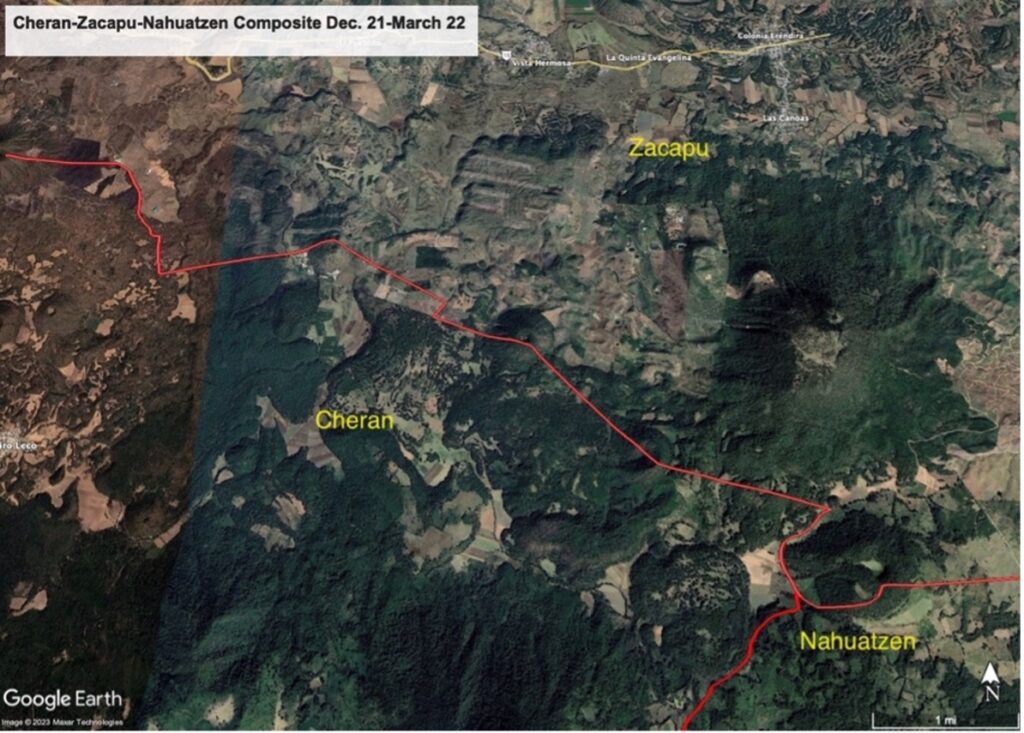
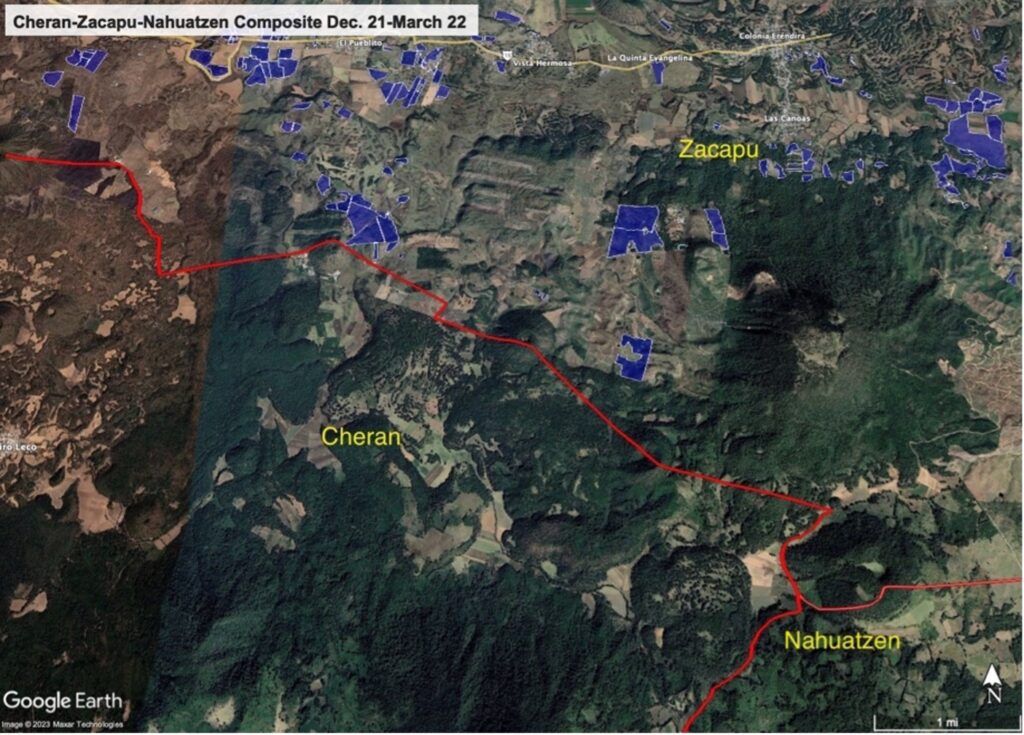
This appendix, relating to forest fires in Zacapu, is referenced in the Zacapu case study in the Emblematic Case Studies chapter.

The yellow and red dots are heat points detected by CONABIO’s Fire Early Warning System between April 3 and 7, 2017.730CONABIO, “Fire Early Warning System.” The undated satellite image that serves as the base map on the alert system’s website appears to be very recent, likely between 2021 and 2023. The purple circles are reference points corresponding to the yellow pins in the image at the bottom from Google Earth.
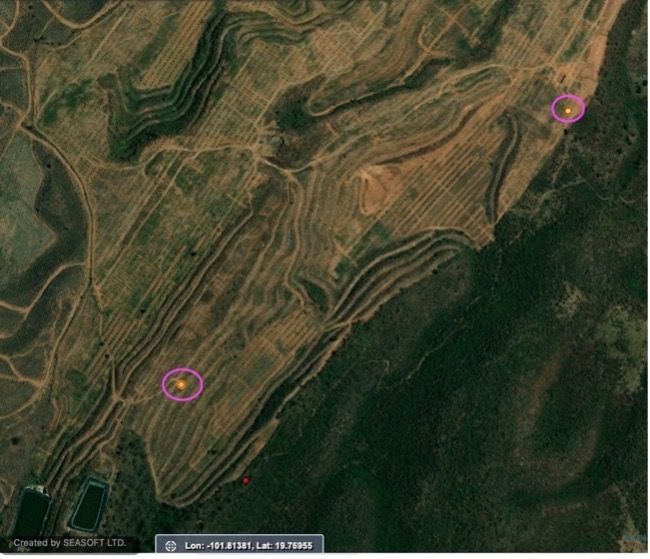

Zooms in on image above—likely from between 2021 and 2023—showing grids of avocado and water storage pools installed in the area where the fire occurred in 2017.
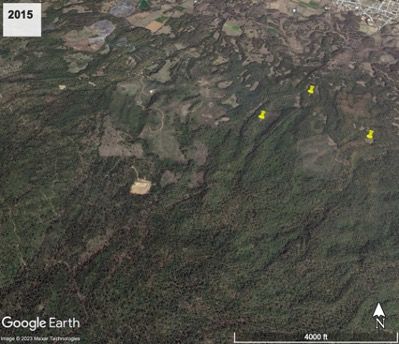
Google Earth satellite image from 2015 of same areas as the images above, with yellow pins as reference points corresponding to dots circled with purple. These show that prior to the 2017 fires, there was forest in the area that now has orchards.
This appendix, related to the forest fire and deforestation in Patuan, is referenced in the Ziracuaretiro case study in the Emblematic Case Studies chapter.

Global Forest Watch Composite December 2015-May 2016; Patuan is town to top left, below the red triangle.

Global Forest Watch, April 2022, month before fire
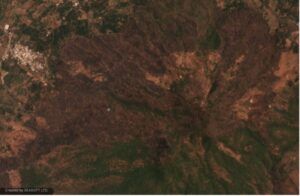
Global Forest Watch, May 2022, with brown showing area of fire

Global Forest Watch, May 2023, indicating expansion of cleared land around orchards along the northern ring of hill.
This appendix, about the municipality of Zapotlán el Grande, is referenced in the “Deforestation Increases the Risk of Flooding and Landslides,” in Chapter 3
Zapotlán el Grande is an epicenter of the avocado industry in Jalisco. Located in the municipal seat of Ciudad Guzman are multiple packinghouses—including those belonging to Calavo and Agro Gonzámex—as well as the headquarters of APEAJAL. The government has also registered more than 6,000 hectares of avocado planted in the municipality,731SIAP, “Advance of Plantings and Harvests.” many of them approved to export to the United States.
Municipal officials there described significant impacts on the population and environment stemming from deforestation, forest fires, and water use for avocado, as well as raspberries, which have also expanded in the area.732CRI interview with municipal officials; according to government 2.7 thousand hectares of raspberries are planted in Zapotlán el Grande. SIAP, “Advance of Plantings and Harvests.”
Below are examples of deforestation for avocado in Zapotlán el Grande.
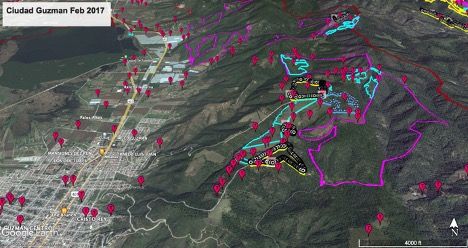

Google Earth images from 2017 and 2023. Northern part of city of Ciudad Guzman bottom left, Lake Zapotlán top left. The purple outlines are areas of deforestation identified by Climate Rights International, though not all area inside the outlines is necessary deforested. All other polygons, including those traced in light blue, yellow, and black and white dots, are U.S.-export approved orchards, according to government data.733Transparency law response from SENASICA to request number 330028323000032, January 23, 2023. The “T” pins show government registered avocado orchards as of October 2022, including those that have not been certified for export.734Transparency law response from SENASICA to request number 330028322000809, October 31, 2022.

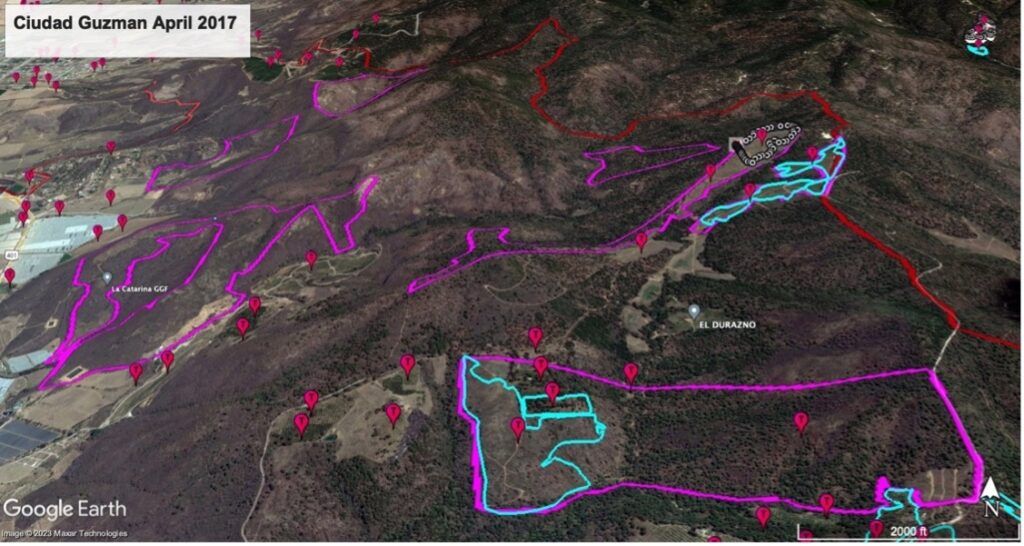

Three Google Earth images, from June 2010, April 2017, and April 2023, that zoom in on the top third of the first two images.
This appendix has the description by the environmental geographers at the University of Texas at Austin735Audrey Denvir, Eugenio Arima, and Katie Horn. of the methodology they used for the study referenced in the “Widespread Deforestation in Michoacán-U.S. Supply Chains” section of Chapter 2.
Orchard polygons for 2022-2023 were converted from KML and KMZ to shapefiles and processed within ArcGIS. Any polygons containing erroneous data that were obviously misshapen were removed from the dataset.
The land cover from past years, according to the SIAP Agricultural Frontier and Mas et al. land cover maps, were compared to the current orchard polygons using the Intersect tool in ArcGIS. The Agriculture Frontier Series II data (which delineates all agricultural land in the region for 2014-2015) was used to remove any land classified as agricultural in 2014, as those were determined to not have undergone land cover change between 2014 and present.
Then, the land classification maps from Mas et al. for 2014 were used to measure forest that was present in these areas in 2014. All forest land cover classes from Mas et al. in 2014 were summed to get total area (and total proportion) of each orchard polygon that contained primary forest, secondary forest, or any/all forest in previous years. These numbers were used as a proxy for deforestation. Forest land cover classes included: primary and secondary oak, pine, oyamel, mesophilic, and pine-oak forest, as well as primary and secondary lowland tropical forest.
Deforestation estimates are based on the assumption that all areas within an orchard polygon are currently orchard land use (i.e. we assume there is no standing forest within any orchard property).
Citations:
Mas, J. F., Lemoine-Rodríguez, R., González-López, R., López-Sánchez, J., Piña-Garduño, A., & Herrera-Flores, E. (2017). Land use/land cover change detection combining automatic processing and visual interpretation. European Journal of Remote Sensing, 50(1), 626-635.
Mas et al. maps available here: https://www.ciga.unam.mx/wrappers/proyectoActual/monitoreo/
This appendix, with a map of U.S.-approved export orchards surrounding Sicuicho, is referenced in the “Additional Individual Cases of Violence and Intimidation” section of Chapter 4.

Satellite imagery from Google Earth, dated April 2023, of the area around Sicuicho. The town center of Sicuicho is in the top-middle. The blue and green polygons show orchards certified for U.S. export as of January 2023.
This appendix, showing deforestation in Ocumicho, is referenced in the Ocumicho, Michoacán case study in chapter 4.

Google Earth satellite image, from February 2016, of a portion of the land Ocumicho leaders identified as being communally owned.
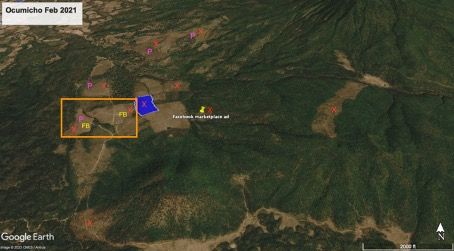
Google Earth image of same area from February 2021. The red X identifies areas where Climate Rights International identified trees that were cleared since the February 2016 image. The purple P denotes areas where PROFEPA conducted inspections for land-use change in August 2020 and found cleared trees as well as avocado plantings or a water storage pool for avocado irrigation. The blue polygon is an orchard already certified to export to the U.S. Google Earth imagery shows the orchard contains land that was deforested between October 2016 and April 2017—an image from the latter date shows the remnants of a forest fire. According to government shipment records, in 2022, the orchard supplied 2,410 kilograms of avocados to Mission Produce, and 13,190 kilograms to West Pak.736The orchard is HUE08160210404.
The yellow pin stating “Facebook marketplace ad” is the location of the land advertised in the February 2023 Facebook ad. The yellow letters FB are the locations of the avocado orchards advertised in the ad posted on Facebook in April and May 2023. The orange box is the area zoomed in on in the next three images.

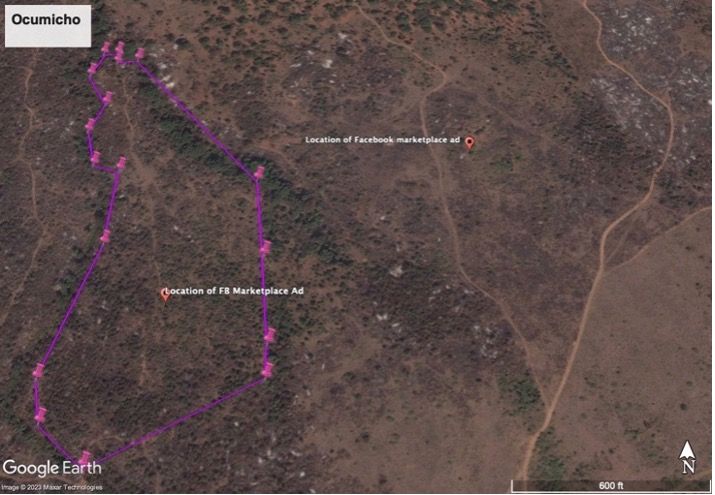
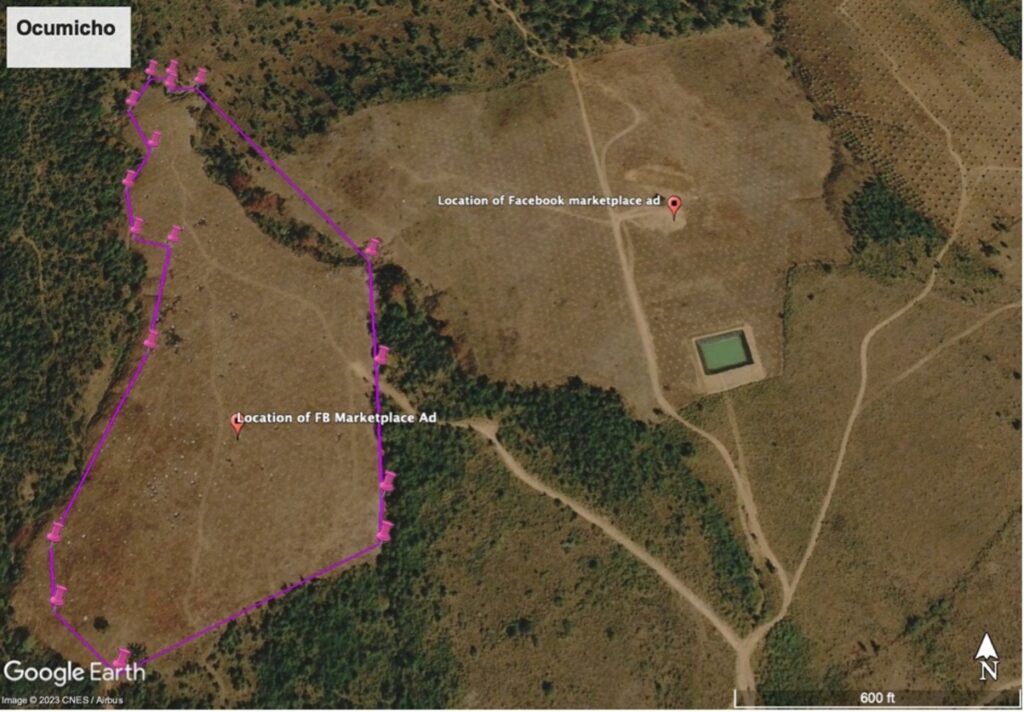
The top left image is from October 2016. The top right is from April 2017, which shows charred earth from a forest fire. The bottom from February 2021, showing how trees were cleared after the fire. The purple pins outlined in purple show one of the areas where PROFEPA found land- use change during an August 2020 inspection, according a PROFEPA document.737PROFEPA, “Record of Circumstances,” (“Acta Circunstanciada”), Investigation Number FED/MICH/ZAM/0001645/2020, Aug. 25, 2020. The pins with the labels “Location of FB marketplace” are the locations where the poster of the April and May 2023 Facebook ads said the 58 acres of avocado orchard are for sale. (He said the piece of land shaped like an upside-down triangle, between the two pins, belongs to a neighbor.) So, communal Ocumicho lands where there was a fire, clearing of trees, and inspection by PROFEPA, are now avocado orchards being sold on Facebook, despite the decision of communal authorities to prohibit the sale or renting of communal land to outsiders.
This appendix, related to Nahuatzen, is in the Indigenous Communities in Nahuatzen case study in Chapter 4.
The following Global Forest Watch images show one of the hills, called the Cerro de Capen, to the east of the towns of Nahuatzen and Sevina, where Nahuatzen community leaders said a local group of individuals has been deforesting and carrying out land grabs.


Global Forest Watch satellite imagery, with the town of Nahuatzen top left and town of Sevina at bottom. The top image is a composite from December 2015-May 2016, and the bottom is an image from April 2023.
This appendix shows examples of the types of questions regarding due diligence that Climate Rights International sent to packers, importers, and exporters, in April 2023, as referenced in the “Lack of Due Diligence by Packinghouses, Exporters, and Importers” section of Chapter 6.
The following due-diligence related questions were sent to Calavo Growers, Inc:
Growers
5. Does Calavo maintain records of the identity of avocado orchards (“growers”) in Mexico from which it sources avocados for its packinghouses and processing plants, for export, and/or for import to the United States?
5a. From how many different growers in Mexico has Calavo sourced avocados for packing, processing, export, and/or import to the United States since 2019?
5b. What are the Mexican Secretary of Agriculture and Rural Development (SADER) Registration Numbers (i.e. HUE8160010139) of the orchards from which Calavo has sourced avocados since 2019?
5c. How many hectares of avocado orchards in Michoacán and Jalisco does Calavo directly own and/or manage, and what are the SADER Registration Numbers (i.e. HUE8160010139) of these orchards?
Broad human rights and environmental due diligence policies and practices
6. What due diligence policies and practices, if any, does Calavo have to ensure that it does not directly cause or contribute to—or does not have business relationships with entities, such as growers, linked to—adverse human rights impacts? If a policy and/or practice exists, please provide documentation of it.
7. What due diligence policies and practices, if any, does Calavo have to ensure that it does not directly cause or contribute to—or does not have business relationships with entities, such as growers, linked to—violations of Mexican environmental law? If a policy and/or exists, please provide documentation of it.
Deforestation due diligence policies
8. What due diligence policies and practices, if any, does Calavo have to ensure that the avocados in its supply chains were not produced on land in Mexico that had been deforested? If a policy and/or practice exists, please provide documentation of it.
9. Put differently, does Calavo require that its growers not produce avocados on deforested land in Mexico? If a policy and/or practice exists, please provide documentation of it.
10. If Calavo has any such deforestation policies, how does it verify and enforce compliance by growers in Mexico?
11. Has Calavo identified growers it sources from, or potential growers to source from, that have produced avocados on deforested land in Mexico? If so, what steps did Calavo take to address the issue?
12. How, if at all, does Calavo measure and report greenhouse gas emissions linked to avocado-related deforestation, in its Scope 3 emissions?
Water due diligence policies
13. What due diligence policies and practices, if any, does Calavo have to ensure that avocados in its supply chains were not produced by growers in Mexico that used water obtained without required legal concessions from Mexico’s National Water Commission (CONAGUA), and thus in violation of Mexican law? If a policy and/or practice exists, please provide documentation of it.
14. What due diligence policies and practices, if any, does Calavo have to ensure that the use of water for the production of avocados in its supply chains is not negatively impacting Mexican local communities’ current or longer-term access to water for personal, domestic, and/or food growing uses? If a policy and/or practice exists, please provide documentation of it.
15. If Calavo has any such water due diligence policies, how does it verify and enforce compliance by growers in Mexico?
16. Has Calavo identified growers it sources from, or potential growers to source from, that have produced avocados with illegally obtained water, and/or that have negatively impacted local communities’ current or longer-term access to water in Mexico? If so, what steps did Calavo take to address the issue?
Indigenous rights due diligence
17. What due diligence policies and practices, if any, does Calavo have to ensure that growers from which it sources in Mexico secure Free, Prior and Informed Consent (FPIC) of Indigenous Peoples and Local Communities prior to activities that may affect the Indigenous communities’ rights, land, resources, territories, livelihoods, and food security? For example, what policies exist to ensure that avocados are not being grown on Indigenous community lands, without the FPIC of the communities? If a policy and/or practice exists, please provide documentation of it.
18. If Calavo has any such policies with respect to Indigenous communities, how does it verify and enforce compliance by growers?
19. Has Calavo identified growers it sources from in Mexico, or potential growers to source from, that have failed to secure FPIC from Indigenous people? If so, what steps did Calavo take to address the issue?
Due diligence concerning violence, threats and intimidation
20. What due diligence policies and practices, if any, does Calavo have in place to ensure that it does not directly cause or contribute to—or does not supply from growers linked to—intimidation, threats, or violence against local residents, including environmental and human rights defenders, Indigenous leaders, and/or journalists, among others? If a policy and/or practice exists, please provide documentation of it.
21. If Calavo has any such policies, how does it verify and enforce compliance by growers?
22. Has Calavo identified any such instances of intimidation, threats or violence in its supply chains, and if so, what actions did it take to address them?
Vendor Code of Conduct
23. Since 2015, how many times has Calavo conducted or hired a third party to conduct a “Supply Chain Audit” in Mexico to audit for compliance with its Vendor Code of Conduct, as referenced in its Vendor Code of Conduct? What potential issues of non-compliance did the audits address, and what non-compliance was found, if any?
24. Please describe any instances in which Calavo has “taken action upon discovery” of non-compliance in Mexico with the Vendor Code of Conduct, including through immediate remediation or termination of a business relationship?
25. What procedures has Calavo implemented to verify compliance with the following requirements in its Vendor Code of Conduct:
This appendix shows examples of the types of questions regarding due diligence that Climate Rights International sent to supermarkets, in April 2023, as referenced in the “Supermarkets’ Lack of Due Diligence” section of Chapter 6.
The following due-diligence related questions were sent to Amazon.com, including its subsidiary Whole Foods Market:
Deforestation due diligence policies
4. What due diligence policies and practices, if any, does Amazon have to ensure that it does not directly cause or contribute to—and/or have in its supply chain entities linked to—violations of Mexican environmental law, including illegal deforestation? If a policy and/or practice exists, please provide documentation of it.
5. Does Amazon require that its avocado suppliers not source the fruit from plantings on deforested land? If a policy and/or practice exists, please provide documentation of it.
6. What due diligence policies and practices, if any, does Amazon have to ensure that the avocados in its supply chains were not produced on land that has been deforested? If a policy and/or practice exists, please provide documentation of it.
7. If Amazon has any such deforestation requirements and/or due diligence policies, how does it verify and enforce compliance by entities in its supply chains from Mexico?
8. Has Amazon identified avocado growers in its supply chain, or potential growers to add to its supply chain, that have produced avocados on deforested land in Mexico? If so, what steps did Amazon take to address the issue?
Water due diligence policies
9. What due diligence policies and practices, if any, does Amazon have to ensure that avocados in its supply chains were not produced by growers in Mexico that used water obtained without required legal concessions from Mexico’s National Water Commission (CONAGUA), and thus in violation of Mexican law? If a policy and/or practice exists, please provide documentation of it.
10. What due diligence policies and practices, if any, does Amazon have to ensure that the use of water for the production of avocados in its supply chains is not negatively impacting Mexican local communities’ current or longer-term access to water for personal, domestic, and/or food growing uses? If a policy and/or practice exists, please provide documentation of it.
11. If Amazon has any such water due diligence policies, how does it verify and enforce compliance by entities in its supply chains from Mexico?
12. Has Amazon identified growers in its supply chains, or potential growers for its supply chains, that have produced avocados with illegally obtained water, and/or that have negatively impacted local communities’ current or longer-term access to water in Mexico? If so, what steps did Amazon take to address the issue?
Indigenous rights due diligence
13. What due diligence policies and practices, if any, does Amazon have to ensure that businesses and growers in its avocado supply chains from Mexico secure Free, Prior and Informed Consent (FPIC) of Indigenous Peoples and Local Communities prior to activities that may affect the Indigenous communities’ rights, land, resources, territories, livelihoods, and food security? For example, what policies exist to ensure that avocados are not being grown on Indigenous community lands, without the FPIC of the communities? If a policy and/or practice exists, please provide documentation of it.
14. If Amazon has any such policies with respect to Indigenous communities, how does it verify and enforce compliance by entities in its supply chains from Mexico?
15. Has Amazon identified businesses in its avocado supply chains from Mexico, or potential businesses for its supply chains, that have failed to secure FPIC from Indigenous people? If so, what steps did Amazon take to address the issue?
Due diligence concerning violence, threats and intimidation
16. What due diligence policies and practices, if any, does Amazon have to ensure that it does not directly cause or contribute to—and/or have in its Mexican avocado supply chain entities linked to—intimidation, threats, or violence against local residents, including environmental and human rights defenders, Indigenous leaders, and/or journalists, among others? If a policy and/or practice exists, please provide documentation of it.
17. If Amazon has any such policies, how does it verify and enforce compliance by entities in its supply chains from Mexico?
18. Has Amazon identified any such instances of intimidation, threats or violence in its avocado supply chains from Mexico, and if so, what actions did it take to address them?
Amazon Supply Chain Standards and Whole Foods Market Supplier Code of Conduct
19. How many times has Amazon (defined here and throughout the letter to include Whole Foods Market) conducted or hired a third party to conduct an audit or inspection to determine whether its suppliers of avocados produced in Mexico—and/or their suppliers—were in compliance with Amazon’s Supply Chain Standards and/or the Whole Foods Market Supplier Code of Conduct? What potential issues of non-compliance did the audits/inspections review, and what non-compliance was found, if any?
20. Please describe any instances in which Amazon has “temporarily suspend[ed] or terminat[ed] a relationship” with a supplier because of a violation of Amazon’s Supply Chain Standards and/or the Whole Foods Supplier Code by the supplier (or its supplier) that related to avocado supply chains from Mexico?
21. What procedures has Amazon implemented to verify that its suppliers of avocados grown in Mexico (and their suppliers) comply with the following elements of the Supply Chain Standards and Supplier Code of Conduct:
This appendix, summarizing information about packers, exporters, and importers, is referenced in the Summary and Chapter 6. Responses from companies to Climate Rights International’s November 2023 letters are found in appendix M.
All data on exports and imports are compiled by the company Treid, for the period of January 2019 to April 2023, based on Mexican customs records. The variation between export and import data for a given company is likely due the fact that Treid listed the “importer” as “unknown” for most of the value of the imports to the United States and Canada, and 38 percent of German imports, 49.6 percent of United Kingdom imports, 44.89 percent of Spain imports, 29.9 percent of France imports, and 25 percent of Japan imports. So, a single shipment from the same company, from Mexico to another country, could be counted as an export but not an import for that company.
Calavo Growers, Inc.
“Calavo may conduct or hire a third party to conduct, a Supply Chain Audit” of compliance with the Code.741Calavo Growers, Inc., “Vendor Code of Conduct,” Aug. 13, 2019, https://ir.calavo.com/static-files/9e7500ad-5453-43d7-a6db-ddfb7ace6c10 (accessed July 14, 2023).
Mission Produce, Inc.
Fresh Del Monte Produce, Inc.
As for “monitoring and enforcement” Del Monte “shall have the right (but not the obligation) to monitor compliance,” including “to conduct, or have its designee conduct, unannounced inspections.”754Fresh Del Monte, “Global Vendor Code of Business Ethics and Conduct,” https://freshdelmonte.com/wp-content/uploads/2023/01/Vendor-Code-of-Business-Ethics-Conduct-2023-FINAL.pdf (accessed July 14, 2023).
The 2021 Sustainability report states that “throughout the year, we conduct Human Rights Impact Assessments (HRIAs) in our operations, and randomized third-party supplier checks.”755Fresh Del Monte, “A Brighter World Tomorrow: 2021 Sustainability Report,” https://freshdelmonte.com/wp-content/uploads/2022/10/FDM_2021_SustainabilityReportFINAL.pdf (accessed July 14, 2023).
Its “Global Environmental Policy” states that it will “ensure that no agricultural projects will be developed in lands covered with mature forest.”756Fresh Del Monte Produce, “Global Environmental Policy,” https://freshdelmonte.com/wp-content/uploads/2021/12/FDM_EnvironmentalPolicy_2020.pdf (accessed July 14, 2023).
West Pak Avocado, Inc.
Westfalia
Dole Plc
Stonehill Produce, Inc.
Del Rey Avocado
Nature’s Pride
The website states that the company uses the GLOBALG.A.P. Certification with growers, whose aspects are “food safety and traceability; environment; health and safety and the well-being of employees.”777Nature’s Pride, “Our Growers,” https://www.naturespride.eu/en/the-value-chain/growers (accessed July 14, 2023). The website’s description of the environmental component of this certification indicates it focuses on “crop protection methods that do not harm the environment and leave no contamination on the products,” and growers doing “everything they can to limit water consumption on the farm.”
Nature’s Pride has a “Water Policy,” which states that it “choos[es] to work with growers that have a demonstrated commitment to sustainability.”778Nature’s Pride, “Water Policy, March 15, 2022, https://www.naturespride.eu/media/gt1nfvfa/220315-nature-s-pride-water-policy-v6.pdf (accessed July 14, 2023) The policy states, “[w]e have added a section about water to our Suppliers Agreement, our official guideline for suppliers,” and that “Nature’s Pride was the first to globally roll out the GLOBALG.A.P. SPRING water audit.”779Ibid. Nature’s Pride’s “Sustainable Business Plan 2023” states that it has a “due diligence approach on human rights and environment,” and that in 2022, it identified governance, labour, and human rights and environmental risks for all its products and countries.780Nature’s Pride, “Sustainable Business Annual Report 2022, https://www.naturespride.eu/media/c4chbdpg/np_sb_jaarverslag2022_en.pdf (accessed July 14, 2023). In the 2022 Due Diligence Report report, the company indicates that this risk analysis identified avocados, including avocados from Mexico, as a “very high risk product.” The Due Diligence report further states that issues such as biodiversity and deforestation “will be taken into account in the development of our 2028 strategy for people and nature.”
This appendix, containing additional examples of evidence implicating companies’ supply chains, is referenced in the “Evidence of Aztecavo, Calavo, Fresh Del Monte, Mission Produce, and West Pak Sourcing from Orchards on Deforested Land” section of Chapter 6.


In 2022, the three Zacapu orchards outlined in red supplied 49,394 kilograms to Fresh Del Monte (top right and bottom right) and 4,470 kilograms to West Pak (left).782The orchards are HUE08161070490 (left), HUE08161070695 (top right) – 4,330 kilograms, and HUE08161070694 (bottom right) – 45,064 kilograms.
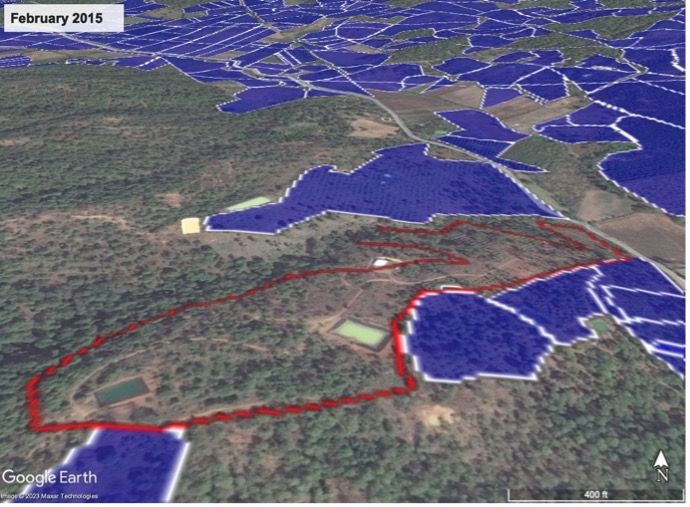
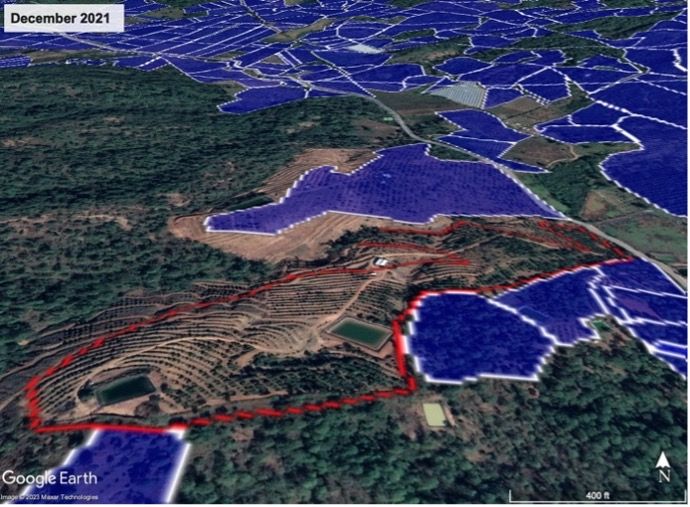
In 2022, the Ziracuaretiro orchard outlined in red supplied 18,345 kilograms to West Pak and 10,023 kilograms to Aztecavo.783The orchard is HUE08161114067.

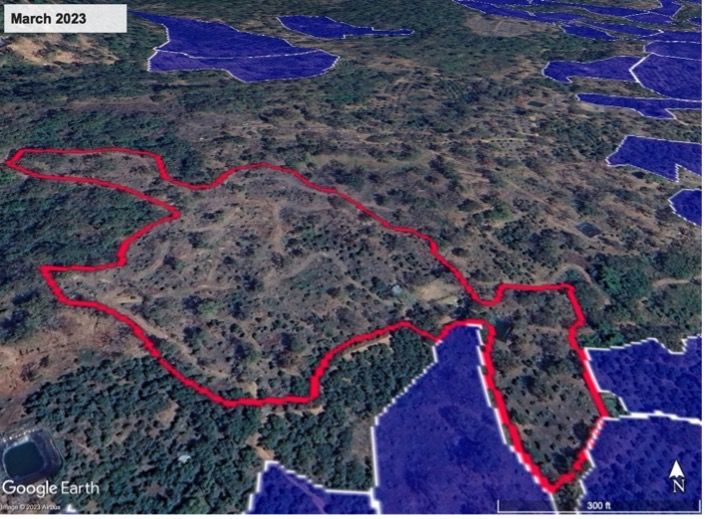
In 2022, the Ario de Rosales orchard outlined in red supplied 6,910 kilograms to Mission Produce. 784The orchard is HUE08160096855.

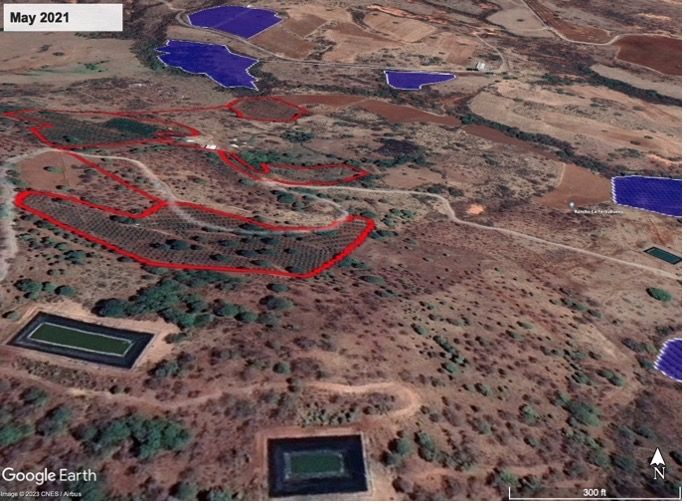
In 2022, the Cotija orchard outlined in red supplied 2,550 kilograms of avocado to Calavo.785The orchard is HUE08160190148.

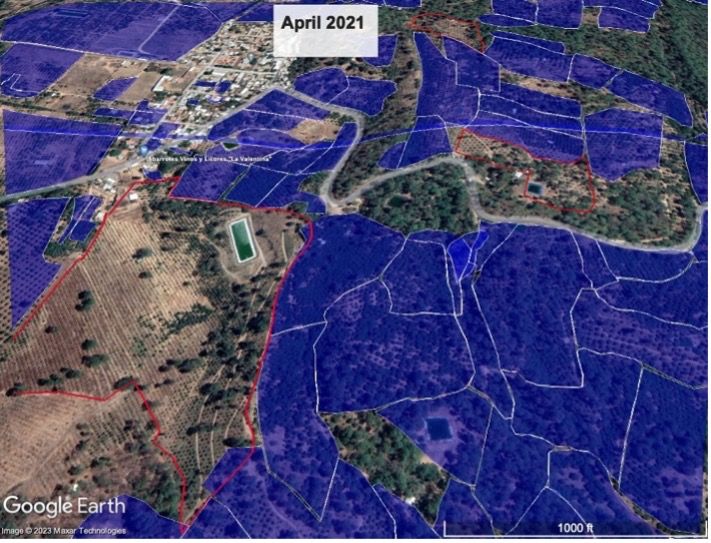
In 2022, the three Taretan orchards outlined in red supplied 15,125 kilograms to Fresh Del Monte and 4,685 kilograms to Aztecavo (left), 7,389 kilograms to Aztecavo (top orchard), and 6,860 kilograms to Mission Produce and 2,460 kilograms to West Pak (orchard on right).786The orchards are HUE08160870435 (bottom left); HUE08160870665 (top); and HUE08160870673 (right).
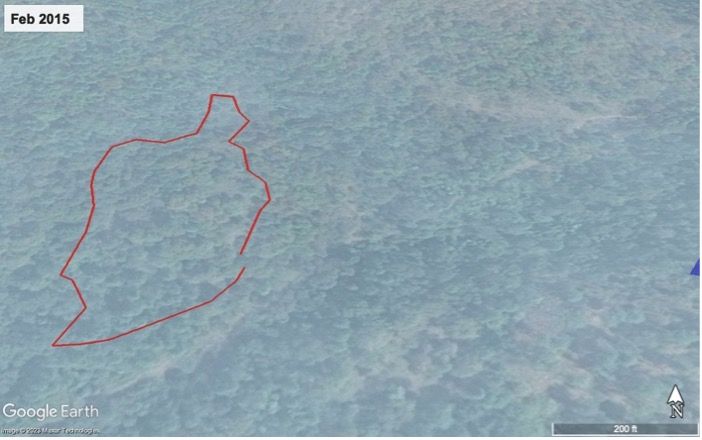
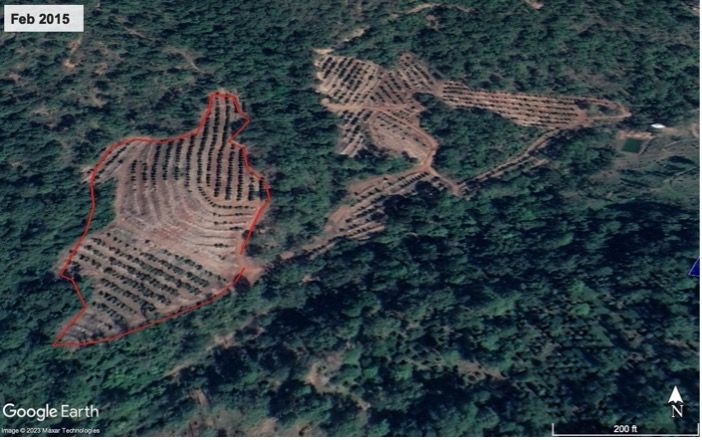
In 2022, the Taretan orchard outlined in red supplied 3,880 kilograms to West Pak.787The orchard number is HUE08161114414.
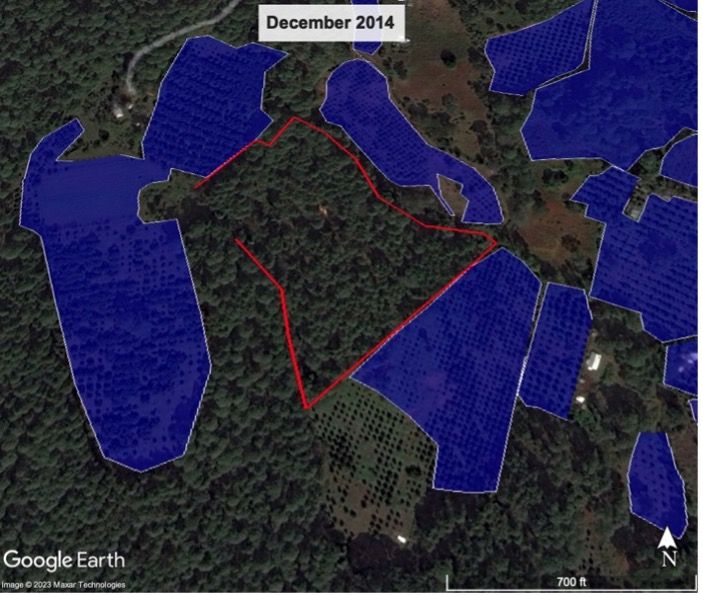

In 2022, the Cotija orchard outlined in red supplied 33,970 kilograms of avocados to Calavo.788The orchard is HUE08160190834.

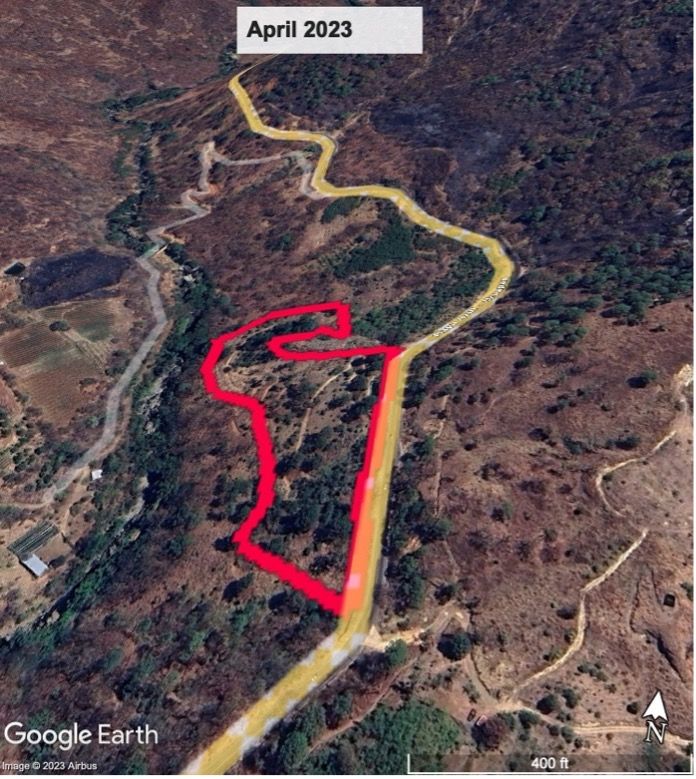
In 2022, the Uruapan orchard outlined in red supplied 5,540 kilograms of avocados to Calavo.789The orchard is HUE08160336562.


In 2022, this Apatzingán orchard supplied 255,508 kilograms of avocados to Aztecavo, and 12,230 to Fresh Del Monte.790The orchard is HUE08160835119. The charred earth of a forest fire, at the edge of the avocado frontier, is visible in the top of the frame of the image from April 2023.
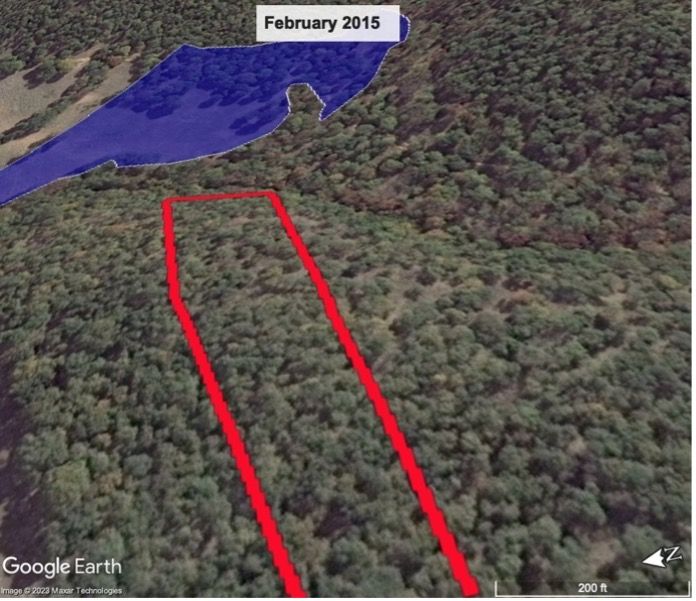
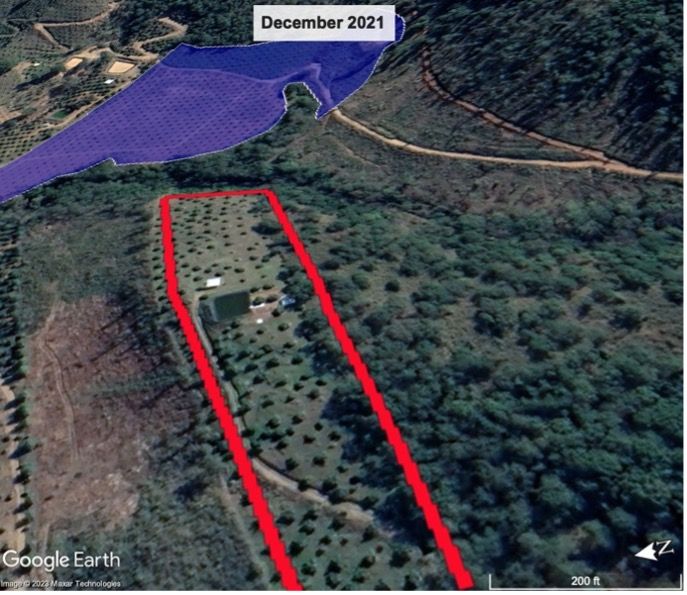
In 2022, this Zacapu orchard outlined in red supplied 4,105 kilograms to Calavo, and 1,000 kilograms to Mission.791The orchard is HUE08160440105.
In November 2023, Climate Rights International sent to companies named in this report a summary of findings, as they relate to the company. We sent them to: Aguacates La Bonanza, Aguacates Seleccionados JBR, Agro Gonzámex, Ahold Delhaize, Albertsons, Aldi, Aztecavo, Amazon.com (and Whole Foods), Calavo, Costco, Del Rey, Dole, Fresh Del Monte, Frutas Finas de Tancítaro, Kroger, Lidl, Mission Produce, Nature’s Pride, Promotora Mexicana Gaitan, Publix, Sprouts, Stater Bros, Stonehill, Target, Tesco, Trader Joe’s, Walmart, Wegmans, West Pak, and Westfalia. We also sent a summary of findings to APEAM and Avocados From Mexico.
We received the following formal written responses, and also had a phone call with Walmart.